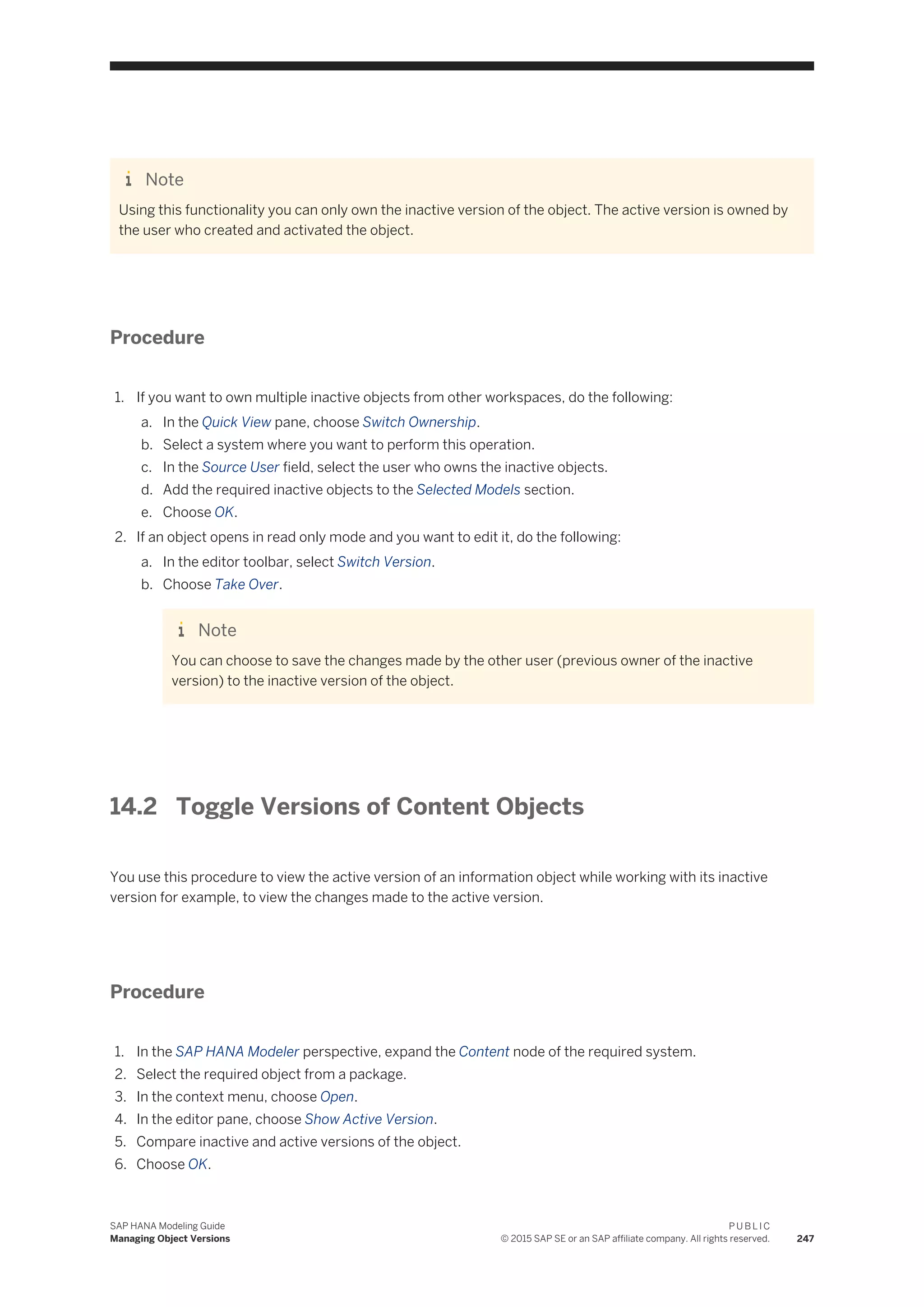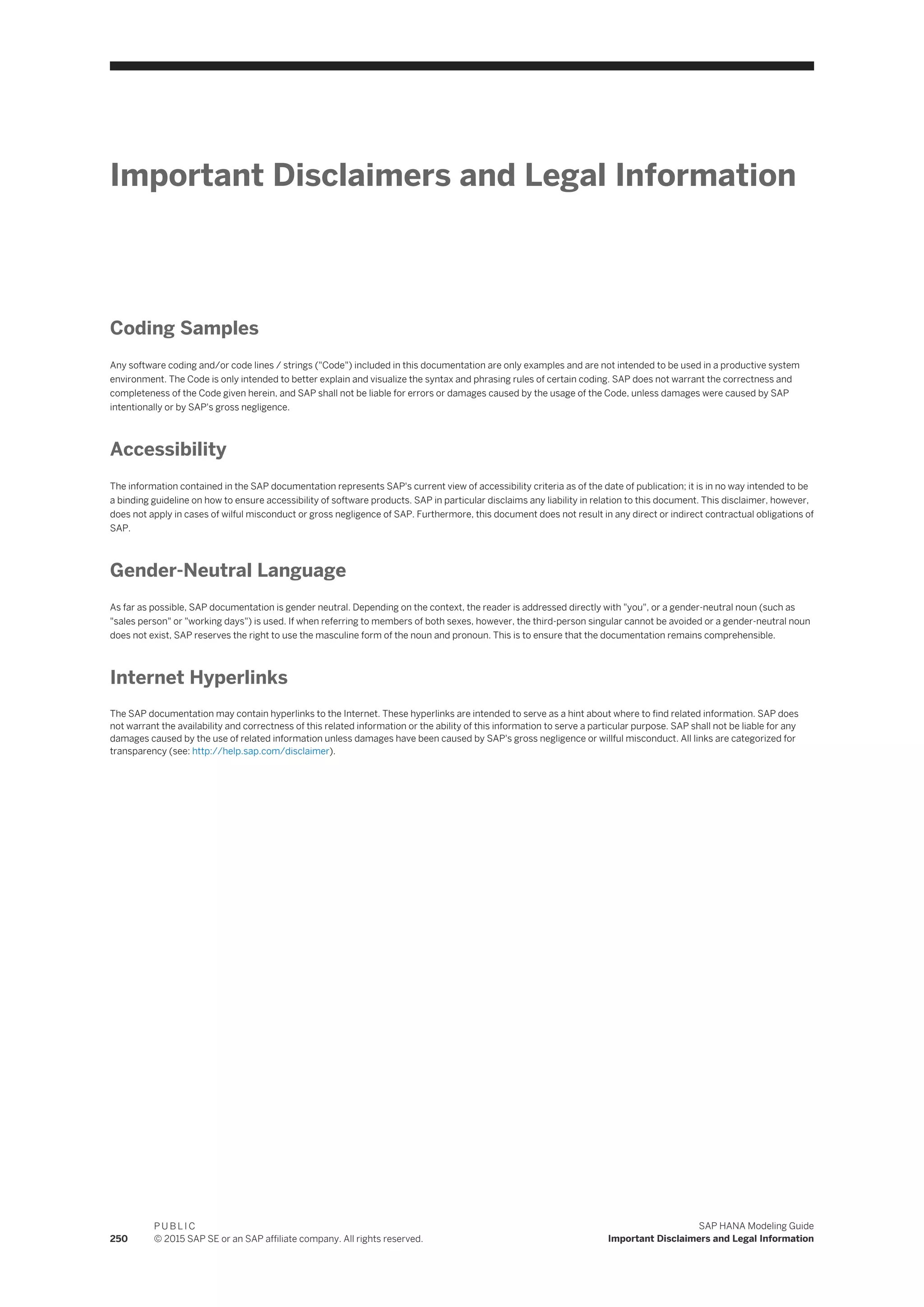This document provides guidance on modeling with SAP HANA Studio. It discusses SAP HANA architecture including its in-memory columnar database and parallel processing. It then covers topics like importing data, creating information views using attributes, measures and different types of views. It also discusses working with attributes and measures, creating calculated columns and restricted columns, and assigning semantics. The document is a user guide for developing analytic models with SAP HANA Studio.
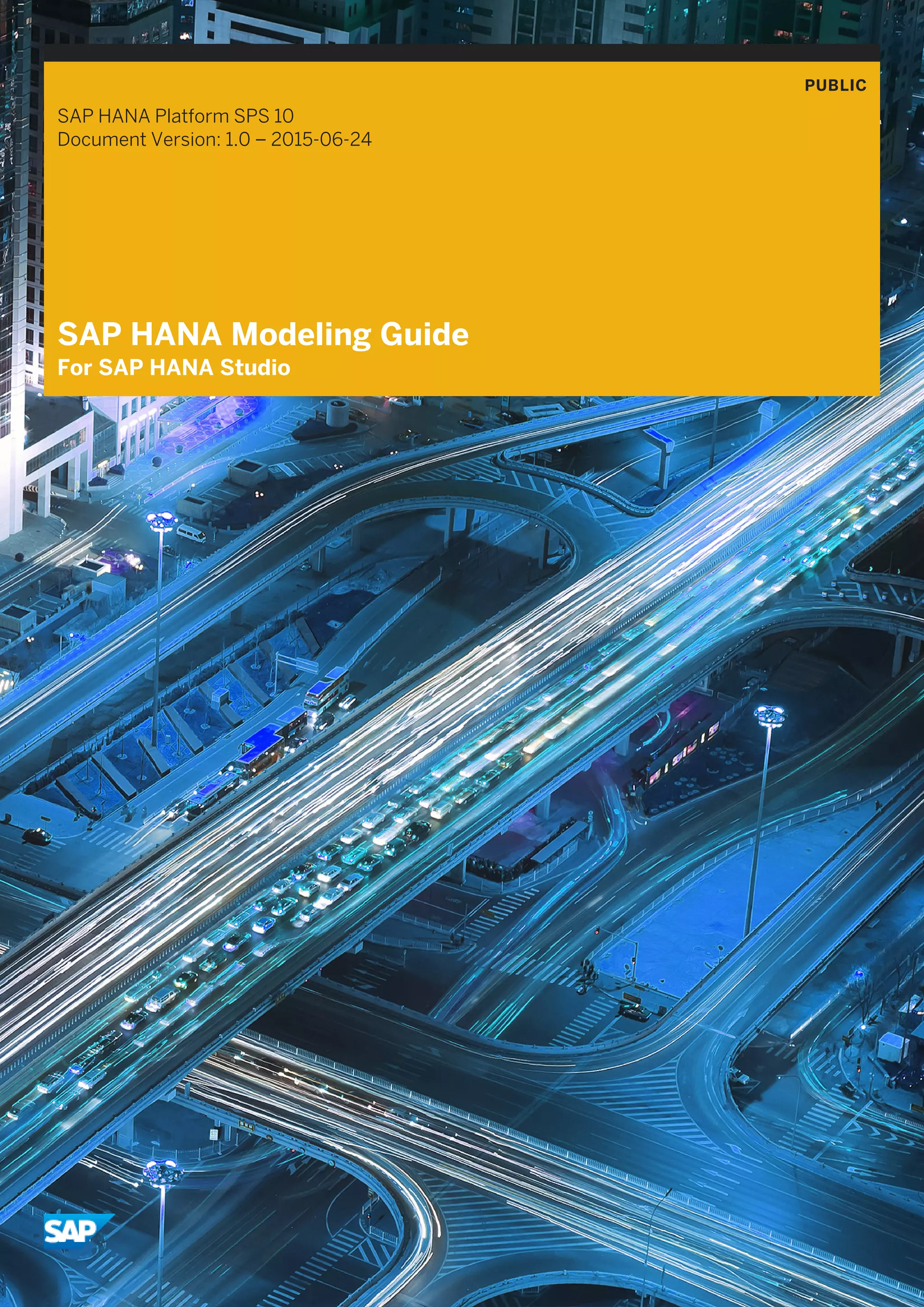
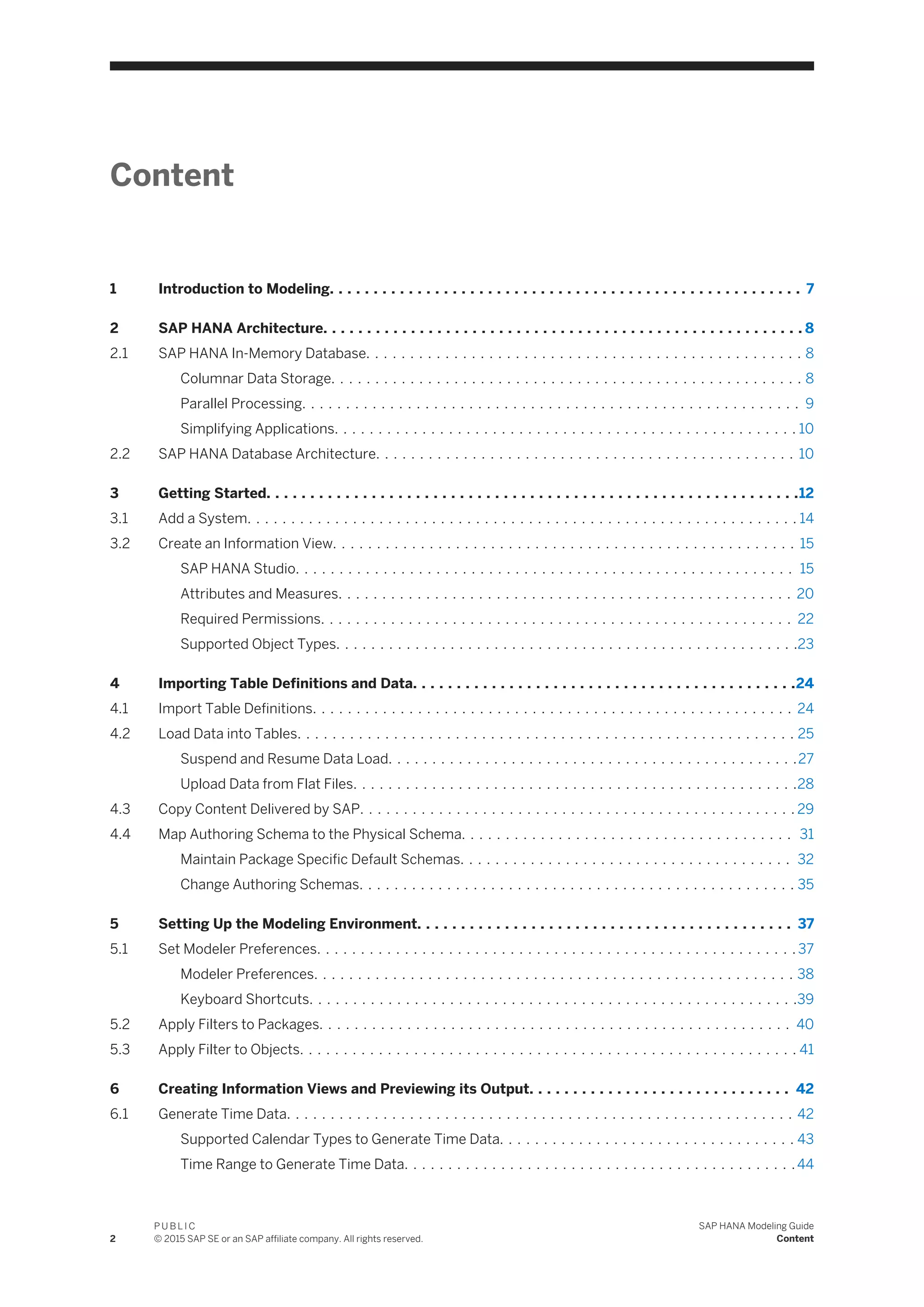
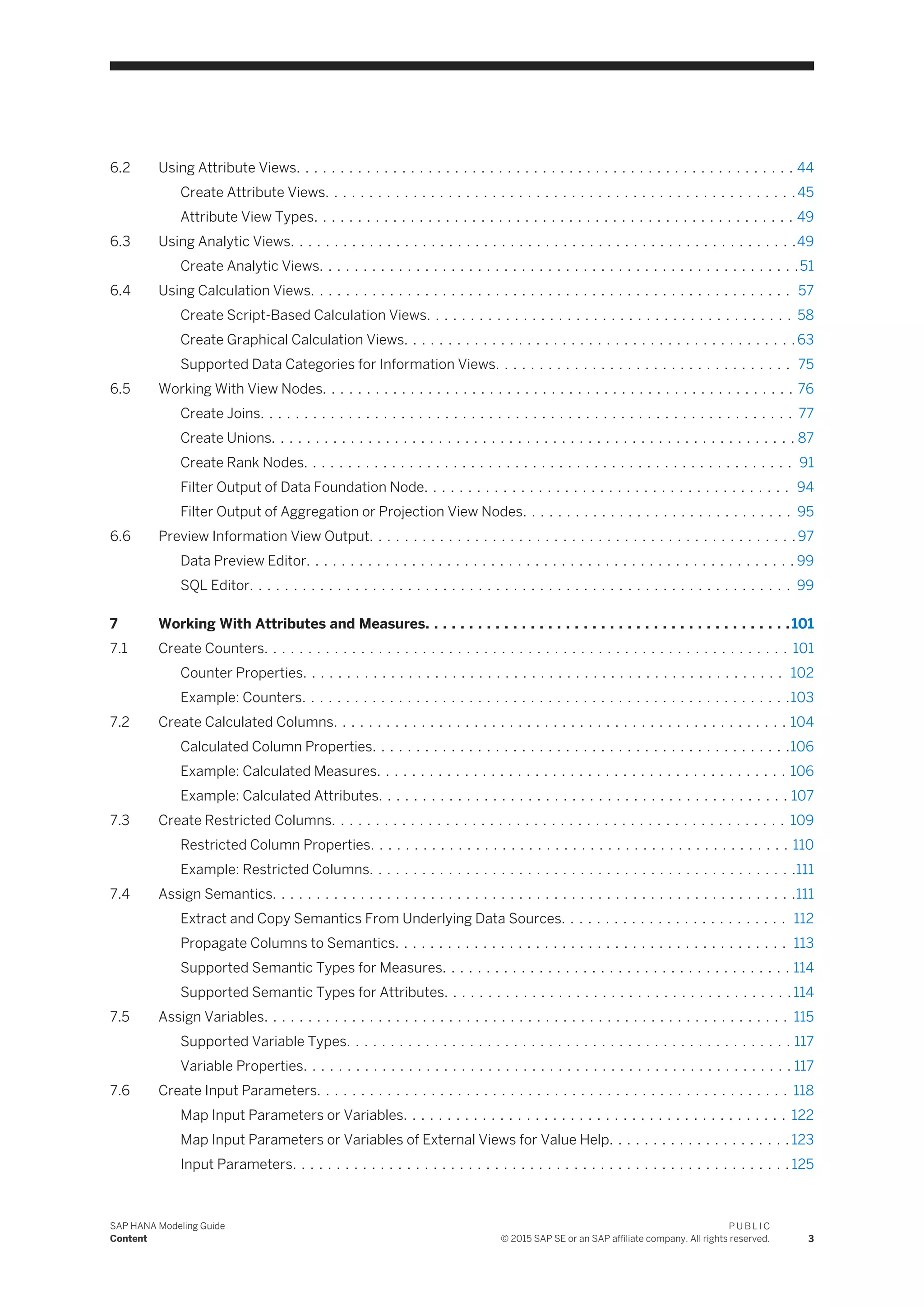
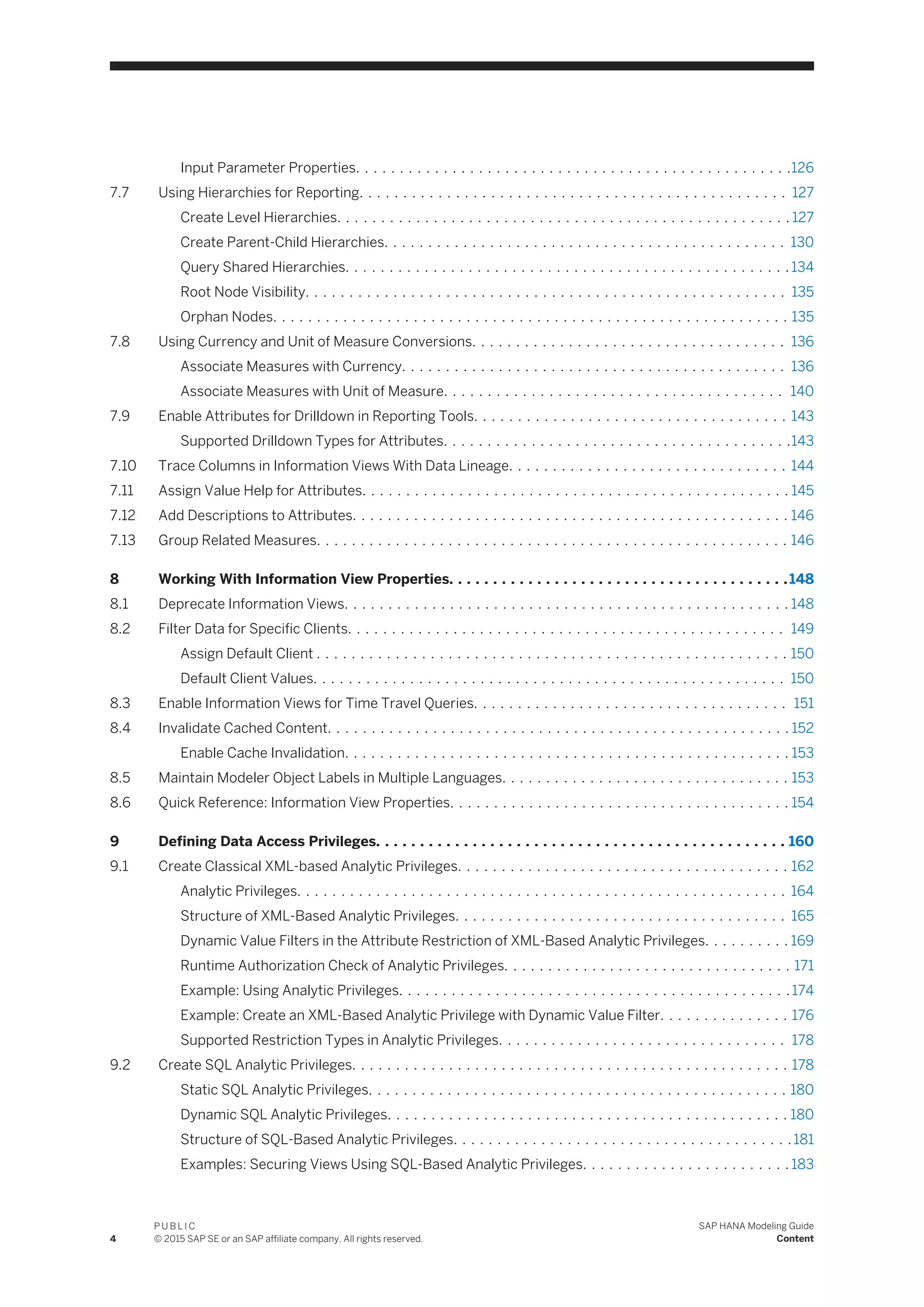
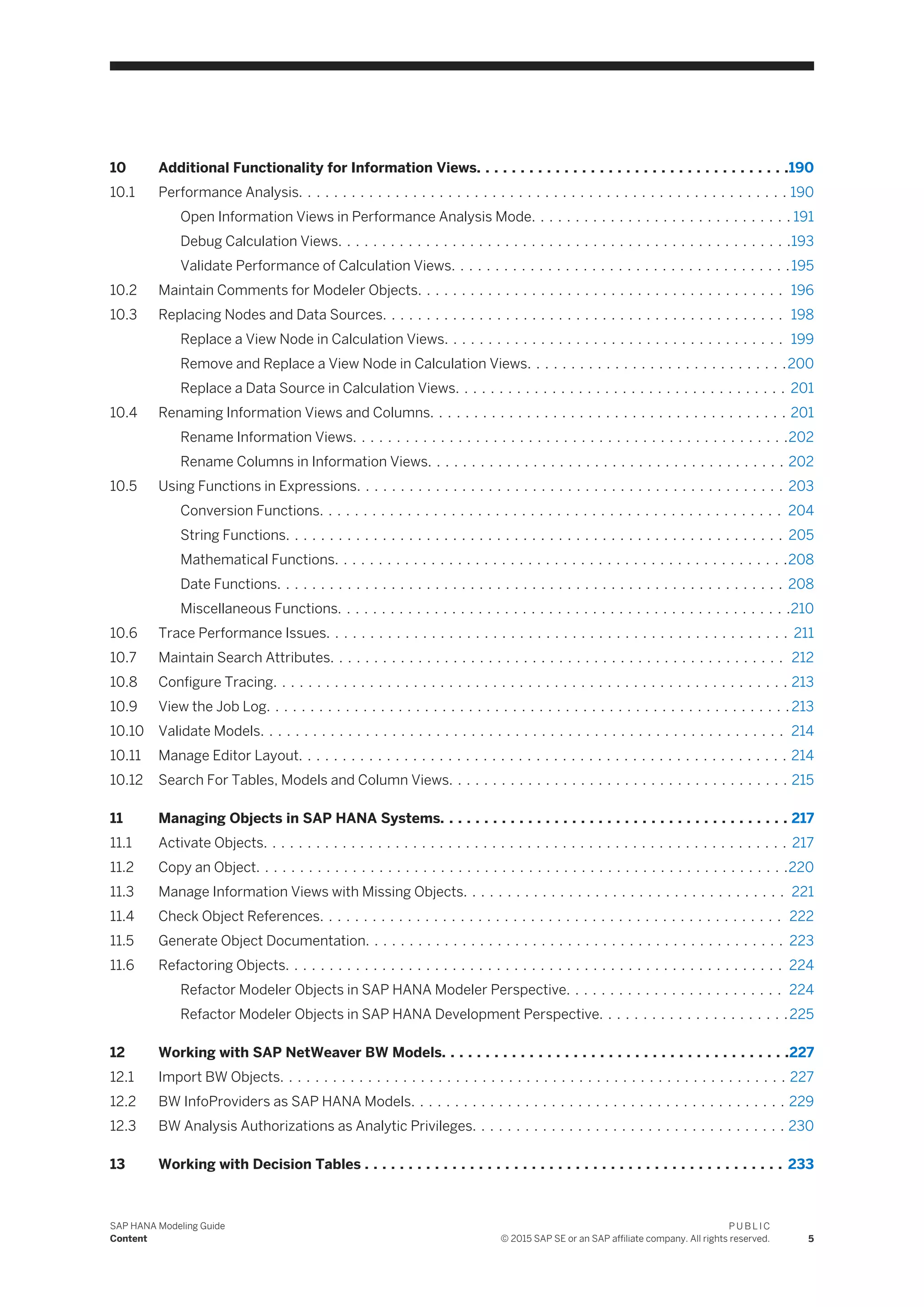

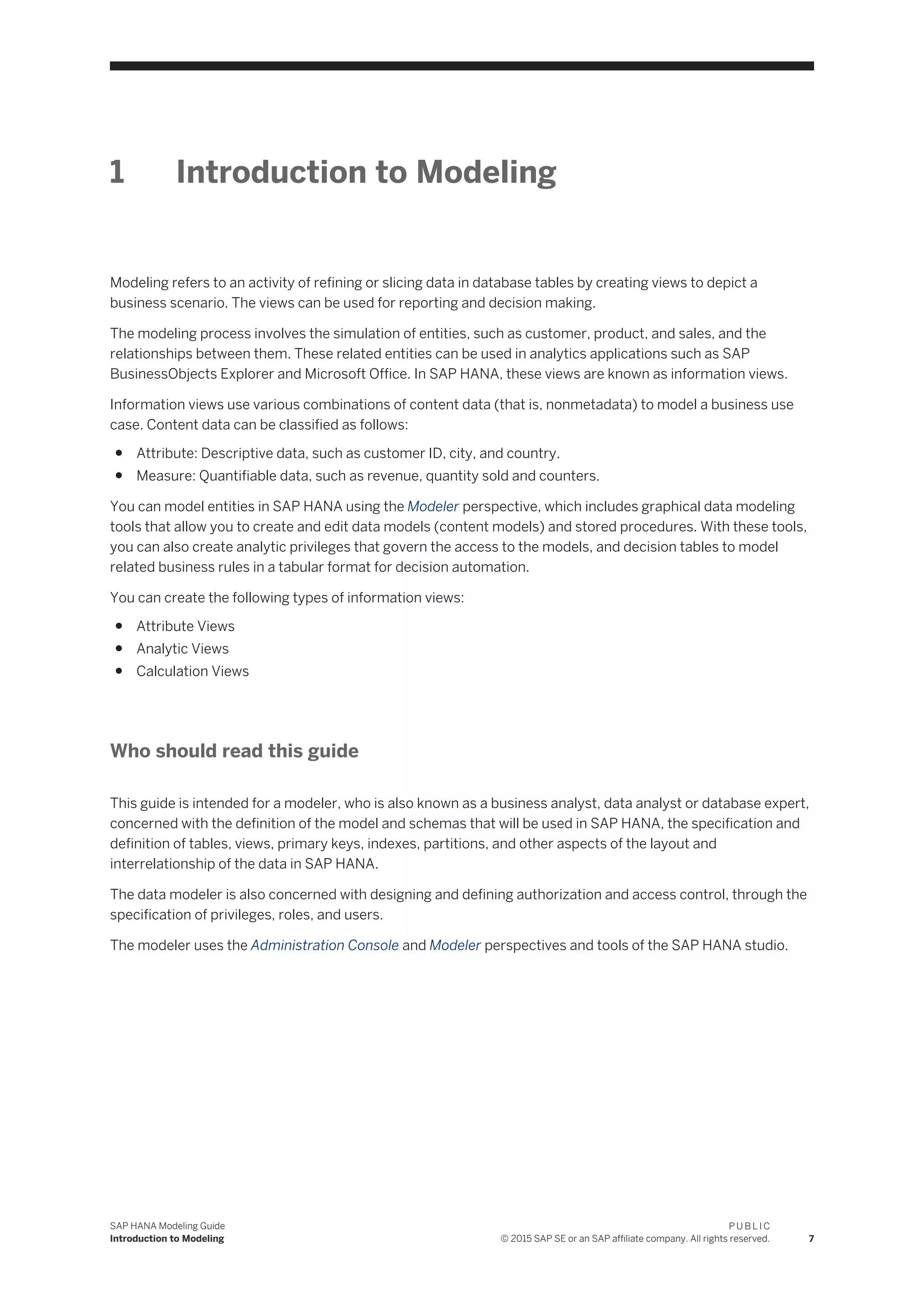
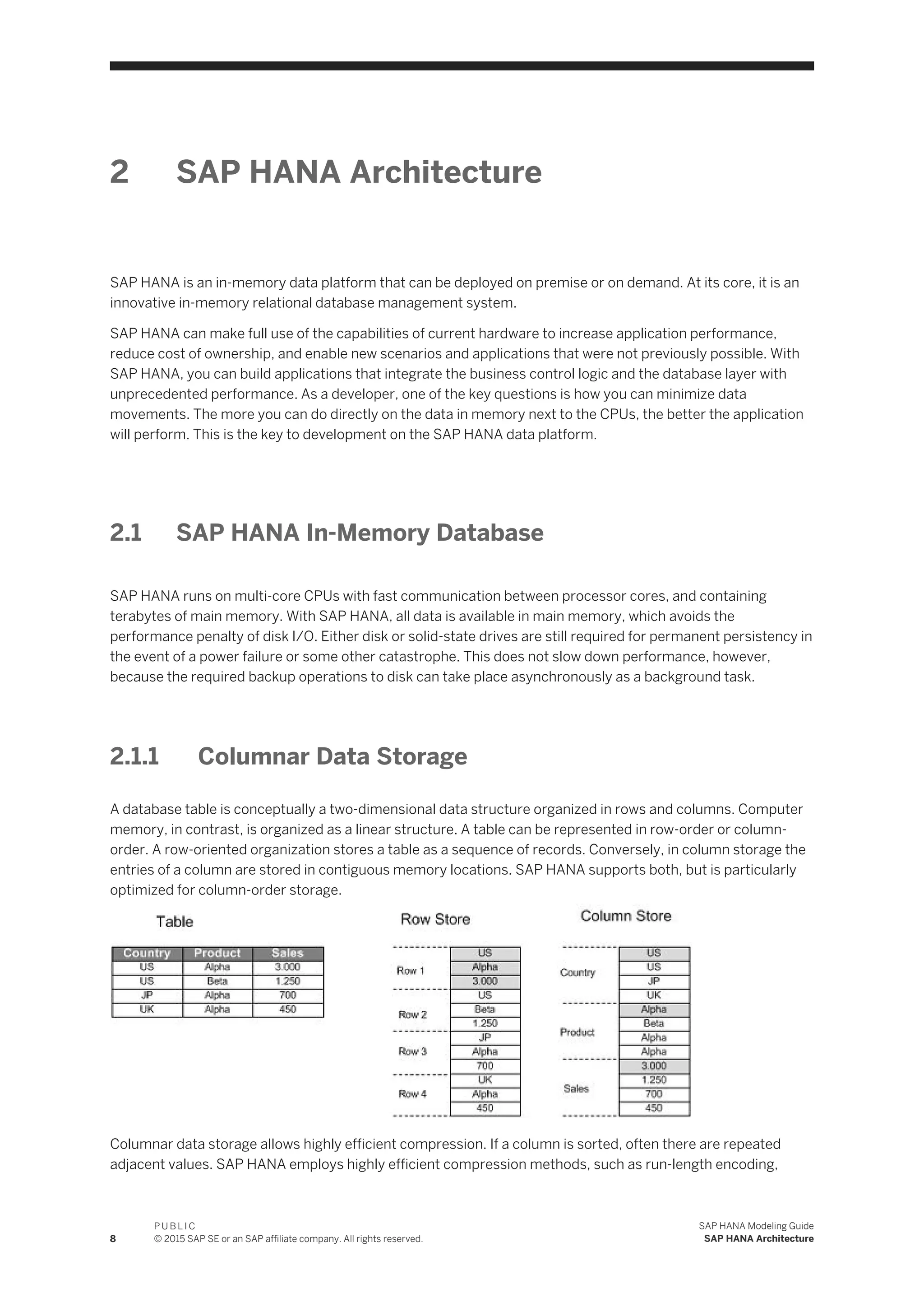

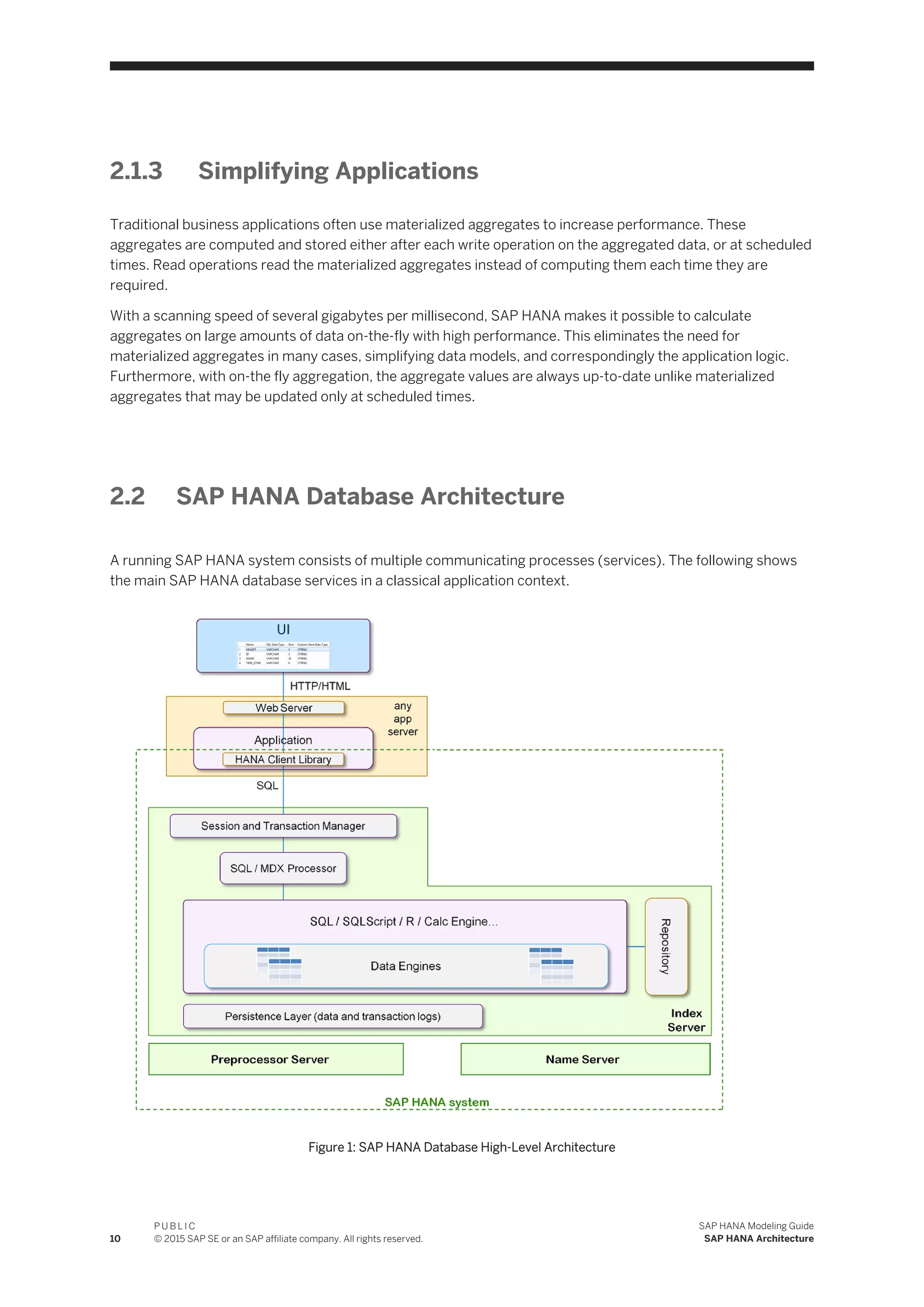
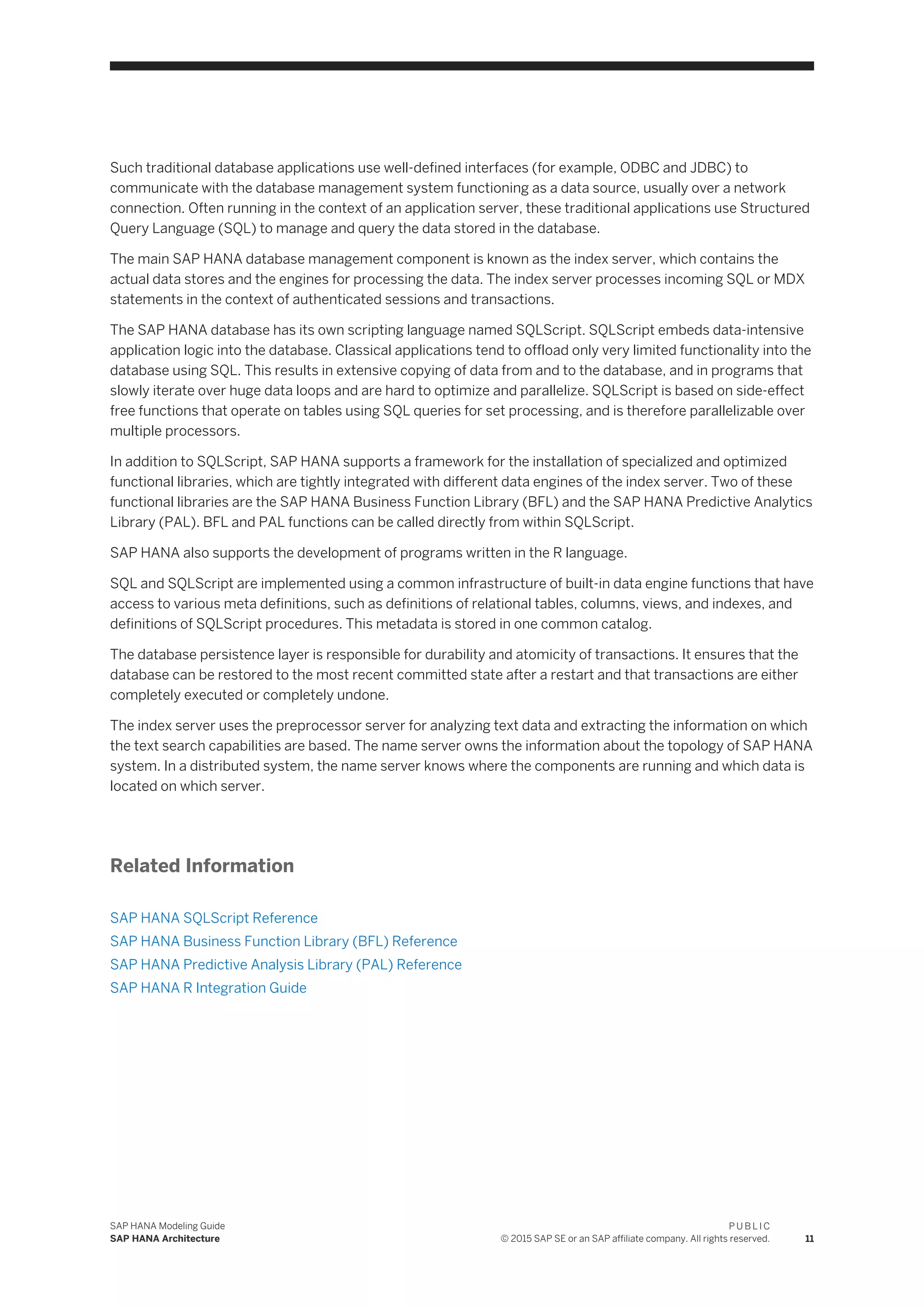
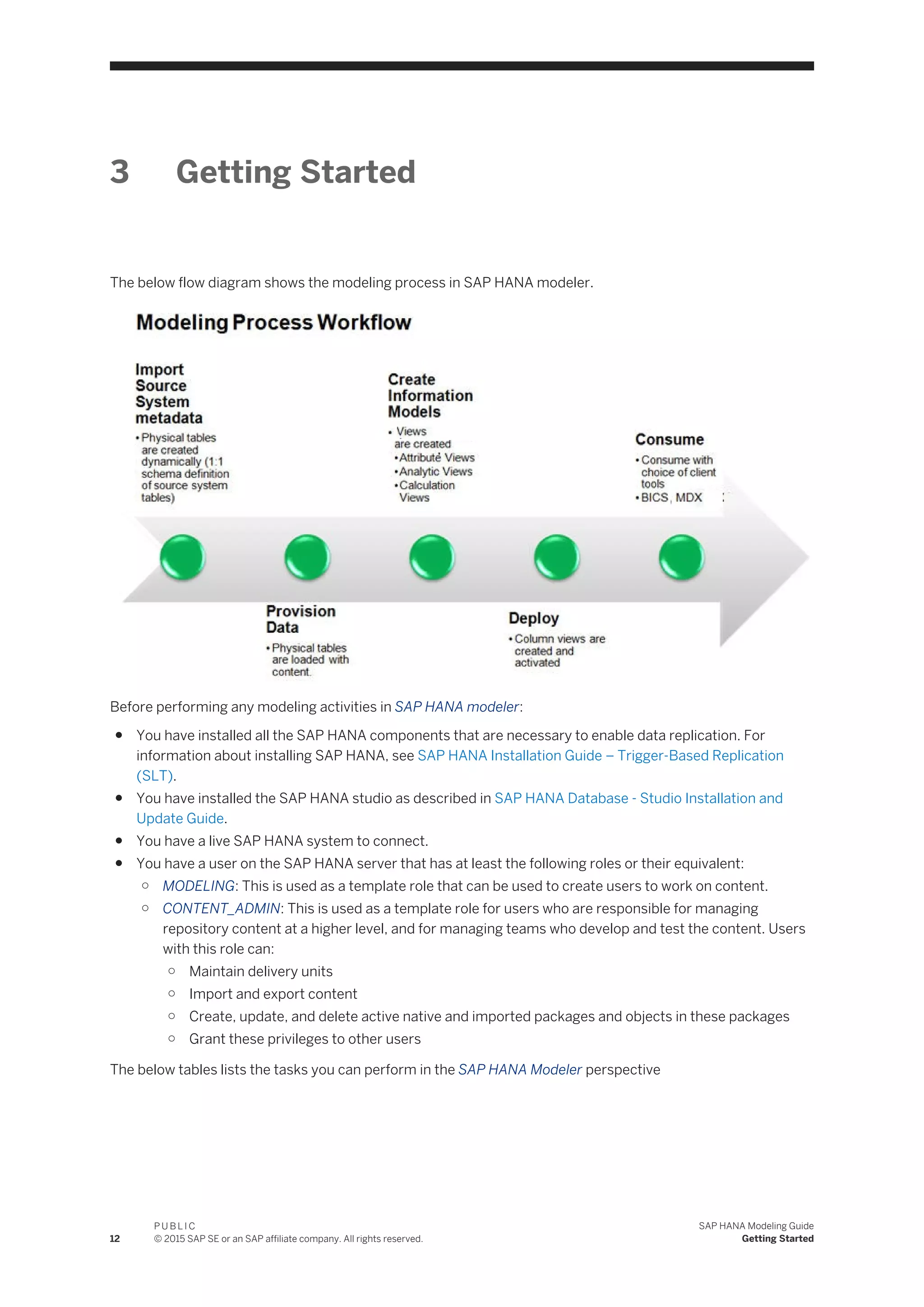
![Table 1:
Task Meaning SAP HANA Modeler per
spective
SAP HANA Development
perspective
Import metadata Create tables by importing
the table definitions from the
source systems using the
Data Services infrastructure.
For more information, see
Import Table Definitions
[page 24].
You can also create tables
from scratch using the SAP
HANA Development perspec
tive. For more information,
see Setting Up the Persis
tence Model in the SAP
HANA Developer Guide.
Load data Load data into the table defi
nitions imported from the
source system using the
Load Controller, SAP Sybase
Replication Server or SAP
Landscape Transformation,
and from flat files.
For more information, see
Load Data into Tables [page
25].
You can also provision data
into the table definitions in
the SAP HANA Development
perspective. For more infor
mation, see Setting Up the
Persistence Model in the
SAP HANA Developer Guide.
Create packages Logically group objects to
gether in a structured way.
Logically group objects to
gether in a structured way.
For more information, see
Maintaining Repository
Packages in the SAP HANA
Developer Guide
Create information views Model various slices of the
data stored in the SAP HANA
database. Information views
are often used for analytical
use cases, such as opera
tional data mart scenarios or
multidimensional reporting
on revenue, profitability, and
so on.
For more information, see
Creating Information Views
and Previewing its Output
[page 42]
You can also create informa
tion views in the SAP HANA
Development perspective.
For more information, see
Setting Up the Analytic
Model in the SAP HANA De
veloper Guide.
Create procedures Create procedures using
SQLScript for implementing
a complex logic that cannot
be achieved using other ob
jects.
For more information, see
Developing Procedures in
the SAP HANA Developer
Guide.
Create analytic privileges Control which data that indi
vidual users sharing the
same data foundation or
view can see.
For more information, see
Defining Data Access Privi
leges [page 160].
For more information on SAP
HANA database authoriza
tion mechanisms, see Set
ting Up Roles and Authoriza
tions in the SAP HANA De
veloper Guide.
Import SAP NetWeaver BW
objects
Import SAP NetWeaver BW
objects into SAP HANA, and
expose them as information
views.
For more information, see
Import BW Objects [page
227].
Create decision tables Create a tabular representa
tion of related rules using
conditions and actions.
For more information, see
Working with Decision Ta
bles [page 233].
SAP HANA Modeling Guide
Getting Started
P U B L I C
© 2015 SAP SE or an SAP affiliate company. All rights reserved. 13](https://image.slidesharecdn.com/51818a91-dee6-4c9b-b633-0deab6e88220-150721193202-lva1-app6892/75/SAP_HANA_Modeling_Guide_for_SAP_HANA_Studio_en-13-2048.jpg)
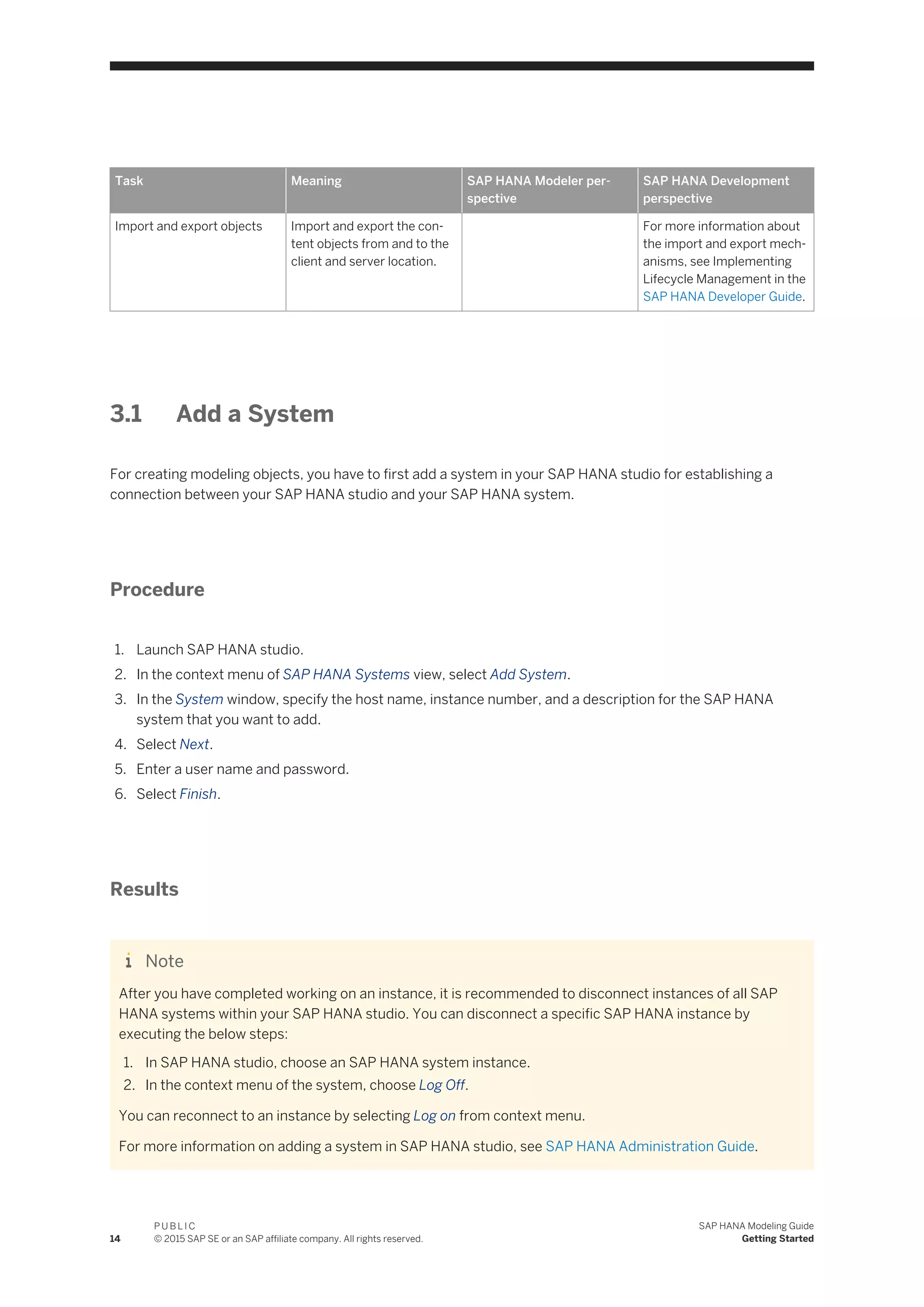
![3.2 Create an Information View
There are three types of information views: attribute view, analytic view, and calculation view. All three types of
information views are non materialized views. This creates agility through the rapid deployment of changes as
there is no latency when the underlying data changes.
Procedure
1. Open the SAP HANA Modeler perspective.
2. To set the view parameter, execute the steps described in Creating Information Views [page 42]
The view editor opens where you can define the input elements of the view and its output structure.
3. To design a view that you can use for analytical purposes, see Creating Information Views [page 42]
3.2.1 SAP HANA Studio
The SAP HANA studio is an Eclipse-based development and administration tool for working with SAP HANA,
including creating projects, creating development objects, and deploying them to SAP HANA. As a developer,
you may want to also perform some administrative tasks, such as configuring and monitoring the system.
There are several key Eclipse perspectives that you will use while developing:
● Modeler: Used for creating various types of views and analytical privileges.
● SAP HANA Development: Used for programming applications, that is, creating development objects that
access or update the data models, such as server-side JavaScript or HTML files.
● Debug: Used to debug code, such as server-side JavaScript or SQLScript.
● Administration: Used to monitor the system and change settings.
To open a perspective, go to Window Open Perspective , or select on the toolbar.
SAP HANA Modeling Guide
Getting Started
P U B L I C
© 2015 SAP SE or an SAP affiliate company. All rights reserved. 15](https://image.slidesharecdn.com/51818a91-dee6-4c9b-b633-0deab6e88220-150721193202-lva1-app6892/75/SAP_HANA_Modeling_Guide_for_SAP_HANA_Studio_en-15-2048.jpg)
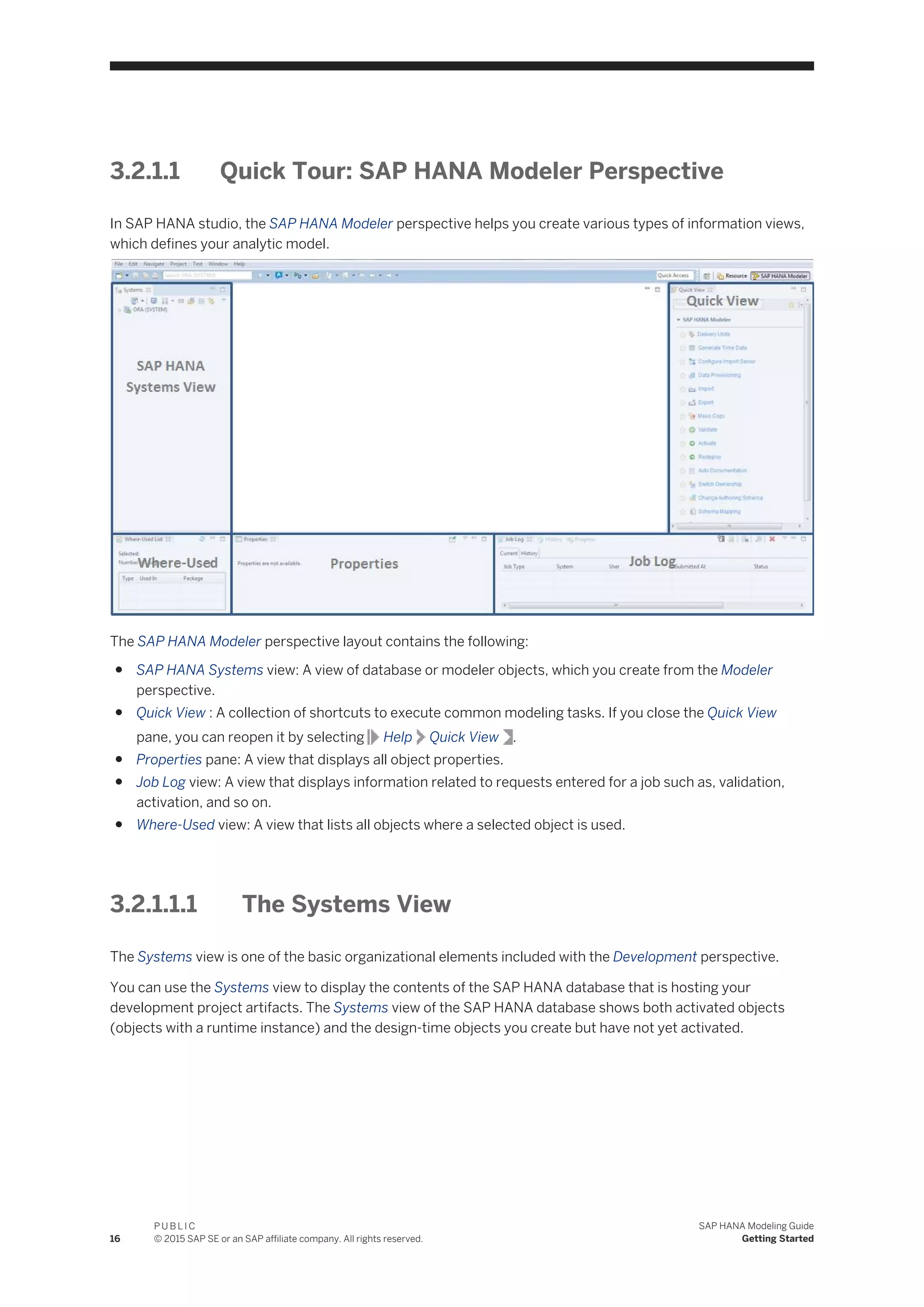


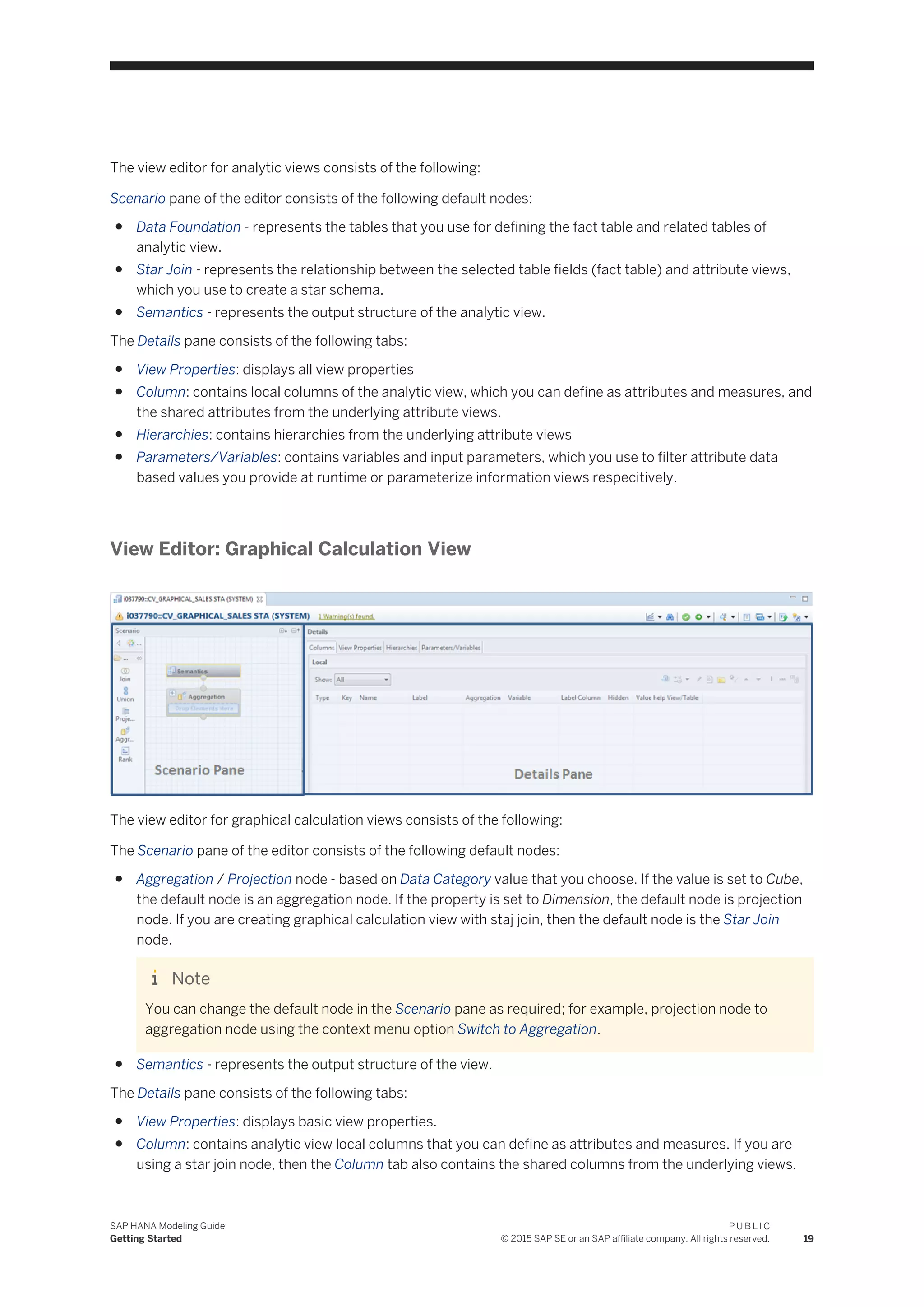
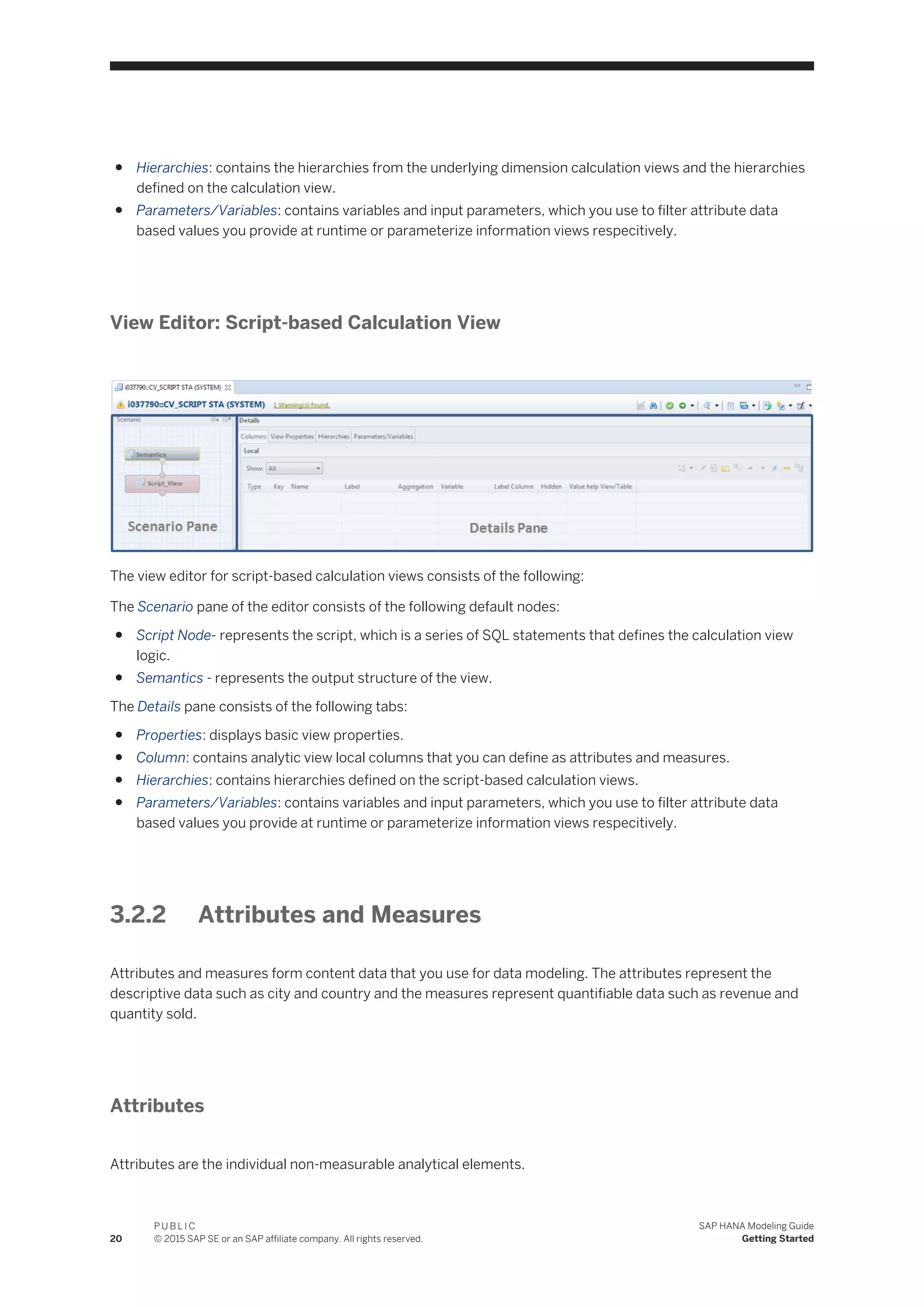
![Table 2:
Attributes Description Example
Simple Attributes Simple attributes are individual non-
measurable analytical elements that are
derived from the data foundation.
For example, PRODUCT_ID and PRODUCT_NAME
are attributes of a PRODUCT subject area.
Calculated Attributes Calculated attributes are derived from
one or more existing attributes or con
stants.
For example, deriving the full name of a customer
(first and last name), assigning a constant value to
an attribute that can be used for arithmetic calcula
tions.
Local Attributes Local attributes that you use in an ana
lytic view allow you to customize the be
havior of an attribute for only that view.
For example, if an analytic view or a calculation
view includes an attribute view as an underlying
data source, then the analytic view inherits the be
havior of the attributes from the attribute view.
Note
Local attributes convey the table fields avilable in the default node of analytic views.
Measures
Measures are measurable analytical elements. Measures are derived from the analytic and calculation views.
Table 3:
Measures Description Example
Simple Measures A simple measure is a measurable analyti
cal element that is derived from the data
foundation.
For example, PROFIT.
Calculated Measures Calculated measures are defined based
on a combination of data from OLAP
cubes, arithmetic operators, constants,
and functions.
For example, you can use calculated measures to
calculate the total sales of a product across five
regions, or to assign a constant value to a meas
ure for a calculation.
Restricted Measures Restricted measures or restricted col
umns are used to filter attribute values
based on the user-defined rules.
For example, you can choose to restrict the value
for the REVENUE column only for REGION = APJ,
and YEAR = 2012.
Counters Counters add a new measure to the calcu
lation view definition to count the distinct
occurrences of an attribute.
For example, to count how many times product
appears.
Related Information
Working With Attributes and Measures [page 101]
SAP HANA Modeling Guide
Getting Started
P U B L I C
© 2015 SAP SE or an SAP affiliate company. All rights reserved. 21](https://image.slidesharecdn.com/51818a91-dee6-4c9b-b633-0deab6e88220-150721193202-lva1-app6892/75/SAP_HANA_Modeling_Guide_for_SAP_HANA_Studio_en-21-2048.jpg)


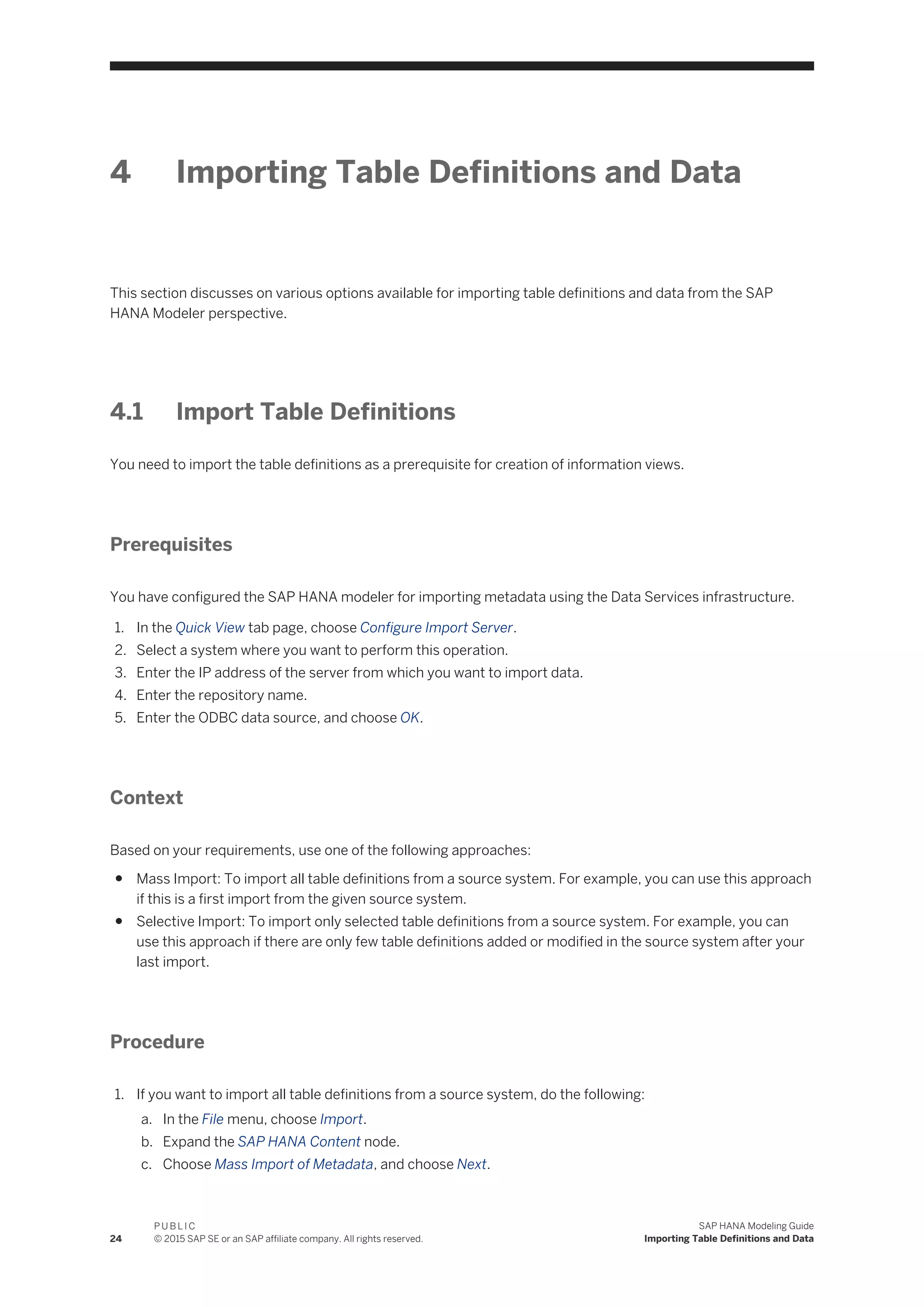
![d. Select the target system where you want to import all the table definitions, and choose Next.
e. In the Connection Details dialog, enter the operating system username and password of the target
system.
f. Select the required source system, and choose Finish.
Note
If the required system is not available from the dropdown list, you need to contact your
administrator.
2. If you only want to import selective table definitions from a source system, do the following:
a. In the File menu, choose Import.
b. Expand the SAP HANA Content node.
c. Choose Selective Import of Metadata, and choose Next.
d. Select the target system where you want to import the table definitions, and choose Next.
e. Select the required source system.
Note
If the required system is not available from the dropdown list, you need to add the new source
system using Manage Connections. For more information about installing and using Manage
Connections functionality, refer to 1942414 .
f. In the Type of Objects to Import field, select the required type, and choose Next.
g. Add the required objects (tables or extractors) that you want to import.
Note
If you want to add dependent tables of a selected table, select the required table in the Target pane,
and choose Add Dependent Tables in the context menu.
h. Select the schema into which you want to import the metadata.
i. If you selected object type as extractor, select the package into which you want to place the
corresponding objects.
j. Choose Next, then review and confirm the import by choosing Finish.
4.2 Load Data into Tables
Before you begin creating information models, you have to import all necessary table definitions into the SAP
HANA database and load them with data.
Prerequisites
● If you are using the Load Controller or Sybase Replication Server infrastructure, make sure that you have
imported all table definitions into the SAP HANA database. For more information, see Import Table
Definitions [page 24].
SAP HANA Modeling Guide
Importing Table Definitions and Data
P U B L I C
© 2015 SAP SE or an SAP affiliate company. All rights reserved. 25](https://image.slidesharecdn.com/51818a91-dee6-4c9b-b633-0deab6e88220-150721193202-lva1-app6892/75/SAP_HANA_Modeling_Guide_for_SAP_HANA_Studio_en-25-2048.jpg)
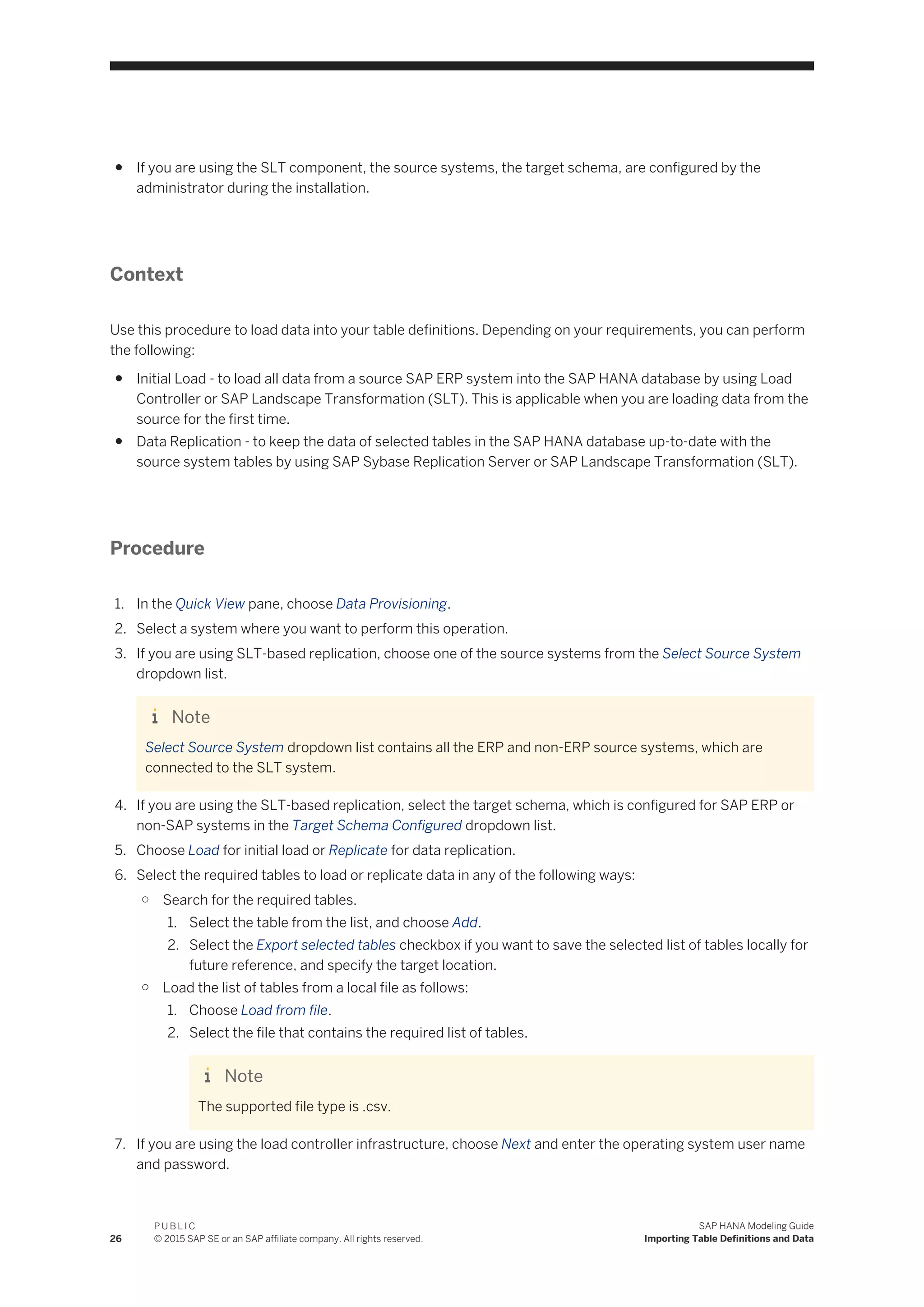
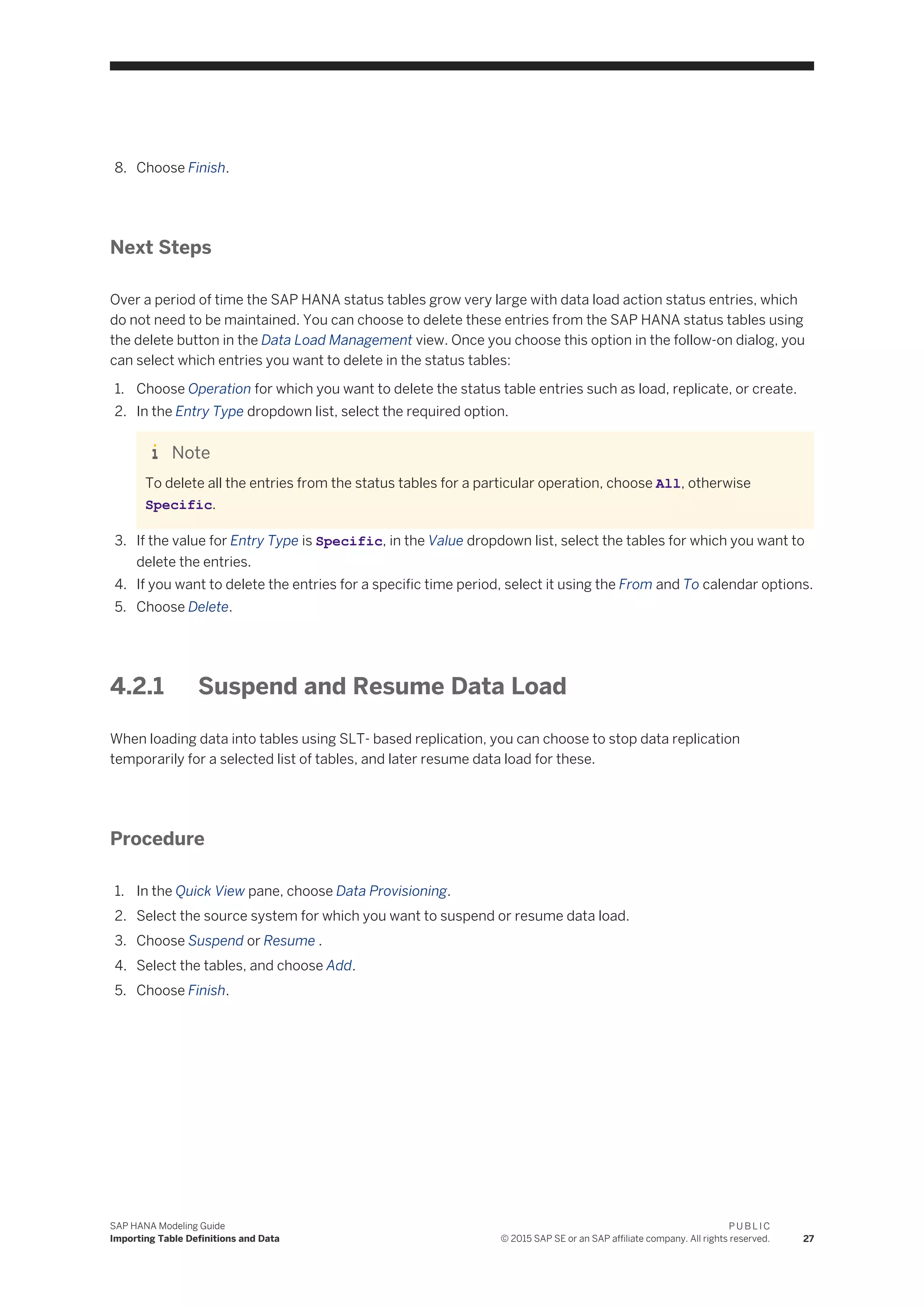


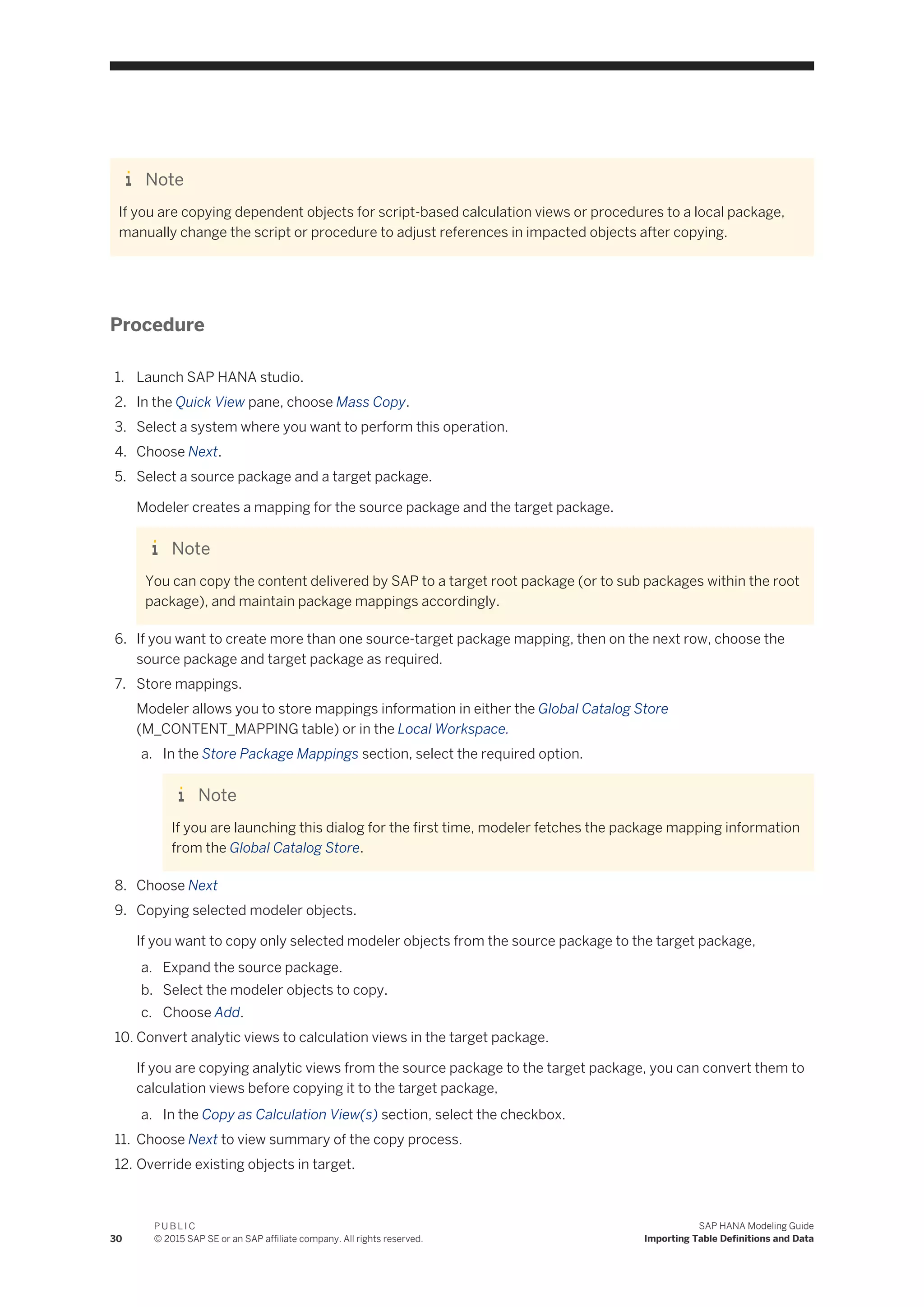
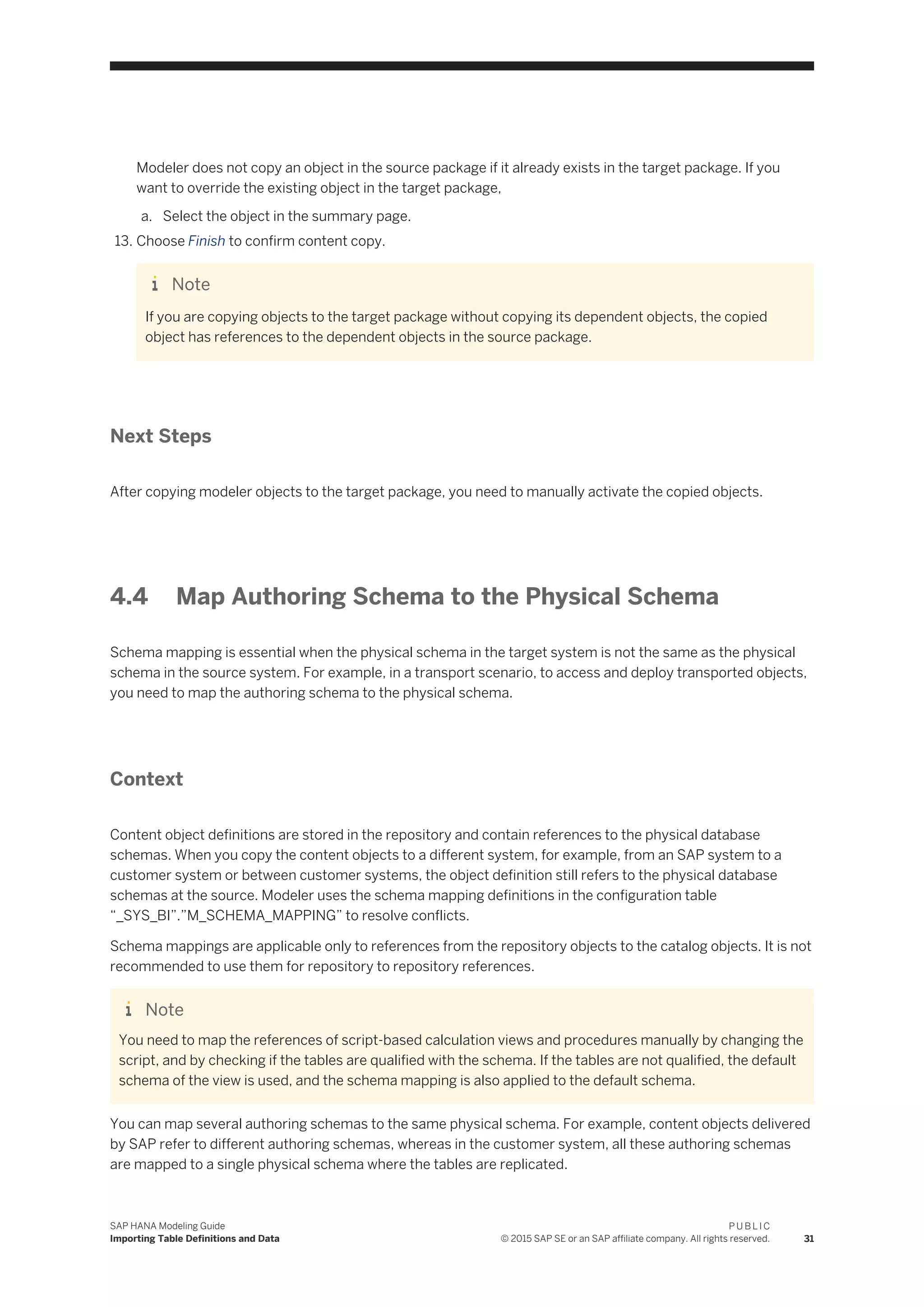
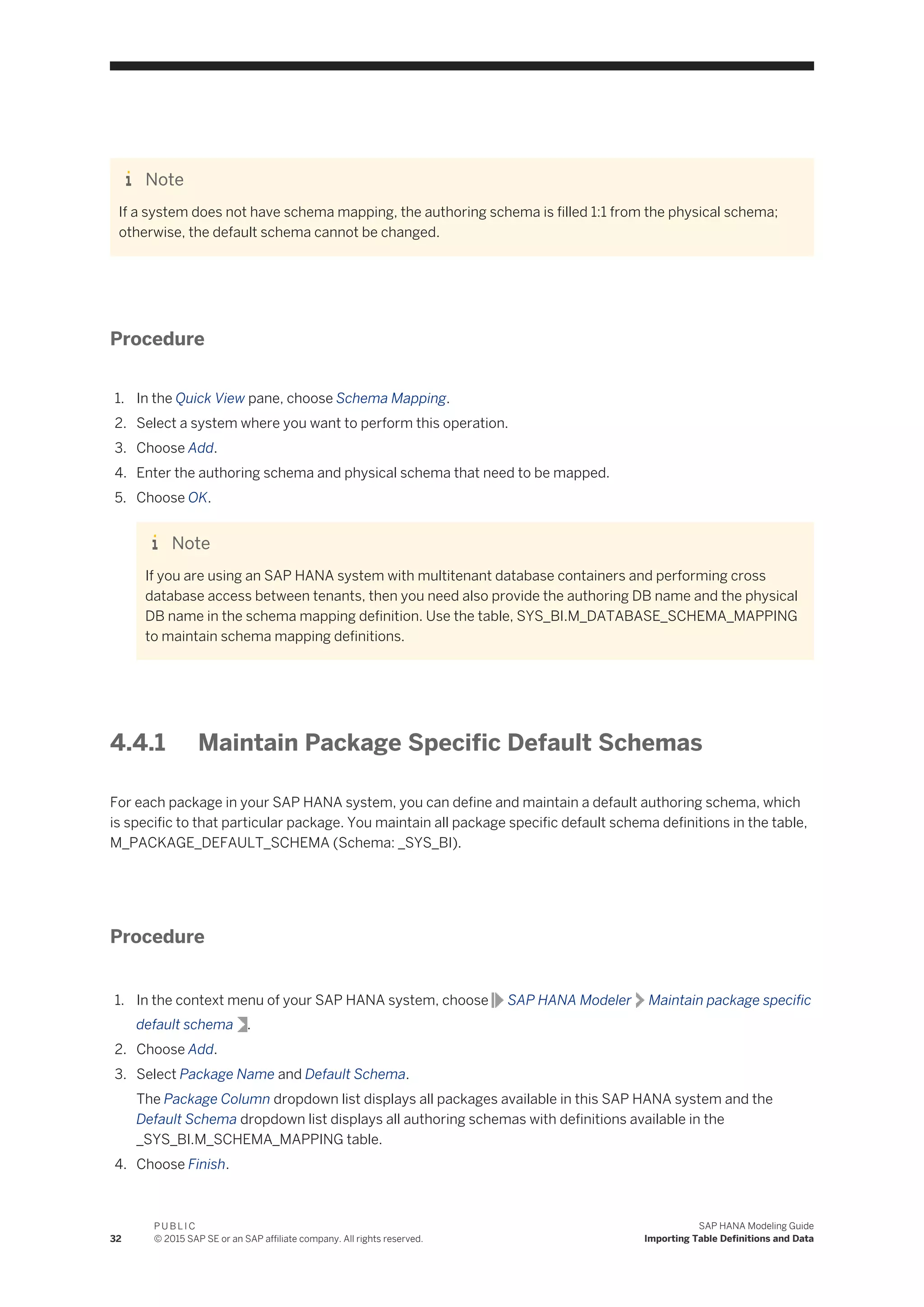

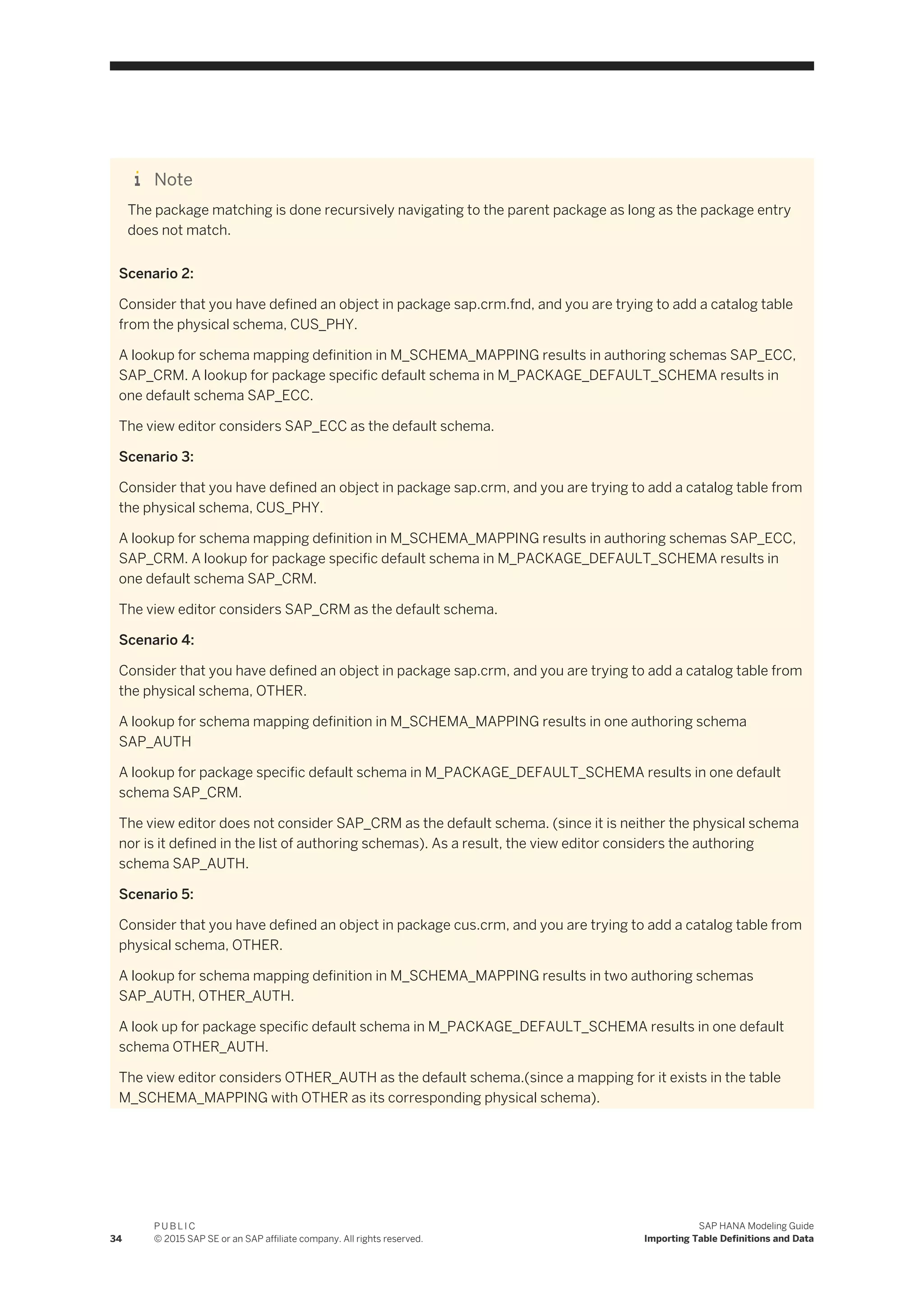
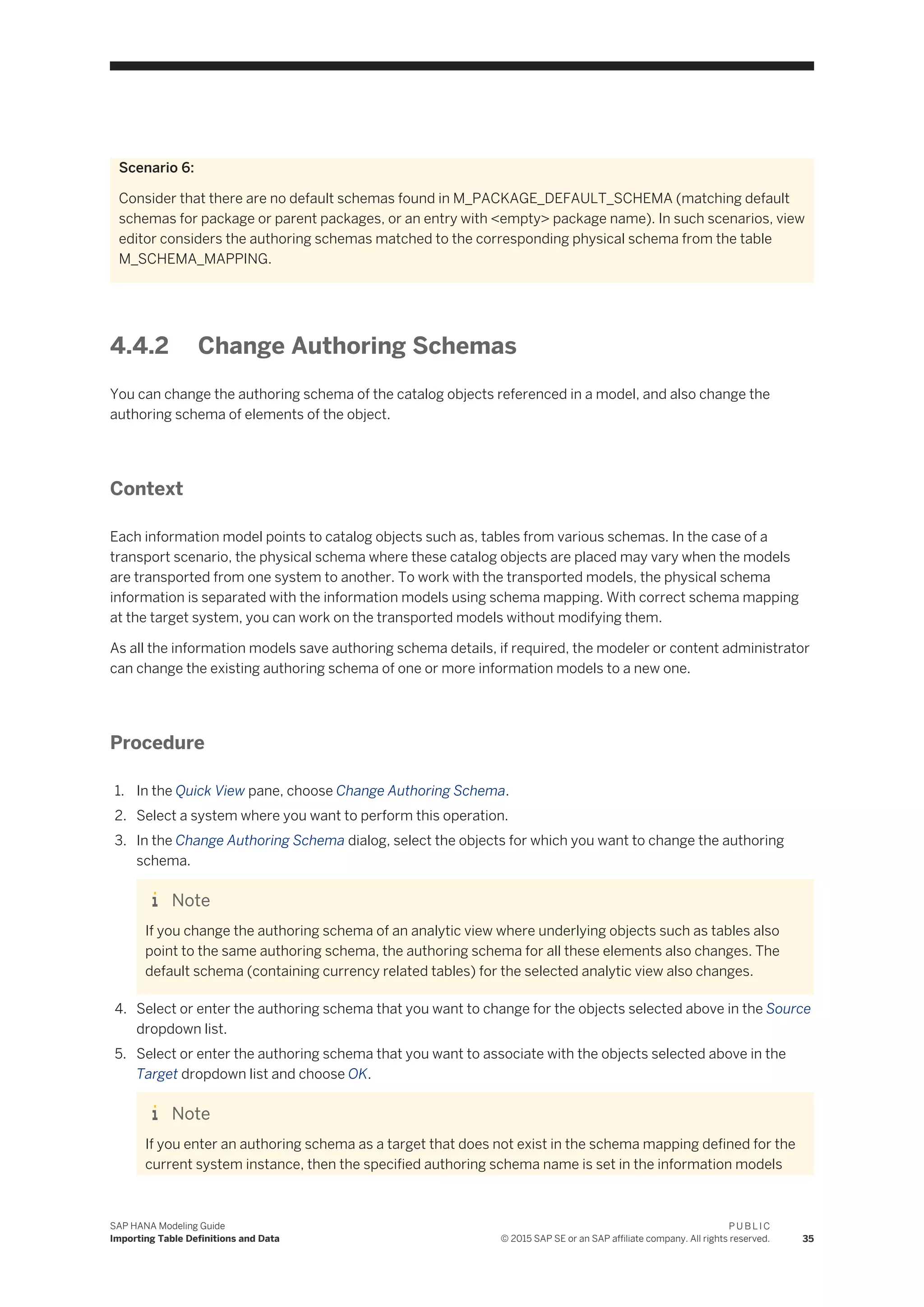

![5 Setting Up the Modeling Environment
This section describes how you can change the default settings and define certain preferences before you
begin working with the SAP HANA modeling environment.
Related Information
Setting Up the Modeling Environment [page 37]
Set Modeler Preferences [page 37]
Apply Filters to Packages [page 40]
Apply Filter to Objects [page 41]
5.1 Set Modeler Preferences
Launch the modeler preferences screen to view and manage the default settings that the system must use
each time you logon to the SAP HANA Modeler perspective.
Procedure
1. Choose Window Preferences SAP HANA Modeler .
2. Choose the type of preference you want to specify.
3. Choose Apply and OK.
Note
Choose Restore Defaults to restore your earlier preferences.
Related Information
Modeler Preferences [page 38]
Keyboard Shortcuts [page 39]
SAP HANA Modeling Guide
Setting Up the Modeling Environment
P U B L I C
© 2015 SAP SE or an SAP affiliate company. All rights reserved. 37](https://image.slidesharecdn.com/51818a91-dee6-4c9b-b633-0deab6e88220-150721193202-lva1-app6892/75/SAP_HANA_Modeling_Guide_for_SAP_HANA_Studio_en-37-2048.jpg)
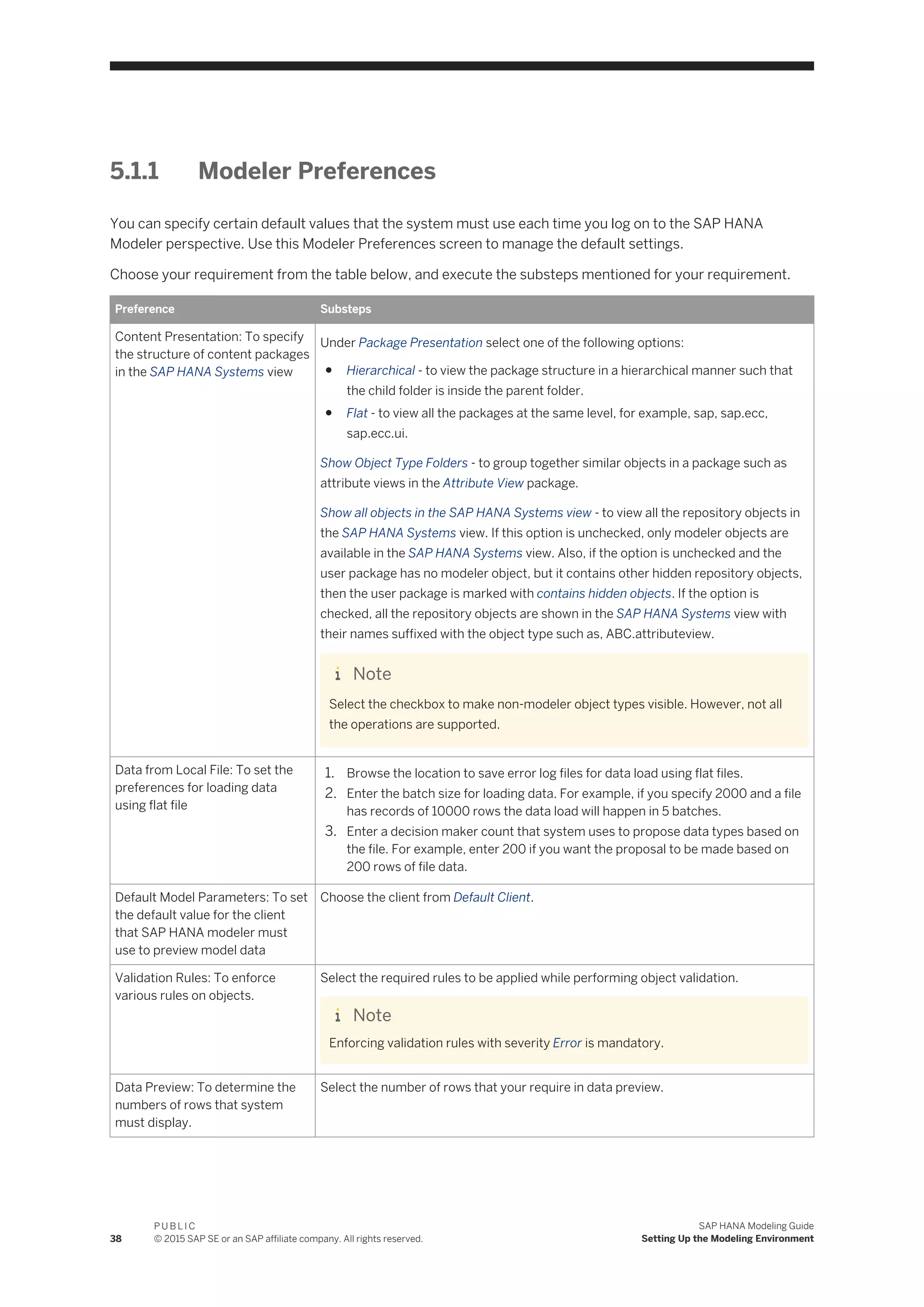
![Preference Substeps
Logs: To specify a location for job
log files
Expand the Logs node and choose Job Log.Browse the location where you want to
save the job log files.
Logs: To enable logging for
repository calls and specify a
location for repository log files
1. Expand the Logs node and select Job Log.
2. Choose True.
3. Browse the location where you want to save the repository log files.
Case Restriction: To allow lower
case alphabets for attribute view,
analytic view, calculation view,
procedure, and analytic privilege
names
Deselect the Model name in upper case checkbox.
Field Name Preferences: To use
Unicode character sets in name
fields of information views, and in
names of its elements (such as
input parameter names, variable
names, hierarchy names, and so
on).
Select Allow Unicode characters
Unicode characters helps you to use multilingual text of languages that you desire.
The SAP HANA Modeler perspective supports Unicode characters with the exception
of a small subset. The list of Unicode characters that are not supported includes,
slashes ( /, ), colon and semi-colon ( :, ; ), asterisk ( * ), question mark ( ? ), single
and double quotes ( ", '), lesser than and greater than (<, >), pipe ( | ), comma ( , ) ,
dollar ( $ ), percentage ( % ), exclamation mark ( ! ), hash sign ( # ), plus sign ( + ),
ampersand ( &), period ( . ) and space.
5.1.2 Keyboard Shortcuts
Keyboard shortcuts to perform your modeling activities such activate, validate, data preview, and so on.
The table below lists the commands and the keyboard shortcuts to execute those commands:
Table 8:
Command Binding When Category
Activate Ctrl+Shift+A Navigator Modeler Keys
Activate Ctrl+Shift+A In Windows Modeler Keys
Add Table/Model Ctrl+Shift+= In Windows Modeler Keys
Auto Arrange Ctrl+L In Windows Modeler Keys
Data Preview Ctlr+Shift+P Navigator Modeler Keys
Data Preview Ctlr+Shift+P In Windows Modeler Keys
Display XML Alt+D In Windows Modeler Keys
Find Ctrl+F Navigator Modeler Navigator
Fit to Window Ctrl+0 In Windows Modeler Keys
Move Element in Output
Pane (Direction: Down)
Ctrl+] In Windows Modeler Keys
Move Element in Output
Pane (Direction: Up)
Ctrl+[ In Windows Modeler Keys
SAP HANA Modeling Guide
Setting Up the Modeling Environment
P U B L I C
© 2015 SAP SE or an SAP affiliate company. All rights reserved. 39](https://image.slidesharecdn.com/51818a91-dee6-4c9b-b633-0deab6e88220-150721193202-lva1-app6892/75/SAP_HANA_Modeling_Guide_for_SAP_HANA_Studio_en-39-2048.jpg)
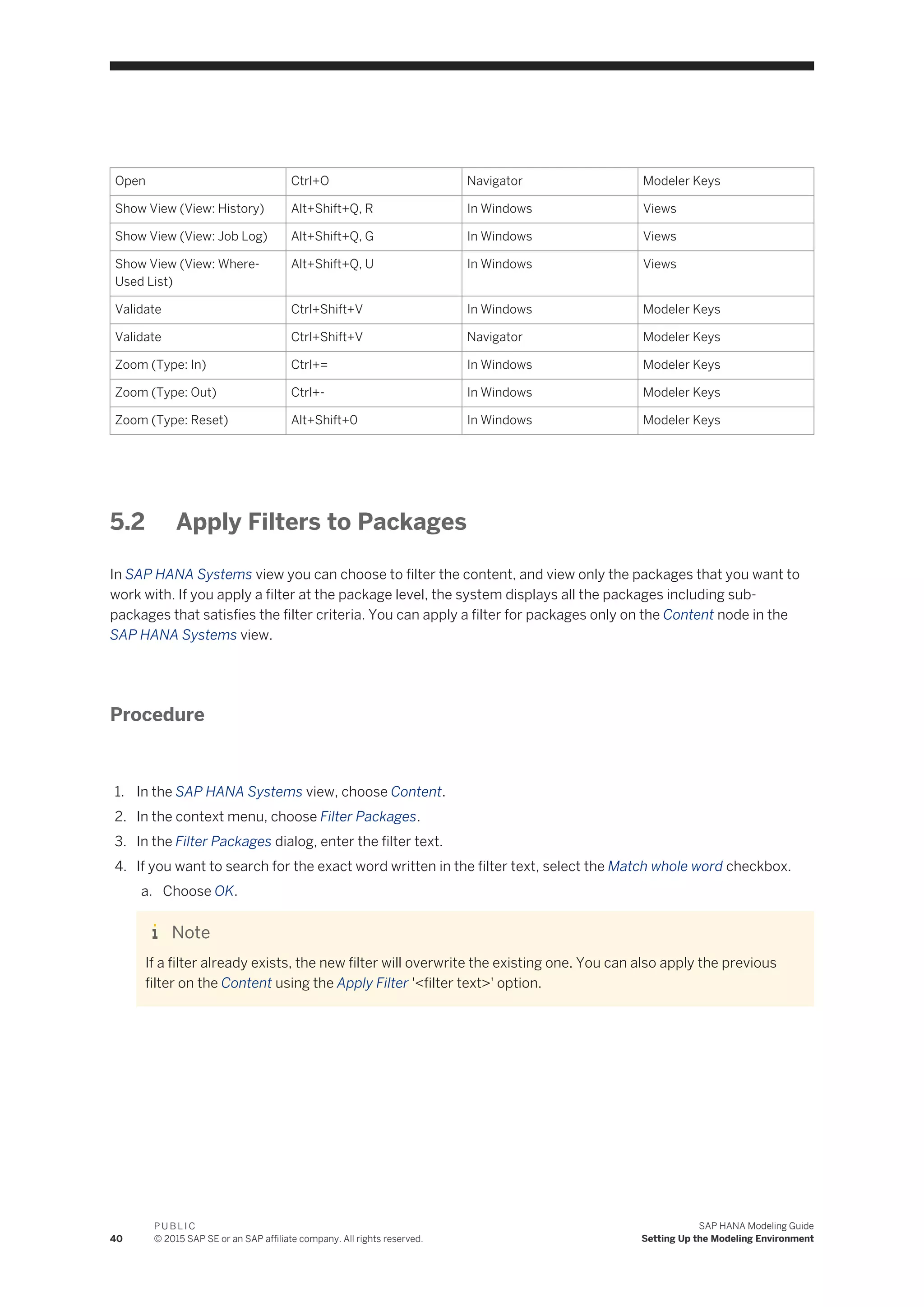
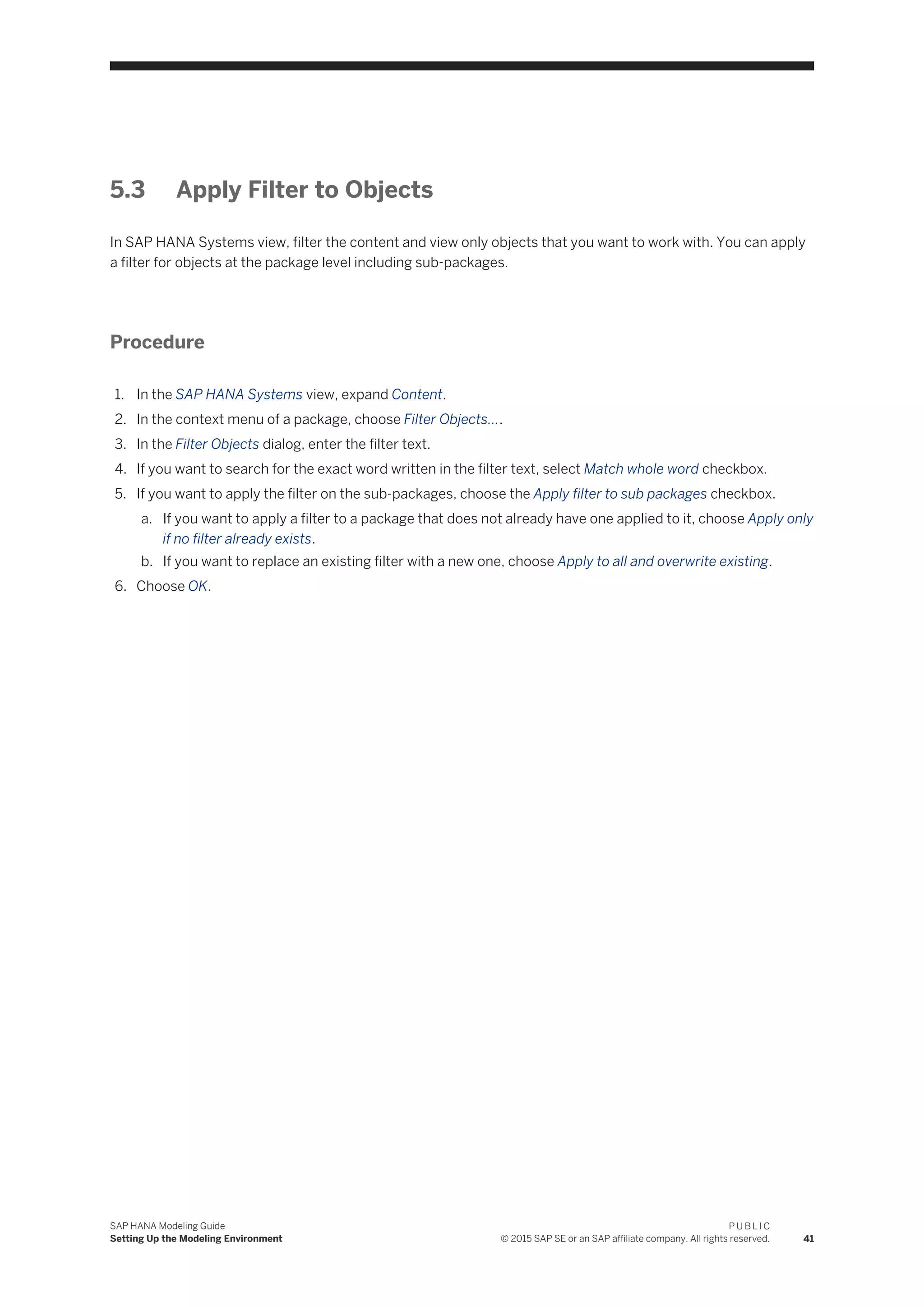
![6 Creating Information Views and
Previewing its Output
Information views are used for analytical use cases such as operational data mart scenarios or
multidimensional reporting on revenue, profitability, and so on. There are three types of information views:
attribute view, analytic view, and calculation view.
All three types of information views that you create in SAP HANA Modeler perspective are non-materialized
views, which creates agility through the rapid deployment of changes. You can create information views to
depict a business scenario using content data (attributes and measures). This sections describes how you can
create and use the different information views that SAP HANA modeler supports.
Related Information
Generate Time Data [page 42]
Using Attribute Views [page 44]
Using Analytic Views [page 49]
Using Calculation Views [page 57]
Preview Information View Output [page 97]
6.1 Generate Time Data
Generate time data into default time-related tables present in the _SYS_BI schema and use these tables in
information views to add a time dimension.
Context
For modeling business scenarios that require time dimension, you generate time data in default time related
tables available in the _SYS_BI schema. You can select the calendar type and granularity and generate the
time data for a specific time span.
Procedure
1. Launch SAP HANA studio.
42
P U B L I C
© 2015 SAP SE or an SAP affiliate company. All rights reserved.
SAP HANA Modeling Guide
Creating Information Views and Previewing its Output](https://image.slidesharecdn.com/51818a91-dee6-4c9b-b633-0deab6e88220-150721193202-lva1-app6892/75/SAP_HANA_Modeling_Guide_for_SAP_HANA_Studio_en-42-2048.jpg)
![2. In the Quick View pane, choose Generate Time Data.
3. Select a system where you want to perform this operation.
4. Choose Next.
5. In the Calendar Type dropdown list, select a calendar type.
6. In the From Year and To Year textboxes, enter the time range for which you want to generate time data
into time-related tables.
7. If you have selected the Gregorian calendar type, in the Granularity dropdown list select the required
granularity.
Note
For the granularity level Week, you need to specify the first day of the week.
8. If you have selected the Fiscal calendar type,
a. In Variant Schema dropdown list, select a variant schema that contains tables having variant data.
Note
Tables T009 and T009B contain variant data.
b. Select the required variant.
The variant specifies the number of periods along with the start and end dates.
9. Choose Finish.
Note
For the Gregorian calendar type, modeler generates time dimension data into
M_TIME_DIMENSION_YEAR, M_TIME_DIMENSION_MONTH, M_TIME_DIMENSION_WEEK,
M_TIME_DIMENSION tables and for the Fiscal calendar type, the modeler populates the generated time
dimension data into the M_FISCAL_CALENDAR table. These tables are present in _SYS_BI schema.
Related Information
Supported Calendar Types to Generate Time Data [page 43]
Time Range to Generate Time Data [page 44]
6.1.1 Supported Calendar Types to Generate Time Data
SAP HANA modeler supports generating time dimension data using the Fiscal or Gregorian calendar types.
The table below provides more information on each of the calendar types.
SAP HANA Modeling Guide
Creating Information Views and Previewing its Output
P U B L I C
© 2015 SAP SE or an SAP affiliate company. All rights reserved. 43](https://image.slidesharecdn.com/51818a91-dee6-4c9b-b633-0deab6e88220-150721193202-lva1-app6892/75/SAP_HANA_Modeling_Guide_for_SAP_HANA_Studio_en-43-2048.jpg)

![attribute view adds more columns and also hierarchies as further analysis criteria to the analytic view. In the
star schema of the analytic view, the attribute view is shown as a single dimension table (although it might join
multiple tables), that can be joined to a fact table. For example, attribute views can be used to join employees
to organizational units which can then be joined to a sales transaction via an analytic view
You can create hierarchies to arrange the attributes hierarchically. Hierarchies helps you to visualize and
analyze the data in a hierarchical fashion. You can create Level hierarchies and Parent Child hierarchies by
specifying the attributes that correspond to different levels, and parent child nodes respectively.
Related Information
Create Attribute Views [page 45]
6.2.1 Create Attribute Views
You can create a view that is used to model descriptive attribute data by using attributes, that is data that does
not contain measures. Attribute views are used to define joins between tables and to select a subset or all of
the table's columns and rows.
Prerequisites
You have imported SAP system tables T009 and T009B tables of type Time to create time attribute views.
Procedure
1. Launch SAP HANA studio.
2. In SAP HANA System view, expand the content node.
3. In the navigator, select a package where you want to create the new calculation view.
4. In the context menu of the package, select New Attribute View
5. Provide name and description.
6. In the Subtype dropdown list, select the type of the attribute view.
7. Choose Finish.
8. Add data sources.
a. Select the data foundation node.
b. In the context menu, choose Add Objects.
c. In Find Data Sources dialog, enter the name of the data source and select it from the list.
SAP HANA Modeling Guide
Creating Information Views and Previewing its Output
P U B L I C
© 2015 SAP SE or an SAP affiliate company. All rights reserved. 45](https://image.slidesharecdn.com/51818a91-dee6-4c9b-b633-0deab6e88220-150721193202-lva1-app6892/75/SAP_HANA_Modeling_Guide_for_SAP_HANA_Studio_en-45-2048.jpg)
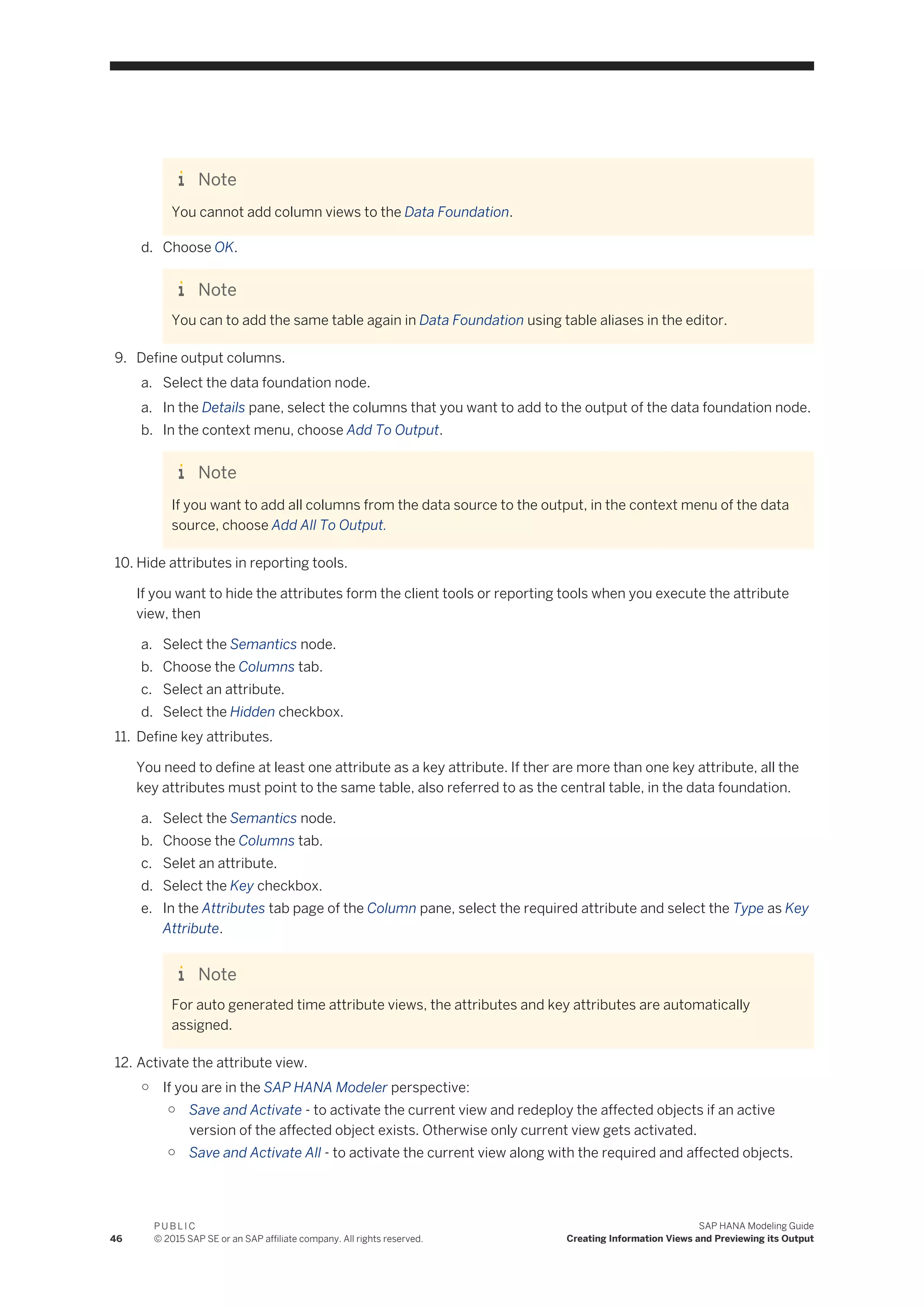
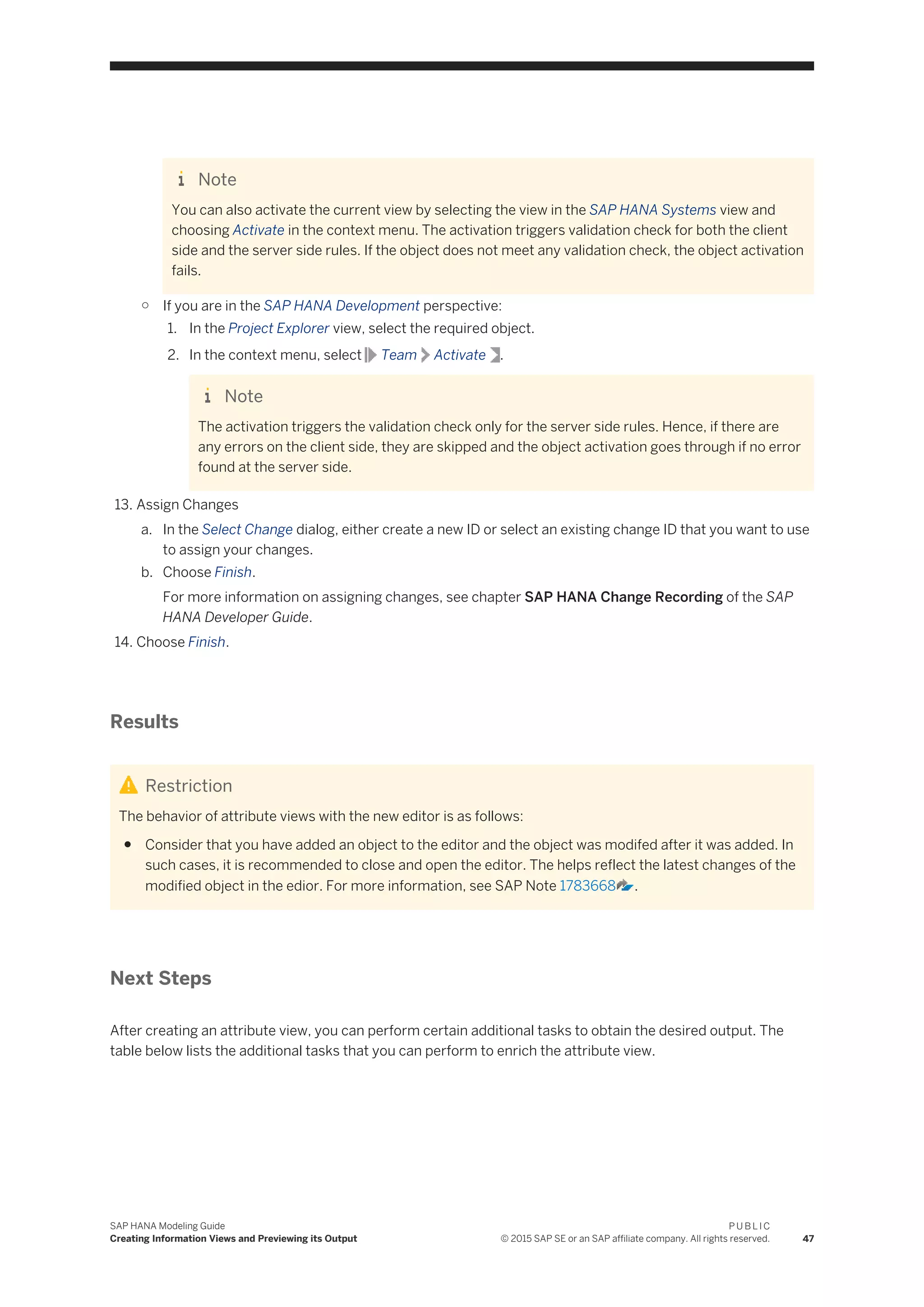
![Table 10:
Requirement Task to Perform
If you want to filter the output of data foundation node. Filter Output of Data Foundation
Node.
Table 11: Working With Attributes
Requirement Task to perform
If you want to create new output columns and calculate its values at runtime using
an expression.
Create Calculated Columns
If you want to assign semantic types to provide more meaning to attributes in the
attribute views.
Assign Semantics
If you want to create level hierarchies to organize data in reporting tools. Create Level Hierarchies
If you want to create parent-child hierarchies to organize data in reporting tools. Create Parent-Child Hierarchies
Table 12: Working With Attribute View Properties
Requirement Task to perform
If you want to filter the view data either using a fixed client value or using a session
client set for the user.
Filter Data for Specific Clients
If you want to execute time travel queries on attribute views. Enable Information Views for Time
Travel Queries
If you want to invalidate or remove data from the cache after specific time intervals. Invalidate Cached Content
If you want to maintain object label texts in different languages. Maintain Modeler Objects in Multi
ple Languages
If you do not recommend using an attribute view. Deprecate Information Views
Related Information
Attribute View Types [page 49]
Create Calculated Columns [page 104]
Assign Semantics [page 111]
Create Level Hierarchies [page 127]
Create Parent-Child Hierarchies [page 130]
Deprecate Information Views [page 148]
Filter Data for Specific Clients [page 149]
Enable Information Views for Time Travel Queries [page 151]
Invalidate Cached Content [page 152]
Maintain Modeler Object Labels in Multiple Languages [page 153]
Quick Reference: Information View Properties [page 154]
Preview Information View Output [page 97]
48
P U B L I C
© 2015 SAP SE or an SAP affiliate company. All rights reserved.
SAP HANA Modeling Guide
Creating Information Views and Previewing its Output](https://image.slidesharecdn.com/51818a91-dee6-4c9b-b633-0deab6e88220-150721193202-lva1-app6892/75/SAP_HANA_Modeling_Guide_for_SAP_HANA_Studio_en-48-2048.jpg)

![you can use aliases to avoid name conflicts. From the Details pane, select a table and provide your Alias
Name value in the table properties pane. You can use this alias value for all references to the table.
If you are not able to activate your information view because of name conflicts between shared and local
attributes of a column view, then you can use aliases to resolve such conflicts and activate the information
view. Select the semantics node and in the Shared Attribute pane, provide Alias Name and Alias Label
values.
If you come across errors due to aliases, while trying to open an information view that was already created,
then you can use the Quick Fix option to resolve the error. Select the error message or the problem in the
Problems view, and choose Quick Fix in the context menu. This resolves the issue by assigning right names
to the column and alias.
You can choose to hide the attributes and measures that are not required for client consumption by assigning
value true to the property Hidden in the Properties pane, or selecting the Hidden checkbox in the Column
view. The attributes or measures marked as hidden are not available for input parameters, variables,
consumers or higher level views that are build on top of the analytic view. For old models (before SPS06), if the
hidden attribute is already used, you can either unhide the element or remove the references.
For an analytic view, you can set the property Data Category to Cube or Dimension. If the Data Category
property of the analytic view is set to Dimension, the view will not be available for multidimensional reporting
purposes. If the value is set to Cube, an additional column Aggregation is available to specify the aggregation
type for measures.
You can enable relational optimization for your analytic view such as, Optimize stacked SQL for example,
convert
SELECT a, SUM(X) FROM ( SELECT * FROM AV) GROUP BY A
to
SELECT A, SUM(X) FROM AV GROUP BY A
by setting the property Allow Relational Optimization.
Setting this property would be effective only for analytic views having complex calculations such that
deployment of analytic view generates catalog calculation view on top of the generated catalog OLAP view.
Caution
In this case, if this flag is set counters and SELECT COUNT may deliver wrong results
Related Information
Create Analytic Views [page 51]
Map Parameters or Variables of External Views for Value Help [page 123]
Create Temporal Joins [page 55]
50
P U B L I C
© 2015 SAP SE or an SAP affiliate company. All rights reserved.
SAP HANA Modeling Guide
Creating Information Views and Previewing its Output](https://image.slidesharecdn.com/51818a91-dee6-4c9b-b633-0deab6e88220-150721193202-lva1-app6892/75/SAP_HANA_Modeling_Guide_for_SAP_HANA_Studio_en-50-2048.jpg)
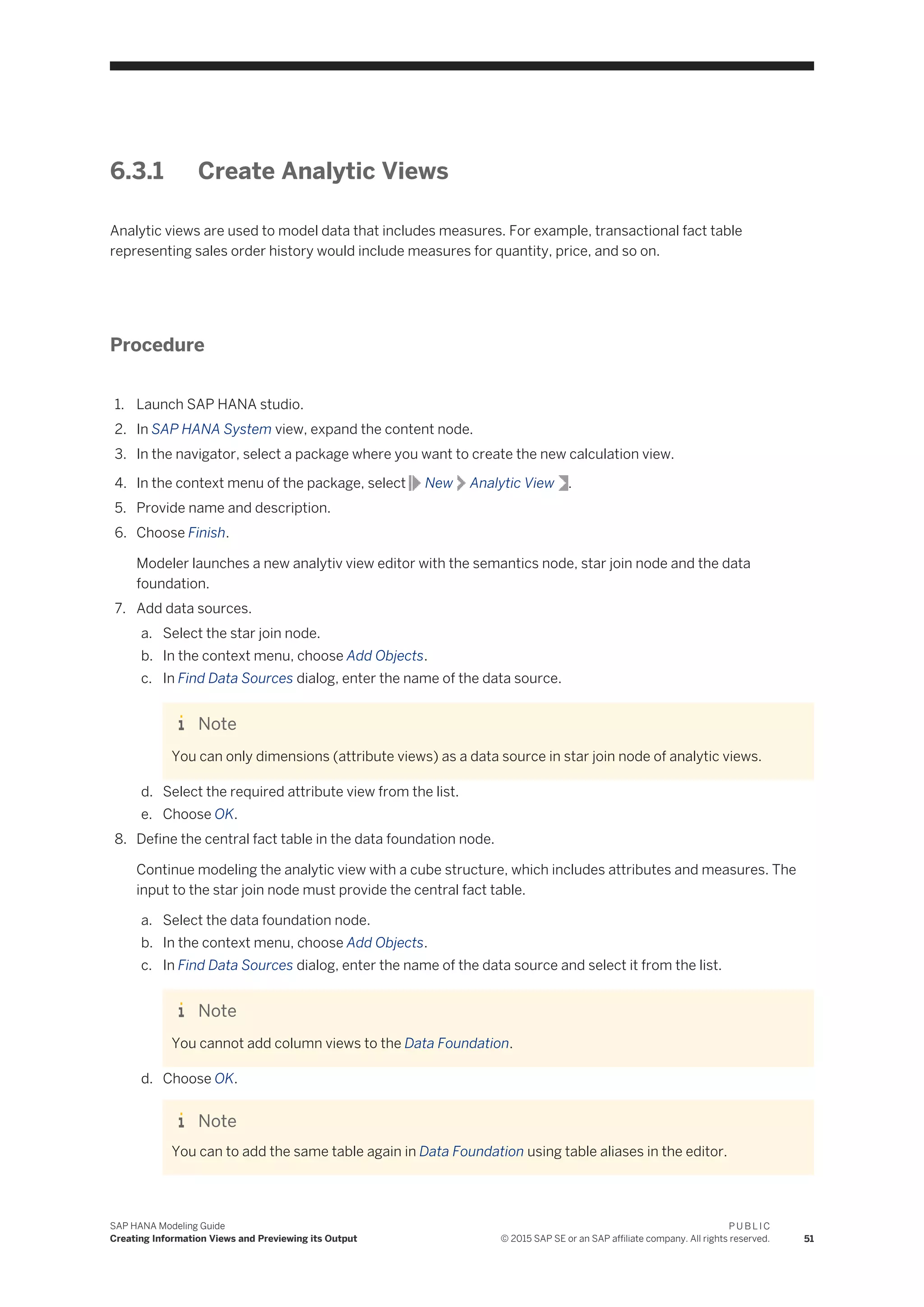
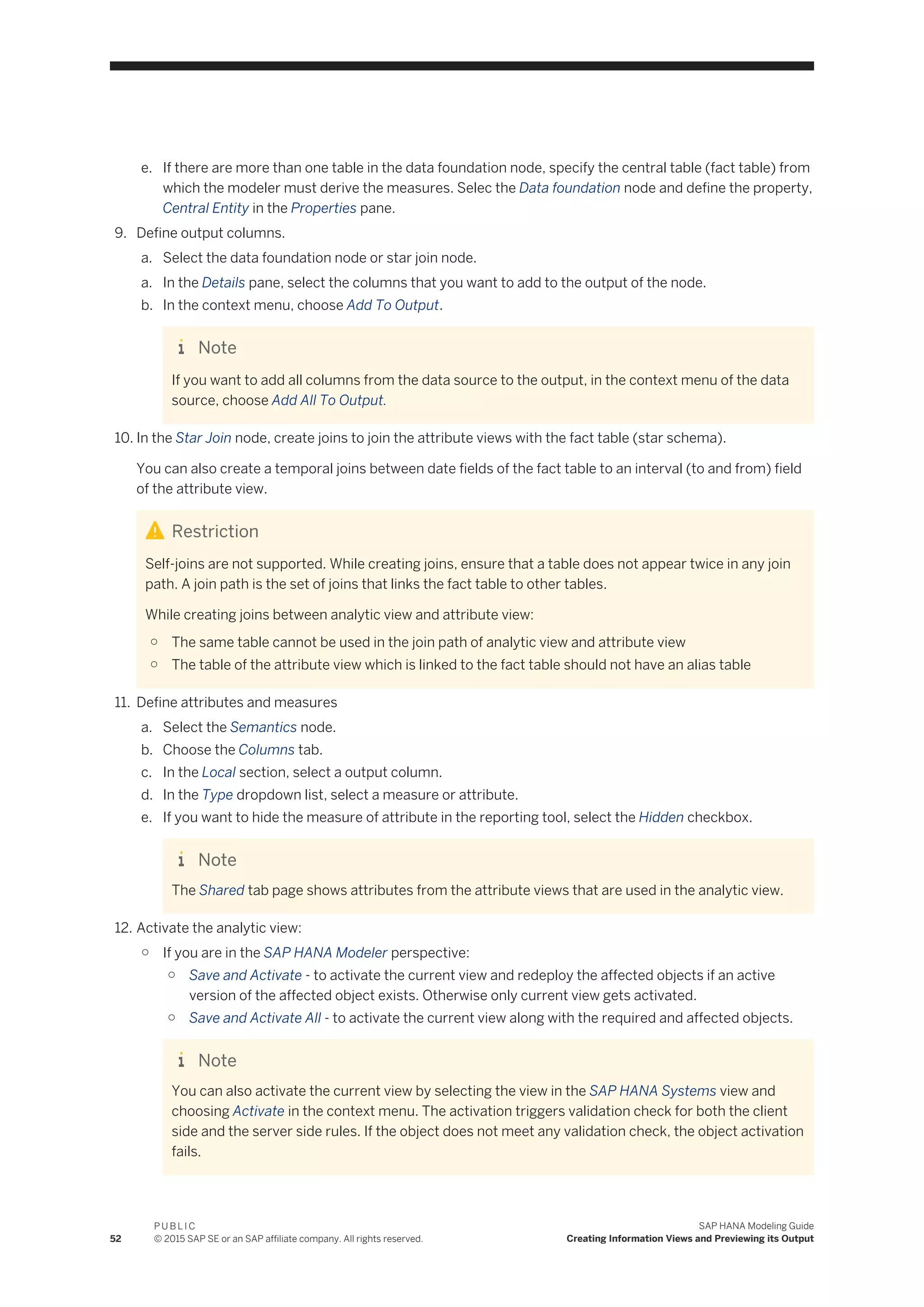

![Requirement Task to perform
If you want to create new output columns and calculate its values at runtime using
an expression.
Create Calculated Columns
If you want to restrict measure values based on attribute restrictions. Create Restricted Columns
If you want to assign semantic types to provide more meaning to attributes and
measures in analytic views.
Assign Semantics
If you want to parameterize attribute views and execute them based on the values
users provide at query runtime.
Create Input Parameters
If you want to, for example, filter the results based on the values that users provide
to attributes at runtime.
Assign Variables
If you want associate measures with currency codes and perform currency conver
sions.
Associate Measures with Currency
If you want associate measures with unit of measures and perform unit conversions. Associate Measures with Unit of
Measure
If you want to group related measures together in a folder. Group Related Measures.
Table 16: Working With Ananlytic View Properties
Requirement Task to perform
If you want to filter the view data either using a fixed client value or using a session
client set for the user.
Filter Data for Specific Clients
If you want to execute time travel queries on analytic views. Enable Information Views for Time
Travel Queries
If you want to invalidate or remove data from the cache after specific time intervals. Invalidate Cached Content
If you want to maintain object label texts in different languages. Maintain Modeler Objects in Multi
ple Languages
If you do not recommend using an anlytic view. Deprecate Information Views
Related Information
Create Temporal Joins [page 55]
Preview Information View Output [page 97]
Working With Attributes and Measures [page 101]
Working With Information View Properties [page 148]
Quick Reference: Information View Properties [page 154]
54
P U B L I C
© 2015 SAP SE or an SAP affiliate company. All rights reserved.
SAP HANA Modeling Guide
Creating Information Views and Previewing its Output](https://image.slidesharecdn.com/51818a91-dee6-4c9b-b633-0deab6e88220-150721193202-lva1-app6892/75/SAP_HANA_Modeling_Guide_for_SAP_HANA_Studio_en-54-2048.jpg)
![6.3.1.1 Create Temporal Joins
Temporal joins allow you to join the master data with the transaction data (fact table) based on the temporal
column values from the transaction data and the time validity from the master data.
Procedure
1. Open the analytic view in the view editor.
2. Select the Star Join node.
The star join node must contain the master data as a data source. The input to the star join node (the data
foundation node) provides the central fact table.
3. Create a join
Create a join by selecting a column from one data source (master table), holding the mouse button down
and dragging to a column in the other data source (fact table).
4. Select the join.
5. In the context menu, choose Edit.
6. Define join properties.
In the Properties section, define the join properties.
Note
For temporal joins, you can use Inner or Referential join types only.
7. Define temporal column and temporal conditions
In the Temporal Properties section, provide values to create temporal join.
a. In the Temporal Column dropdown list, select a time column in the analytic view.
b. In the From Column and To Columndropdown lists specify the start and end time values from the
attribute view to fetch the records.
c. In the Temporal Condition dropdown list, select a condition.
8. Choose OK.
Related Information
Temporal Joins [page 56]
Temporal Conditions [page 56]
Example: Temporal Joins [page 56]
SAP HANA Modeling Guide
Creating Information Views and Previewing its Output
P U B L I C
© 2015 SAP SE or an SAP affiliate company. All rights reserved. 55](https://image.slidesharecdn.com/51818a91-dee6-4c9b-b633-0deab6e88220-150721193202-lva1-app6892/75/SAP_HANA_Modeling_Guide_for_SAP_HANA_Studio_en-55-2048.jpg)

![For creating the temporal join, you can use the DATE attribute from the analytic view as the temporal column
and use the VALID_FROM_DATAE and VALID_TO_DATE attributes from the attribute view (master data) to
specify the time period for which the record set is valid.
6.4 Using Calculation Views
A calculation view is a powerful and flexible information view, which you can use to define more advanced
slices on the data available in the SAP HANA database. Calculation views are simple and they mirror the
functionality found in both attribute views and analytic views and much more.
However, you use calculation views when your business use case requires advanced logic, which you cannot
achieve by creating the previous analytic views or attribute views. For example, you can create calculation
views with layers of calculation logic, which includes measures sourced from multiple source tables, or
advanced SQL logic, and so on. The data foundation of the calculation view can include any combination of
tables, column views, attribute views and analytic views. You can create joins, unions, projections, and
aggregation levels on data sources.
Calculation views can include measures and be used for multidimensional reporting or can contain no
measures and used for list-type reporting. There are two types of calculation views that you can create:
● Graphical calculation views, which you can create using a graphical editor.
● Script-based calculation views, which can you create by writing SQL scripts.
Characteristics of calculation views:
● Supports both OLAP and OLTP models.
● Supports complex expressions (i.e. IF, Case, Counter).
● Supports reusing Analytic views, Attribute views and other Calculation views (Graphical and Scripted).
● Supports analytic privileges (i.e. restricting a user for a certain cost center).
● Supports SAP ERP specific features (i.e. client handling, language, currency conversion).
● Provides ability to combine facts from multiple tables.
● Provides support for additional data processing operations, (i.e. Union, explicit aggregation).
● Provides ability to leverage specialized languages (i.e. R-Lang).
● Provides ability to leverage both Column and Row tables.
● Performance of certain operations (i.e. star-join, aggregation) are inferior to Analytical Views.
Related Information
Create Script-Based Calculation Views [page 58]
Create Graphical Calculation Views [page 63]
Supported Data Categories for Information Views [page 75]
Working With Information View Properties [page 148]
Quick Reference: Information View Properties [page 154]
SAP HANA Modeling Guide
Creating Information Views and Previewing its Output
P U B L I C
© 2015 SAP SE or an SAP affiliate company. All rights reserved. 57](https://image.slidesharecdn.com/51818a91-dee6-4c9b-b633-0deab6e88220-150721193202-lva1-app6892/75/SAP_HANA_Modeling_Guide_for_SAP_HANA_Studio_en-57-2048.jpg)
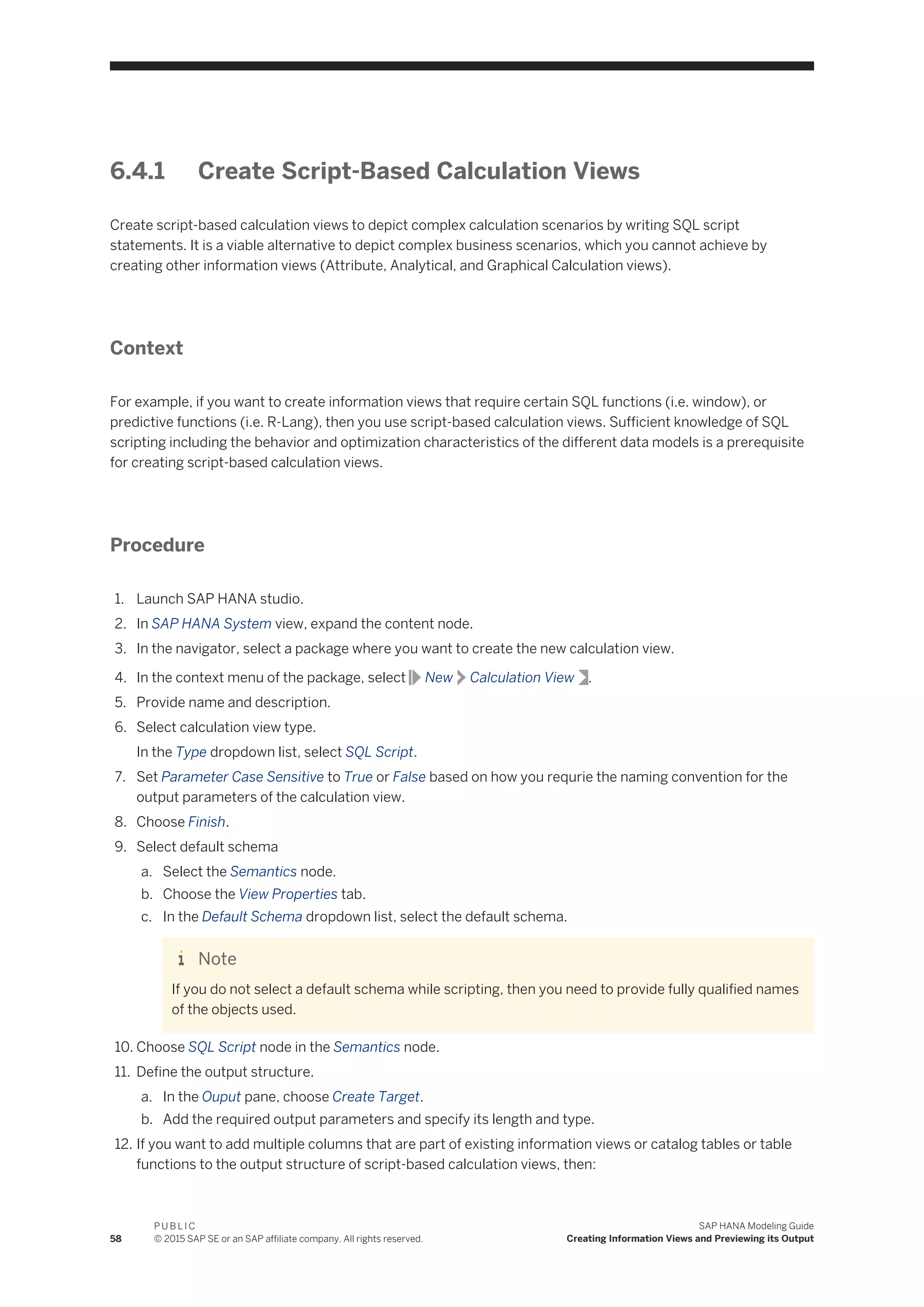

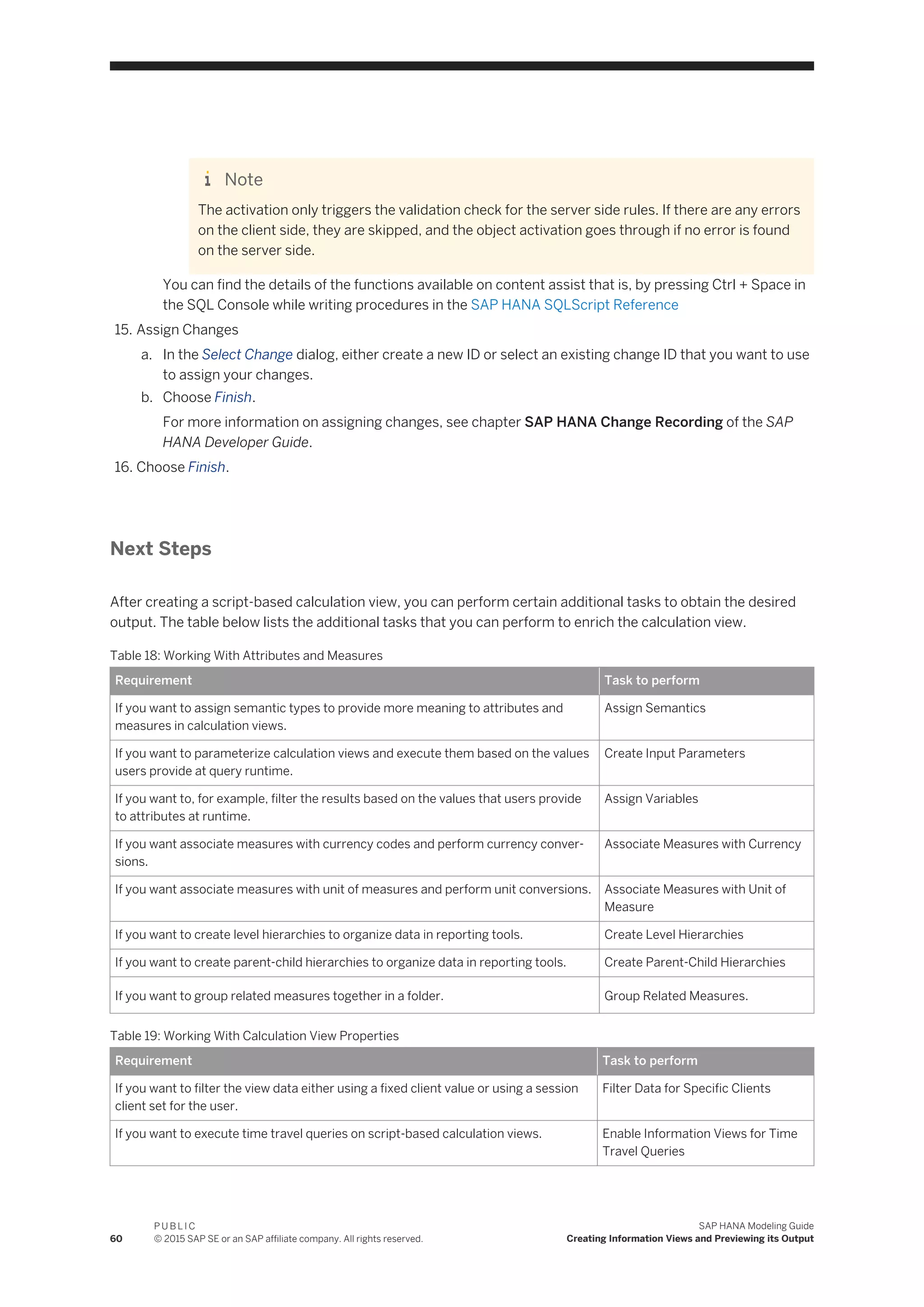
![Requirement Task to perform
If you want to invalidate or remove data from the cache after specific time intervals. Invalidate Cached Content
If you want to maintain object label texts in different languages. Maintain Modeler Objects in Multi
ple Languages
If you do not recommend using a script-based calculation view. Deprecate Information Views
Related Information
Use Script-based Calculation Views as Table Functions [page 61]
Preview Information View Output [page 97]
Working With Attributes and Measures [page 101]
Working With Information View Properties [page 148]
Quick Reference: Information View Properties [page 154]
Supported Data Categories for Information Views [page 75]
6.4.1.1 Use Script-based Calculation Views as Table
Functions
SAP HANA modeler allows you to save both existing and new script-based calculations views as table
functions, and use these table functions as a data source in your graphical calculation views.
Context
Script-based calculation views supports only one script view node. However, with table functions as a data
source in graphical calculation views, you can use the script (table function) and also combine it with other
view nodes such as union, join, and so on.
.
Note
You cannot create, view, or modify table functions in the SAP HANA Modeler perspective. You use the
project explorer view or the repositories view of the SAP HANA Development perspective to perform these
tasks.
SAP HANA Modeling Guide
Creating Information Views and Previewing its Output
P U B L I C
© 2015 SAP SE or an SAP affiliate company. All rights reserved. 61](https://image.slidesharecdn.com/51818a91-dee6-4c9b-b633-0deab6e88220-150721193202-lva1-app6892/75/SAP_HANA_Modeling_Guide_for_SAP_HANA_Studio_en-61-2048.jpg)
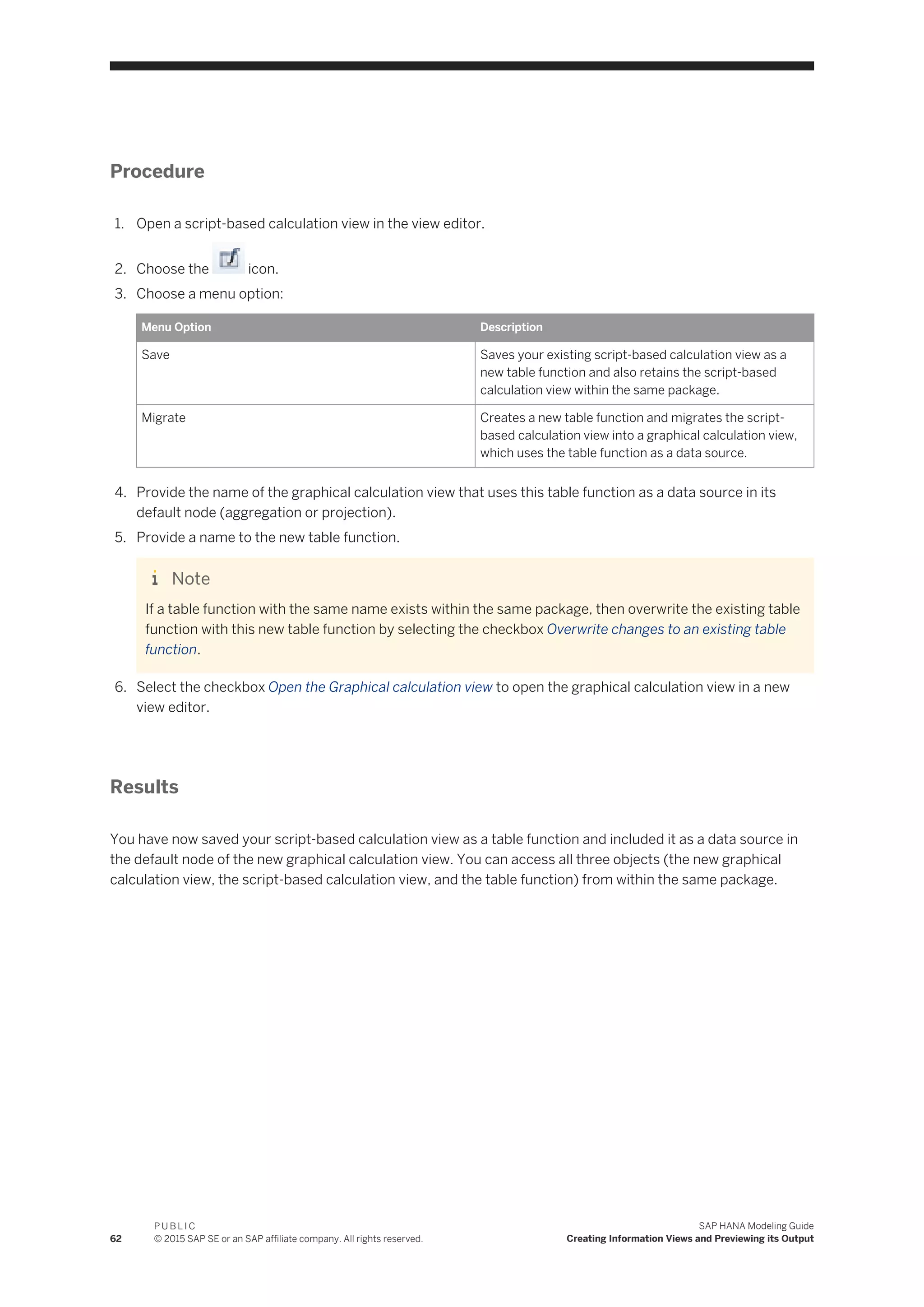
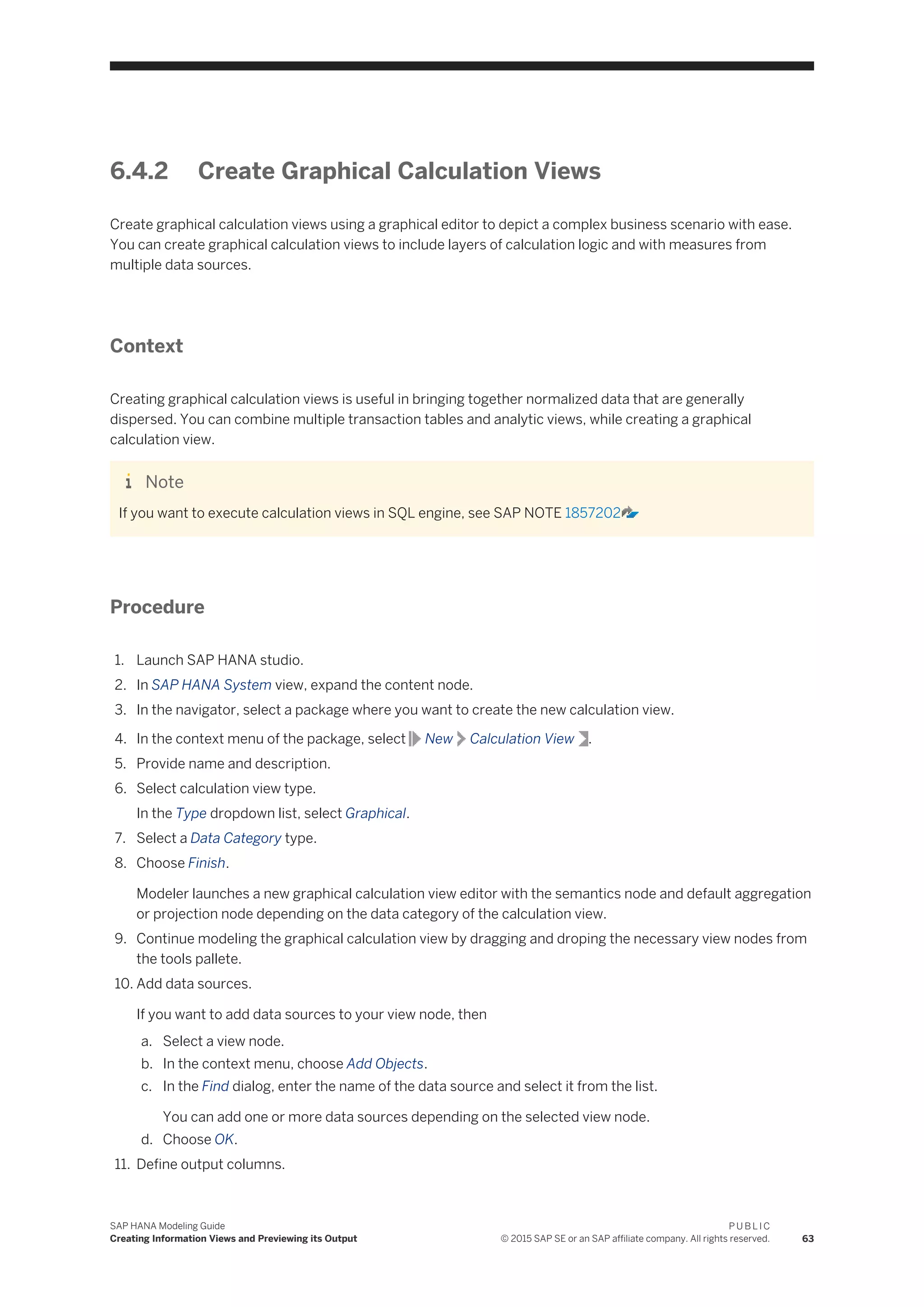
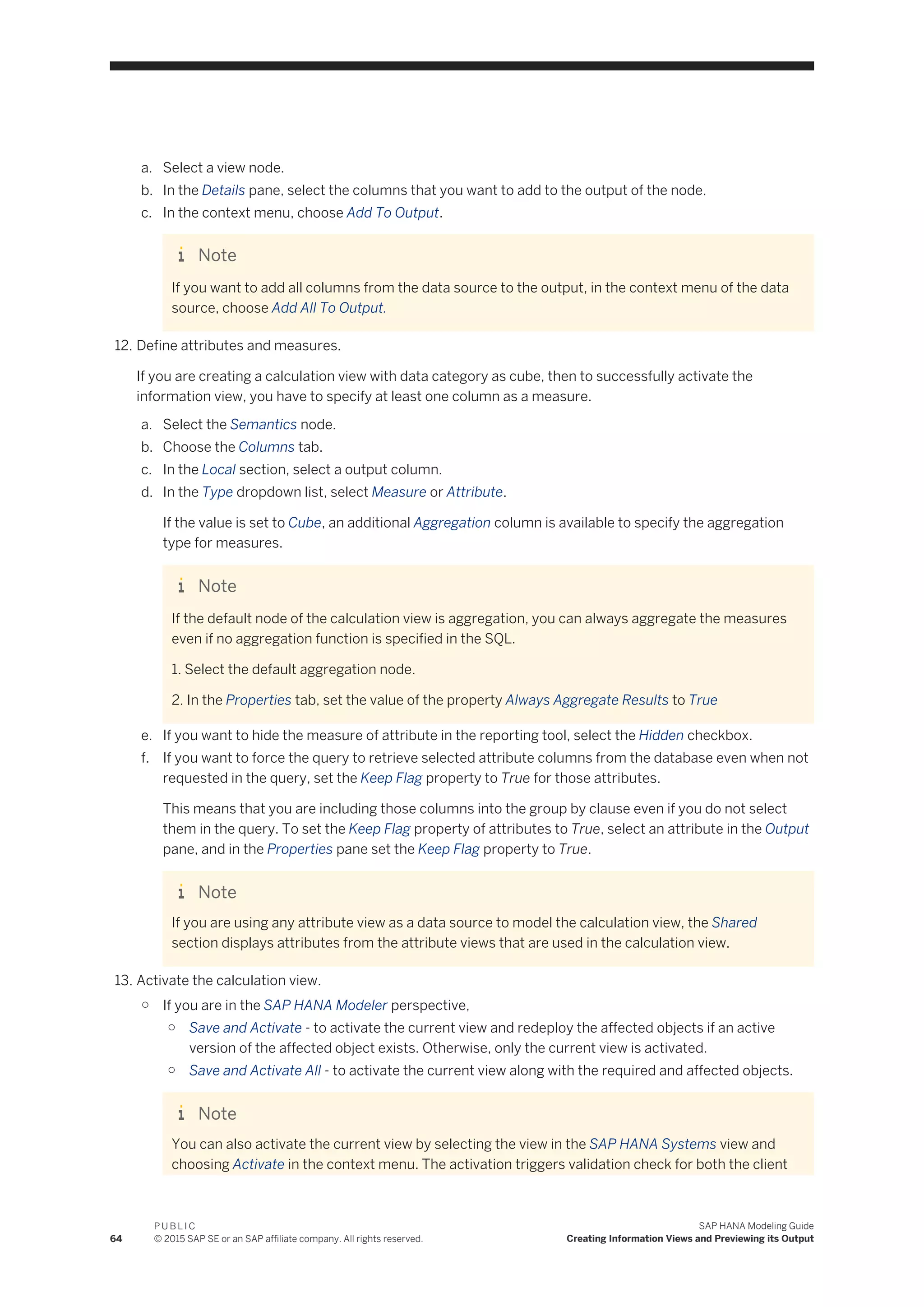
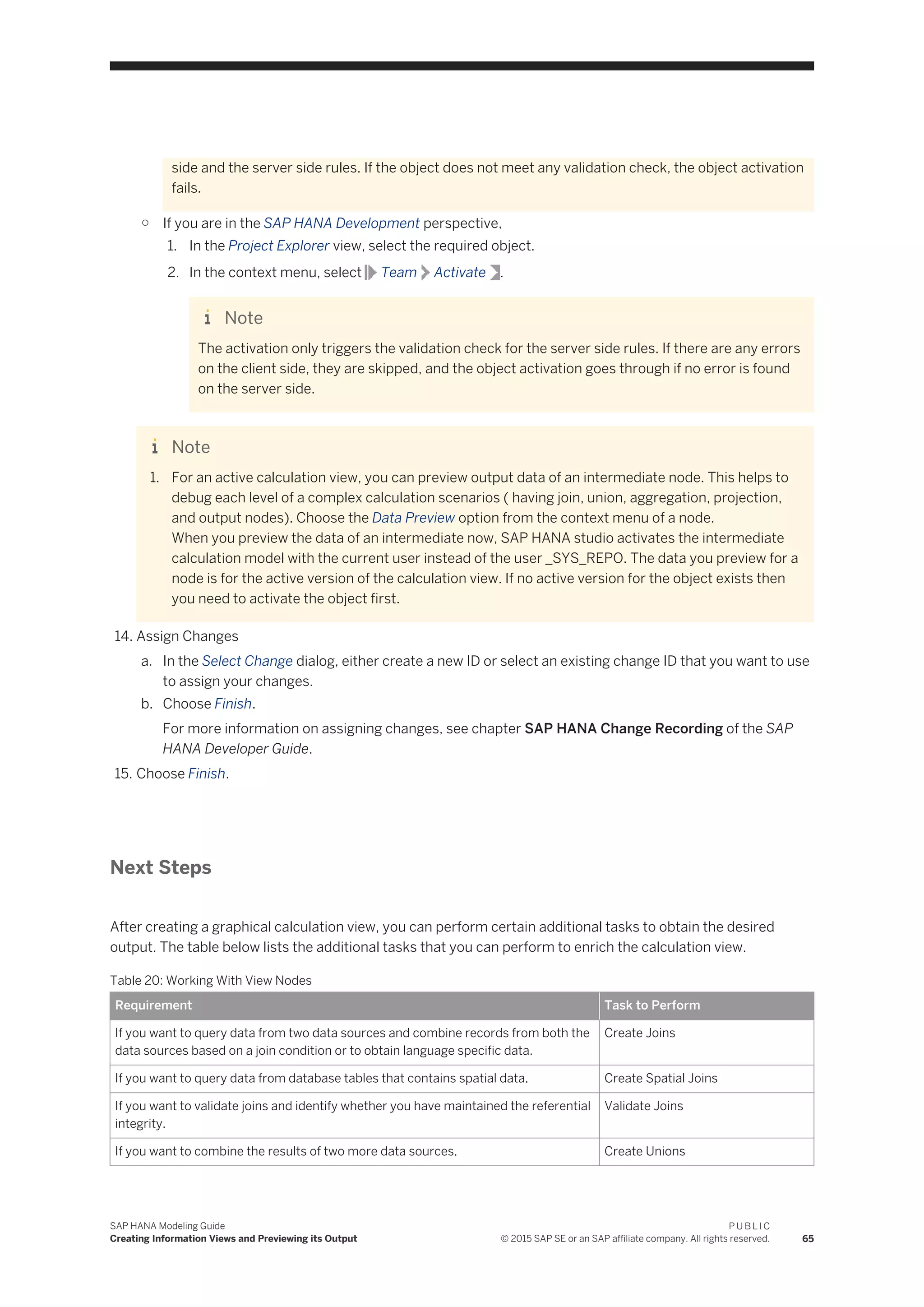

![Create Graphical Calculation Views With Star Joins [page 67]
Use Table Functions as a Data Source [page 68]
Use CDS Entity as a Data Source [page 70]
Supported View Nodes for Modeling Graphical Calculation Views [page 71]
Multitenant Database Containers Support for Modeling Graphical Calculation Views [page 72]
Supported Data Categories for Information Views [page 75]
Preview Information View Output [page 97]
Working With Attributes and Measures [page 101]
Working With Information View Properties [page 148]
Quick Reference: Information View Properties [page 154]
6.4.2.1 Create Graphical Calculation Views With Star Joins
Create graphical calculation views with star joins to join multiple dimensions with a single fact table. In other
words, you use star joins to join a central entity to multiple entities that are logically related.
Context
Star joins in calculation views help you to join a fact table with dimensional data. The fact table contains data
that represent business facts such price, discount values, number of units sold, and so on. Dimension tables
represent different ways to organize data, such as geography, time intervals, and contact names and so on.
Procedure
1. Launch SAP HANA studio.
2. In SAP HANA System view, expand the content node.
3. In the navigator, select a package where you want to create the new calculation view.
4. In the context menu of the package, select New Calculation View
5. Provide name and description.
6. In the Type dropdown list, select Graphical.
7. In the Data Category dropdown list, select Cube.
8. Select With Star Join.
Note
You can create star join with data category as cube only.
9. Choose Finish.
Modeler launches a new graphical calculation view editor with the semantics node and the star join node.
SAP HANA Modeling Guide
Creating Information Views and Previewing its Output
P U B L I C
© 2015 SAP SE or an SAP affiliate company. All rights reserved. 67](https://image.slidesharecdn.com/51818a91-dee6-4c9b-b633-0deab6e88220-150721193202-lva1-app6892/75/SAP_HANA_Modeling_Guide_for_SAP_HANA_Studio_en-67-2048.jpg)
![10. Add data sources.
a. Select the star join node.
b. In the context menu, choose Add Objects.
c. In Find Data Sources dialog, enter the name of the data source.
Note
You can only add calculation views with data category types as dimension or blank as a data source
in star join node.
d. Select the required calculation view from the list.
e. Choose OK.
11. Add inputs to star join node.
Continue modeling the graphical calculation view with a cube structure, which includes attributes and
measures. The input to the star join node must provide the central fact table.
12. Maintain star join properties.
a. Select the Star Join node.
b. In the Details tab, create joins by selecting a column from one data source, holding the mouse button
down and dragging to a column in the central fact table.
c. Select the join.
d. In the context menu, choose Edit.
e. In the Properties section, define necessary join properties.
13. Activate the calculation view.
Related Information
Create Joins [page 77]
Join Properties [page 86]
Supported Join Types [page 87]
6.4.2.2 Use Table Functions as a Data Source
Table functions as a data source in graphical calculation views helps build calculation views for complex
calculation scenarios. Using table functions in graphical calculation views are an alternate to script-based
calculation views, which you generally use for building complex calculation views.
Procedure
1. Open the graphical calculation view in the view editor.
2. Select a view node.
68
P U B L I C
© 2015 SAP SE or an SAP affiliate company. All rights reserved.
SAP HANA Modeling Guide
Creating Information Views and Previewing its Output](https://image.slidesharecdn.com/51818a91-dee6-4c9b-b633-0deab6e88220-150721193202-lva1-app6892/75/SAP_HANA_Modeling_Guide_for_SAP_HANA_Studio_en-68-2048.jpg)
![3. In the context menu, choose Add Objects.
4. In the Find dialog, enter the name of the table function and select it from the dropdown list.
5. Choose OK.
Related Information
Create Table Functions [page 69]
6.4.2.2.1 Create Table Functions
Table functions are functions that users can query like any other database tables, and you can add it as a data
source in your graphical calculation views. You can use the from clause of a SQL statement to call a table
function.
Context
You can create and edit table functions in both, the project explorer view or in the repositories view of SAP
HANA Development perspective.
Procedure
1. Open New Table Function wizard.
Go to the Project Explorer view in the SAP HANA Development perspective, right-click on the file name,
choose New Other SAP HANA Database Development Table Function . The New Table
Function wizard appears.
2. Define the function parameters.
Enter or select the parent folder, enter the file name, and choose Finish.
The editor opens containing a default template for the function. In a shared project, the design-time
function name is generated containing the full path. In an unshared project, the full function name must be
added manually.
3. Commit and activate your function.
SAP HANA Modeling Guide
Creating Information Views and Previewing its Output
P U B L I C
© 2015 SAP SE or an SAP affiliate company. All rights reserved. 69](https://image.slidesharecdn.com/51818a91-dee6-4c9b-b633-0deab6e88220-150721193202-lva1-app6892/75/SAP_HANA_Modeling_Guide_for_SAP_HANA_Studio_en-69-2048.jpg)
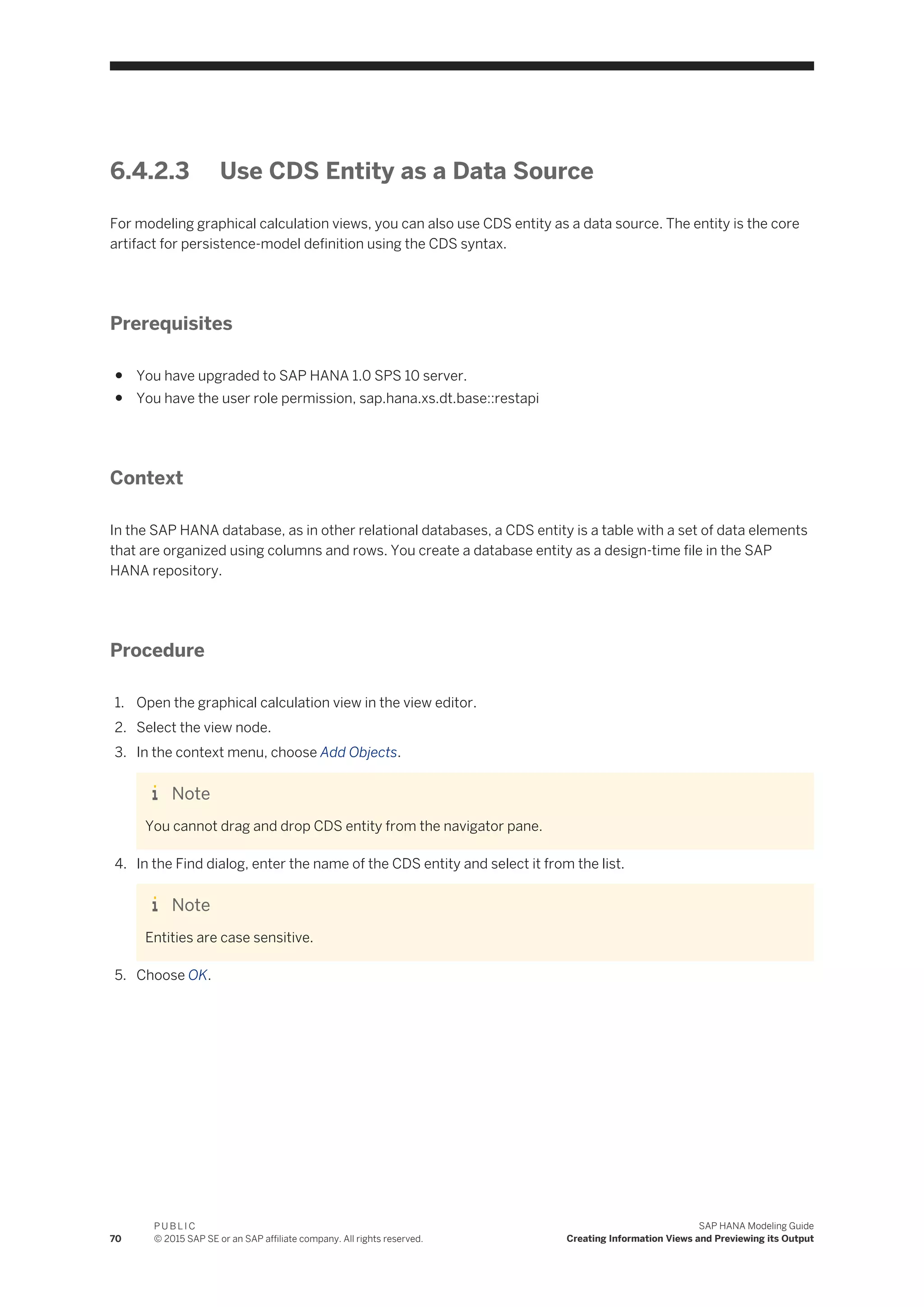

![6.4.2.5 Multitenant Database Containers Support for
Modeling Graphical Calculation Views
SAP HANA supports multiple isolated databases in a single SAP HANA system. These are referred to as
multitenant database containers.
An SAP HANA system installed in multiple-container mode is capable of containing more than one multitenant
database containers. Otherwise, it is a single-container system. A multiple-container system always has
exactly one system database and any number of multitenant database containers (including zero), also called
tenant databases. An SAP HANA system installed in multiple-container mode is identified by a single system
ID (SID).
You can model graphical calculation views in an SAP HANA system with multiple isolated databases. This
means that, while modeling graphical calculation views, you can add data source from any of the isolated
databases.
Note
Modeler supports only adding table data sources from tenant databases.
Prerequisites
● You have added the SAP HANA system having multiple isolated databases to the SAP HANA Systems
view.
● For activating graphical calculation views with remote data sources, the _SYS_REPO in the local data base
needs to be a remote identity of (mapped to) a user in the remote data base that has the privileges for the
remote tables. The database does not allow the administrator to add a remote identity to SYS_REPO in
any tenant. Instead, the administrator should create a dedicated user (for example, REPO_DB1_DB2),
which you can use exclusively for privileges in the remote database. This user only needs the privileges for
tables that are used as remote data sources and does need privileges for all the tables in the remote DB
that are used in calculation views.
Note
SAP HANA modeler does not support remote session client to filter client data. It is recommend using
cross client views only, and filter clients using parameters.
● You have enabled and configured cross database access.
Related Information
Enable and Configure Cross-Database Access [page 73]
Cross-Database Access [page 74]
72
P U B L I C
© 2015 SAP SE or an SAP affiliate company. All rights reserved.
SAP HANA Modeling Guide
Creating Information Views and Previewing its Output](https://image.slidesharecdn.com/51818a91-dee6-4c9b-b633-0deab6e88220-150721193202-lva1-app6892/75/SAP_HANA_Modeling_Guide_for_SAP_HANA_Studio_en-72-2048.jpg)
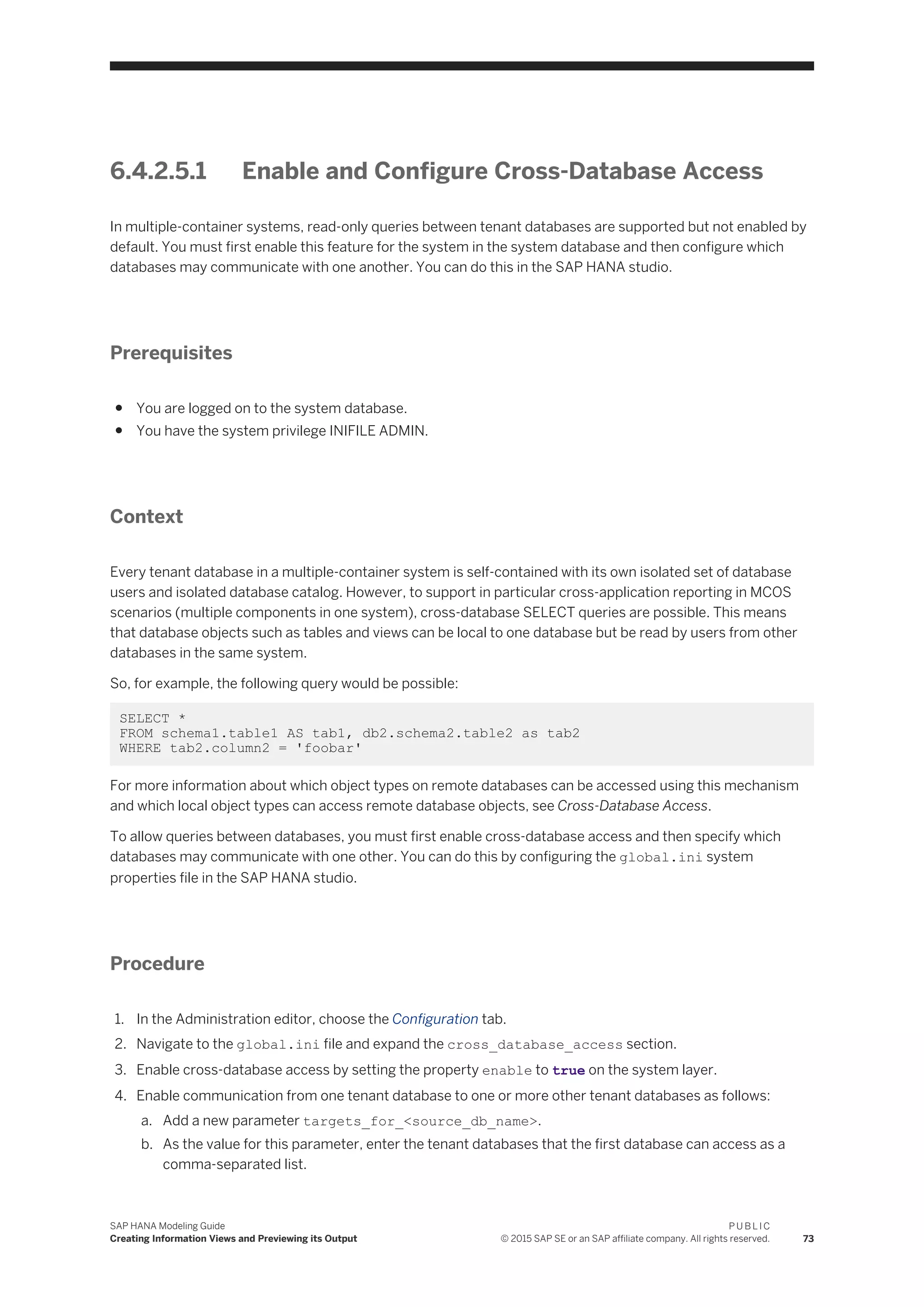
![Example
You have 2 databases DB1 and DB2 and you want to be able to access DB2 from DB1. So you add the
parameter targets_for_DB1 with the value DB2.
Note
Cross-database access is configured only in one direction. If in the above example you also want DB2 to
be able to access DB1, you would have to add the parameter targets_for_DB2 with the value DB1.
Results
Cross-database queries are now possible between the configured databases.
Next Steps
Create remote identities for those users who require cross-database access. For more information, see Cross-
Database Authorization in Multitenant Database Containers in the SAP HANA Security Guide.
In order for a user in one database to be able to run a query or create an object that references objects in
another database, the user must be mapped to a sufficiently privileged user in the remote database.
Related Information
Cross-Database Access [page 74]
SAP HANA Security Guide
6.4.2.5.2 Cross-Database Access
Read-only queries between tenant databases in the same SAP HANA system are possible. This supports in
particular cross-application reporting in MCOS (multiple components in one system) scenarios. Cross-
database access must be explicitly enabled.
Every tenant database in a multiple-container system is self-contained with its own isolated set of database
users and isolated database catalog. However, to support in particular cross-application reporting in MCOS
scenarios (multiple components in one system), cross-database SELECT queries are possible. This means
that database objects such as tables and views can be local to one database but be read by users from other
databases in the same system.
74
P U B L I C
© 2015 SAP SE or an SAP affiliate company. All rights reserved.
SAP HANA Modeling Guide
Creating Information Views and Previewing its Output](https://image.slidesharecdn.com/51818a91-dee6-4c9b-b633-0deab6e88220-150721193202-lva1-app6892/75/SAP_HANA_Modeling_Guide_for_SAP_HANA_Studio_en-74-2048.jpg)
![The following object types on remote databases can be accessed using this mechanism:
● Schemas
● Rowstore and columnstore tables
● SQL views
● Calculation views
● Synonyms
The following local object types can access remote database objects:
● SQL views
● Calculation views
● Procedures
● Synonyms
The SAP HANA modeler supports modeling of graphical calculation views using data sources from different
tenant databases. For more information, see Multitenant Database Containers Support for Modeling Graphical
Calculation Views in the SAP HANA Modeling Guide (For SAP HANA Studio).
For more information about how to enable cross-database access, see Enable and Configure Cross-Database
Access.
Related Information
Enable and Configure Cross-Database Access [page 73]
Multitenant Database Containers Support for Modeling Graphical Calculation Views [page 72]
SAP HANA Modeling Guide (For SAP HANA Studio)
6.4.3 Supported Data Categories for Information Views
SAP HANA modeler supports two types of data categories to classify calculation views. The table below
provides more information on each of these data category types.
Table 24:
Data Category Description
Cube Calculation views with data categories as Cube are visible to the reporting tools and supports data
analysis with multidimensional reporting.
If the data categories for graphical calculation views are set to Cube, modeler provides aggrega
tion as the default view node. Also, an additional aggregation column behavior is available that you
can use to specify the aggregation types for measures.
SAP HANA Modeling Guide
Creating Information Views and Previewing its Output
P U B L I C
© 2015 SAP SE or an SAP affiliate company. All rights reserved. 75](https://image.slidesharecdn.com/51818a91-dee6-4c9b-b633-0deab6e88220-150721193202-lva1-app6892/75/SAP_HANA_Modeling_Guide_for_SAP_HANA_Studio_en-75-2048.jpg)
![Data Category Description
Dimension Calculation views with data categories as Dimension are not visible to the reporting tools and does
not support data analysis. However, you can use these information views as data sources in other
calculation views, which have data category as Cube, for any multidimensional reporting pur
poses.
If the data category is Dimension, you cannot create measures. You can only consume them with
SQL. For example, you use such calculation views to fill simple list user interfaces, where recurring
attribute values are not a problem, but are desired. The output node offers only attributes of nu
merical data types.
If the data categories for graphical calculation views are set to Dimension, modeler provides pro
jection as the default view node.
You cannot create script-based calculation views with data category as Dimension.
<blank> Calculation views with data categories as <blank>, or if the calculation views are not classified as
cube or dimension, then they are not visible to the reporting tools and do not support multidimen
sional reporting.
However, you can use these calculation views as data sources in other information views, which
have data category as Cube, for any multidimensional reporting purposes.
If the graphical calculation views are not classified as cube or dimension, modeler provides projec
tion as the default view node.
6.5 Working With View Nodes
View nodes form the buidling blocks of information views. These view nodes help you build complex, flexible
and robust analytic models, and each view node type possess specialized capabilities that triggers advanced
features in the database.
This section describes the different views nodes that you can use within graphical calculation views, its
functionalities and examples on how you can use these views nodes to build calculation views and obtain the
desired output.
Related Information
Create Joins [page 77]
Create Unions [page 87]
Create Rank Nodes [page 91]
Filter Output of Data Foundation Node [page 94]
Filter Output of Aggregation or Projection View Nodes [page 95]
76
P U B L I C
© 2015 SAP SE or an SAP affiliate company. All rights reserved.
SAP HANA Modeling Guide
Creating Information Views and Previewing its Output](https://image.slidesharecdn.com/51818a91-dee6-4c9b-b633-0deab6e88220-150721193202-lva1-app6892/75/SAP_HANA_Modeling_Guide_for_SAP_HANA_Studio_en-76-2048.jpg)

![Related Information
Create Spatial Joins [page 78]
Text Joins [page 81]
Dynamic Joins [page 82]
Optimize Join Execution [page 85]
Validate Joins [page 85]
Join Properties [page 86]
Supported Join Types [page 87]
6.5.1.1 Create Spatial Joins
Create spatial joins by using the join nodes in graphical calculation views to query data from data sources that
have spatial data.
Procedure
1. Open the required graphical calculation view in view editor.
2. From the editor’s tools pallete, drag and drop a join node to the editor.
3. Add data sources.
a. Select the join node.
b. In the context menu, choose Add Objects.
c. In Find Data Sources dialog, enter the name of the data source with spatial data and select it from the
list.
d. Choose OK.
Note
By default, modeler consider the data source that you add first to the join node as the left table and
the data source that you add next as the right table.
4. Define output columns.
a. In the Details pane, select the columns you want to add to the output of the join node.
b. In the context menu, choose Add To Output.
Note
If you want to add all columns from the data source to the output, in the context menu of the data
source, choose Add All To Output.
5. Create a join.
a. In the Details pane, create a join by selecting a column from one data source, holding the mouse
button down and dragging to a column in the other data source.
78
P U B L I C
© 2015 SAP SE or an SAP affiliate company. All rights reserved.
SAP HANA Modeling Guide
Creating Information Views and Previewing its Output](https://image.slidesharecdn.com/51818a91-dee6-4c9b-b633-0deab6e88220-150721193202-lva1-app6892/75/SAP_HANA_Modeling_Guide_for_SAP_HANA_Studio_en-78-2048.jpg)
![Note
For spatial joins, you join the two databases tables on columns of spatial data types.
6. Define spatial join properties.
a. Slect the join.
b. In the context menu, choose Edit.
c. Select the Spatial Properties tab.
d. In the Predicates dropdown list, select a predicate value.
Note
If you select Relate as the predicate value, in the Intersection Matrix value help, select a value.
Similarly, if you select Within Distance as the predicate value, in the Distance value help, select a
value. You can use a fixed value or an input parameter to provide the intersection matrix or the
distance values to modeler at runtime.
e. If you want to execute the spatial join only if predicate condition evaluates to true, then in the
dropdown list, select True.
7. Choose OK.
Related Information
Supported Spatial Predicates [page 79]
Supported Spatial Data Types [page 80]
6.5.1.1.1 Supported Spatial Predicates
SAP HANA modeler supports the following spatial predicates.
Table 25:
Method Type Description
ST_Contains ST_Geometry Tests if a geometry value spatially con
tains another geometry value.
ST_CoveredBy ST_Geometry Tests if a geometry value is spatially
covered by another geometry value.
ST_Covers ST_Geometry Tests if a geometry value spatially cov
ers another geometry value.
ST_Crosses ST_Geometry Tests if a geometry value crosses an
other geometry value.
SAP HANA Modeling Guide
Creating Information Views and Previewing its Output
P U B L I C
© 2015 SAP SE or an SAP affiliate company. All rights reserved. 79](https://image.slidesharecdn.com/51818a91-dee6-4c9b-b633-0deab6e88220-150721193202-lva1-app6892/75/SAP_HANA_Modeling_Guide_for_SAP_HANA_Studio_en-79-2048.jpg)
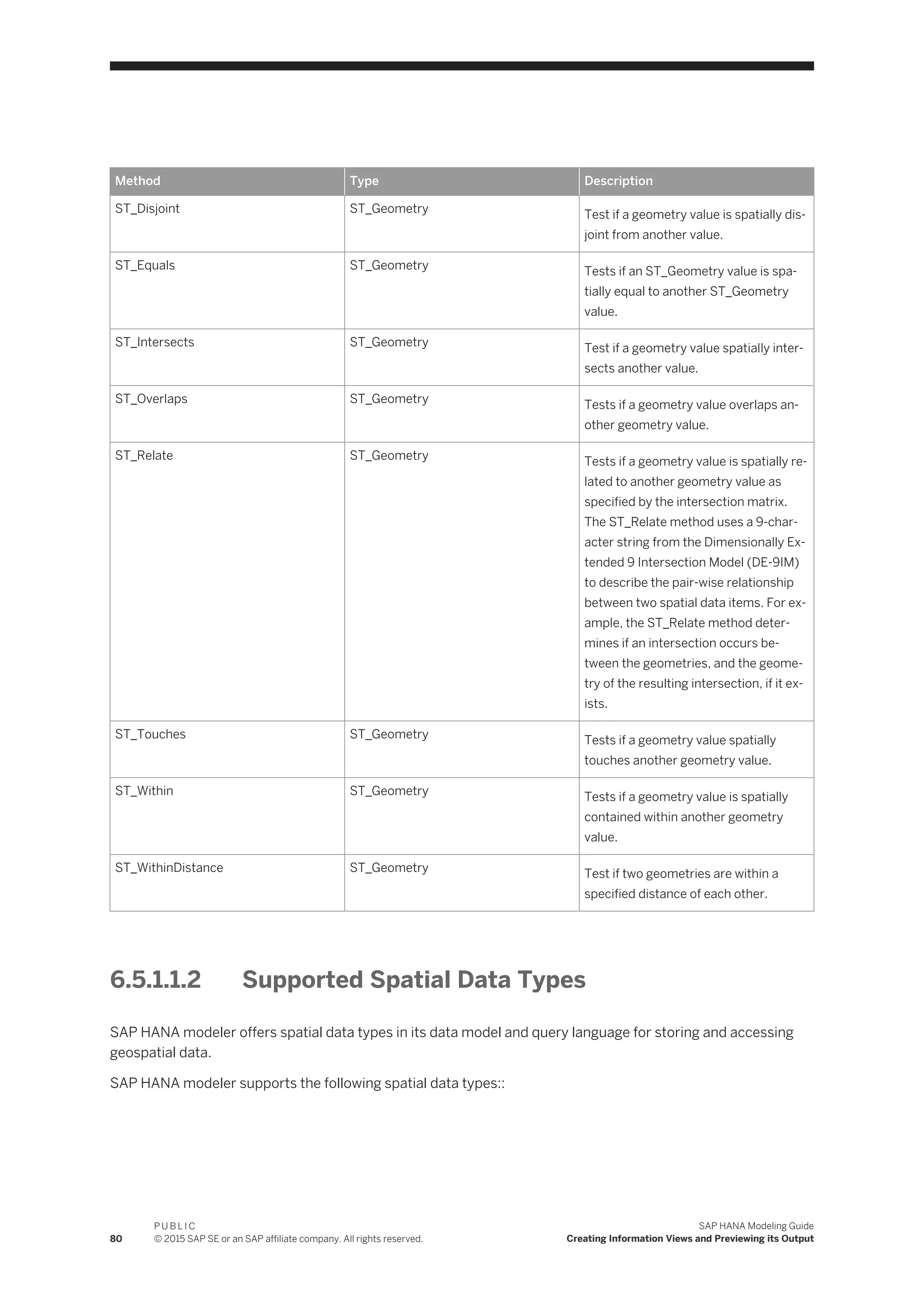
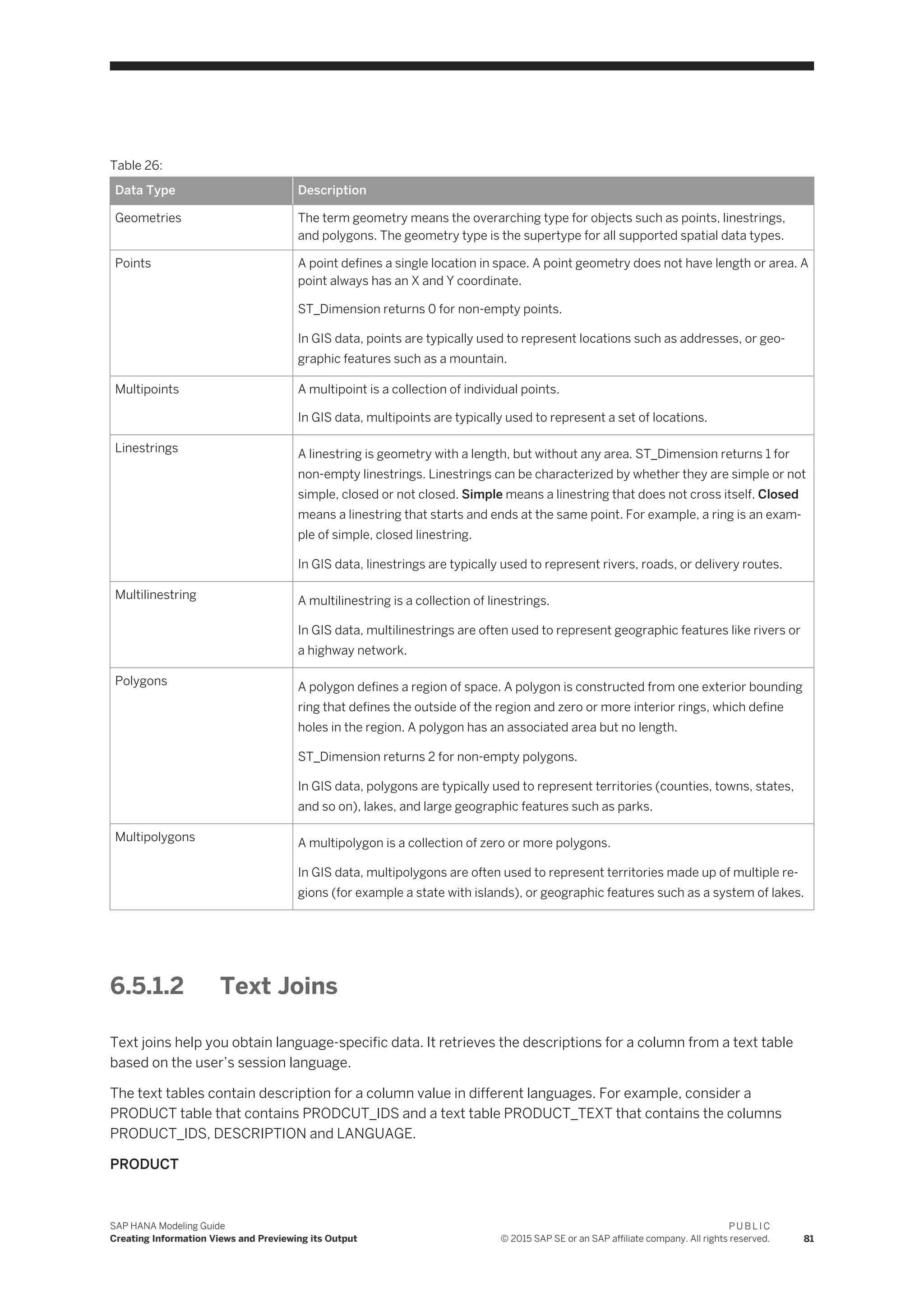
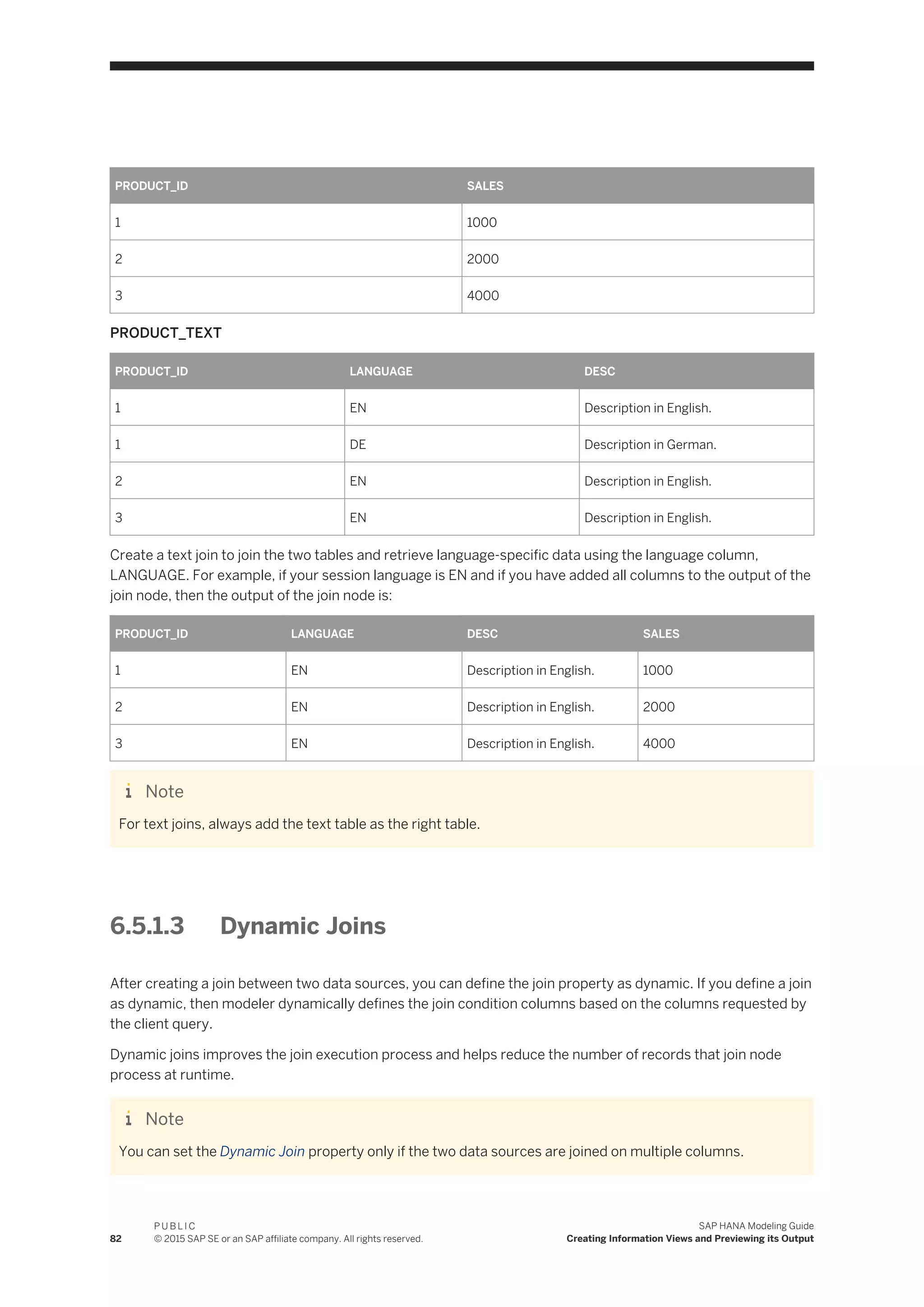
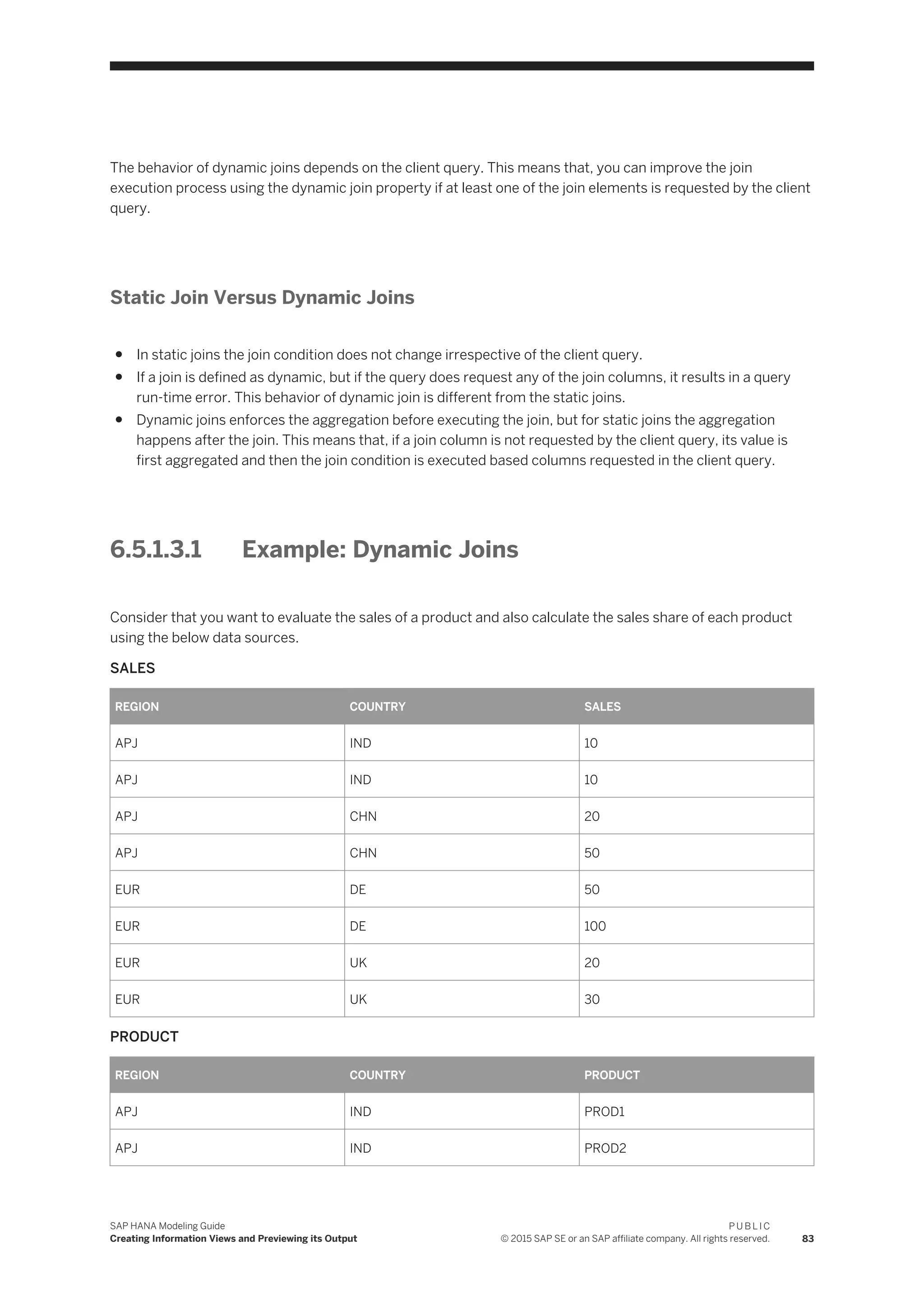


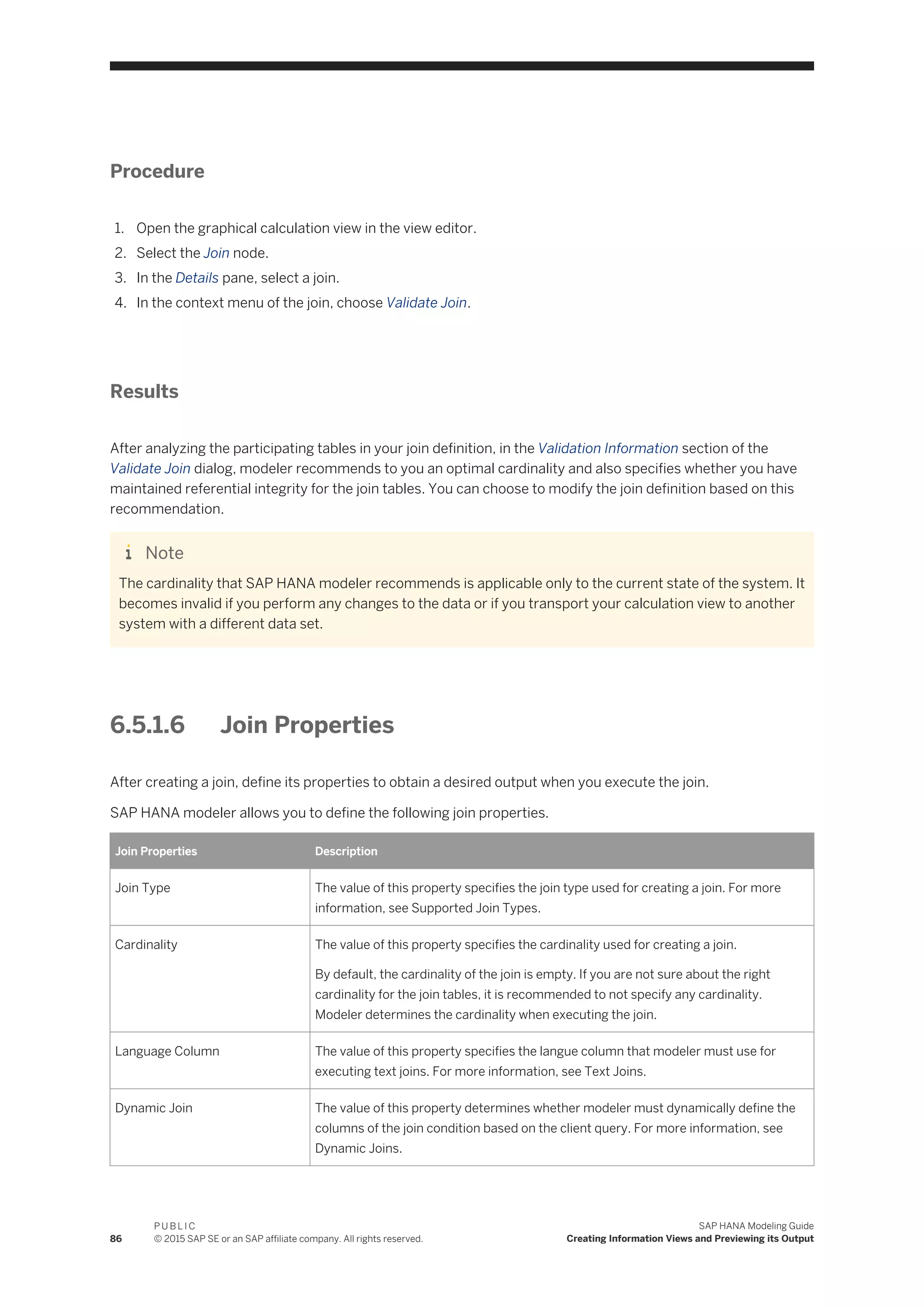
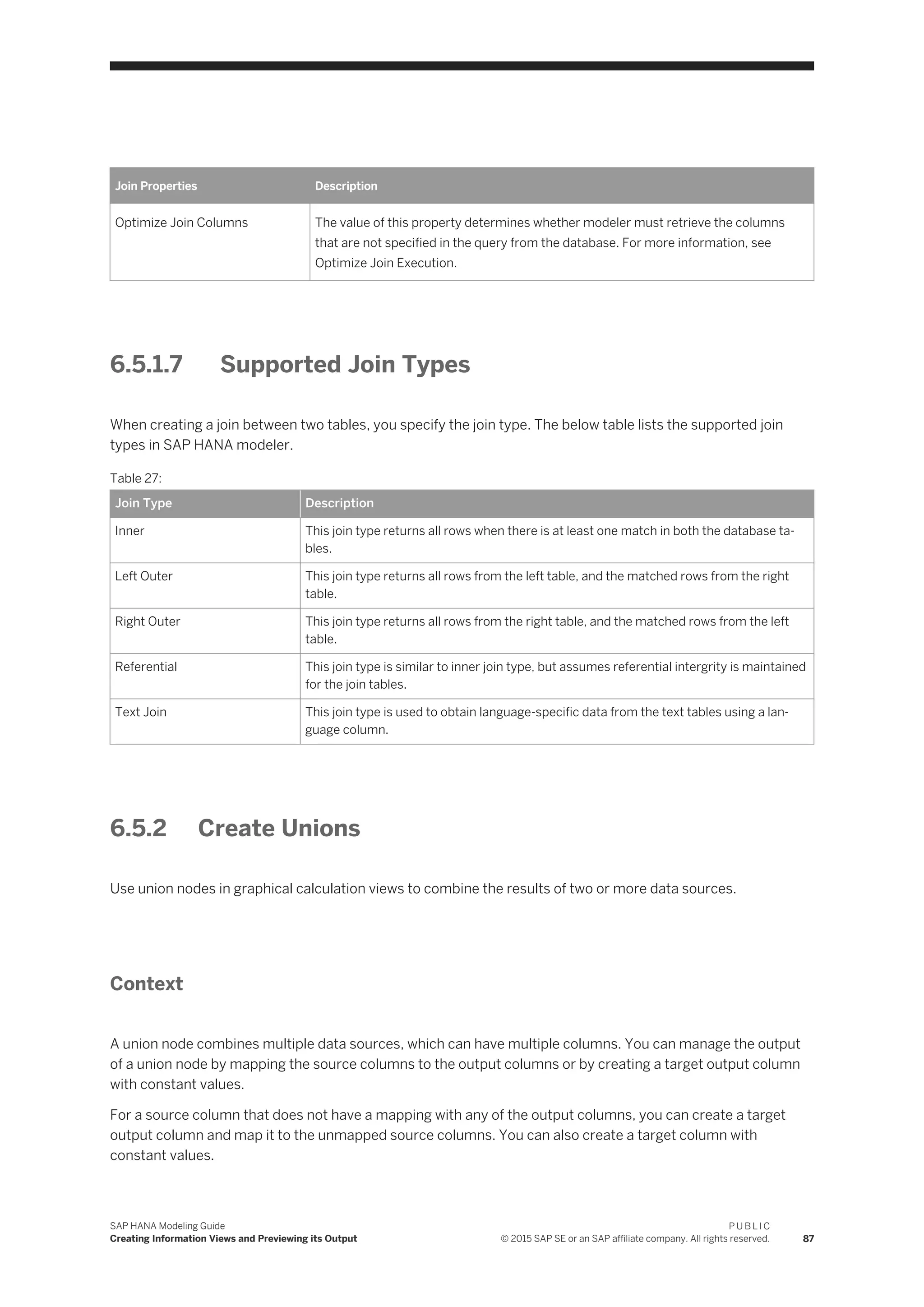
![Procedure
1. Open the required graphical calculation view in view editor.
2. From the editor’s tools pallete, drag and drop a union node to the editor.
3. Add data sources.
a. Select the union node.
b. In the context menu, choose Add Objects.
c. In Find Data Sources dialog, enter the name of the data source and select it from the list.
d. Choose OK.
4. Define output columns.
a. In the Details pane, select the columns you want to add to the output of the union node.
b. In the context menu, choose Add To Output.
Note
If you want to add all columns from the data source to the output, in the context menu of the data
source, choose Add All To Output.
5. Assign constant value.
This helps to denote the underlying data of the source columns with constant values in the output.
If you want to assign a constant value to any of the target columns, then
a. In the Target section, select an output column.
b. In the context menu, choose Manage Mappings.
c. In the Manage Mappings dialog, set the Source Column value as blank.
d. In the Contant Value field, enter a constant value.
e. Choose OK.
6. Create a constant output column.
If you want to create a new output column and assign a constant value to it, then
a. In the Target section, choose .
b. In the Create Target dialog, provide name and data type for the new output column.
c. Choose OK.
Note
By default, the value of the constant output column in null.
Related Information
Example: Constant Columns [page 89]
Empty Union Behavior [page 90]
88
P U B L I C
© 2015 SAP SE or an SAP affiliate company. All rights reserved.
SAP HANA Modeling Guide
Creating Information Views and Previewing its Output](https://image.slidesharecdn.com/51818a91-dee6-4c9b-b633-0deab6e88220-150721193202-lva1-app6892/75/SAP_HANA_Modeling_Guide_for_SAP_HANA_Studio_en-88-2048.jpg)
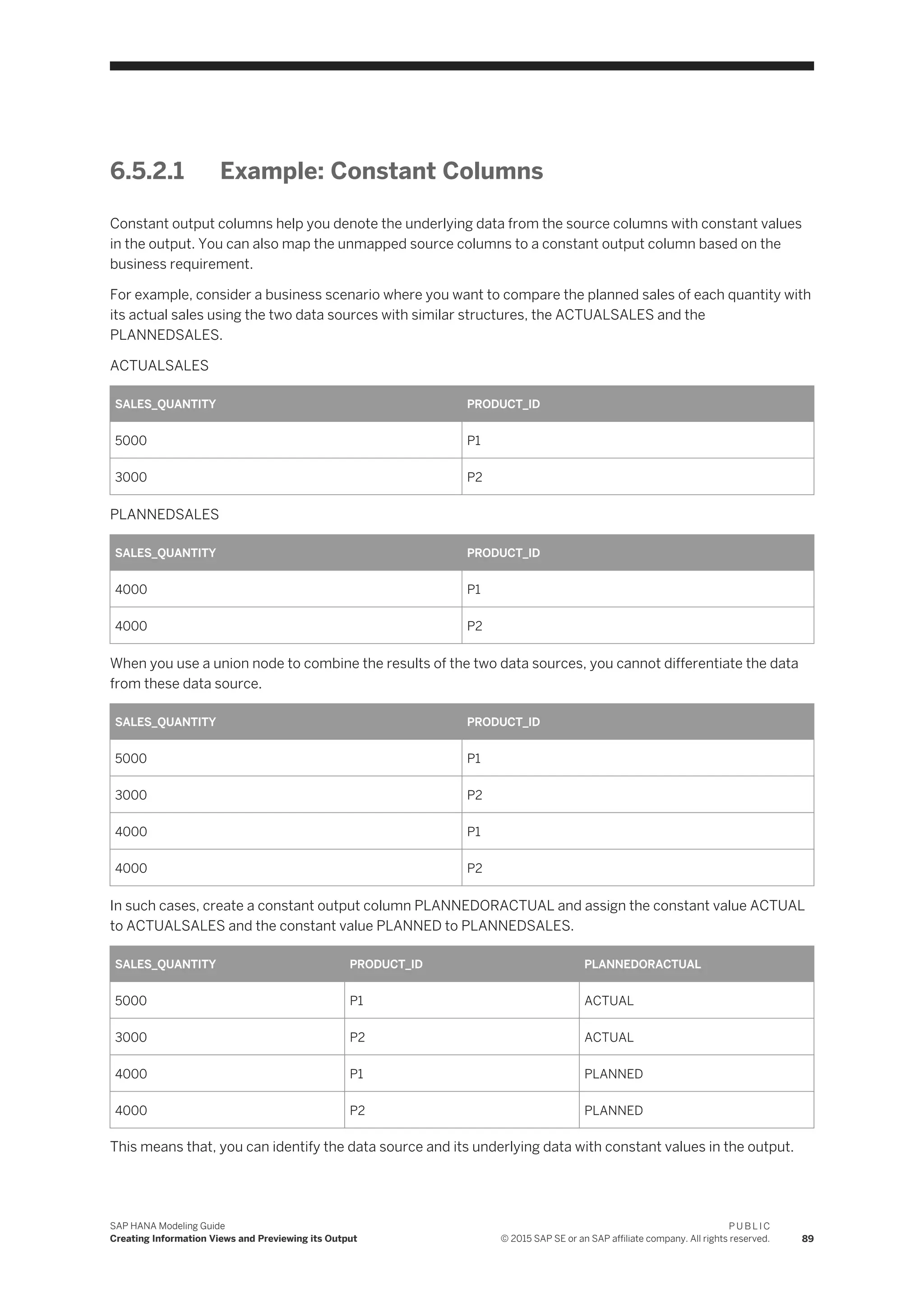

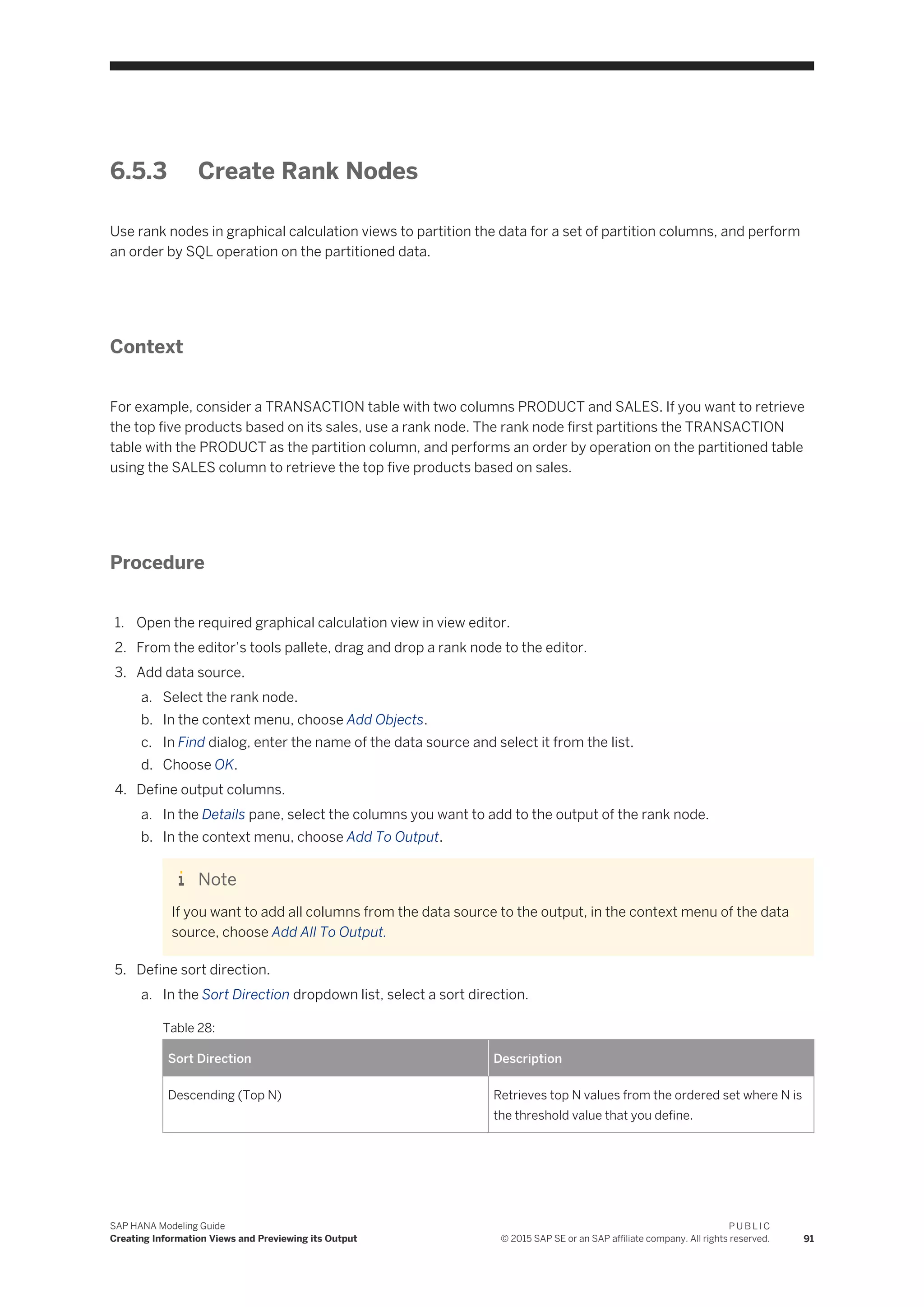
![Sort Direction Description
Ascending (Bottom N) Retrieves bottom N values from the ordered set where
N is the threshold value that you define
6. Define threshold value.
Use a Fixed value or an Input Parameter as the threshold value. It helps modeler identify the number of
records that are of interest to you from the ordered set.
a. In the Threshold Value value help, select a threshold value type and provide the threshold value
accordingly.
7. In the Order By dropdown list, select a column that modeler must use to perform the order by operation.
8. Partition the data.
a. In the Partition By section, choose Add.
b. In the Partition By Column dropdown list, select a partition column that modeler must use to partition
the data.
Note
You can partition the data using more than one partition columns.
9. If you want to partition the data only with the partition by columns that query requests for processing the
rank node, select the Dynamic Partition Elements checkbox.
Note
If you do not select this checkbox, modeler partitions the data with all partition columns that you have
added in the Partition By section even if it is not requested in the query to process the rank node.
10. If you want generate an additional output column to store the column rank value, select the Generate Rank
Column checkbox.
Related Information
Example: Rank Nodes [page 92]
6.5.3.1 Example: Rank Nodes
Rank nodes help you partition the data source for a set of partition columns and then perform an order by SQL
operation on the partitioned set.
For example, consider a business scenario where you want to retrieve the top five sales for each product using
the SALES_TRANSACTION data source.
SALES_TRANSACTIONS
92
P U B L I C
© 2015 SAP SE or an SAP affiliate company. All rights reserved.
SAP HANA Modeling Guide
Creating Information Views and Previewing its Output](https://image.slidesharecdn.com/51818a91-dee6-4c9b-b633-0deab6e88220-150721193202-lva1-app6892/75/SAP_HANA_Modeling_Guide_for_SAP_HANA_Studio_en-92-2048.jpg)

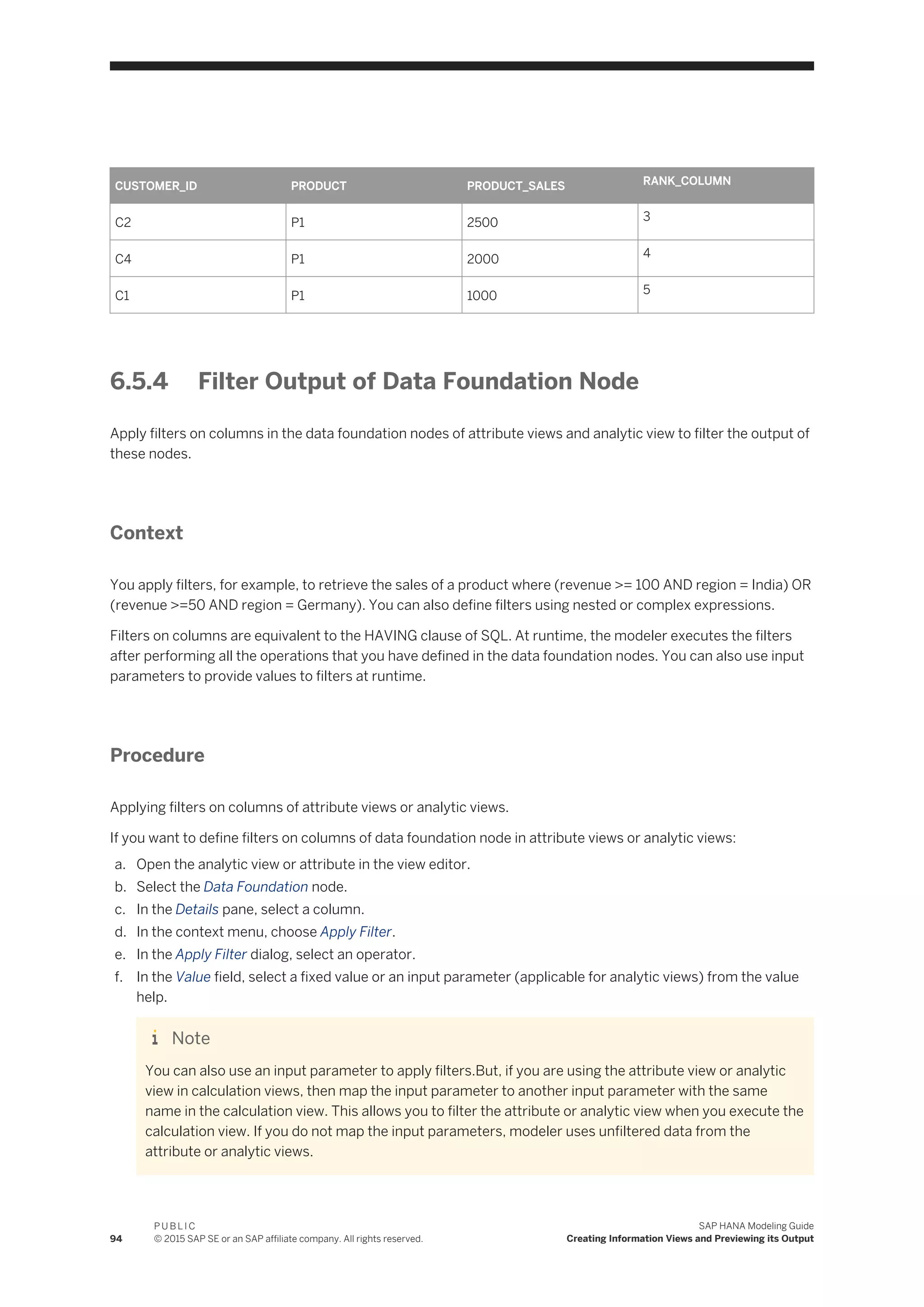
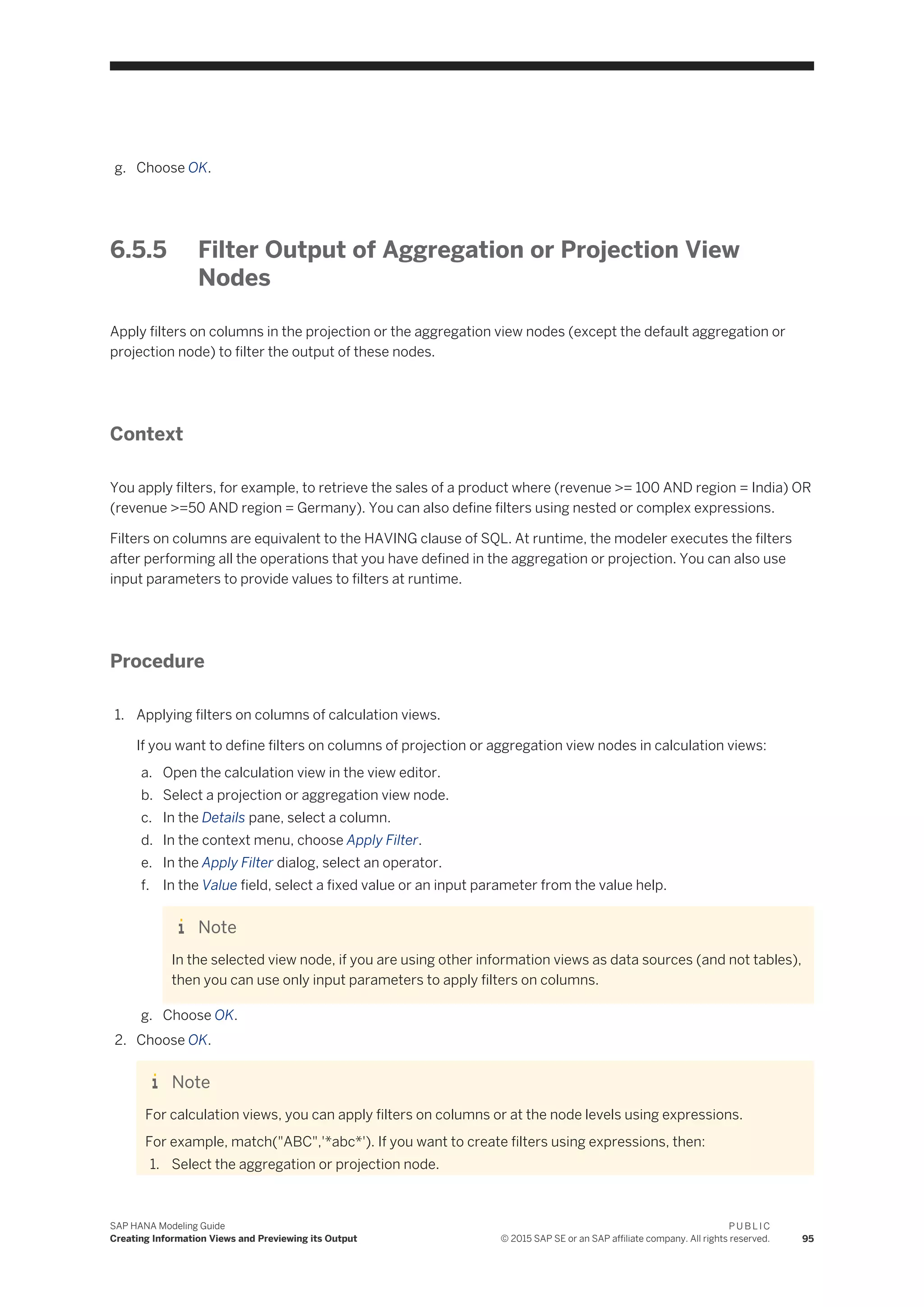
![2. In the Output pane, expand Filters.
3. In the context menu of Expression, choose Open.
4. Enter the expression by selecting the required elements, operators, input parameters calculated
columns and functions.
5. Choose OK.
Related Information
Supported Operators for Filters [page 96]
6.5.5.1 Supported Operators for Filters
The table below lists the operators and its meanings, which you can use while defining filter conditions.
Table 29:
Filter Operator Description
Equal To filter and show data corresponding to the filter value
Not Equal To filter and show data other than the filter value
Between To filter and show data for a particular range specified in the From Value and To Value
List of Values To filter and show data for a specific list of values separated by comma
Not in list To filter data and show data for the values other than the ones specified. You can provide a list
of values to be excluded using comma.
Is NULL To filter and show row data having NULL values
Is not NULL To filter and show data of all the rows that have non NULL values
Less than To filter and show data with values less than the one specified as filter value
Less than or Equal to To filter and show data with values less than or equal to the one specified as filter value
Greater than To filter and show data with values greater than the one specified as filter value
Greater than or Equal to To filter and show data with values greater than or equal to the one specified as filter value
Contains Pattern To filter and show data that matches the pattern specified in the filter value. You can use '?'
question mark to substitute a single character, and '*' asterik to substitute many. For exam
ple, to filter data for continents that start with letter A, use Contains Pattern filter with value
A*. This would show the data for all the continents that start with A like Asia and Africa. The
filter Contains Pattern in expression editor is converted as match. Hence, for the given
example the corresponding filter expression is (match("CONTINENT",'A*')).
96
P U B L I C
© 2015 SAP SE or an SAP affiliate company. All rights reserved.
SAP HANA Modeling Guide
Creating Information Views and Previewing its Output](https://image.slidesharecdn.com/51818a91-dee6-4c9b-b633-0deab6e88220-150721193202-lva1-app6892/75/SAP_HANA_Modeling_Guide_for_SAP_HANA_Studio_en-96-2048.jpg)
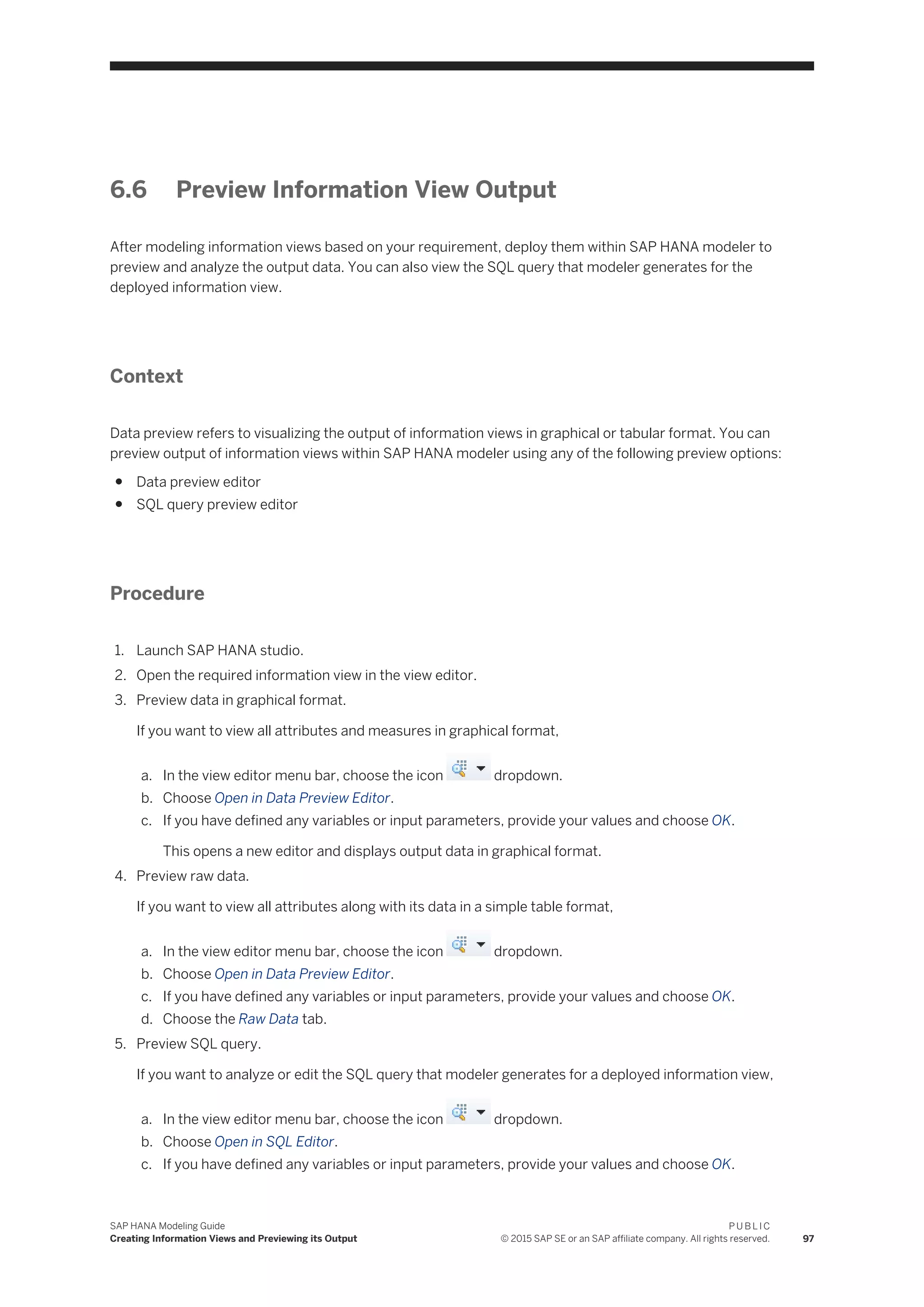
![This opens a new editor to preview the output data. In the Results tab, the SQL console displays the
SQL query that modeler generates for the deployed information view and also the equivalent output
data in simple table format.
d. If you want to modify the SQL query and view results accordingly, in the SQL tab, modify the query
and choose to see output for the modified query.
Note
You can drag information views from the navigator pane to the SQL editor to obtain an equivalent
SQL statement that represents the deployed schema name for the information view.
6. Generate SQL query from the navigator pane.
You can also generate the SQL query for an information view from the navigator pane (SAP HANA systems
view).
a. In the SAP HANA Systems view, expand the Content node.
b. Select the required information view in the navigator pane.
c. In the context menu, choose Generate Select SQL.
Modeler opens an SQL editor with equivalent SQL query for the selected information view.
Note
If the information view has any variables or input parameters, modeler provides placeholders for
them in the SQL query. You can replace the placeholders with values for the input parameters and
variables.
d. Choose to see the raw data output of the information view.
e. If you want to modify the SQL query, enter the new query in the SQL editor and choose to view
output for the modified query.
Note
If there are inconsistencies in runtime information (that is, calculation views in catalog or in tables
related to runtime) of an information view, you get invalidated view error. In such cases, you need to
redeploy the view in order to correct the inconsistencies of runtime information.
Related Information
Data Preview Editor [page 99]
SQL Editor [page 99]
98
P U B L I C
© 2015 SAP SE or an SAP affiliate company. All rights reserved.
SAP HANA Modeling Guide
Creating Information Views and Previewing its Output](https://image.slidesharecdn.com/51818a91-dee6-4c9b-b633-0deab6e88220-150721193202-lva1-app6892/75/SAP_HANA_Modeling_Guide_for_SAP_HANA_Studio_en-98-2048.jpg)
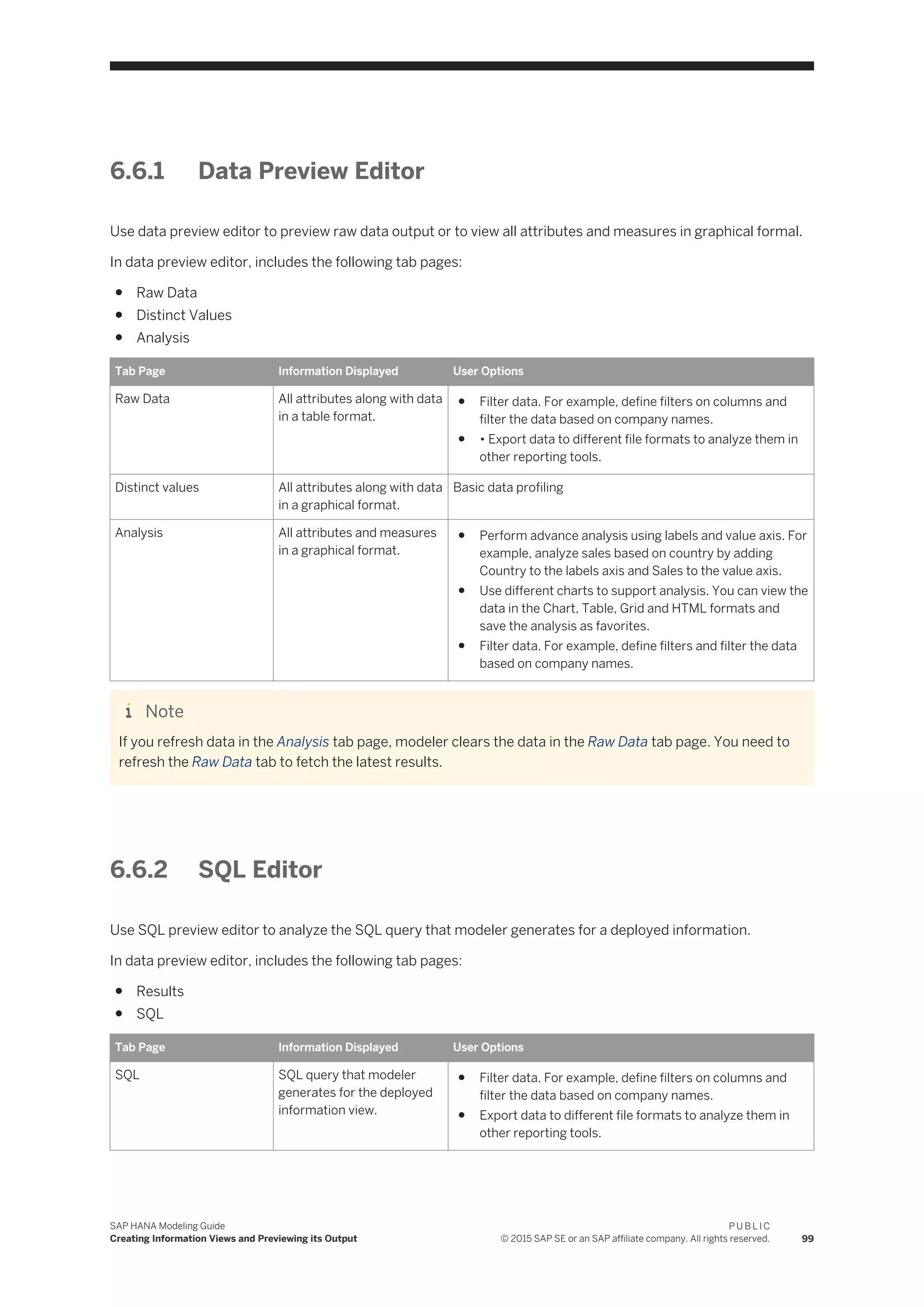

![7 Working With Attributes and Measures
Attributes and measures form content data that you use for data modeling. The attributes represent the
descriptive data such as city and country and the measures represent quantifiable data such as revenue and
quantity sold.
Information views can contain two types of columns, the measures and the attributes. Measures are columns
for which you define an aggregation. If information views are used in SQL statements, then you have to
aggregate the measures, for example, using the SQL functions SUM(<column name>), MIN(<column name>),
or MAX(<column name>. Attributes can be handled as regular columns as they do not need to be aggregated.
This section describes the different operations you can perform using the attributes and measures. For
example, you can create calculated attributes or calculated measures.
Related Information
Working With Attributes and Measures [page 101]
Create Counters [page 101]
Create Calculated Columns [page 104]
Create Restricted Columns [page 109]
Assign Semantics [page 111]
Assign Variables [page 115]
Create Input Parameters [page 118]
Using Currency and Unit of Measure Conversions [page 136]
Trace Columns in Information Views With Data Lineage [page 144]
Group Related Measures [page 146]
7.1 Create Counters
If you want to count the number of distinct values for one or more attribute columns, you create counters,
which are special type of columns that displays the distinct count of attribute columns.
Context
You can create counters for multiple attribute columns at a time. For example, if you create a counter for two
columns, then the counter displays the count of distinct combinations of both the columns.
SAP HANA Modeling Guide
Working With Attributes and Measures
P U B L I C
© 2015 SAP SE or an SAP affiliate company. All rights reserved. 101](https://image.slidesharecdn.com/51818a91-dee6-4c9b-b633-0deab6e88220-150721193202-lva1-app6892/75/SAP_HANA_Modeling_Guide_for_SAP_HANA_Studio_en-101-2048.jpg)
![Note
You can create counters for attribute columns in the default star join node or in the default aggregation view
node only.
Procedure
1. Open the required information view in the view editor.
2. Choose the Star Join or the Aggregation node.
3. In the Output pane, choose the icon dropdown.
4. Choose the New Counter menu option.
5. In the Counter dialog, provide counter name and description.
6. If you want to hide the counter for data preview, then select the Hidden checkbox.
7. In the Counters pane, choose Add.
8. In the dropdown list, choose an attribute.
9. Choose OK.
Note
If queries on a calculation view contain filters on columns that you have not chosen to project, and if you
have defined a counter on a calculation view, which you want to use in other calculation views, then you
need to set the Transparent flag property to True for such columns in all nodes that contains this
column and for the node in the calculation view that contains the counter. This helps counters to
function at their expected behavior for the above scenario.
Related Information
Example: Counters [page 103]
7.1.1 Counter Properties
After creating a counter, you can view its properties or change them based on your business requirements.
Modeler displays the following properties for counters in the Semantics node.
102
P U B L I C
© 2015 SAP SE or an SAP affiliate company. All rights reserved.
SAP HANA Modeling Guide
Working With Attributes and Measures](https://image.slidesharecdn.com/51818a91-dee6-4c9b-b633-0deab6e88220-150721193202-lva1-app6892/75/SAP_HANA_Modeling_Guide_for_SAP_HANA_Studio_en-102-2048.jpg)
![Table 30:
Properties Description
Data Type The value of this property specifies the data type of the counter.
Semantic Type The value of this property specifies the semantics assigned to the counter. For
more information, see Assign Semantics [page 111].
Display Folder If the counter measure is grouped in any of the display folder, the value of this prop
erty specifies the display folder that was used to group related measures. For more
information, see Group Related Measures [page 146].
Exception Aggregation Type The value of this property specifies the exception aggregation type used for creat
ing counters. SAP HANA modeler supports only the COUNT_DISTINCT exception
aggregation type for counters. This exception aggregation type counts the distinct
occurrences of values for a set off attribute columns.
Hidden The value of this property determines whether the counter is hidden in reporting
tools.
Columns The attribute columns used in the counter. Modeler counts the distinct combina
tions of these columns in the data source.
7.1.2 Example: Counters
Counters help you count the number of distinct values for one or more of attribute columns.
For example, consider a business scenario where you want count the distinct products in each region.
Consider the sales transaction table, SALES_TRANSACTION with columns PRODUCT_ID and REGION.
SALES_TRANSACTION
PRODUCT_ID REGION
P1 R1
P2 R1
P3 R2
P4 R3
P5 R4
P6 R4
P7 R1
P8 R1
SAP HANA Modeling Guide
Working With Attributes and Measures
P U B L I C
© 2015 SAP SE or an SAP affiliate company. All rights reserved. 103](https://image.slidesharecdn.com/51818a91-dee6-4c9b-b633-0deab6e88220-150721193202-lva1-app6892/75/SAP_HANA_Modeling_Guide_for_SAP_HANA_Studio_en-103-2048.jpg)

![4. Choose the New Calculated Column menu option.
5. In the Calculated Column, enter a name and description for the new calculated column.
6. In the Data Type dropdown list, select the data type of the calculated column.
7. Enter length and scale based on the data type you select.
8. Select a column type.
You can create calculated attributes or calculated measures using attributes or measures respectively.
a. In the Column Type dropdown list, select a value.
Note
If you want to create a calculated measure and enable client side aggregation for the calculated
measure, select the Enable client side aggregation checkbox.
This allows you to propose the aggregation that client needs to perform on calculated measures.
9. If you want to hide the calculated column in reporting tools, select the Hidden checkbox.
10. Choose OK.
11. Provide an expression.
a. In the Expression Editor, enter a valid expression.
Modeler computes this expression at runtime to obtain values of calculated columns.
For example, if("PRODUCT" = 'NOTEBOOK', "DISCOUNT" * 0.10, "DISCOUNT") which is equivalent to,
if attribute PRODUCT equals the string ‘ABC’ then DISCOUNT equals to DISCOUNT multiplied by 0.10
should be returned. Else use the original value of the attribute DISCOUNT.
Note
You can also create an expression by dragging and dropping the expression elements, operators
and functions from the menus to the expression editor.
b. Choose Validate Syntax to validate your expression.
12. Assign semantics to the calculated column.
a. Choose the Semantics tab.
b. In the Semantic Type dropdown list, select a semantic value.
Related Information
Using Functions in Expressions [page 203]
Calculated Column Properties [page 106]
Example: Calculated Measures [page 106]
Example: Calculated Attributes [page 107]
SAP HANA Modeling Guide
Working With Attributes and Measures
P U B L I C
© 2015 SAP SE or an SAP affiliate company. All rights reserved. 105](https://image.slidesharecdn.com/51818a91-dee6-4c9b-b633-0deab6e88220-150721193202-lva1-app6892/75/SAP_HANA_Modeling_Guide_for_SAP_HANA_Studio_en-105-2048.jpg)
![7.2.1 Calculated Column Properties
After creating a calculated attribute or a calculated measure, you can view its properties or change them
based on your business requirements.
Select a calculated column in the Semantics node. Modeler displays the following properties for calculated
columns in the Properties pane.
Table 31:
Properties Description
Data Type The value of this property specifies the data type of the calculated attributes or calcu
lated measures.
Semantic Type The value of this property specifies the semantics assigned to the calculated attributes or
calculated measures. For more information, see Assign Semantics [page 111].
Hidden The value of this property determines whether the calculated column is hidden in report
ing tools.
Drill Down Enablement The value of this property determines whether the calculated attribute is enabled for drill
down in reporting tools. If it is enabled, the value of this property specifies the drill down
type. For more information, see Enable Attributes for Drilldown in Reporting Tools [page
143].
Display Folder If the calculated measure is grouped in any of the display folder, the value of this property
specifies the display folder that was used to group related measures. For more informa
tion, see Group Related Measures [page 146].
7.2.2 Example: Calculated Measures
Create a new measure column and calculate its value at runtime based on the result of an expression.
For example, consider a business scenario where you want to create a new calculated measure column,
PRODUCT_PROFIT_PERCENT within an aggregation node. This measure column stores the profit of a product
in percentage.
Consider the sales transaction table, SALES_TRANSACTION with columns, PRODUCT_ID,
PRODUCT_COST_PRICE and PRODUCT_SALES_PRICE.
SALES_TRANSACTION
PRODUCT_ID PRODUCT_COST_PRICE PRODUCT_SALES_PRICE
P1 30000 32000
P2 32000 24000
P3 40000 41000
106
P U B L I C
© 2015 SAP SE or an SAP affiliate company. All rights reserved.
SAP HANA Modeling Guide
Working With Attributes and Measures](https://image.slidesharecdn.com/51818a91-dee6-4c9b-b633-0deab6e88220-150721193202-lva1-app6892/75/SAP_HANA_Modeling_Guide_for_SAP_HANA_Studio_en-106-2048.jpg)
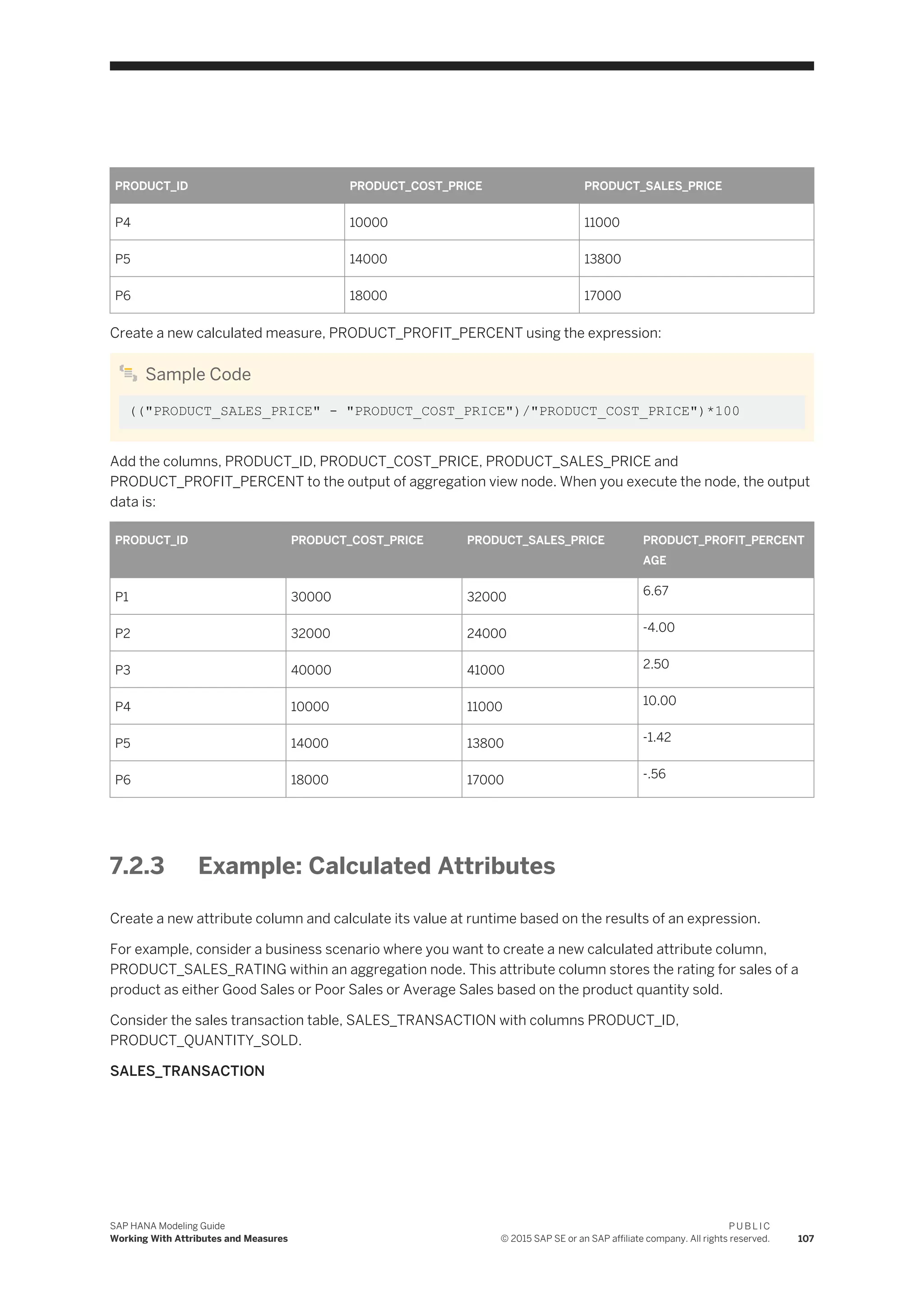
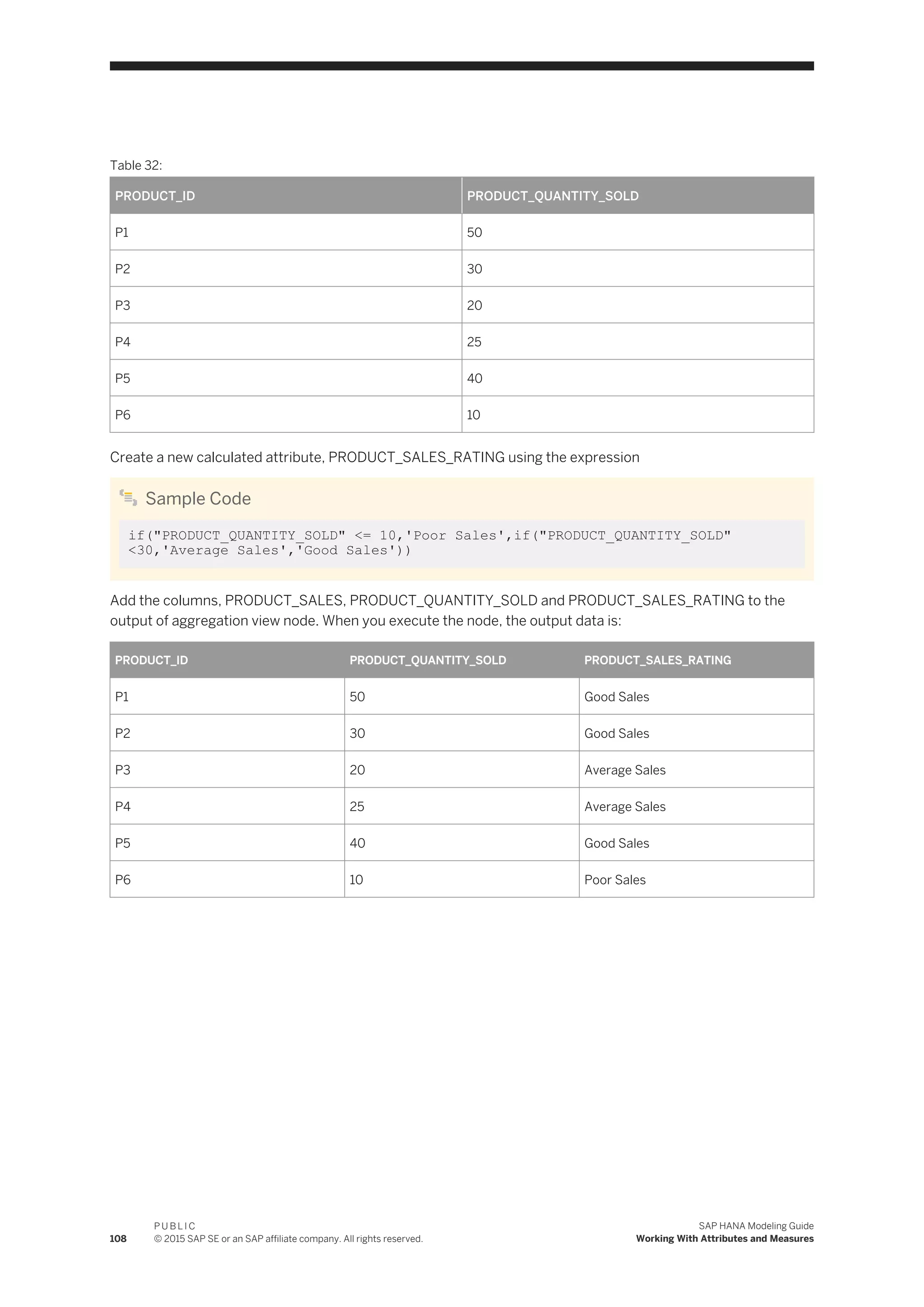
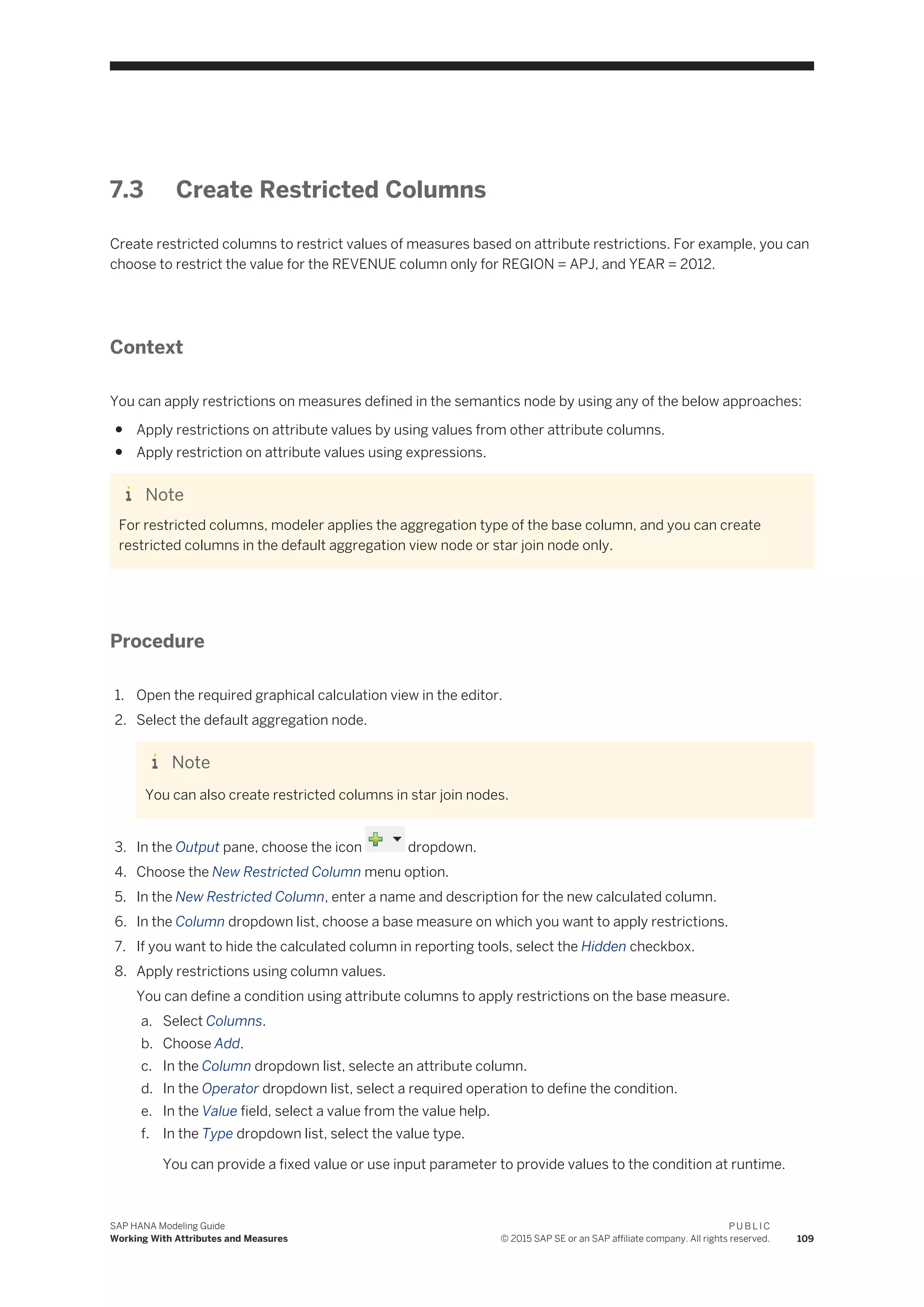
![g. If you want to apply restrictions only for the defined conditions, choose Include.
Note
You can apply restrictions using more than one attribute column.
9. Apply restrictions using expressions.
If you want to use an expression to apply restrictions on the base measure, then:
a. Select Expression.
b. In the Expression Editor, enter your expression.
Note
You can also use input parameters in your expressions to create restricted columns.
Related Information
Using Functions in Expressions [page 203]
Restricted Column Properties [page 110]
Example: Restricted Columns [page 111]
7.3.1 Restricted Column Properties
After creating a restricted column, you can view its properties or change them based on your business
requirements.
Select a restrcited column in the Semantics node. Modeler displays the following properties for calculated
columns in the Properties pane.
Table 33:
Properties Description
Data Type The value of this property specifies the data type of the restricted column.
Hidden The value of this property determines whether the restricted column is hidden in reporting tools.
Display Folder If the restricted measure is grouped in any of the display folder, the value of this property specifies
the display folder that was used to group related measures. For more information, see Group Re
lated Measures [page 146].
110
P U B L I C
© 2015 SAP SE or an SAP affiliate company. All rights reserved.
SAP HANA Modeling Guide
Working With Attributes and Measures](https://image.slidesharecdn.com/51818a91-dee6-4c9b-b633-0deab6e88220-150721193202-lva1-app6892/75/SAP_HANA_Modeling_Guide_for_SAP_HANA_Studio_en-110-2048.jpg)
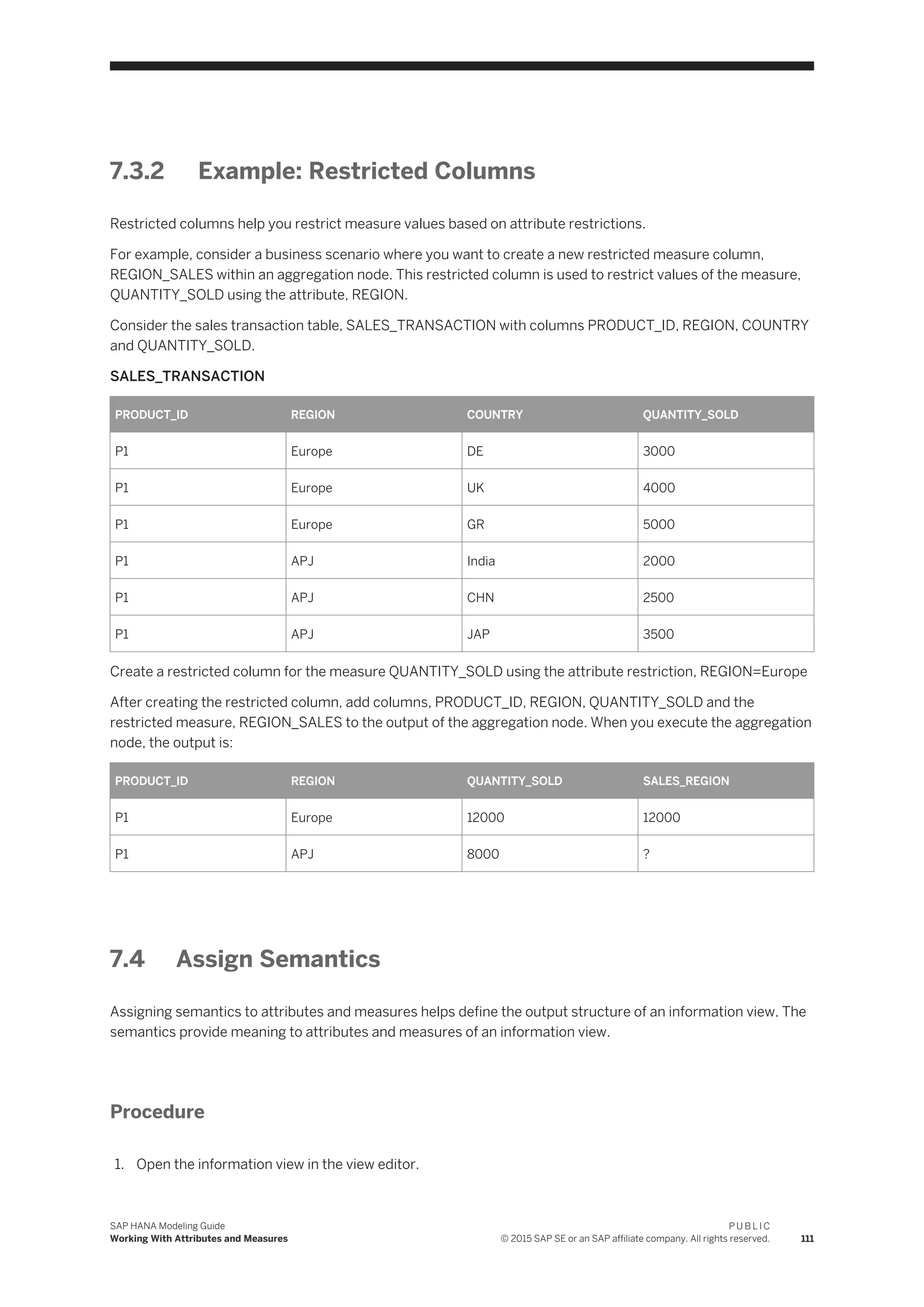
![2. Select the Semantics node.
3. In the Semantic Type column, choose the value help.
4. In the Semantic Type dropdown list, select a value.
5. Choose OK.
Related Information
Extract and Copy Semantics From Underlying Data Sources [page 112]
Propagate Columns to Semantics [page 113]
Supported Semantic Types for Measures [page 114]
Supported Semantic Types for Attributes [page 114]
7.4.1 Extract and Copy Semantics From Underlying Data
Sources
Defining semantics for calculation views includes defining the output columns of the calculation views (its
label, its label column, its aggregation type, and its semantic type) and the hierarchies. While defining the
semantics for a calculation view, you can extract and copy the semantic definitions of columns and hierarchies
from their underlying data sources.
Context
For example, consider that you are modeling a complex calculation view with multiple underlying data sources
and these data source have their own semantic definitions for its columns and hierarchies. In such cases, you
can extract and copy the semantic definitions of columns and hierarchies from their underlying data sources
to define the semantics of the calculation view. This way of extracting and copying the semantic definitions
helps you save the effort of manually defining the semantics of the calculation view.
Procedure
1. Open the required graphical calculation view in view editor.
2. Select the Semantics node.
3. Choose the Columns tab.
4. Choose .
In the Extract Semantics dialog, modeler displays the output columns and hierarchies of underlying data
sources.
112
P U B L I C
© 2015 SAP SE or an SAP affiliate company. All rights reserved.
SAP HANA Modeling Guide
Working With Attributes and Measures](https://image.slidesharecdn.com/51818a91-dee6-4c9b-b633-0deab6e88220-150721193202-lva1-app6892/75/SAP_HANA_Modeling_Guide_for_SAP_HANA_Studio_en-112-2048.jpg)

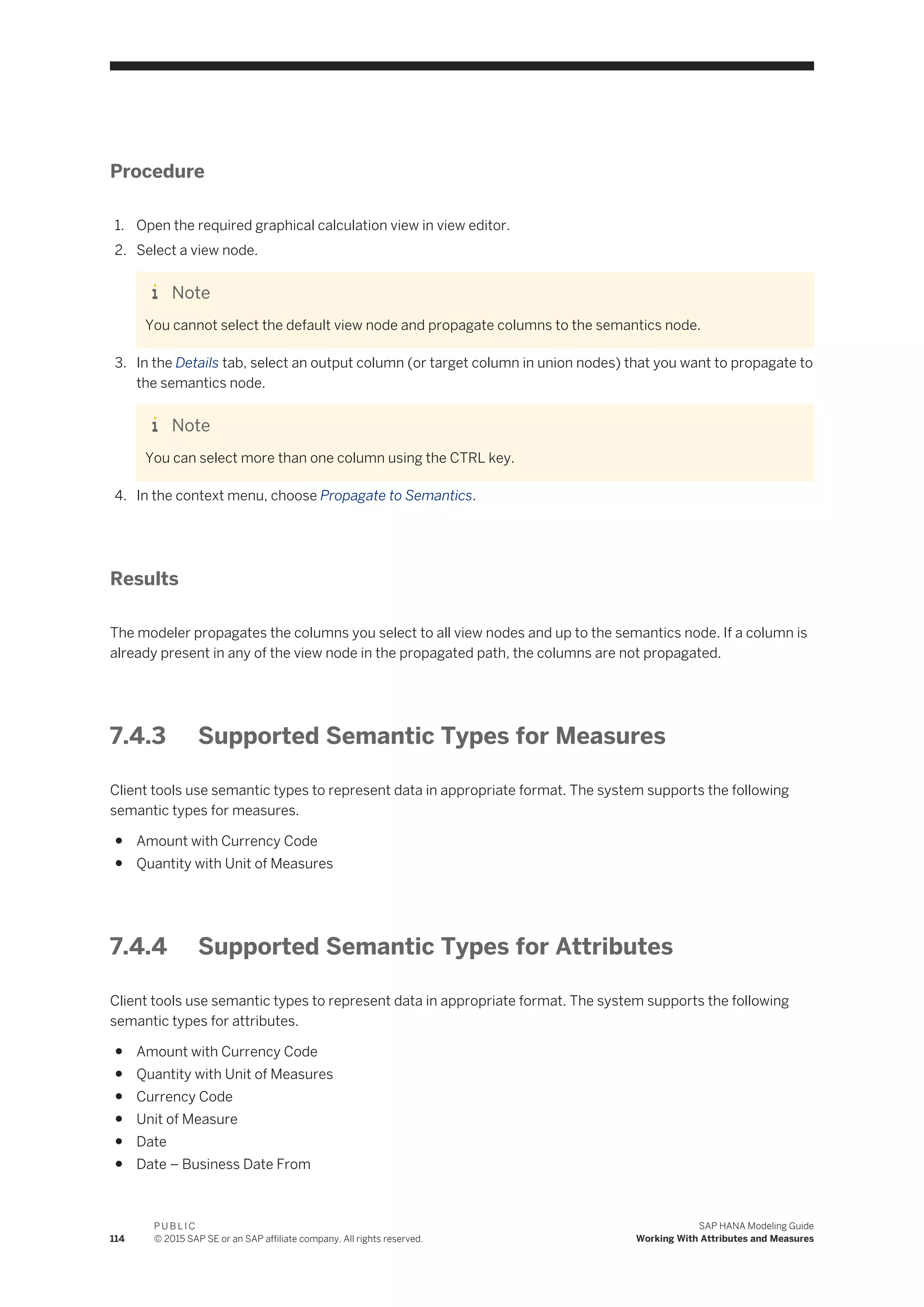
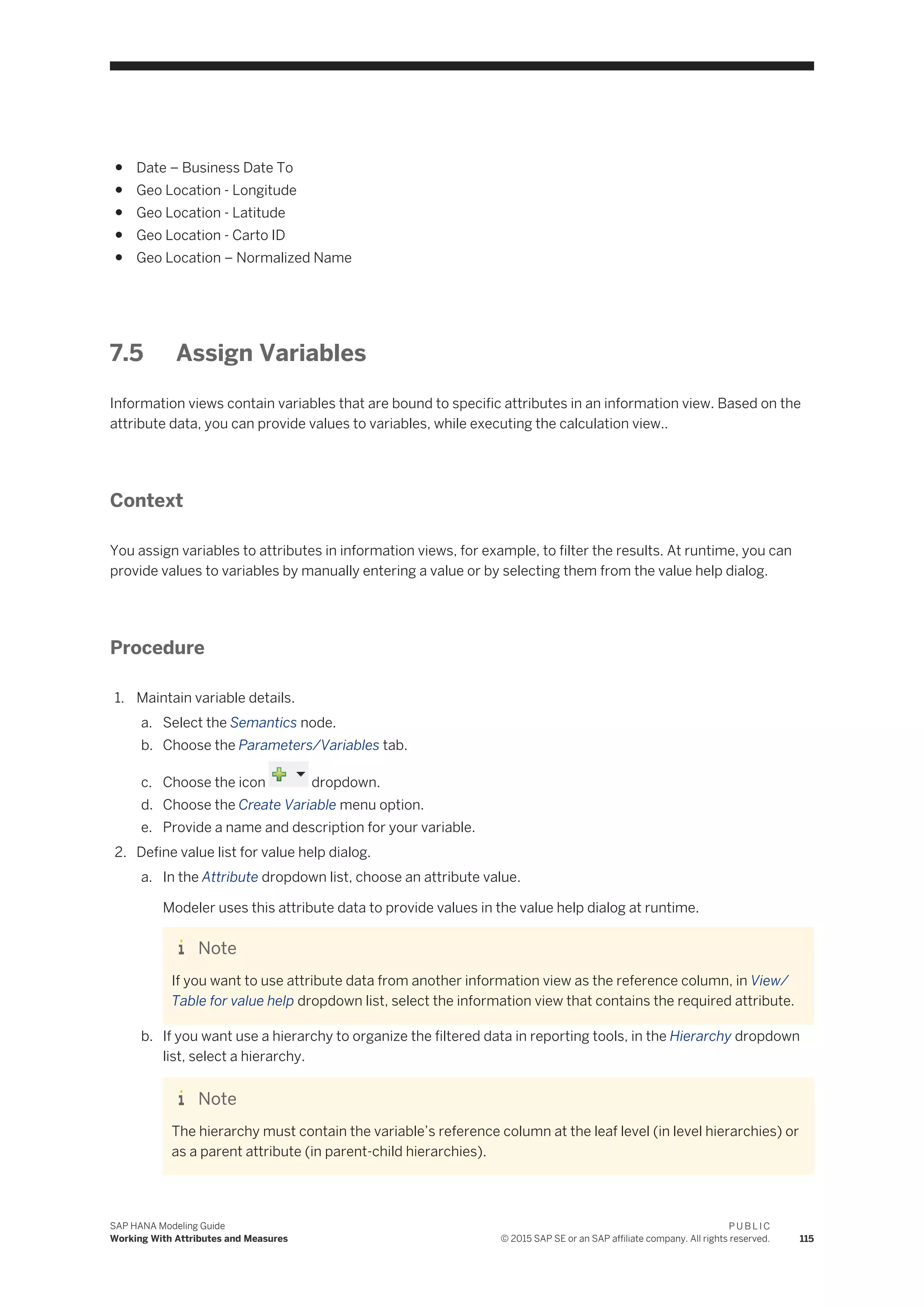
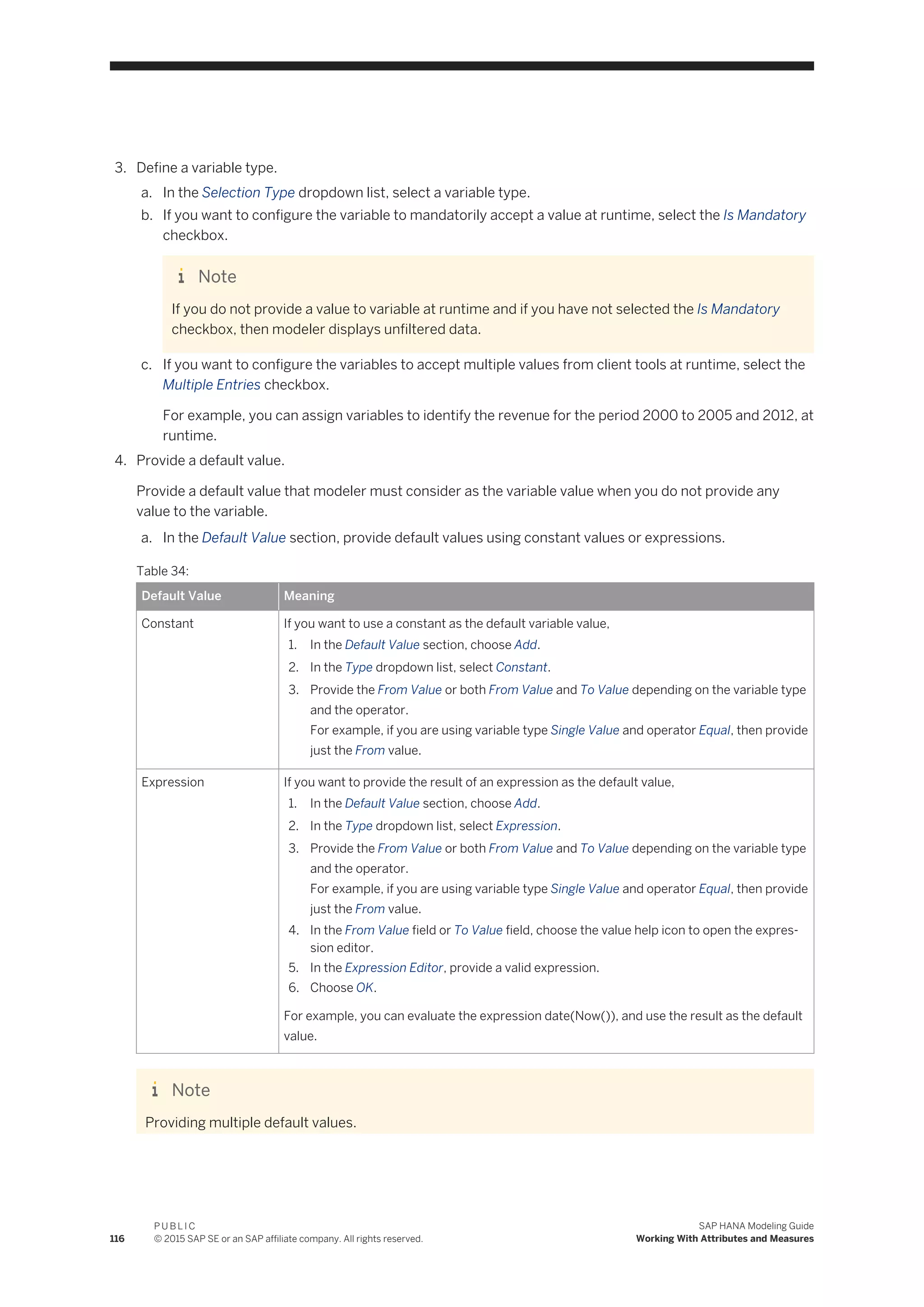
![If you have configured the variable to accept multiple values at the runtime by selecting the Multiple
Entries checkbox, then you can provide multiple default values to the variable. In the Default Value
section, choose Add to add multiple default values. These values appear on the selection screen when
you execute the information view.
5. Assign variables to attributes.
Assign the variable to an attribute to filter its data at runtime.
a. In the Apply the variable filter to section, choose Add to add an attribute.
b. In the Attributes dropdown list, select an attribute.
6. Choose OK.
Related Information
Supported Variable Types [page 117]
Variable Properties [page 117]
7.5.1 Supported Variable Types
SAP HANA modeling environment supports the following variable types:
Type Description
Single Value Use this to filter and view data based on a single attribute value. For example, to view the sales of
a product where the month is equal to January.
Interval Use this to filter and view a specific set of data. For example, to view the expenditure of a
company from March to April.
Range Use this to filter view data based on the conditions that involve operators such as "="(equal to),
">" (greater than), "<" (less than), ">=" (greater than or equal to), and "<=" (less than or equal to).
For example, to view the sales of all products in a month where the quantity sold is >= 100..
7.5.2 Variable Properties
After creating a variable, you can view its properties or change them based on your business requirement.
In the Parameters/Variables tab, select a variable. Modeler displays the following variable properties in the
Properties tab.
SAP HANA Modeling Guide
Working With Attributes and Measures
P U B L I C
© 2015 SAP SE or an SAP affiliate company. All rights reserved. 117](https://image.slidesharecdn.com/51818a91-dee6-4c9b-b633-0deab6e88220-150721193202-lva1-app6892/75/SAP_HANA_Modeling_Guide_for_SAP_HANA_Studio_en-117-2048.jpg)
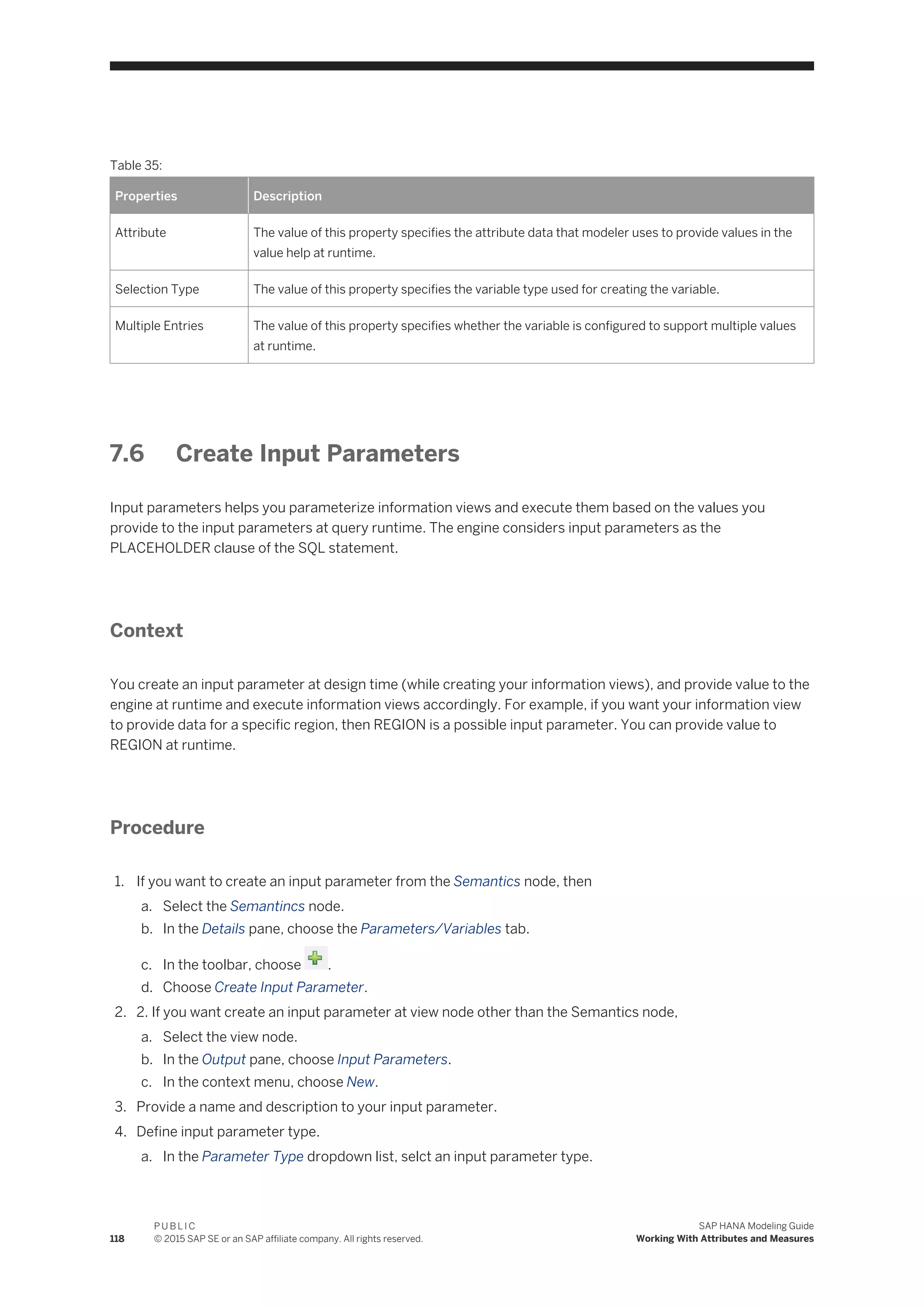
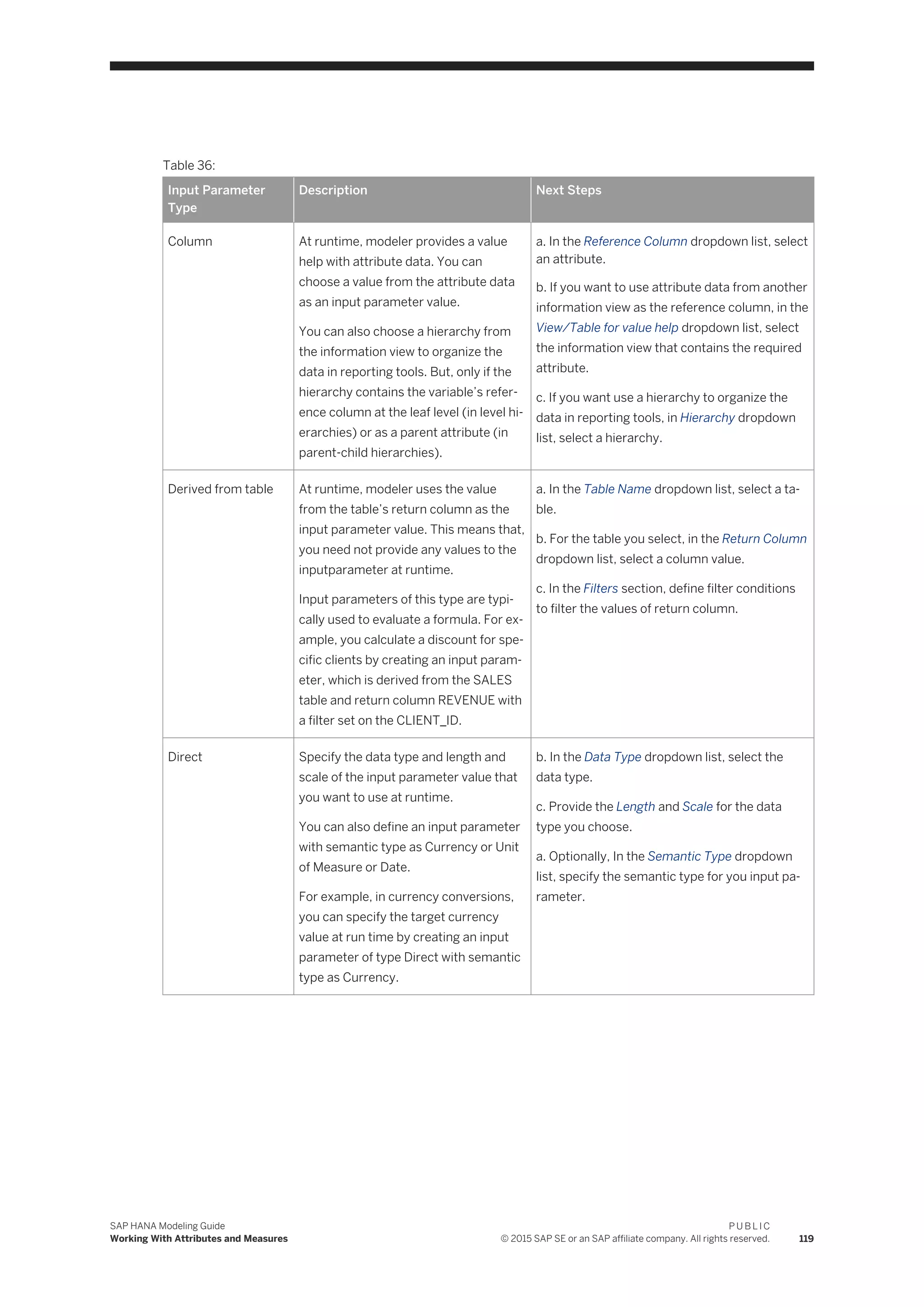
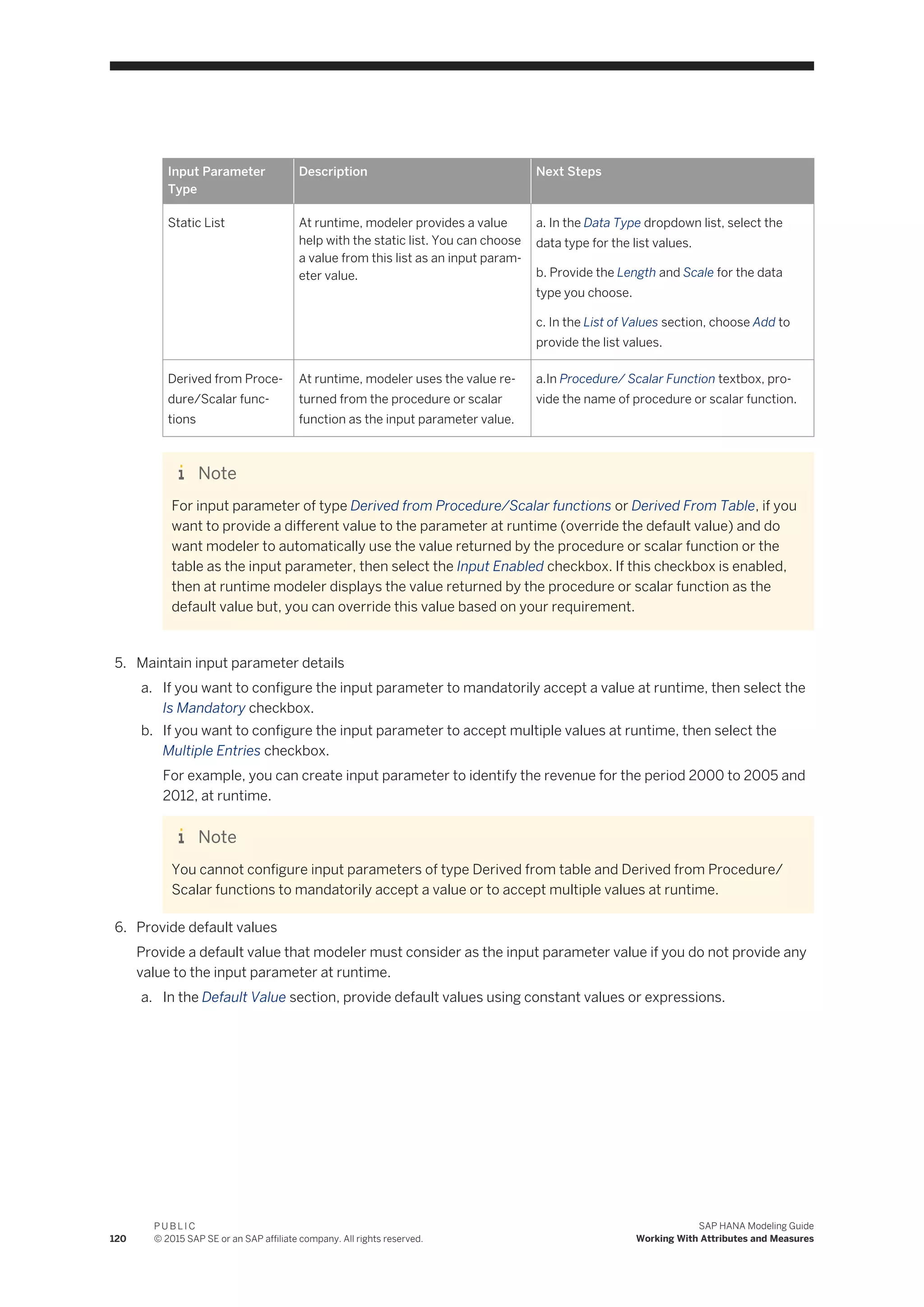
![Table 37:
Default Value Meaning
Constant If you want to use a constant value as the default input parameter value,
1. In the Default Value section, choose Add.
2. In Type dropdown list section, select Constant.
3. In Value field, provide a constant value.
Expression If you want to use the result of an expression as the default input parameter value:
1. In the Default Value section, choose Add.
2. In Type dropdown list section, select Expression.
3. In the Value field, choose the value help to open the expression editor.
4. In the Expression Editor, enter a valid expression.
5. Choose Validate Syntax.
6. Choose OK.
For example, you can evaluate the expression date(Now()), and use the result as the default
input parameter value at runtime.
Note
Providing multiple default constant values. If you have configured the input parameter to accept
multiple values at the runtime by selecting the Multiple Entries checkbox, then you can provide
multiple default constant values to the input parameter. In the Default Value section, choose Add to
add multiple default constant values. These values appear on the selection screen when you
execute the information view.
You cannot use a combination of expressions and constants as default values for input parameters.
7. Choose OK.
Related Information
Map Input Parameters or Variables [page 122]
Map Input Parameters or Variables of External Views for Value Help [page 123]
Input Parameters [page 125]
Input Parameter Properties [page 126]
SAP HANA Modeling Guide
Working With Attributes and Measures
P U B L I C
© 2015 SAP SE or an SAP affiliate company. All rights reserved. 121](https://image.slidesharecdn.com/51818a91-dee6-4c9b-b633-0deab6e88220-150721193202-lva1-app6892/75/SAP_HANA_Modeling_Guide_for_SAP_HANA_Studio_en-121-2048.jpg)
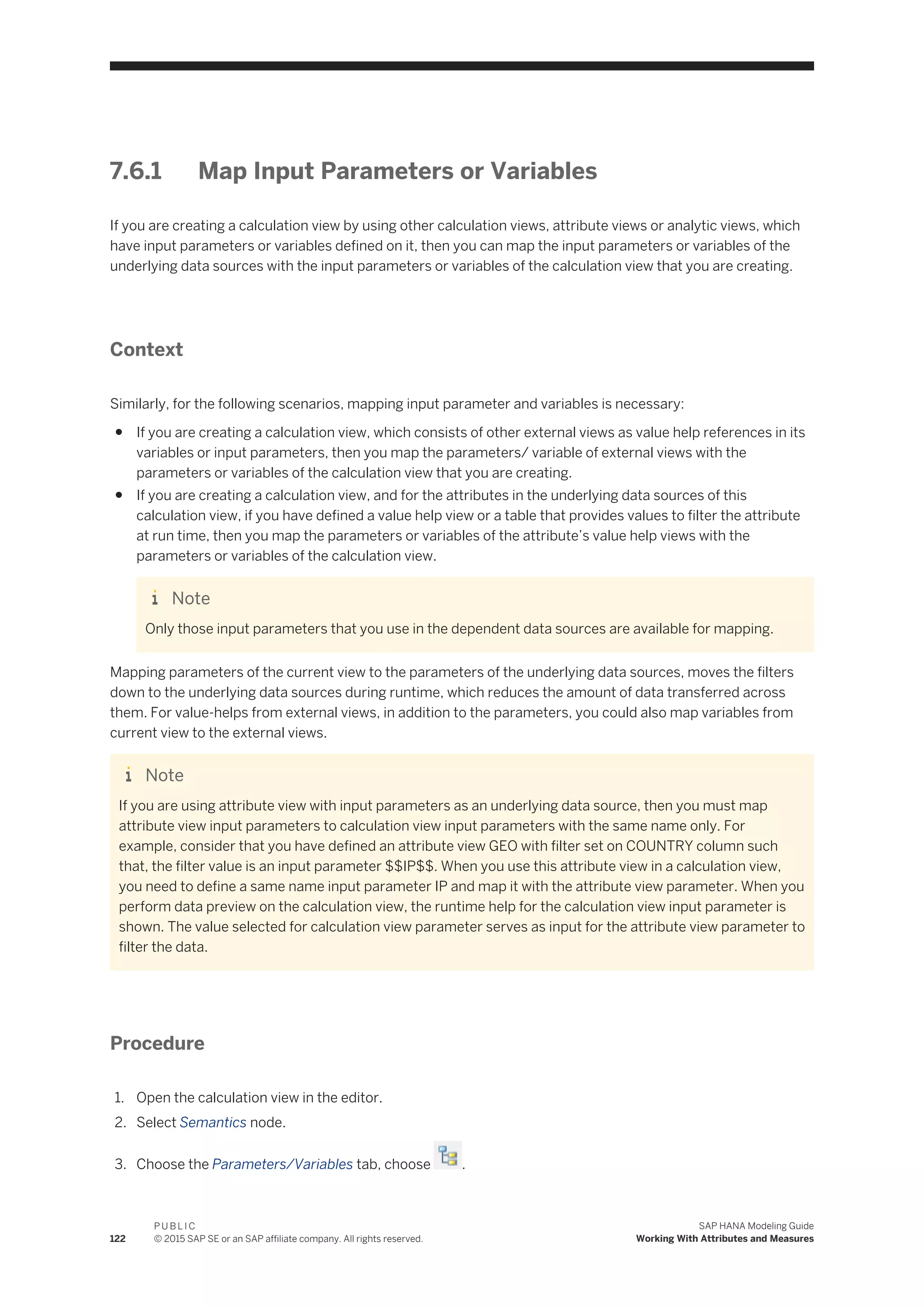
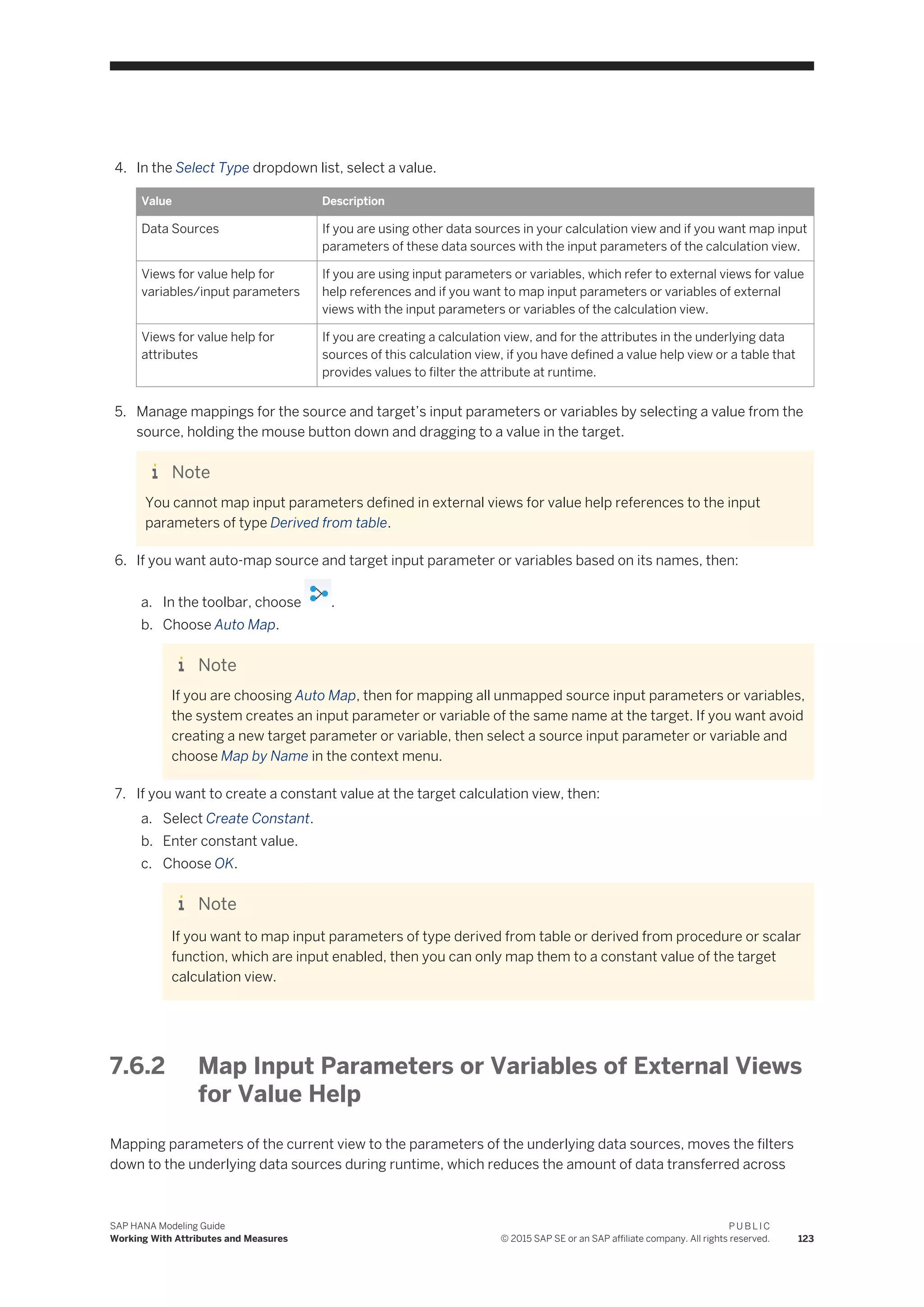
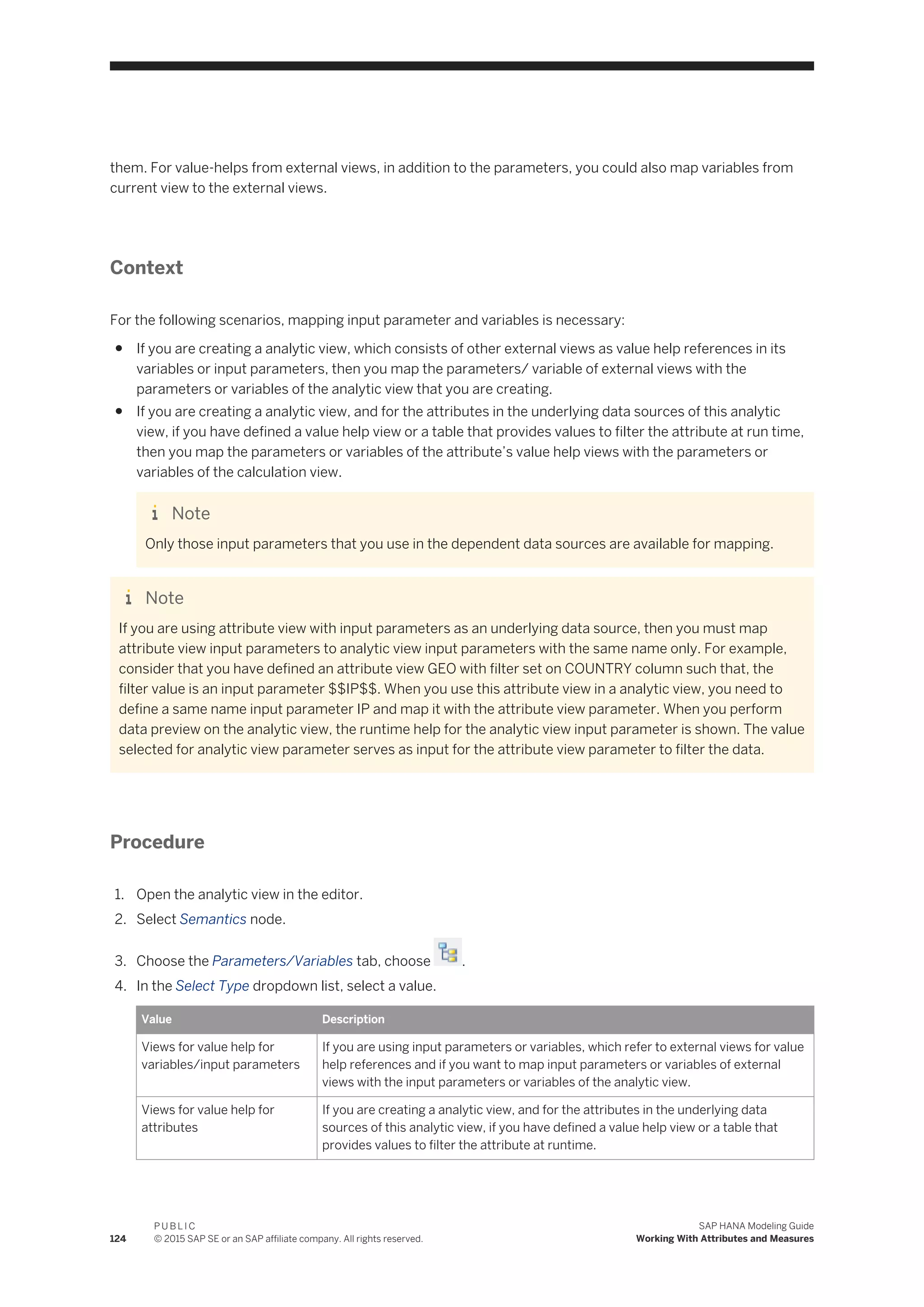
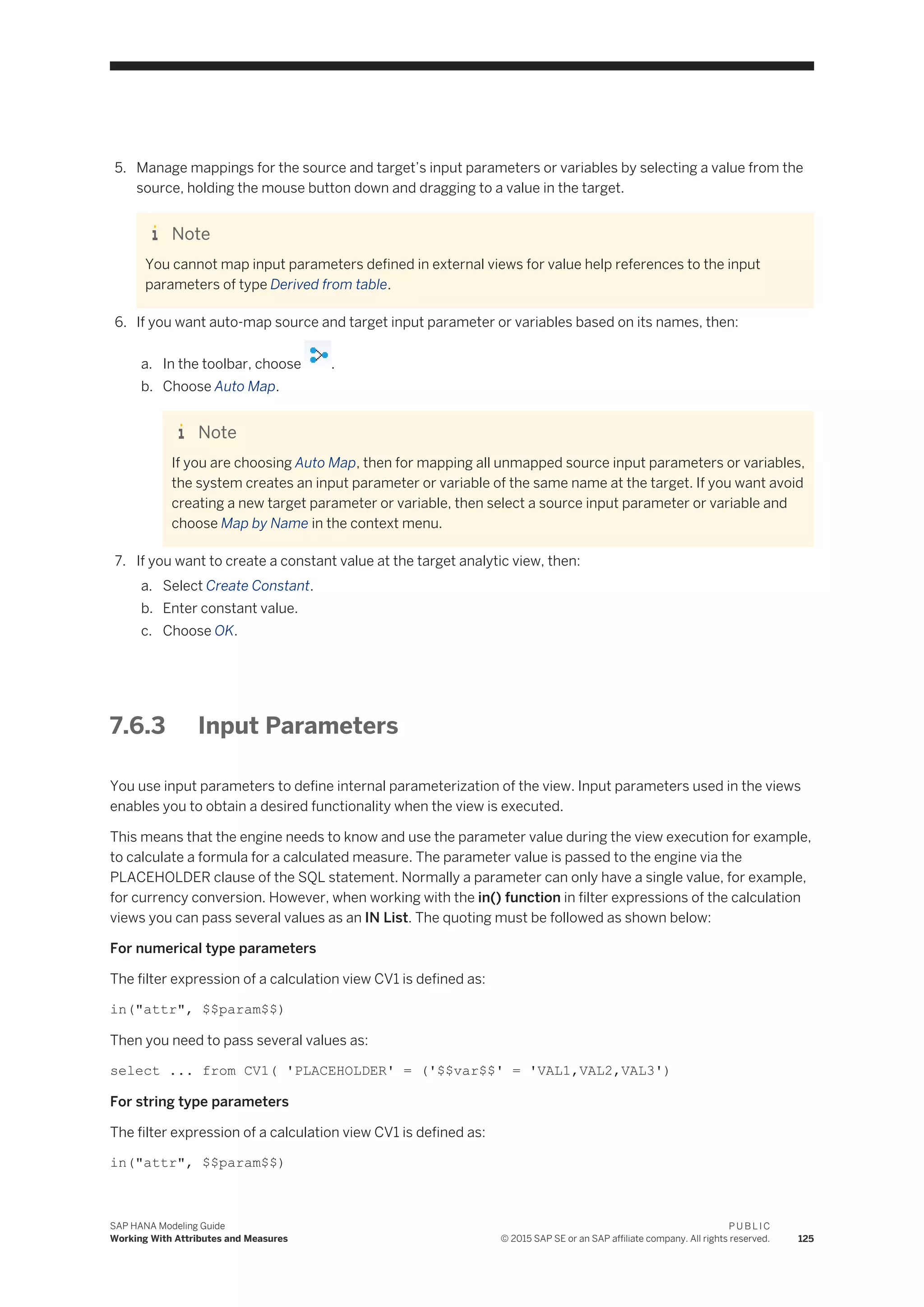
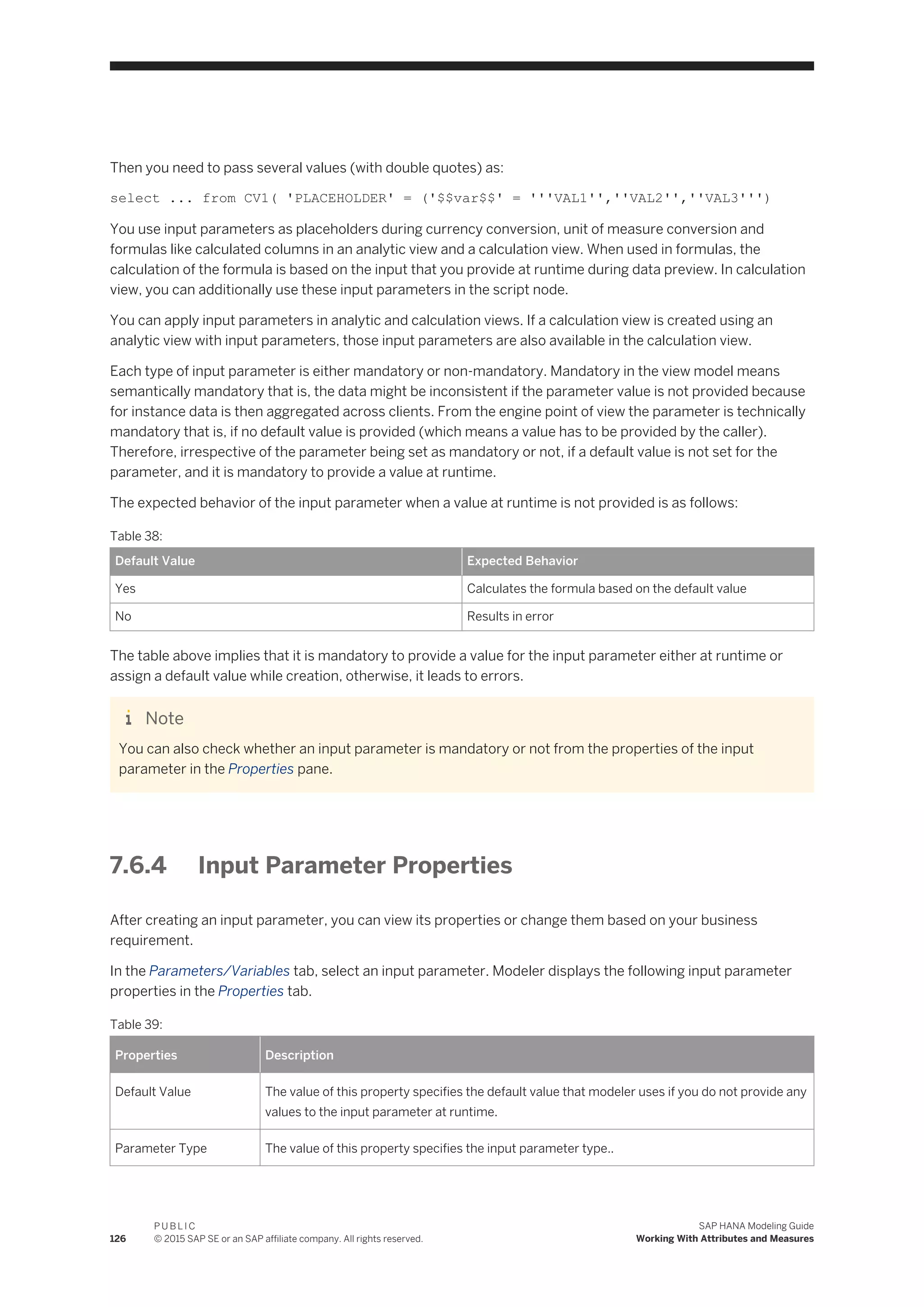
![Properties Description
Multiple Entries The value of this property specifies whether the input parameter is configured to support multi
ple values at runtime.
Is Mandatory The value of this property specifies whether the input parameter is configured to mandatorily
accept a value at runtime.
7.7 Using Hierarchies for Reporting
SAP HANA modeler helps create hierarchies to organize data in a tree structure for multidimensional
reporting. Each hierarchy comprises of a set of levels having many-to-one relationships between each other
and collectively these levels make up the hierarchical structure.
For example, a time hierarchy comprises of levels such as Fiscal Year, Fiscal Quarter, Fiscal Month, and so on.
You can create the following two types of hierarchies in SAP HANA Modeler:
● Level Hierarchies
● Parent-child Hierarchies
Note
Hierarchies in attribute views are not available in a calculation views that reuses the attribute view.
Related Information
Create Level Hierarchies [page 127]
Create Parent-Child Hierarchies [page 130]
Query Shared Hierarchies [page 134]
7.7.1 Create Level Hierarchies
In level hierarchies each level represents a position in the hierarchy. For example, a time dimension can have a
hierarchy that represents data at the month, quarter, and year levels.
Context
Level hierarchies consist of one or more levels of aggregation. Attributes roll up to the next higher level in a
many-to-one relationship and members at this higher level roll up into the next higher level, and so on, until
SAP HANA Modeling Guide
Working With Attributes and Measures
P U B L I C
© 2015 SAP SE or an SAP affiliate company. All rights reserved. 127](https://image.slidesharecdn.com/51818a91-dee6-4c9b-b633-0deab6e88220-150721193202-lva1-app6892/75/SAP_HANA_Modeling_Guide_for_SAP_HANA_Studio_en-127-2048.jpg)
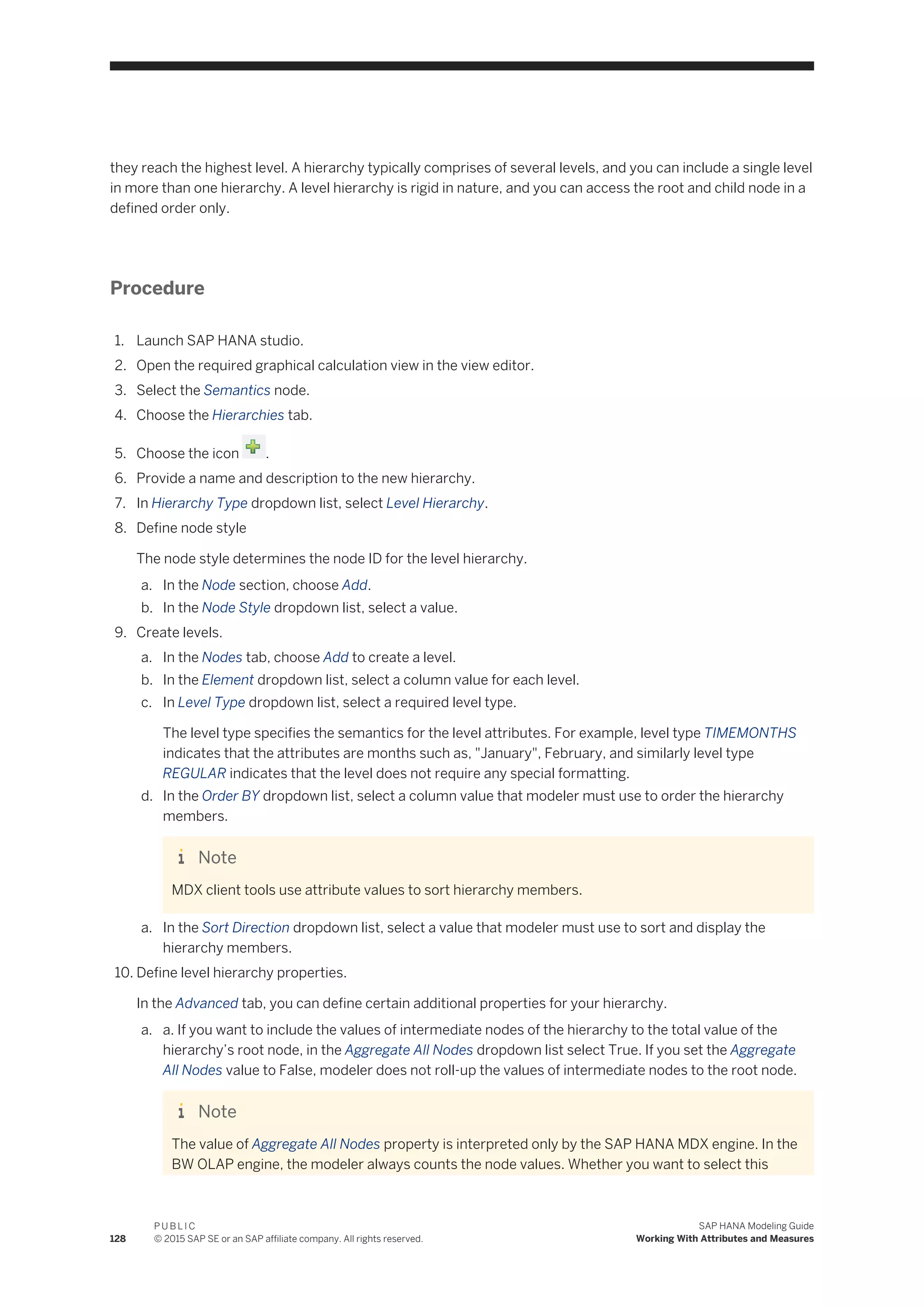
![property depends on the business requirement. If you are sure that there is no data posted on
aggregate nodes, you should set the option to false. The engine then executes the hierarchy faster.
b. In the Default Member textbox, enter a value for the default member.
This value helps modeler identify the default member of the hierarchy. If you do not provide any value,
all members of hierarchy are default members.
c. In the Orphan Nodes dropdown list, select a value.
This value helps modeler know how to handle orphan nodes in the hierarchy.
Note
If you select Stepparent option to handle orphan nodes, in the Stepparent text field, enter a value
(node ID) for the step parent node. The step parent node must already exist in the hierarchy at the
root level and you must enter the node ID according to the node style that you select for the
hierarchy. For example if you select node style Level Name, the stepparent node ID can be [Level2].
[B2]. The modeler assigns all orphan nodes under this node.
d. In the Root Node Visibility dropdown list, select a value.
The value helps modeler know if it needs to add an additional root node to the hierarchy.
e. If you want the level hierarchy to support multiple parents for its elements, select the Multiple Parent
checkbox.
Related Information
Node Style [page 129]
Level Hierarchy Properties [page 130]
Root Node Visibility [page 135]
Orphan Nodes [page 135]
Query Shared Hierarchies [page 134]
7.7.1.1 Node Style
Node style is applicable for level hierarchies, and helps modeler identify the format the node ID. For example, if
the node ID must comprise of the level name and the node name in the reporting tools.
Table 40:
Node Style Description
Level Name For this node style, the node ID comprises of the level name and the node name.
For example, for a fiscal hierarchy, the Level Name node style implies:
MONTH.JAN
SAP HANA Modeling Guide
Working With Attributes and Measures
P U B L I C
© 2015 SAP SE or an SAP affiliate company. All rights reserved. 129](https://image.slidesharecdn.com/51818a91-dee6-4c9b-b633-0deab6e88220-150721193202-lva1-app6892/75/SAP_HANA_Modeling_Guide_for_SAP_HANA_Studio_en-129-2048.jpg)
![Node Style Description
Name Only For this node style, the node ID comprises of the level name only. For example, for
a fiscal hierarchy, the Name Only node style implies: JAN
Name Path For this node style, the node ID comprises of the node name and the names of all
ancestors apart from the (single physical) root node. For example, for a fiscal hier
archy, the Level Name node style implies: FISCAL_2015.QUARTER_1.JAN
7.7.1.2 Level Hierarchy Properties
Based on your business requirements, you can define certain properties of level hierarchies. The value of these
properties determines the characteristics of the hierarchy at runtime.
In the Hierarchies tab, select a level hierarchy. Modeler displays the following hierarchy properties in the
Properties tab.
Table 41:
Properties Description
Aggregate All Nodes The value of this property determines whether modeler must roll-up the value of inter
mediate nodes of the hierarchy to the root node of the hierarchy. If the value is set to
True, modeler rolls-up the value of intermediate nodes to the total value of the hierar
chy’s root node.
Default Member (English) This value of this property helps modeler identify the default member of the hierarchy. If
you do not provide any value, all members of hierarchy are default members.
Root Node Visibility The value of this property helps modeler know if it needs to add an additional root node
to the hierarchy. For more information, see Root Node Visibility [page 135].
Node Style The value of this property specifies the node ID format of the level hierarchy. For more
information, see Node Style [page 129].
7.7.2 Create Parent-Child Hierarchies
In parent-child hierarchies, you use a parent attribute that determines the relationship among the view
attributes. Parent-child hierarchies have elements of the same type and do not contain named levels.
Context
Parent-child hierarchies are value-based hierarchies, and you create a parent-child hierarchy from a single
parent attribute. You can also define multiple parent-child pairs to support the compound node IDs. For
130
P U B L I C
© 2015 SAP SE or an SAP affiliate company. All rights reserved.
SAP HANA Modeling Guide
Working With Attributes and Measures](https://image.slidesharecdn.com/51818a91-dee6-4c9b-b633-0deab6e88220-150721193202-lva1-app6892/75/SAP_HANA_Modeling_Guide_for_SAP_HANA_Studio_en-130-2048.jpg)
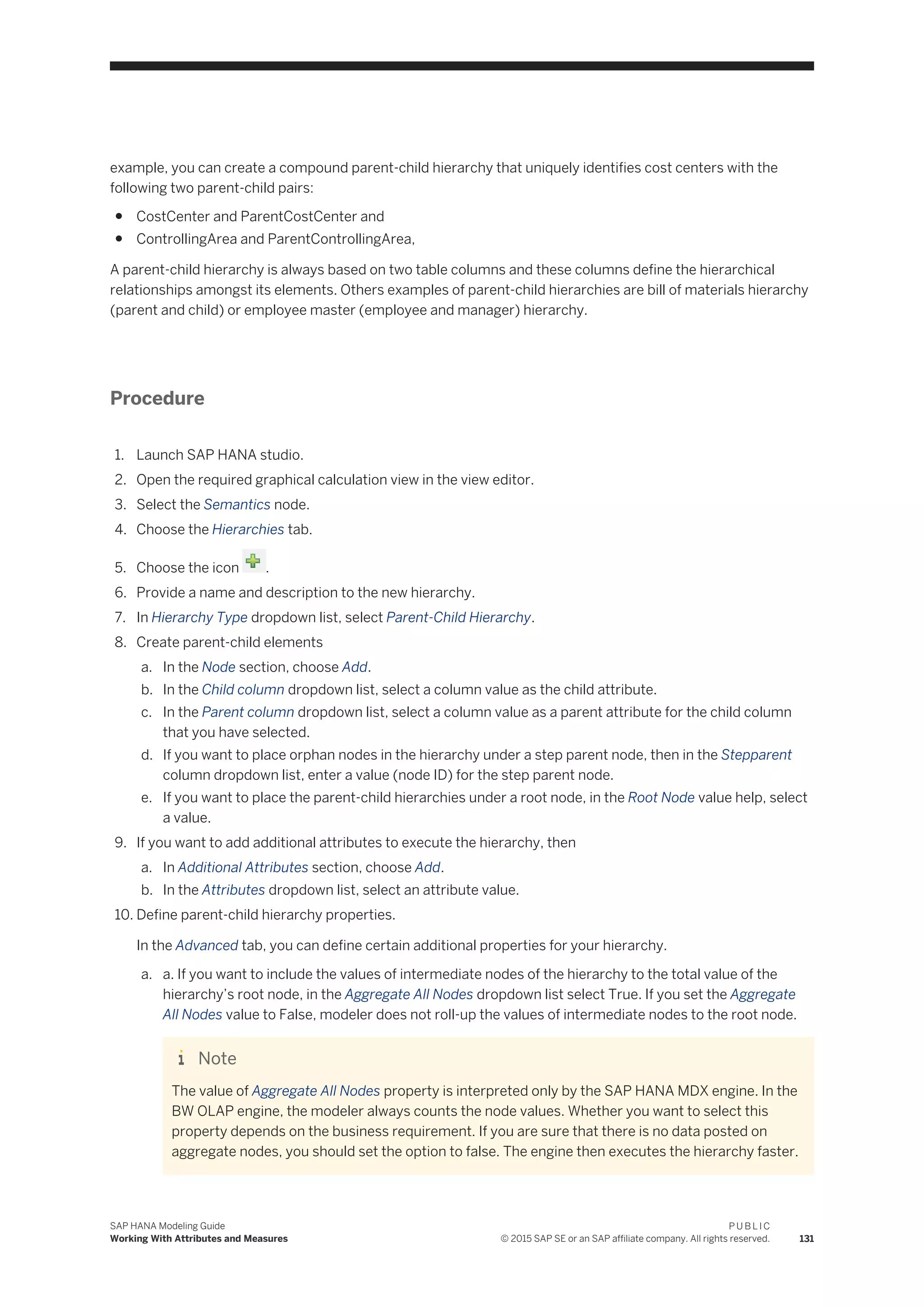

![c. In the To Date Parameter dropdown list, select an input parameter that you want to use to provide the
valid to date at run time.
14. If you want to use an input parameter to specify the key date at run time,
a. In the Validity Period section, select Key Date.
b. In the Key Date Parameter dropdown list, select an input parameter value that you want to use to
provide key date value at runtime.
Related Information
Create Parent-Child Hierarchies [page 130]
Parent-Child Hierarchy Properties [page 133]
Query Shared Hierarchies [page 134]
Root Node Visibility [page 135]
Orphan Nodes [page 135]
7.7.2.1 Parent-Child Hierarchy Properties
Based on your business requirements, you can define certain properties of parent-child hierarchies. The value
of these properties determines the characteristics of the hierarchy at runtime.
In the Hierarchies tab, select a parent-child hierarchy. Modeler displays the following hierarchy properties in
the Properties tab.
Table 42:
Properties Description
Aggregate All Nodes The value of this property determines whether modeler must roll-up the value of inter
mediate nodes of the hierarchy to the root node of the hierarchy. If the value is set to
True, modeler rolls-up the value of intermediate nodes to the total value of the hierar
chy’s root node.
Default Member (English) This value of this property helps modeler identify the default member of the hierarchy.
If you do not provide any value, all members of hierarchy are default members.
Root Node Visibility The value of this property helps modeler know whether it needs to add an additional
root node to the hierarchy. For more information, see Root Node Visibility [page 135].
SAP HANA Modeling Guide
Working With Attributes and Measures
P U B L I C
© 2015 SAP SE or an SAP affiliate company. All rights reserved. 133](https://image.slidesharecdn.com/51818a91-dee6-4c9b-b633-0deab6e88220-150721193202-lva1-app6892/75/SAP_HANA_Modeling_Guide_for_SAP_HANA_Studio_en-133-2048.jpg)
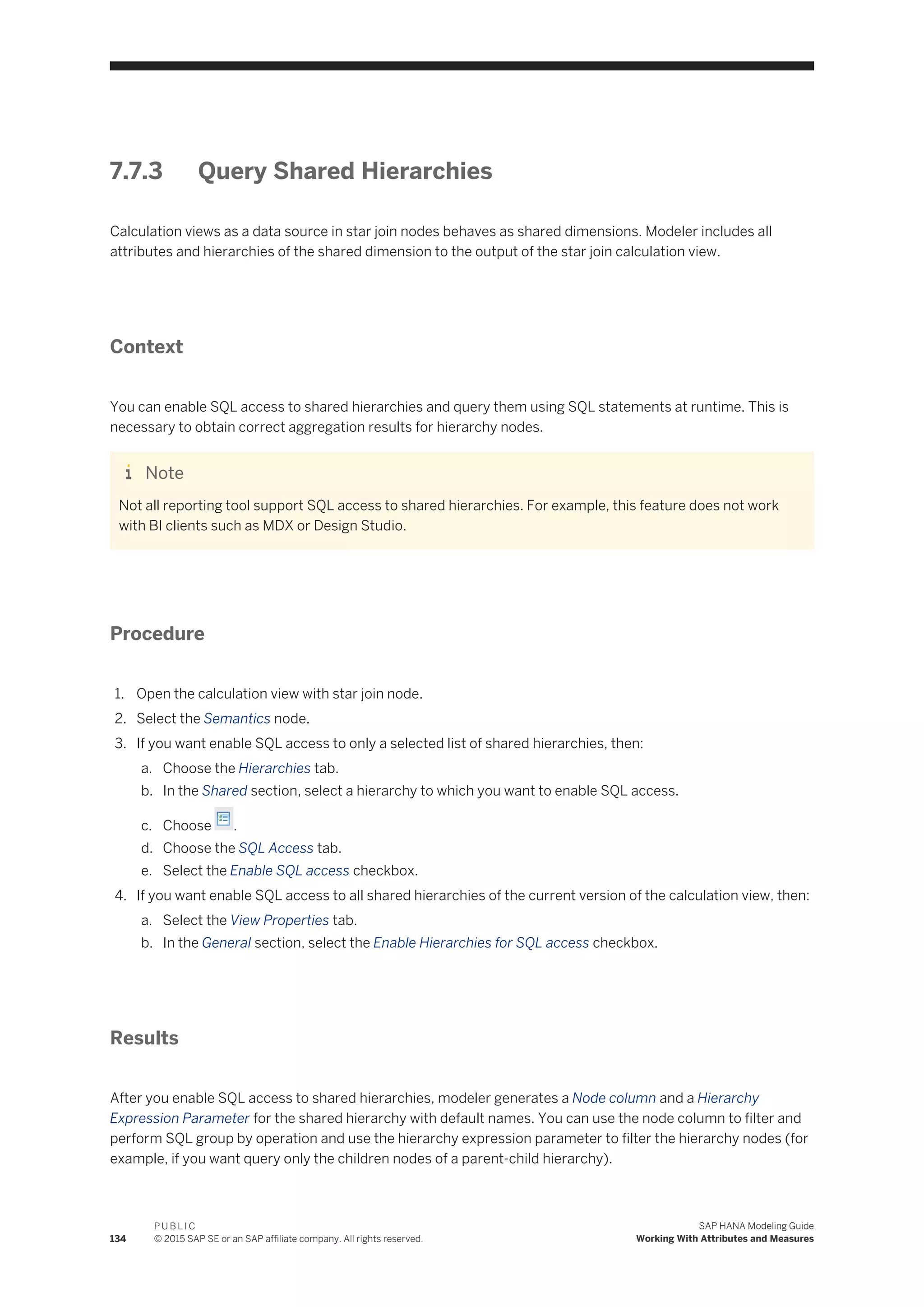
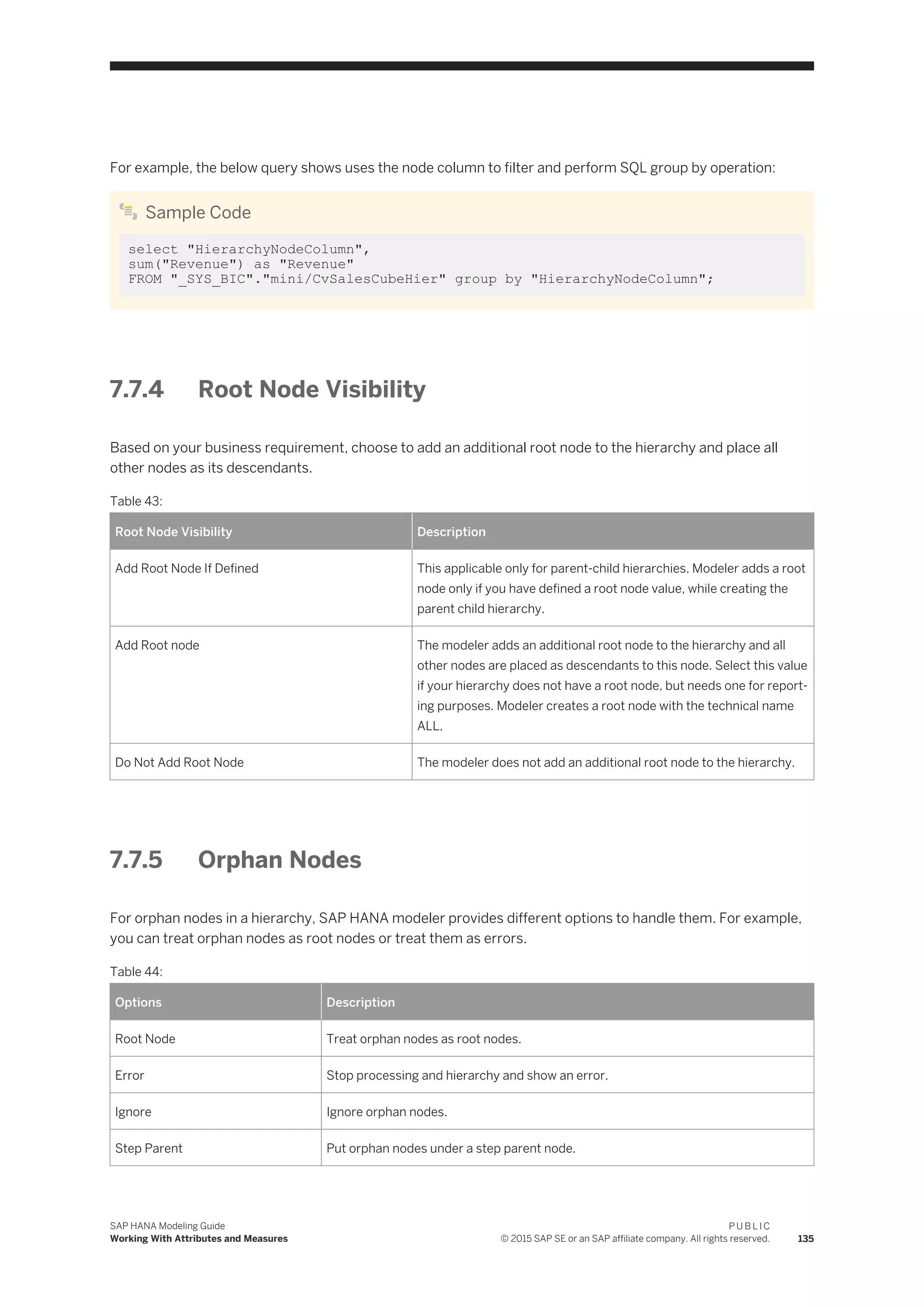
![7.8 Using Currency and Unit of Measure Conversions
If measures in your calculation views or analytic views represent currency or unit values, associate them with
currency codes or unit of measures. This helps you display the measure values along with currency codes or
unit of measures at data preview or in reporting tools.
Associating measures with currency code or unit of measure is also necessary for currency conversion or unit
conversions respectively.
Modeler performs currency conversions based on the source currency value, target currency value, exchange
rate, and date of conversion. Similarly, it performs unit conversions based on the source unit and target unit.
Use input parameters in currency conversion and unit conversion to provide the target currency value, the
exchange rate, the date of conversion or the target unit value at runtime.
Related Information
Associate Measures with Currency [page 136]
Associate Measures with Unit of Measure [page 140]
Create Input Parameters [page 118]
7.8.1 Associate Measures with Currency
If measures in your calculation views or analytic views represent currency or unit values, associate them with
currency codes or unit of measures. This helps you display the measure values along with currency codes or
unit of measures at data preview or in reporting tools.
Prerequisites
You have imported the currency tables TCURC, TCURF, TCURN, TCURR, TCURT, TCURV, TCURW, and
TCURX.
Context
Associating measures with currency codes is also necessary for currency conversions. For example, consider
that you want to generate a sales report for a region in a particular currency code and you have the sales data
in the database table with a different currency code. In such cases, create a calculation view by using the table
column containing the sales data in different currency as a measure and associate the measure with your
desired currency to perform currency conversion. Activate the calculation view to generate required reports.
136
P U B L I C
© 2015 SAP SE or an SAP affiliate company. All rights reserved.
SAP HANA Modeling Guide
Working With Attributes and Measures](https://image.slidesharecdn.com/51818a91-dee6-4c9b-b633-0deab6e88220-150721193202-lva1-app6892/75/SAP_HANA_Modeling_Guide_for_SAP_HANA_Studio_en-136-2048.jpg)

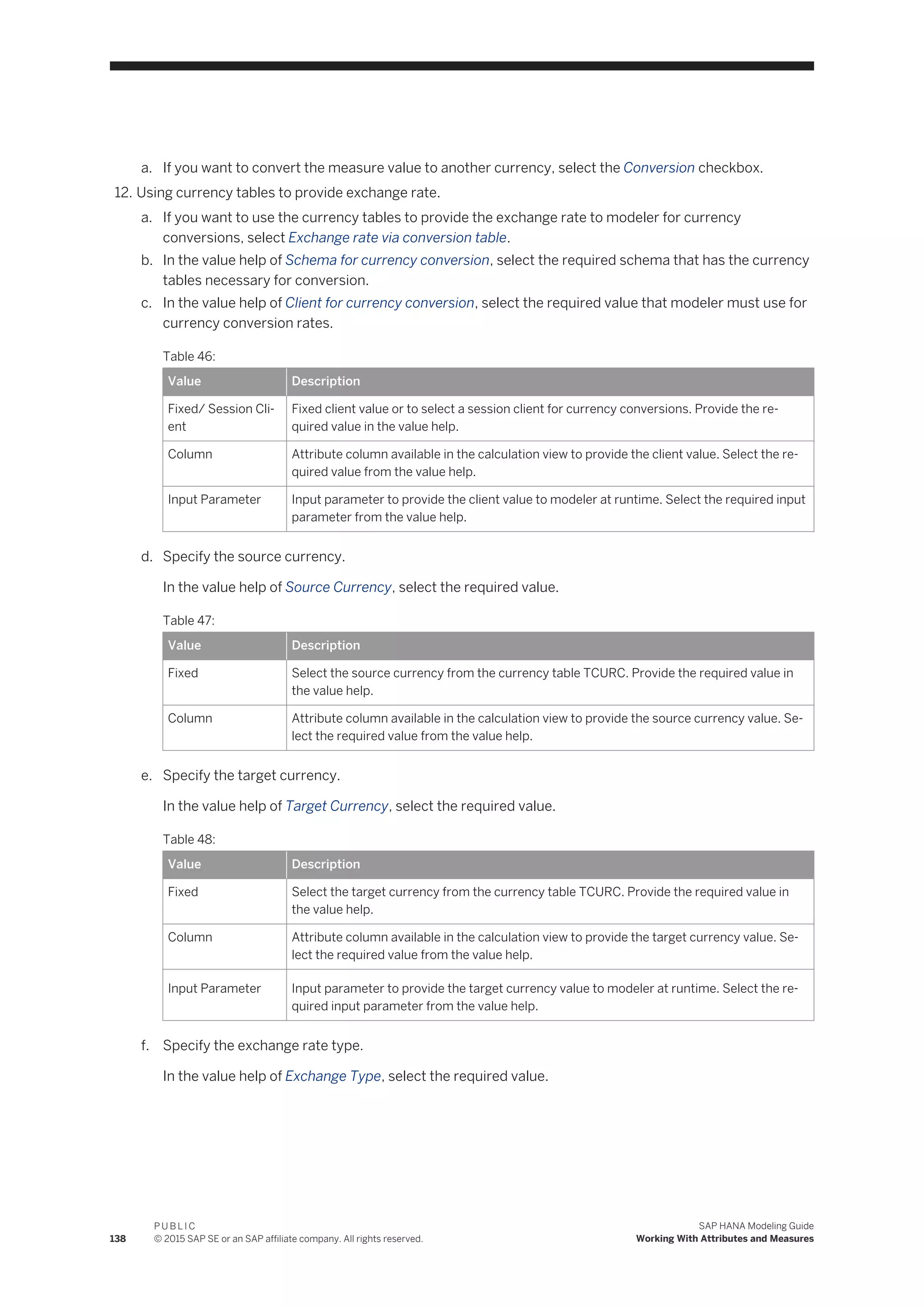
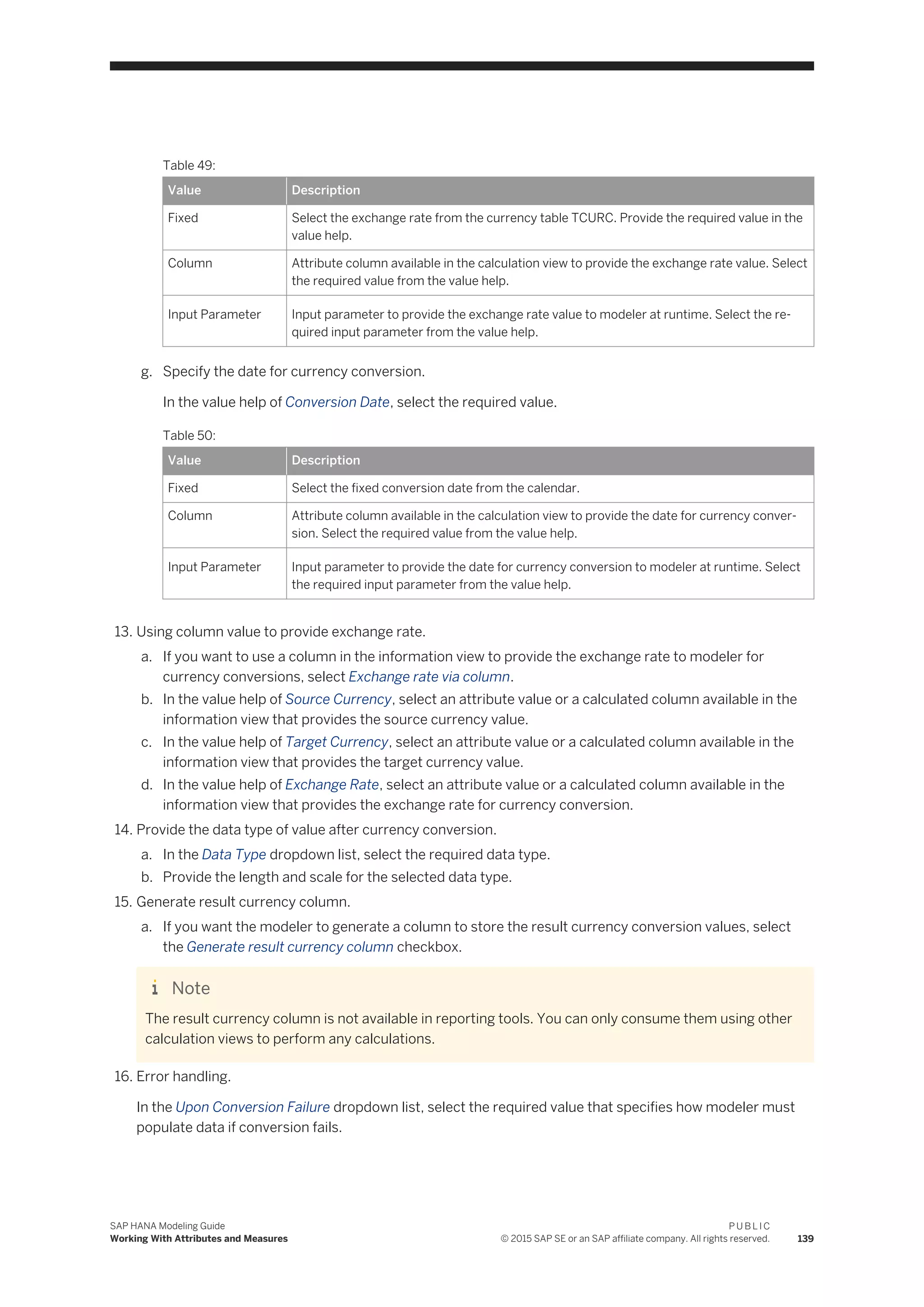
![Table 51:
Value Description
Fail Modeler displays error for conversion failures at data preview.
Ignore Modeler sets the values for corresponding records to NULL at data preview.
Set to NULL Modeler displays unconverted value for the corresponding records at data preview.
17. Choose OK.
Related Information
Create Input Parameters [page 118]
7.8.2 Associate Measures with Unit of Measure
If measures in calculation views or analytic views represent unit values, associate the measures with a unit of
measure. This helps you display the measure values along with the unit of measures at data preview or in
reporting tools.
Prerequisites
You have imported the unit tables T006, T006D, and T006A.
Context
Associating measures with unit of measures is also necessary for unit conversions. For example, if you want to
convert a unit of a measure from cubic meters to barrels to perform volume calculations, then associate the
unit of measure with the sematic type Quantity with Unit of Measure and perform unit conversions.
Procedure
1. Open the required graphical calculation view in the view editor.
2. Select the Semantics node.
3. In the Columns tab, select a measure to associate it with currency code.
4. Choose the icon dropdown list.
140
P U B L I C
© 2015 SAP SE or an SAP affiliate company. All rights reserved.
SAP HANA Modeling Guide
Working With Attributes and Measures](https://image.slidesharecdn.com/51818a91-dee6-4c9b-b633-0deab6e88220-150721193202-lva1-app6892/75/SAP_HANA_Modeling_Guide_for_SAP_HANA_Studio_en-140-2048.jpg)

![Table 55:
Value Description
Fixed Select the target unit from the unit tables T006, T006A or T006D. Provide the required
value in the value help.
Column Attribute column available in the calculation view to provide the target unit value. Select the
required value from the value help.
Input Parameter Input parameter to provide the target unit value to modeler at runtime. Select the required
input parameter from the value help.
9. Generate result unit column.
a. If you want the modeler to generate a column to store the result unit conversion values, select the
Generate result unit column checkbox.
Note
The result unit column is not available in reporting tools. You can only consume them using other
calculation views to perform any calculations.
10. Error handling.
In the Upon Conversion Failure dropdown list, select the required value that specifies how modeler must
populate data if conversion fails.
Table 56:
Value Description
Fail Modeler displays error for conversion failures at data preview.
Ignore Modeler sets the values for corresponding records to NULL at data preview.
Set to NULL Modeler displays unconverted value for the corresponding records at data preview.
11. Choose OK.
Related Information
Create Input Parameters [page 118]
142
P U B L I C
© 2015 SAP SE or an SAP affiliate company. All rights reserved.
SAP HANA Modeling Guide
Working With Attributes and Measures](https://image.slidesharecdn.com/51818a91-dee6-4c9b-b633-0deab6e88220-150721193202-lva1-app6892/75/SAP_HANA_Modeling_Guide_for_SAP_HANA_Studio_en-142-2048.jpg)
![7.9 Enable Attributes for Drilldown in Reporting Tools
By default, SAP HANA modeler allows you to drilldown attributes or calculated attributes in reporting tools.
For attributes in calculation views with data category as dimension, you can drilldown using flat hierarchies in
MDX based tools.
Procedure
1. Open the information view in the view editor.
2. Select the Semantics node.
3. Select an attribute.
4. Select the Properties tab.
5. In the Drill Down Enablement property, set a value.
Related Information
Supported Drilldown Types for Attributes [page 143]
7.9.1 Supported Drilldown Types for Attributes
Enable attributes in informatio views for drilldown or disable them for drilldown in reporting tools.
SAP HANA modeler supports the following drilldown types for attributes in calculation views.
Table 57:
Drilldown Type Description
<blank> Attributes are not available for drilldown operations and the tool
does not generate an additional flat hierarchy.
Drill Down Attributes appear as a separate dimension in the reporting tools
and is available for drilldown operations.
SAP HANA Modeling Guide
Working With Attributes and Measures
P U B L I C
© 2015 SAP SE or an SAP affiliate company. All rights reserved. 143](https://image.slidesharecdn.com/51818a91-dee6-4c9b-b633-0deab6e88220-150721193202-lva1-app6892/75/SAP_HANA_Modeling_Guide_for_SAP_HANA_Studio_en-143-2048.jpg)
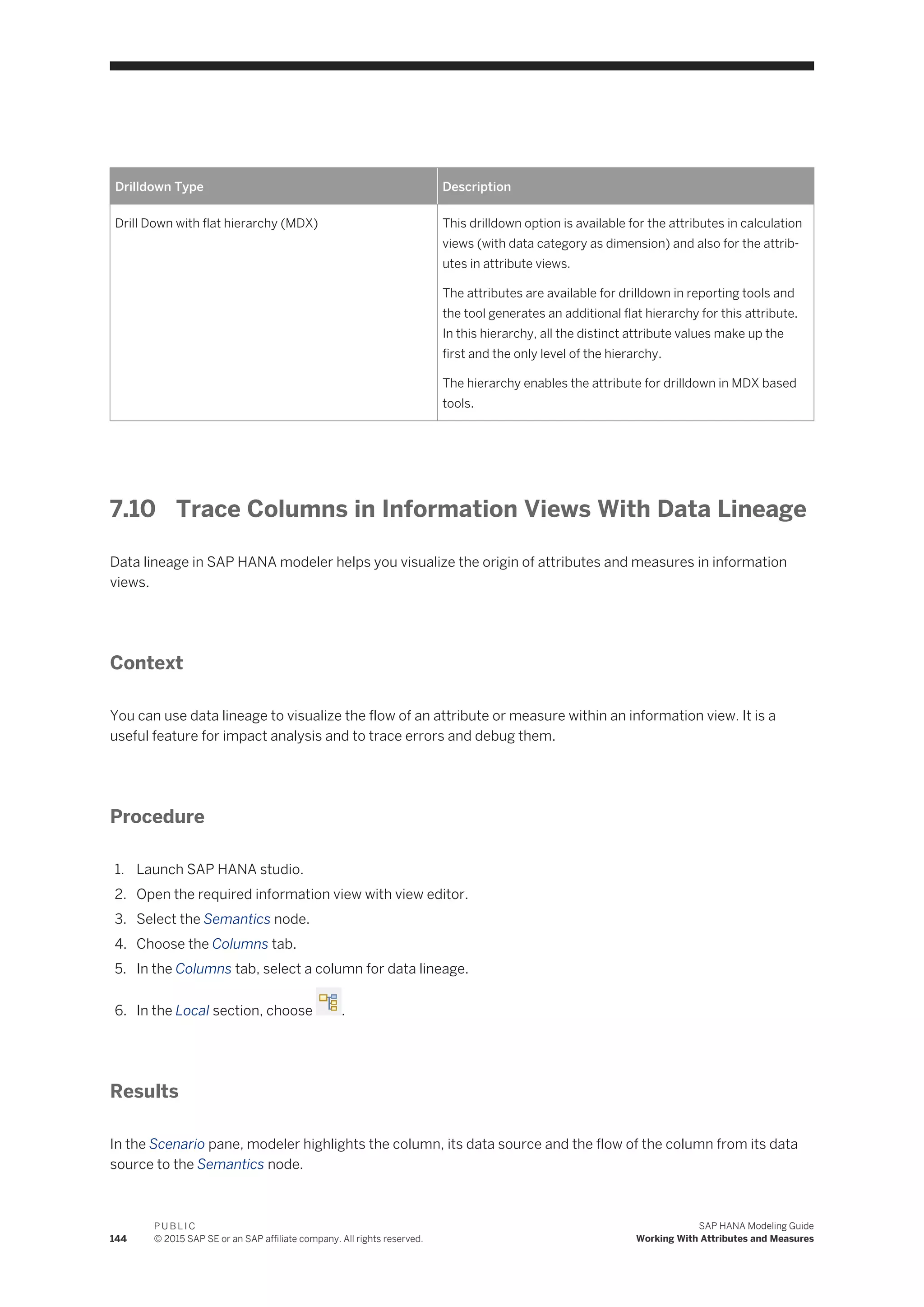
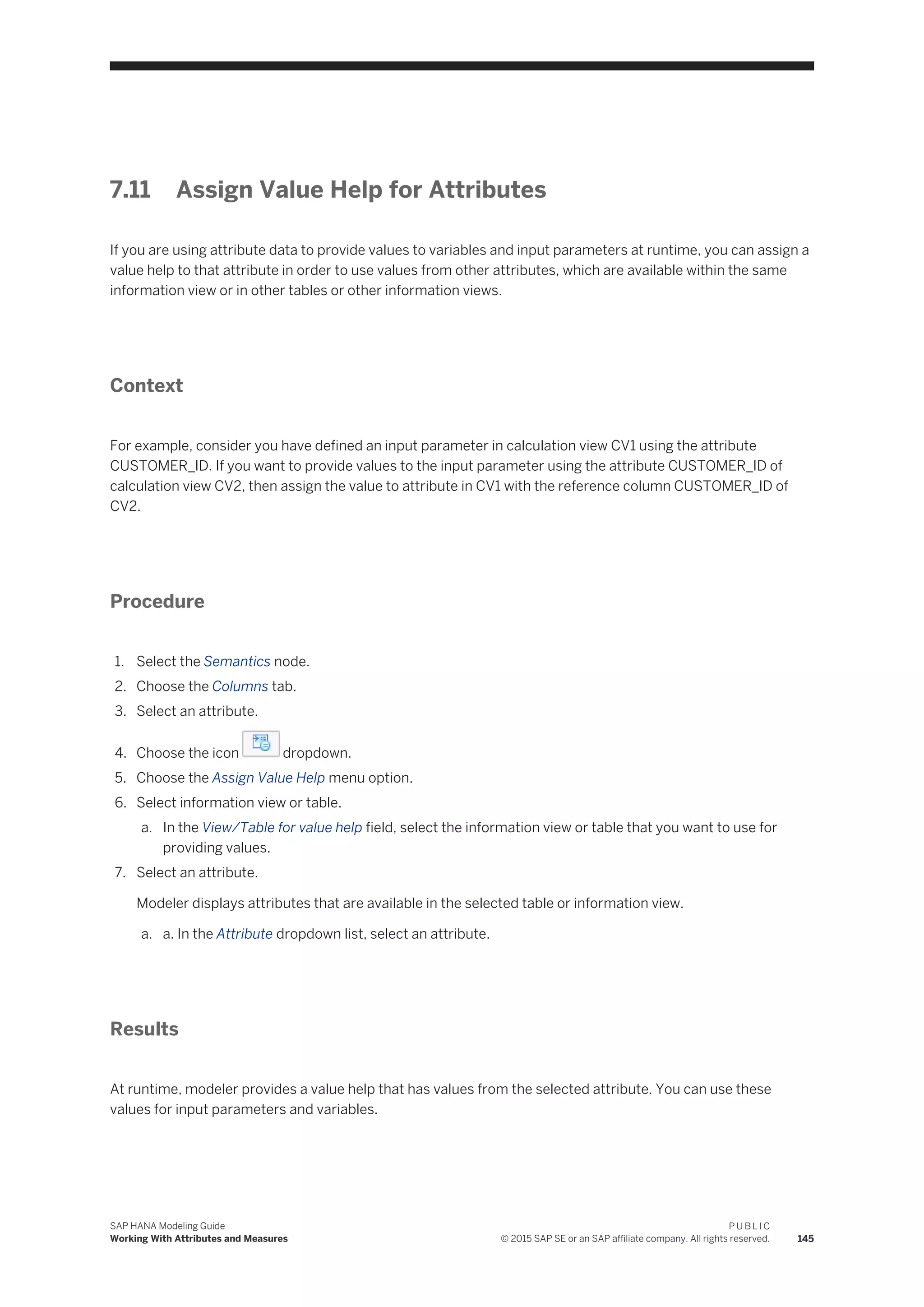
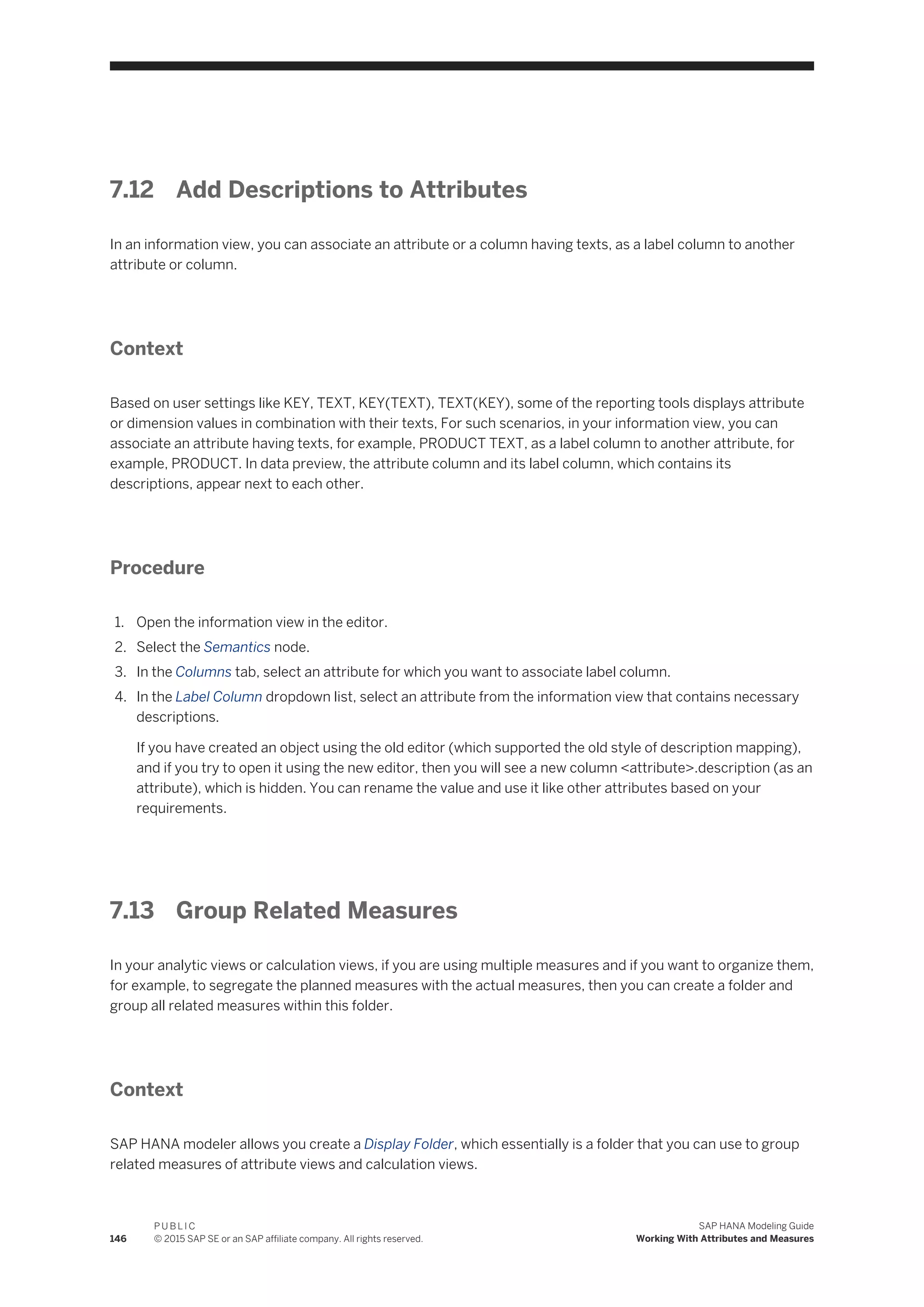

![8 Working With Information View
Properties
SAP HANA modeler allows you to define certain properties for information views. The modeler refers to the
values of these properties, for example, to access the data from the database or identify how to execute the
information view.
This section describe the different calculation view properties, the possible values for each property and how
these values help modeler determine the activation or execution behavior of the information view.
For defining the view properties, select the Semantics node and define the properties in the View Properties
tab.
Related Information
Deprecate Information Views [page 148]
Filter Data for Specific Clients [page 149]
Enable Information Views for Time Travel Queries [page 151]
Invalidate Cached Content [page 152]
Maintain Modeler Object Labels in Multiple Languages [page 153]
Quick Reference: Information View Properties [page 154]
8.1 Deprecate Information Views
Deprecated information views in SAP HANA modeler indicated that although an information view is supported
in SAP HANA modeler, it is not recommended to use it in other information views or in analytic privileges.
Context
As a data modeler, you can deprecate information views view, which you do not recommend for use in other
information views for various reasons based on your business requirement.
Procedure
1. Open the required information view in the view editor.
148
P U B L I C
© 2015 SAP SE or an SAP affiliate company. All rights reserved.
SAP HANA Modeling Guide
Working With Information View Properties](https://image.slidesharecdn.com/51818a91-dee6-4c9b-b633-0deab6e88220-150721193202-lva1-app6892/75/SAP_HANA_Modeling_Guide_for_SAP_HANA_Studio_en-148-2048.jpg)
![2. Select the Semantics node.
3. In the View Properties tab, select the Deprecate checkbox.
Results
Modeler displays a warning for information views or analytic privileges with deprecated information views in
the menu bar of view editor.
8.2 Filter Data for Specific Clients
Filter the view data either using a fixed client value or using a session client set for the user. You can also
specify and obtain data from all clients.
Context
Filtering data based on specific client values is typically applicable to SAP application tables having MANDT or
CLIENT columns within them. In addition, you can apply filters to the table (data source) only if the table
column is according to the following conditions:
● Field name is MANDT or CLIENT.
● Data type is navchar (3).
● It is the first field in the table.
● It is part of primary key for the table.
Procedure
1. Open the information view in the view editor.
2. Select the Semantics node.
3. Choose the View Properties tab.
4. In the Default Client dropdown list, select a value.
Related Information
Assign Default Client [page 150]
Default Client Values [page 150]
SAP HANA Modeling Guide
Working With Information View Properties
P U B L I C
© 2015 SAP SE or an SAP affiliate company. All rights reserved. 149](https://image.slidesharecdn.com/51818a91-dee6-4c9b-b633-0deab6e88220-150721193202-lva1-app6892/75/SAP_HANA_Modeling_Guide_for_SAP_HANA_Studio_en-149-2048.jpg)


![8.4 Invalidate Cached Content
In order to maintain the significance of the cached data for your calculation views, the modeler supports time
based cache invalidation. The system invalidates or removes the data from the cache after specific time
intervals.
Prerequisites
You have enabled caching support for your SAP HANA system.
Context
Time based cache invalidation is necessary to refresh the data after every specific time period. By default, the
cache invalidation period is null. This means that the result of the complex query that you execute resides in
the cache until you execute the next query. Similarly, if you set your cache invalidation period as one hour, the
result of the query resides in the cache for one hour, and system does not clear the cache for all other queries
that you execute until this time period.
Note
Cache invalidation is applicable only to complex SQL queries, which you execute for your calculation views.
Procedure
1. Open required information view in the view editor.
2. Select the Semantics node.
3. Choose the View Properties tab.
4. In the Cache Invalidation Period dropdown list, select the time period after which modeler must invalidate
the cached content.
Related Information
Enable Cache Invalidation [page 153]
152
P U B L I C
© 2015 SAP SE or an SAP affiliate company. All rights reserved.
SAP HANA Modeling Guide
Working With Information View Properties](https://image.slidesharecdn.com/51818a91-dee6-4c9b-b633-0deab6e88220-150721193202-lva1-app6892/75/SAP_HANA_Modeling_Guide_for_SAP_HANA_Studio_en-152-2048.jpg)
![8.4.1 Enable Cache Invalidation
Enable time-based cache invalidation for your SAP HANA system to invalidate or remove data from the cache
after specific time intervals.
Procedure
1. In Systems view, double click your SAP HANA system.
2. Under Configuration tab, navigate to indexserver.ini cache .
3. Set the property resultcache_enabled toyes.
Related Information
Invalidate Cached Content [page 152]
8.5 Maintain Modeler Object Labels in Multiple Languages
SAP HANA modeler supports maintaining object label texts in different languages. For each object label, other
than in the default language text, you can choose additional languages to maintain object labels.
Prerequisites
You have enabled the Translate property for the information view.
1. Open the information view in the view editor.
2. Select the Semantics node.
3. Select the View Properties tab.
4. In the General section, select the Translate checkbox.
Note
If you deselect the checkbox and save you information view, modeler deletes all existing language texts in
repository text tables.
SAP HANA Modeling Guide
Working With Information View Properties
P U B L I C
© 2015 SAP SE or an SAP affiliate company. All rights reserved. 153](https://image.slidesharecdn.com/51818a91-dee6-4c9b-b633-0deab6e88220-150721193202-lva1-app6892/75/SAP_HANA_Modeling_Guide_for_SAP_HANA_Studio_en-153-2048.jpg)
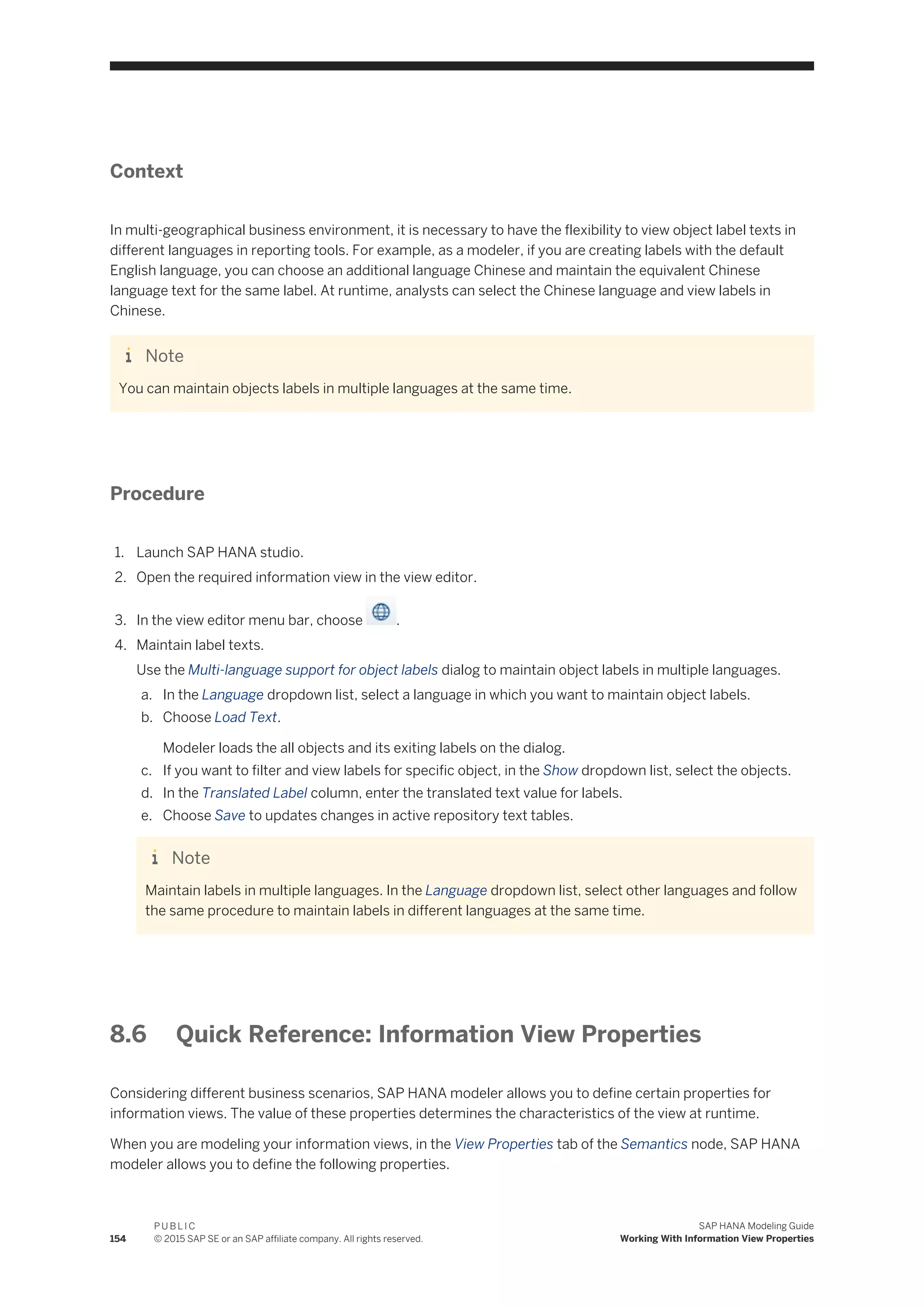
![Graphical Calculation View Properties
Table 59:
Properties Description
Data Category The value of this property determines whether your calculation view supports analysis
with multidimensional reporting. For more information see, Supported Data Categories
for Information Views [page 75].
Default Client The value of this property determines whether modeler must filter data for a fixed client
or a session client or a cross client (does not filter data). For more information, see Filter
Data for Specific Clients [page 149] .
Apply Privileges The value of this property specifies the analytic privilege type selected for data access re
strictions on the calculation view. For more information, see Defining Data Access Privi
leges [page 160].
Default Schema The value of this property helps modeler identify the default schema, which contains the
tables necessary for currency or unit conversions. For more information, see Using Cur
rency and Unit of Measure Conversions [page 136].
Default Member This value of this property helps modeler identify the default member for all hierarchies in
the information views.
Enable History The value of this property determines whether your calculation view supports time travel
queries. For more information see, Enable Information Views for Time Travel Queries
[page 151].
History Input Parameter Input parameter used to specify the timestamp in time travel queries.
Deprecate The value of this property determines whether an information view is recommended for
use in other modeler objects. If the value is set to True, it indicates that although an infor
mation view is supported in SAP HANA modeler, it is not recommended for use. For more
information, Deprecate Information Views [page 148].
Translate The value of this property determines whether SAP HANA modeler must support main
taining object label texts in the information view in multiple languages. For more informa
tion, see Maintain Modeler Object Labels in Multiple Languages [page 153].
Execute In The value of this property impacts the output data. It determines whether modeler must
execute the calculation view in SQL engine or column engine. For more information see
SAP Note 1857202 .
Cache Invalidation Period The value of this property impacts the output data. It determines the time interval to inva
lidate or remove the cached content. For more information, see Invalidate Cached Con
tent [page 152].
SAP HANA Modeling Guide
Working With Information View Properties
P U B L I C
© 2015 SAP SE or an SAP affiliate company. All rights reserved. 155](https://image.slidesharecdn.com/51818a91-dee6-4c9b-b633-0deab6e88220-150721193202-lva1-app6892/75/SAP_HANA_Modeling_Guide_for_SAP_HANA_Studio_en-155-2048.jpg)
![Properties Description
Execution Hints Execution hints impacts the output data. SAP HANA provides different execution hints.
Execution hints are name-value pairs, which helps the optimizer to optimize the execution
process dynamically based on specific criteria. In other words, the hints instruct the opti
mizer on the access paths to execute the calculation view.
Script-based Calculation View Properties
Table 60:
Properties Description
Data Category The value of this property determines whether your calculation view supports analysis
with multidimensional reporting. For script-based calculation views, modeler supports
only data category of type cube or blank. For more information, see Supported Data Cat
egories for Information Views [page 75].
Default Client The value of this property determines whether modeler must filter data for a fixed client
or a session client or a cross client (does not filter data). For more information, see Filter
Data for Specific Clients [page 149].
Apply Privileges The value of this property specifies the analytic privilege type selected for data access
restrictions on the calculation view. For more information, Defining Data Access Privi
leges [page 160].
Default Schema This value of this property helps modeler identify the default schema, which contains the
tables used in the script-based calculation views.
Deprecate The value of this property determines whether an information view is recommended for
use in other modeler objects. If the value is set to True, it signifies that the information
view is supported in SAP HANA modeler, but is not recommended for use. For more in
formation, Deprecate Information Views [page 148].
Translate The value of this property determines whether SAP HANA modeler must support main
taining object label texts in the information view in multiple languages. For more informa
tion, see Maintain Modeler Object Labels in Multiple Languages [page 153].
Enable History The value of this property determines whether your calculation view supports time travel
queries. For more information see, Enable Information Views for Time Travel Queries
[page 151].
History Input Parameter Input parameter used to specify the timestamp in time travel queries.
156
P U B L I C
© 2015 SAP SE or an SAP affiliate company. All rights reserved.
SAP HANA Modeling Guide
Working With Information View Properties](https://image.slidesharecdn.com/51818a91-dee6-4c9b-b633-0deab6e88220-150721193202-lva1-app6892/75/SAP_HANA_Modeling_Guide_for_SAP_HANA_Studio_en-156-2048.jpg)
![Properties Description
Run With The value of this property helps modeler identify the authorization to use while selecting
the data from the database and for executing the calculation view or procedure. If the
property is set to Definer’s rights, then modeler uses the authorizations of the user who
defines the view or procedure. Similarly, if the property is set to Invoker’s right, then
modeler uses the authorizations of the current user to access data from the database.
Cache Invalidation Period The value of this property impacts the output data. It determines the time interval to in
validate or remove the cached content. For more information, see Invalidate Cached
Content [page 152].
Analytic View Properties
Table 61:
Properties Description
Data Category The value of this property determines whether your information view supports analysis
with multidimensional reporting. For analytic views, modeler supports only data cate
gory of type cube or blank. For more information, see Supported Data Categories for In
formation Views [page 75].
Default Client The value of this property determines whether modeler must filter data for a fixed client
or a session client or a cross client (does not filter data). For more information, see Filter
Data for Specific Clients [page 149].
Apply Privileges The value of this property specifies the analytic privilege type selected for data access
restrictions on the information view. For more information, Defining Data Access Privi
leges [page 160].
Default Schema The value of this property helps modeler identify the default schema used for currency
or unit conversions. For more information, see Using Currency and Unit of Measure Con
versions [page 136].
Deprecate The value of this property determines whether an information view is recommended for
use in other modeler objects. If the value is set to True, it signifies that the information
view is supported in SAP HANA modeler, but is not recommended for use. For more in
formation, Deprecate Information Views [page 148].
Translate The value of this property determines whether SAP HANA modeler must support main
taining object label texts in the information view in multiple languages. For more infor
mation, see Maintain Modeler Object Labels in Multiple Languages [page 153].
Enable History The value of this property determines whether your information view supports time
travel queries. For more information see, Enable Information Views for Time Travel
Queries [page 151].
SAP HANA Modeling Guide
Working With Information View Properties
P U B L I C
© 2015 SAP SE or an SAP affiliate company. All rights reserved. 157](https://image.slidesharecdn.com/51818a91-dee6-4c9b-b633-0deab6e88220-150721193202-lva1-app6892/75/SAP_HANA_Modeling_Guide_for_SAP_HANA_Studio_en-157-2048.jpg)
![Properties Description
History Input Parameter Input parameter used to specify the timestamp in time travel queries.
Cache Invalidation Period The value of this property impacts the output data. It determines the time interval to in
validate or remove the cached content. For more information, see Invalidate Cached
Content [page 152].
Allow Relational Optimization The value of this property determines whether the engine must perform relation query
optimizations. If set to True, engine performs relation optimizations. For example, opti
mize stacked SQL’s. This property can impact the results of counters and SELECT
COUNT queries.
Generate Concat Attributes The value of this property determines whether modeler must generate additional concat
attribute to improve the performance of multiple column joins. If set to True, then mod
eler generates additional concat attributes for those columns involved in the multiple
column joins of physical tables.
Attribute View Properties
Table 62:
Properties Description
Data Category The value of this property determines whether your information view supports analysis
with multidimensional reporting. For attribute views, modeler supports only data cate
gory of type dimension only. For more information, see Supported Data Categories for
Information Views [page 75].
Default Client The value of this property determines whether modeler must filter data for a fixed client
or a session client or a cross client (does not filter data). For more information, see Fil
ter Data for Specific Clients [page 149].
Type The value of this property specifies the attribute view type.
Base Attribute View The value of this property specifies the base attribute view used in the derived attribute
view type.
Apply Privileges The value of this property specifies the analytic privilege type selected for data access
restrictions on the information view. For more information, Defining Data Access Privi
leges [page 160].
Default Member This value of this property helps modeler identify the default member for all hierarchies
in the information views.
158
P U B L I C
© 2015 SAP SE or an SAP affiliate company. All rights reserved.
SAP HANA Modeling Guide
Working With Information View Properties](https://image.slidesharecdn.com/51818a91-dee6-4c9b-b633-0deab6e88220-150721193202-lva1-app6892/75/SAP_HANA_Modeling_Guide_for_SAP_HANA_Studio_en-158-2048.jpg)
![Properties Description
Deprecate The value of this property determines whether an information view is recommended for
use in other modeler objects. If the value is set to True, it signifies that the information
view is supported in SAP HANA modeler, but is not recommended for use. For more in
formation, Deprecate Information Views [page 148].
Translate The value of this property determines whether SAP HANA modeler must support main
taining object label texts in the information view in multiple languages. For more infor
mation, see Maintain Modeler Object Labels in Multiple Languages [page 153].
Enable History The value of this property determines whether your information view supports time
travel queries. For more information see, Enable Information Views for Time Travel
Queries [page 151].
History Input Parameter Input parameter used to specify the timestamp in time travel queries.
Cache Invalidation Period The value of this property impacts the output data. It determines the time interval to
invalidate or remove the cached content. For more information, see Invalidate Cached
Content [page 152].
Generate Concat Attributes The value of this property determines whether modeler must generate additional con
cat attribute to improve the performance of multiple column joins. If set to True, then
modeler generates additional concat attributes for those columns involved in the multi
ple column joins of physical tables.
SAP HANA Modeling Guide
Working With Information View Properties
P U B L I C
© 2015 SAP SE or an SAP affiliate company. All rights reserved. 159](https://image.slidesharecdn.com/51818a91-dee6-4c9b-b633-0deab6e88220-150721193202-lva1-app6892/75/SAP_HANA_Modeling_Guide_for_SAP_HANA_Studio_en-159-2048.jpg)

![Feature SQL-Based Analytic Privi
leges
Classical XML-Based Ana
lytic Privileges
Design-time modeling in the Editor tool of the SAP HANA
Web Workbench
Yes Yes
Design-time modeling in the SAP HANA Modeler perspective
of the SAP HANA studio
Yes Yes
Transportable Yes Yes
Complex filtering Yes No
Enabling an Authorization Check Based on Analytic Privileges
All column views modeled and activated in the SAP HANA modeler and the SAP HANA Web-based
Development Workbench automatically enforce an authorization check based on analytic privileges. XML-
based analytic privileges are selected by default, but you can switch to SQL-based analytic privileges.
Column views created using SQL must be explicitly registered for such a check by passing the relevant
parameter:
● REGISTERVIEWFORAPCHECK for a check based on XML-based analytic privileges
● STRUCTURED PRIVILEGE CHECK for a check based on SQL-based analytic privileges
SQL views must always be explicitly registered for an authorization check based analytic privileges by passing
the STRUCTURED PRIVILEGE CHECK parameter.
Note
It is not possible to enforce an authorization check on the same view using both XML-based and SQL-based
analytic privileges. However, it is possible to build views with different authorization checks on each other.
Related Information
Create Classical XML-based Analytic Privileges [page 162]
Create SQL Analytic Privileges [page 178]
SAP HANA Modeling Guide
Defining Data Access Privileges
P U B L I C
© 2015 SAP SE or an SAP affiliate company. All rights reserved. 161](https://image.slidesharecdn.com/51818a91-dee6-4c9b-b633-0deab6e88220-150721193202-lva1-app6892/75/SAP_HANA_Modeling_Guide_for_SAP_HANA_Studio_en-161-2048.jpg)


![Related Information
Analytic Privileges [page 164]
Structure of Analytic Privileges [page 165]
Example: Using Analytic Privileges [page 174]
Example: Create an XML-Based Analytic Privilege with Dynamic Value Filter [page 176]
Supported Restriction Types in Analytic Privileges [page 178]
9.1.1 Analytic Privileges
Analytic privileges are intended to control read-only access to SAP HANA information models (attribute views,
analytic views, calculation views
The attribute restriction of an analytic privilege specifies the value range that the user is permitted to access
using value filters. In addition to static scalar values, stored procedures can be used to define filters. This
allows user-specific filter conditions to be determined dynamically in runtime, for example, by querying
specified tables or views. As a result, the same analytic privilege can be applied to many users, while the filter
values for authorization can be updated and changed independently in the relevant database tables.
After activation, an analytic privilege needs to be assigned to a user before taking any effect. The user views
the filtered data based on the restrictions defined in the analytic privilege. If no analytic privilege applicable for
models is assigned to a user, he or she cannot access the model. If a user is assigned to multiple analytic
privileges, the privileges are combined with OR conditions.
Remember
In addition to the analytic privileges, a user needs SQL Select privileges on the generated column views.
The generated column views adhere to the following naming conventions:
For a view “MyView” in package “p1.p2” (that is, subpackage p2 of package p1), the generated column view lies
in the deployment schema. Ensure that the users who are allowed to see the view have select privileges on the
view (or the entire deployment schema).
Note
Multiple restrictions applied on the same column are combined by OR. However, restrictions across several
columns are always combined by AND.
164
P U B L I C
© 2015 SAP SE or an SAP affiliate company. All rights reserved.
SAP HANA Modeling Guide
Defining Data Access Privileges](https://image.slidesharecdn.com/51818a91-dee6-4c9b-b633-0deab6e88220-150721193202-lva1-app6892/75/SAP_HANA_Modeling_Guide_for_SAP_HANA_Studio_en-164-2048.jpg)
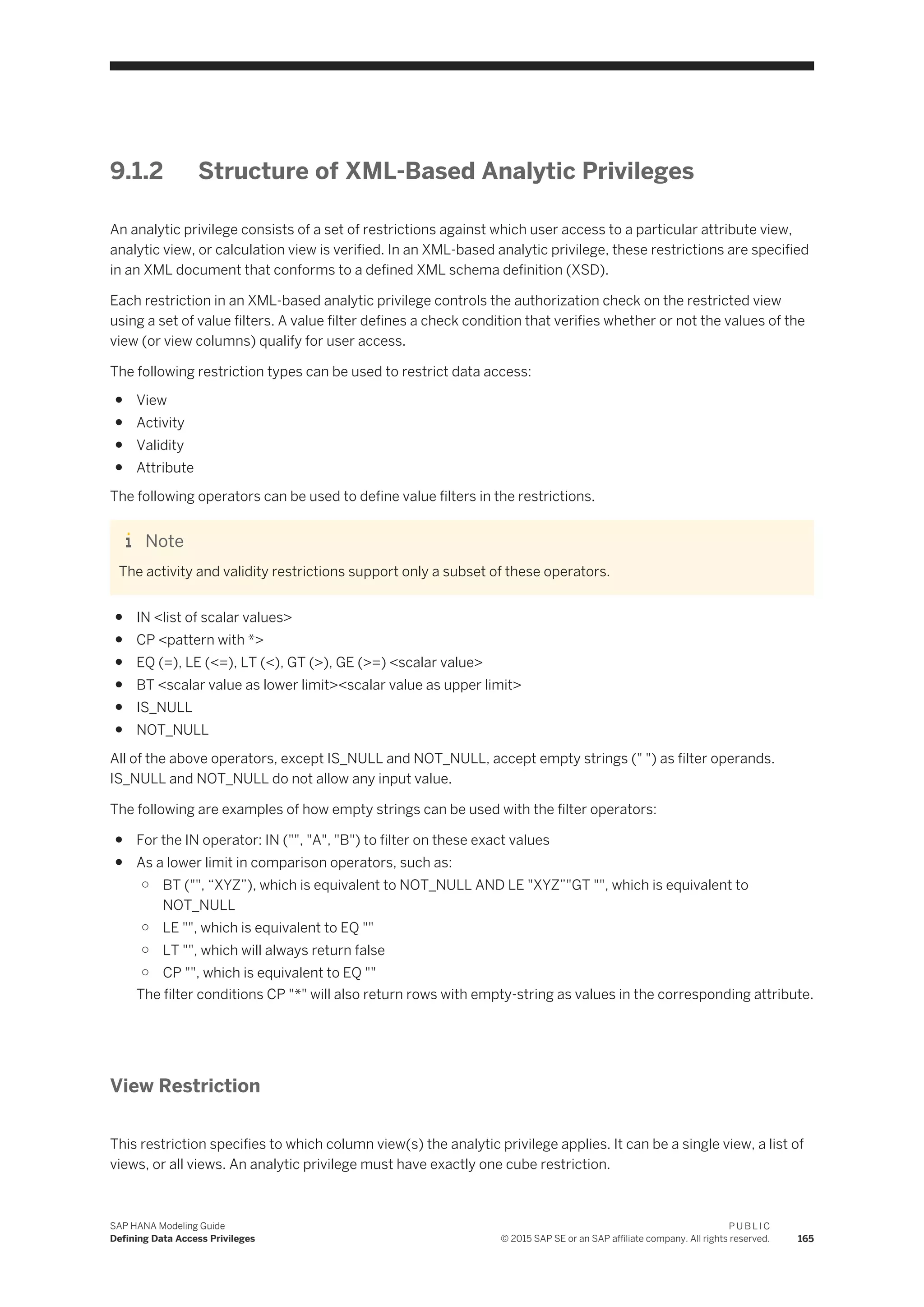


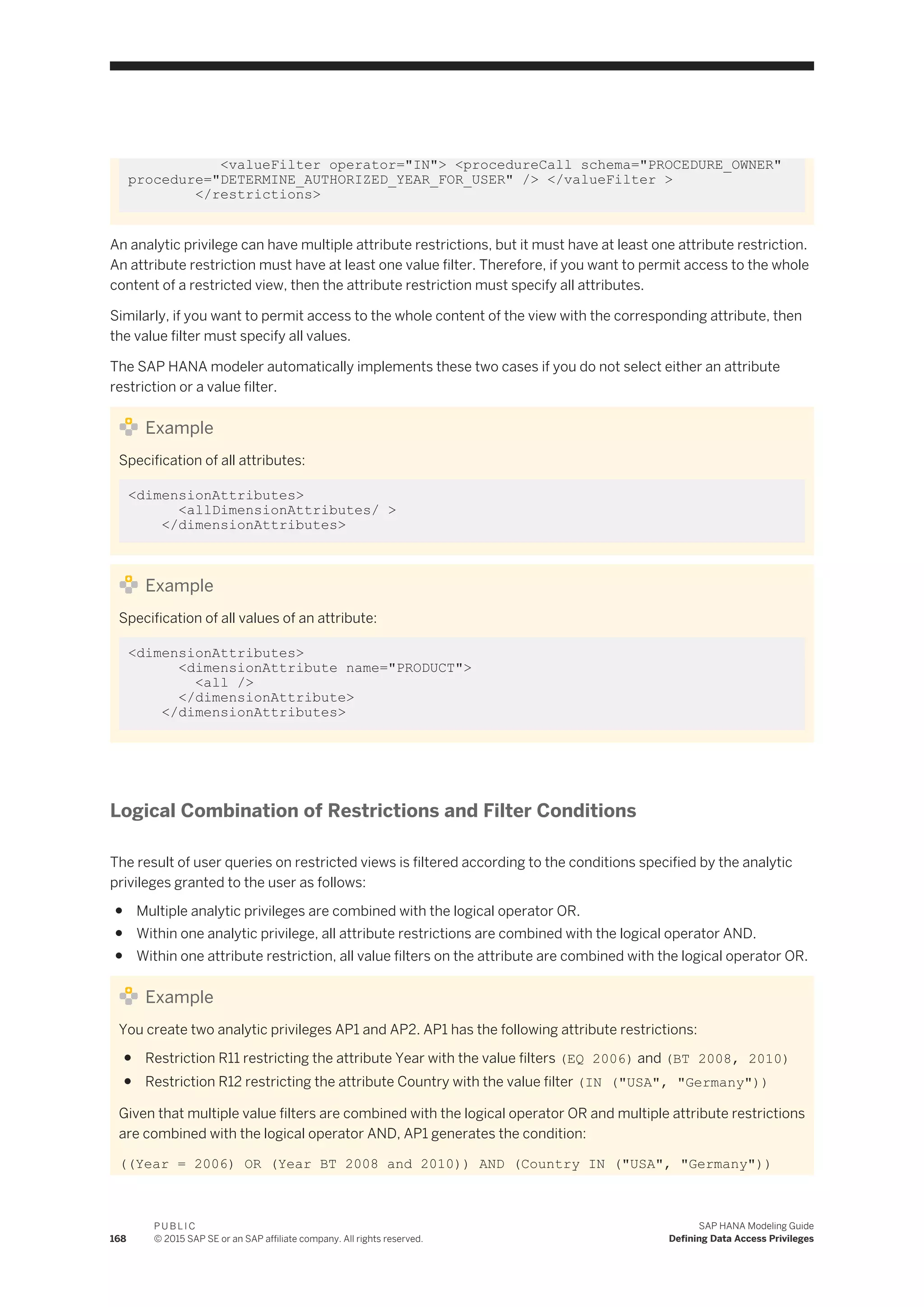

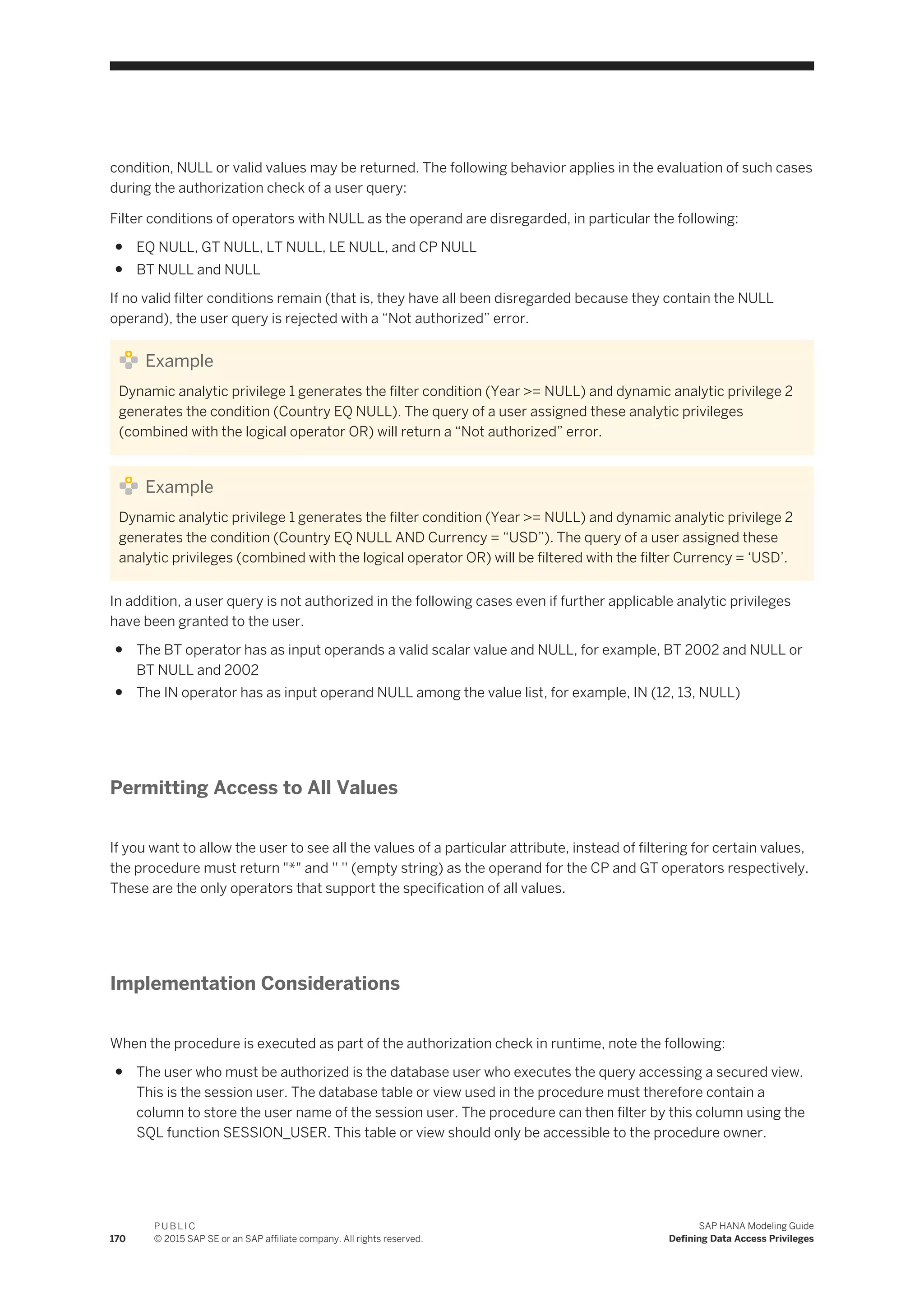
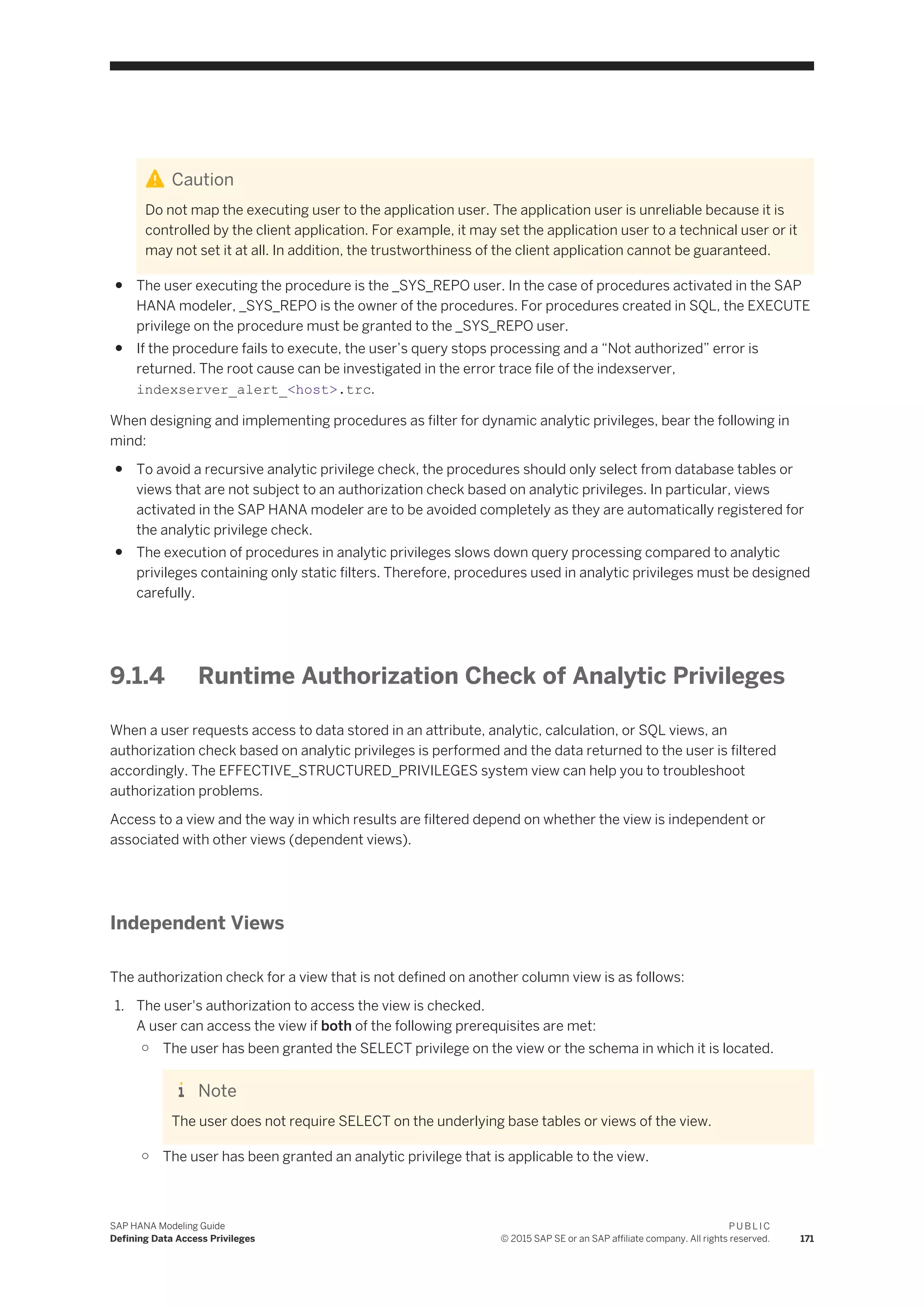
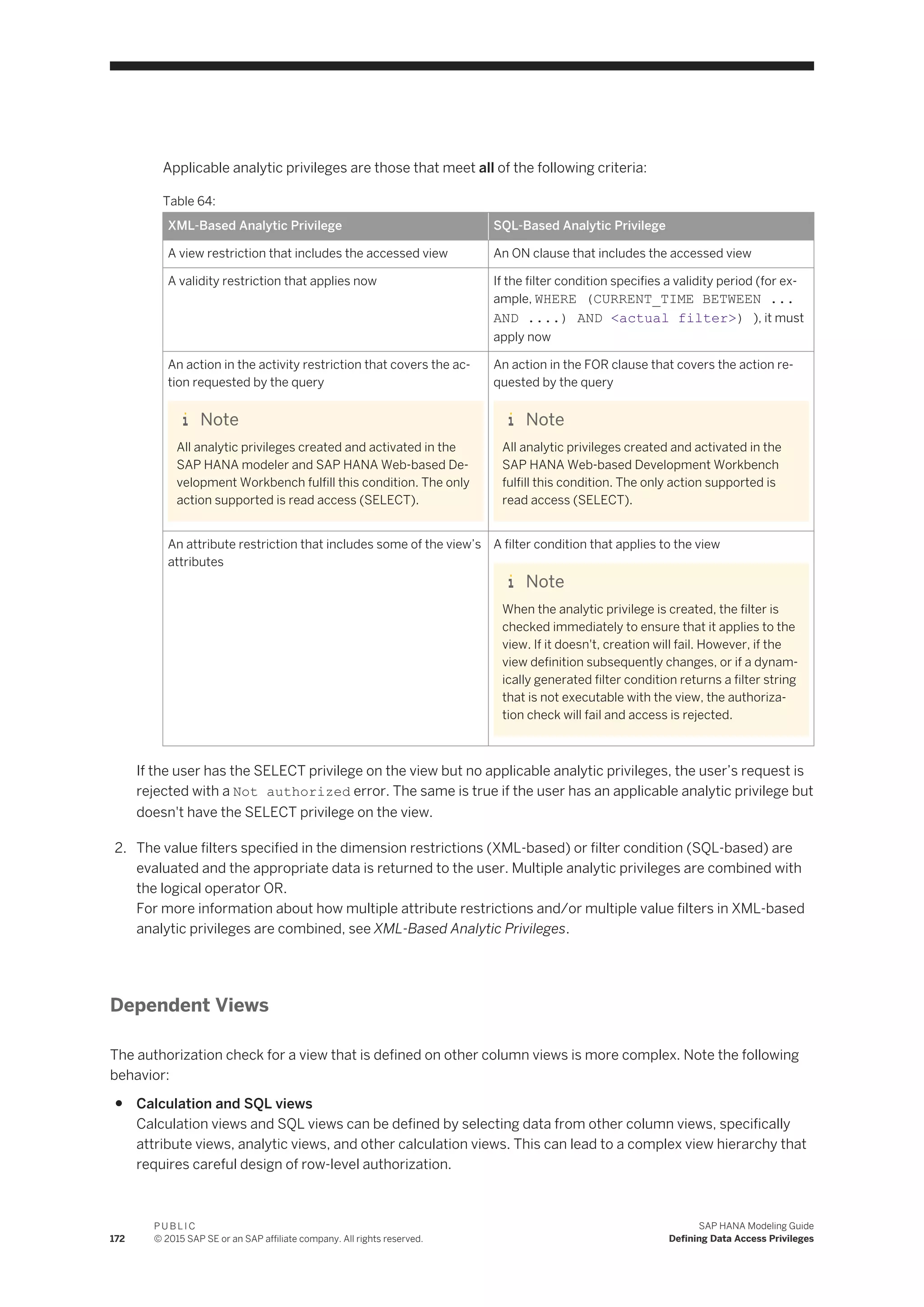
![If a user requests access to a calculation view that is dependent on another view, the behavior of the
authorization check and result filtering is performed as follows:
A user can access a calculation or SQL view based on other view(s) if both of the following prerequisites
are met:
○ The user has been granted the SELECT privilege on the view or the schema that contains the view.
○ The user has been granted analytic privileges that apply to the view itself and all the other column
views in the hierarchy that are registered for a structured privilege check.
Result filtering on the view is then performed as follows:
○ Individual views in the hierarchy are filtered according to their respective analytic privileges, which use
the logical OR combination.
○ The filtered result of the calculation view is derived from the filtered result of its underlying views. This
corresponds to a logic AND combination of the filters generated by the analytic privileges for the
individual views.
● Analytic views
If an analytic view designed in the SAP HANA modeler contains one of the elements listed below, it will
automatically be activated with a calculation view on top. The name of this calculation view is the name of
the analytic view with the suffix /olap.
○ Currency or unit conversions
○ Calculated attributes
○ Calculated measures that use attributes, calculated attributes, or input parameters in their formulas
This represents a view hierarchy for which the prerequisites described above for calculation views also
apply.
An analytic view can also be defined on attribute views, but this does not represent a view dependency or
hierarchy with respect to authorization check and result filtering. If you reference an attribute view in an
analytic view, analytic privileges defined on the attribute view are not applied.
Troubleshooting Failed Authorization
Using the EFFECTIVE_STRUCTURED_PRIVILEGES system view, you can quickly see:
● Which analytic privileges apply to a particular view, including the dynamic filter conditions that apply (if
relevant)
● Which filter is being applied to which view in the view hierarchy (for views with dependencies)
● Whether or not a particular user is authorized to access the view
Query EFFECTIVE_STRUCTURED_PRIVILEGES as follows:
SELECT * from "PUBLIC"."EFFECTIVE_STRUCTURED_PRIVILEGES" where ROOT_SCHEMA_NAME
= '<schema>' AND ROOT_OBJECT_NAME = '<OBJECT>' AND USER_NAME = '<USER>'
Related Information
Structure of XML-Based Analytic Privileges [page 165]
SAP HANA SQL and System Views Reference
SAP HANA Modeling Guide
Defining Data Access Privileges
P U B L I C
© 2015 SAP SE or an SAP affiliate company. All rights reserved. 173](https://image.slidesharecdn.com/51818a91-dee6-4c9b-b633-0deab6e88220-150721193202-lva1-app6892/75/SAP_HANA_Modeling_Guide_for_SAP_HANA_Studio_en-173-2048.jpg)


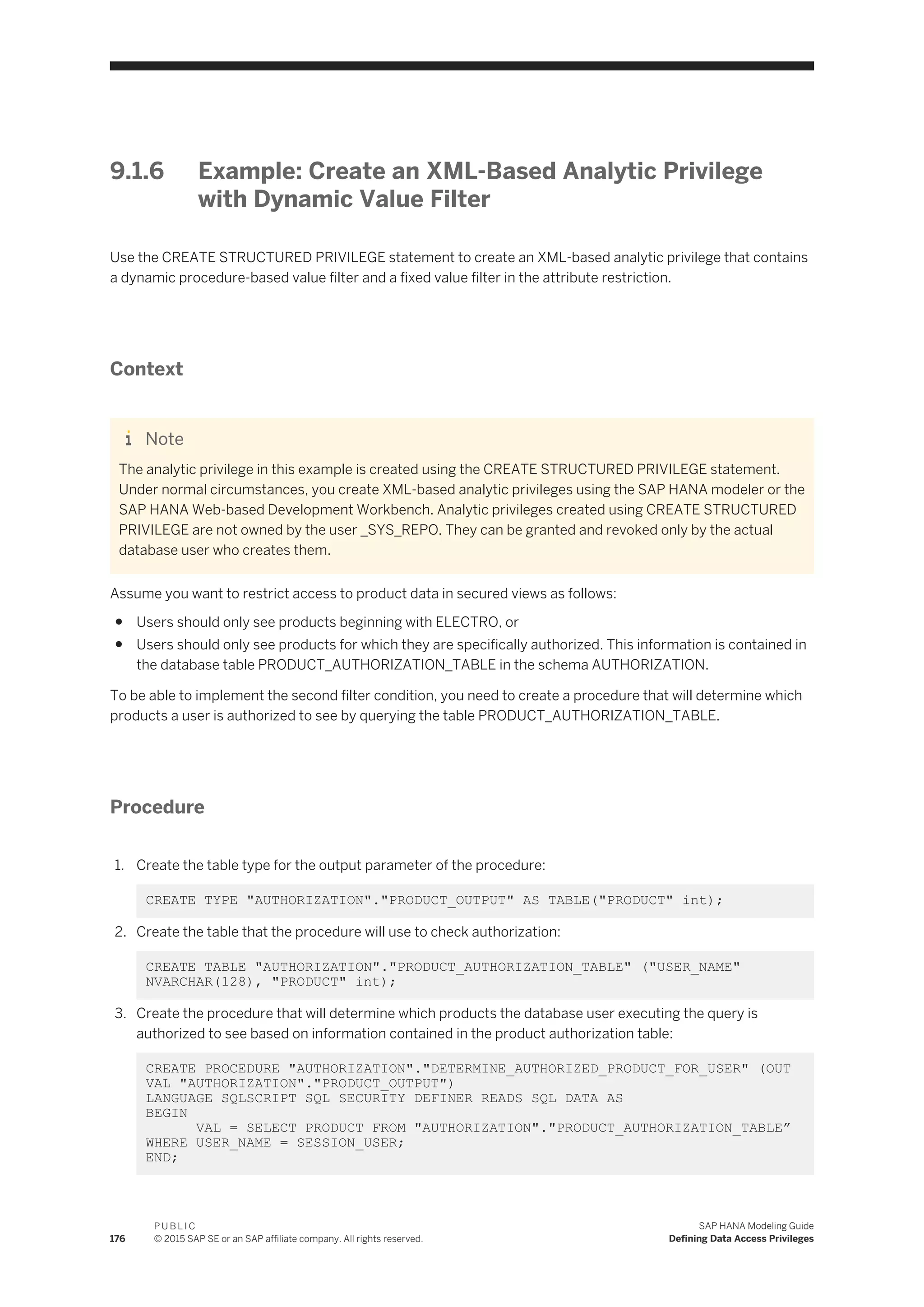


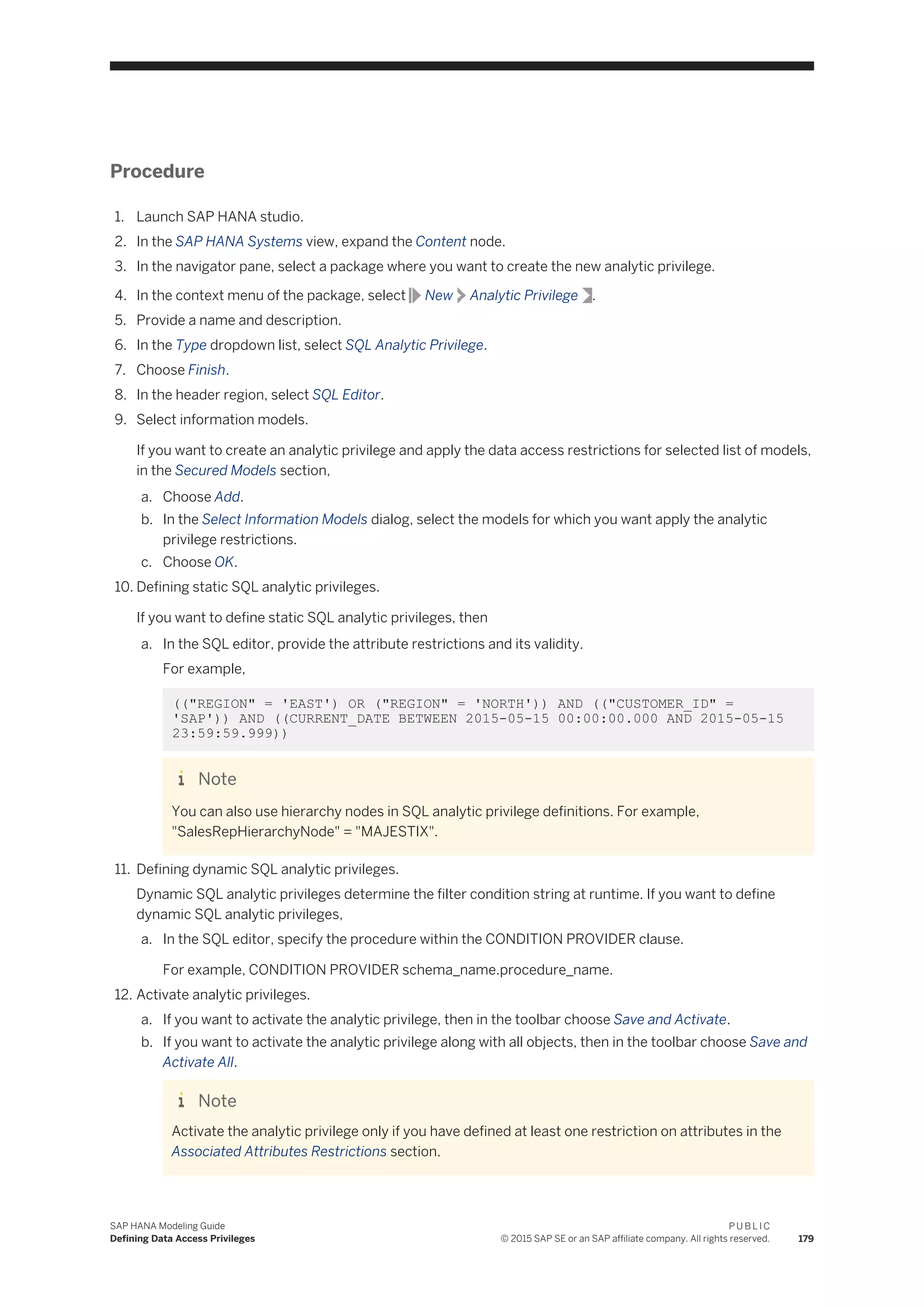
![13. Assign privileges to a user.
If you want to assign privileges to an authorization role, then in your SAP HANA studio, execute the
following steps:
a. In the SAP HANA Systems view, go to Security Authorizations Users .
b. Select a user.
c. In the context menu, choose Open.
d. In the Analytic Privileges tab page, add the privilege.
e. In the editor toolbar, choose Deploy.
Related Information
Static SQL Analytic Privileges [page 180]
Dynamic SQL Analytic Privileges [page 180]
Structure of SQL-Based Analytic Privileges [page 181]
Examples: Securing Views Using SQL-Based Analytic Privileges [page 183]
9.2.1 Static SQL Analytic Privileges
Static SQL analytic privileges or fixed analytic privileges allows you to combine one or multiple filter conditions
on the same attribute or different attributes using the logical AND or OR operators.
Static SQL analytic privileges conditions typically have the following structure, <attribute> <operator>
<scalar_operands_or_subquery>. For example, "country IN (scalar_operands_or_subquery) AND product =
(scalar_operands_or_subquery)." The supported operator types are IN, LIKE, BETWEEN, <=, >=, <, >.
If you want to create static SQL analytic privileges using subqueries, then the user creating the analytic
privileges must have corresponding privileges on the database objects (tables/views) involved in the
subqueries.
9.2.2 Dynamic SQL Analytic Privileges
In dynamic analytic privileges, you use a database procedure to dynamically obtain the filter condition string at
runtime. You can provide the database procedure value within the CONDITION PROVIDER clause.
You can use only procedures, which achieve the following conditions to define dynamic SQL analytic privileges.
● DEFINER procedures.
● Read-only procedures.
● Procedure with no input parameters
● Procedure with only one output parameter of type VARCHAR or NVARCHAR for the filter condition string.
● Procedures executable by _SYS_REPO. This means that, _SYS_REPO is either the owner of the procedure
or the owner of the procedure has all privileges on the underlying tables/views with GRANT OPTION and
has granted the EXECUTE privilege on the procedure to the _SYS_REPO user.
180
P U B L I C
© 2015 SAP SE or an SAP affiliate company. All rights reserved.
SAP HANA Modeling Guide
Defining Data Access Privileges](https://image.slidesharecdn.com/51818a91-dee6-4c9b-b633-0deab6e88220-150721193202-lva1-app6892/75/SAP_HANA_Modeling_Guide_for_SAP_HANA_Studio_en-180-2048.jpg)
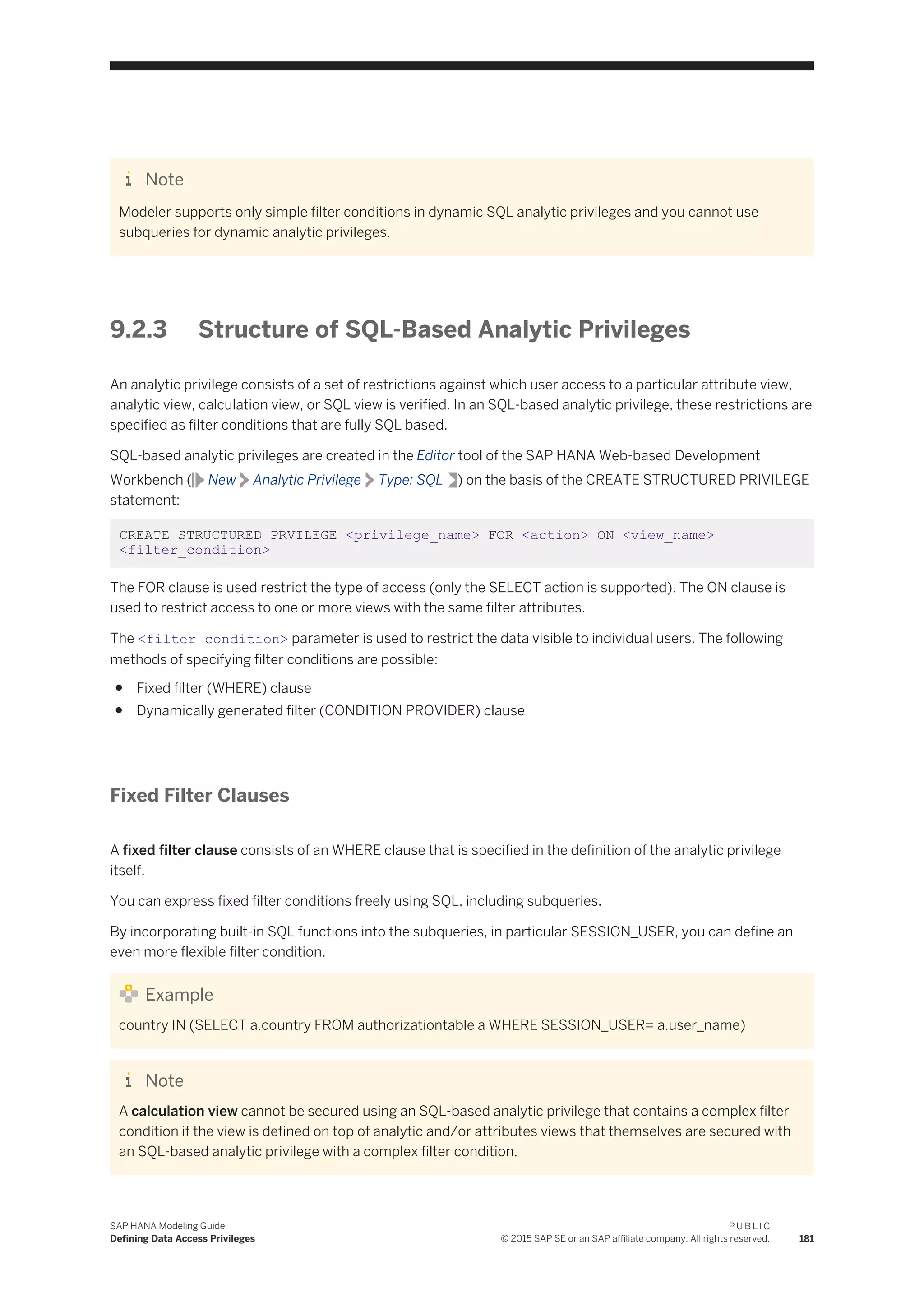
![Remember
If you use a subquery, you (the creating user) must have the required privileges on the database objects
(tables and views) involved in the subquery.
Comparative conditions can be nested and combined using AND and OR (with corresponding brackets).
For examples, see Examples: Securing Views Using SQL-Based Analytic Privileges.
Dynamically Generated Filter Clauses
With a dynamically generated filter clause, the WHERE clause that specifies the filter condition is generated
every time the analytic privilege is evaluated. This is useful in an environment in which the filter clause changes
very dynamically. The filter condition is determined by a procedure specified in the CONDITION PROVIDER
clause, for example:
Sample Code
CREATE STRUCTURED PRVILEGE dynamic_ap FOR SELECT ON schema1.v1 CONDITION PROVIDER
schema2.procedure1;
Procedures in the CONDITION PROVIDER clause must have the following properties:
● They must have the security mode DEFINER.
● They must be read-only procedures.
● They must have a predefined signature. Here, the following conditions apply:
○ No input parameter
○ Only one output parameter for the filter condition string
● The procedure may only return conditions expressed with the following operators:
○ =, <=, <, >, >=
○ LIKE
○ BETWEEN
○ IN
A complex filter condition, that is a subquery, may not be returned.
● The procedure must be executable by _SYS_REPO, that is, either_SYS_REPO must be the owner of the
procedure or the owner of the procedure has all privileges on the underlying tables/views with GRANT
OPTION and has granted the EXECUTE privilege on the procedure to the _SYS_REPO user.
If errors occur in procedure execution, the user receives a Not authorized error, even if he has the analytic
privileges that would grant access.
For examples, see Examples: Securing Views Using SQL-Based Analytic Privileges.
Related Information
Examples: Securing Views Using SQL-Based Analytic Privileges [page 183]
182
P U B L I C
© 2015 SAP SE or an SAP affiliate company. All rights reserved.
SAP HANA Modeling Guide
Defining Data Access Privileges](https://image.slidesharecdn.com/51818a91-dee6-4c9b-b633-0deab6e88220-150721193202-lva1-app6892/75/SAP_HANA_Modeling_Guide_for_SAP_HANA_Studio_en-182-2048.jpg)
![SAP HANA SQL and System Views Reference
9.2.4 Examples: Securing Views Using SQL-Based Analytic
Privileges
Use the CREATE STRUCTURED PRIVILEGE statement to create SQL-based analytic privileges for different
scenarios.
Context
The examples provided here take you through the following scenarios:
● Example 1: Securing a column view using an SQL-based analytic privilege with a fixed filter clause [page
183]
● Example 2: Securing an SQL view using an SQL-based analytic privilege with a complex filter clause
(subquery) [page 185]
● Example 3: Securing a column view using an SQL-based analytic privilege with a dynamically generated
filter clause [page 187]
Note
The analytic privileges in these example are created using the CREATE STRUCTURED PRIVILEGE
statement. Under normal circumstances, you create SQL-based analytic privileges using the SAP HANA
Web-based Development Workbench. Analytic privileges created using CREATE STRUCTURED PRIVILEGE
are not owned by the user _SYS_REPO. They can be granted and revoked only by the actual database user
who creates them.
Example 1: Secure a Column View Using an SQL-Based
Analytic Privilege with a Fixed Filter Clause
Prerequisites
The database user TABLEOWNER has set up a calculation scenario based on the table SALES_TABLE, which
contains the data to be protected.
SAP HANA Modeling Guide
Defining Data Access Privileges
P U B L I C
© 2015 SAP SE or an SAP affiliate company. All rights reserved. 183](https://image.slidesharecdn.com/51818a91-dee6-4c9b-b633-0deab6e88220-150721193202-lva1-app6892/75/SAP_HANA_Modeling_Guide_for_SAP_HANA_Studio_en-183-2048.jpg)
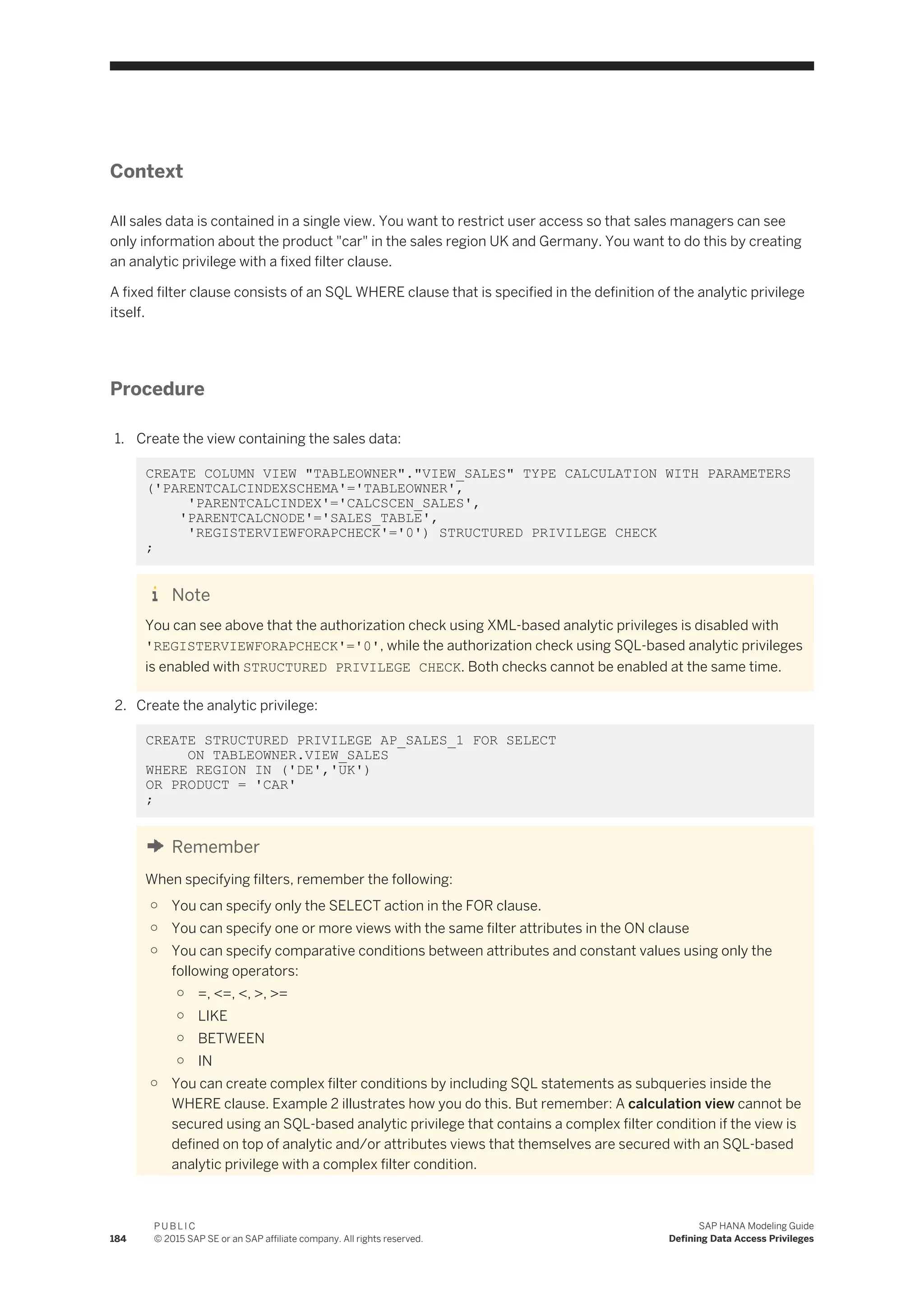
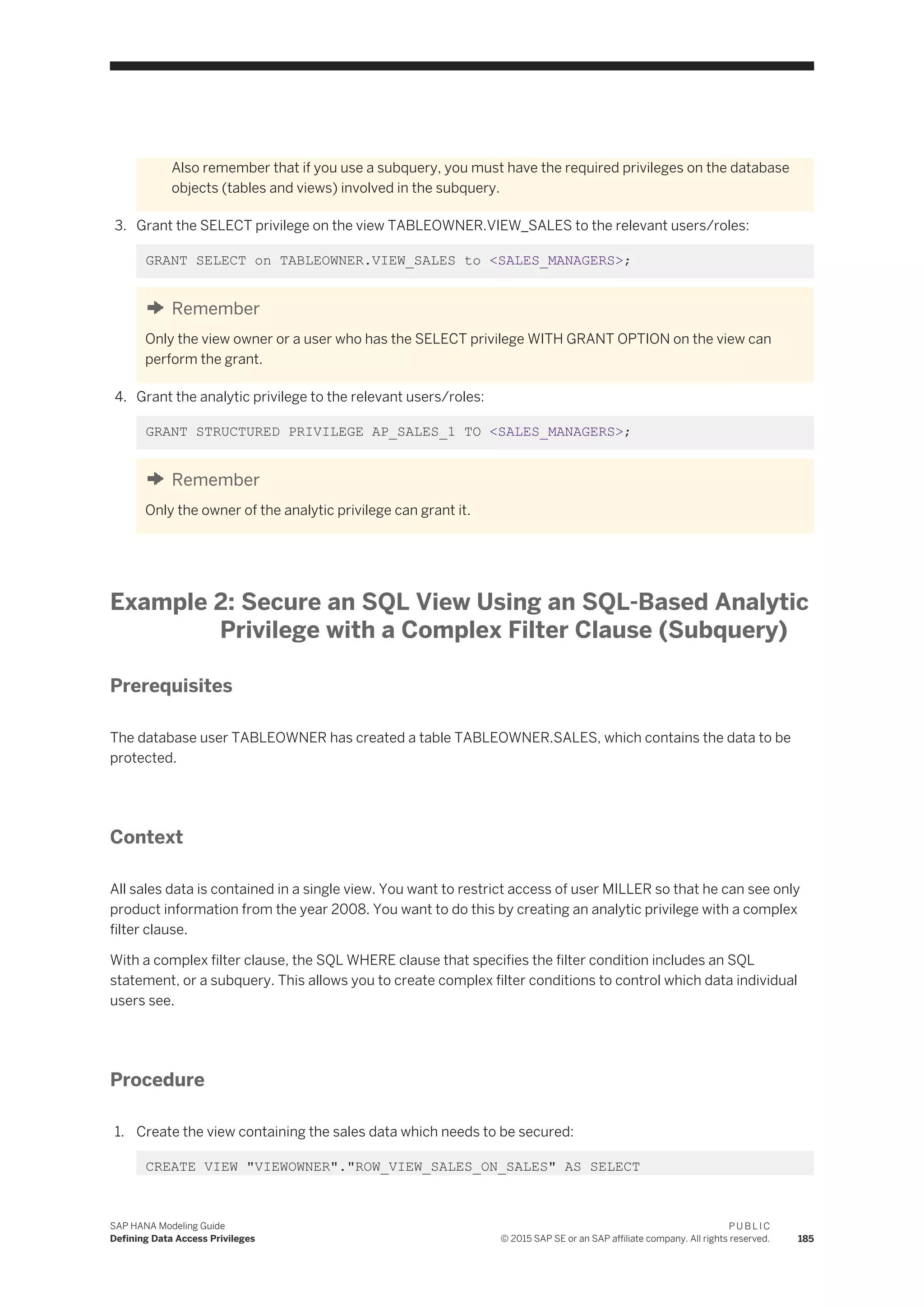
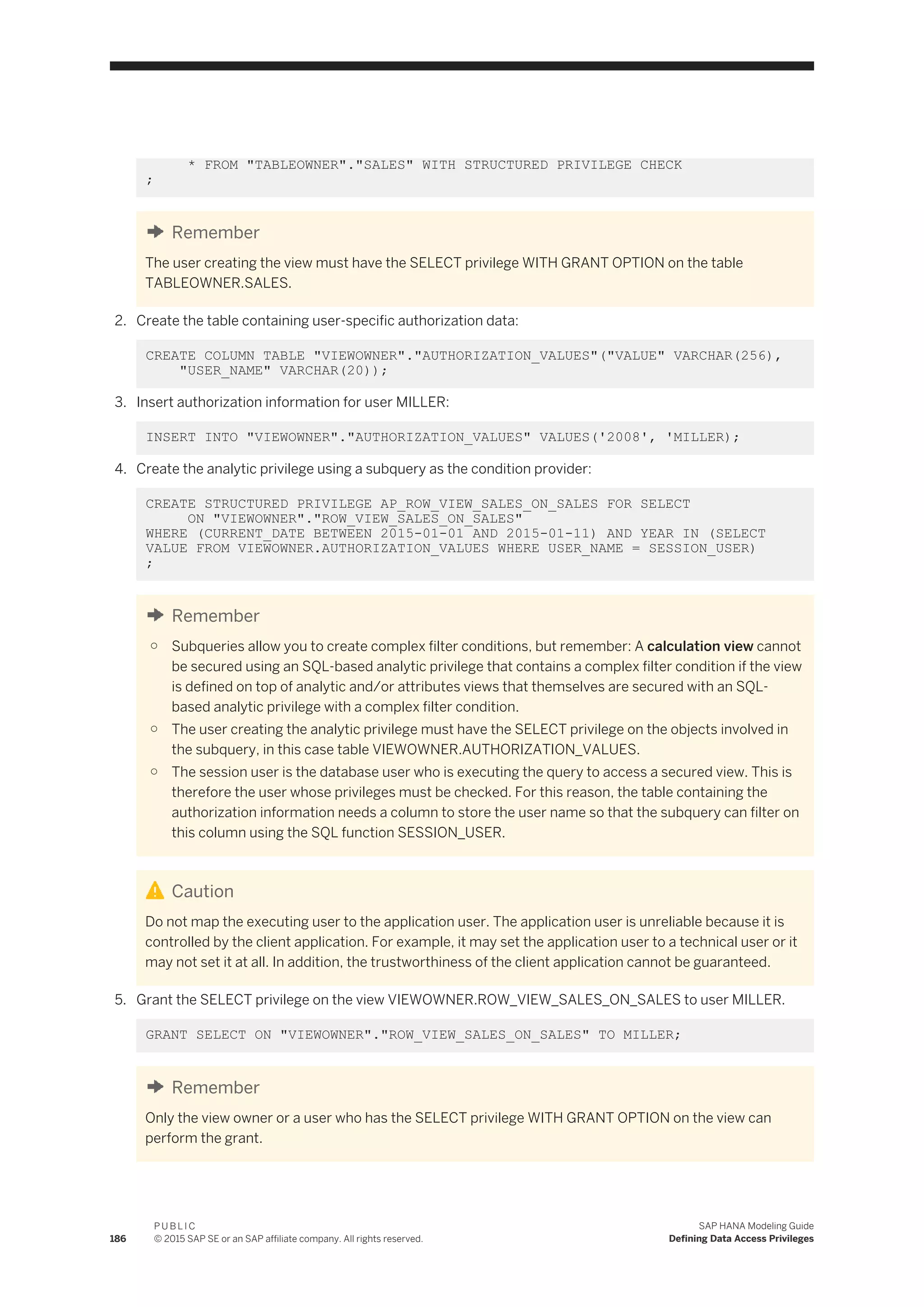
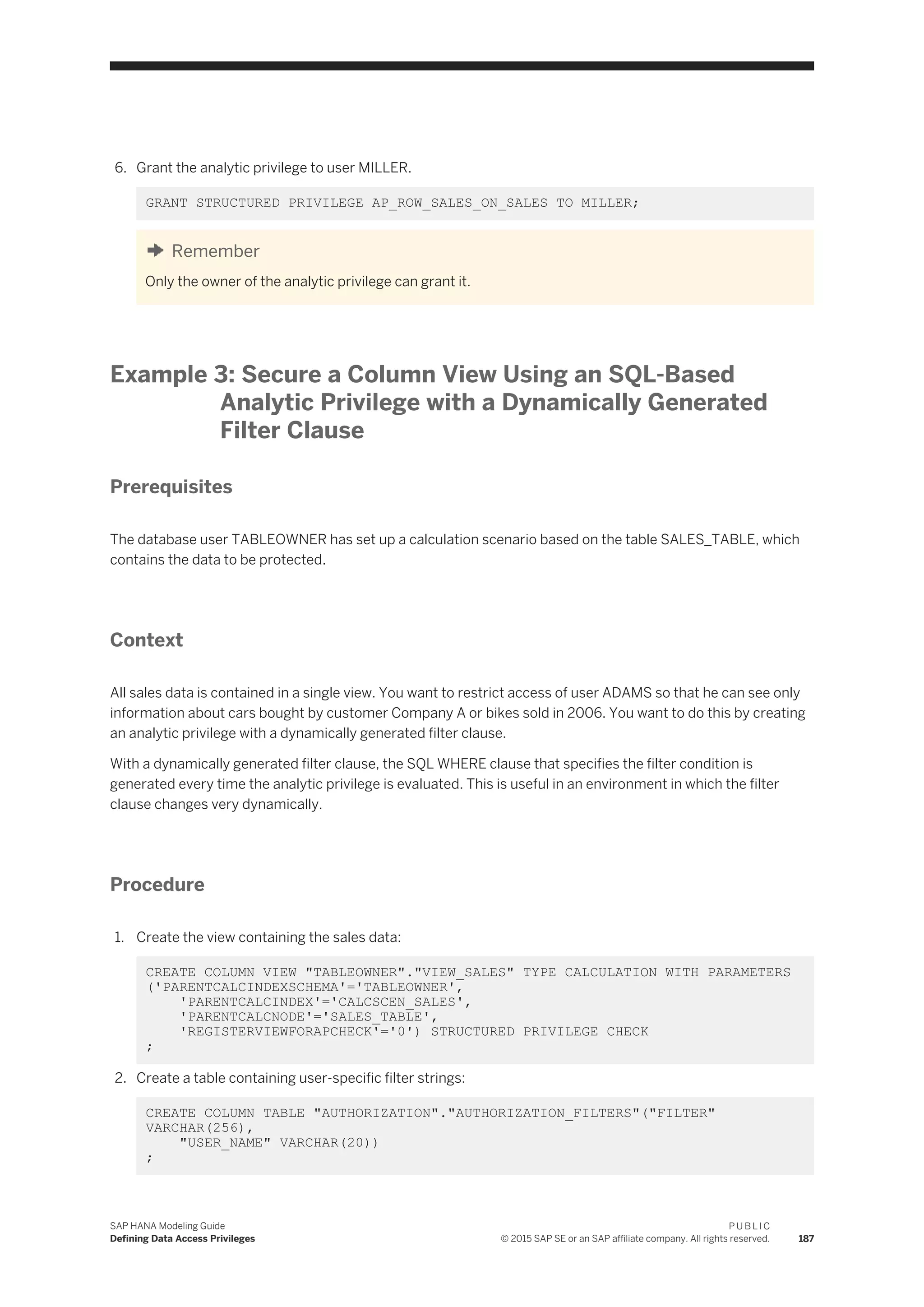
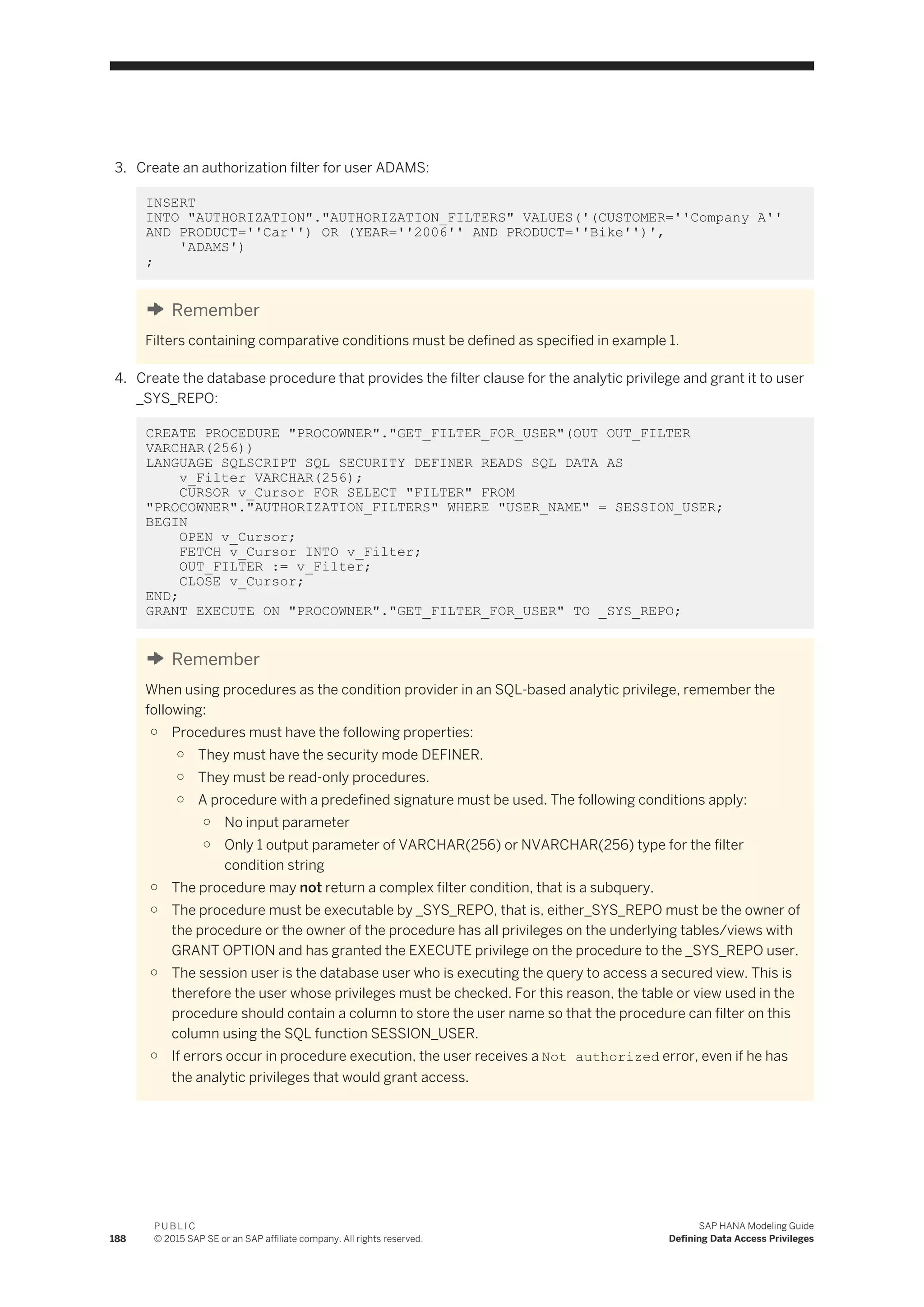
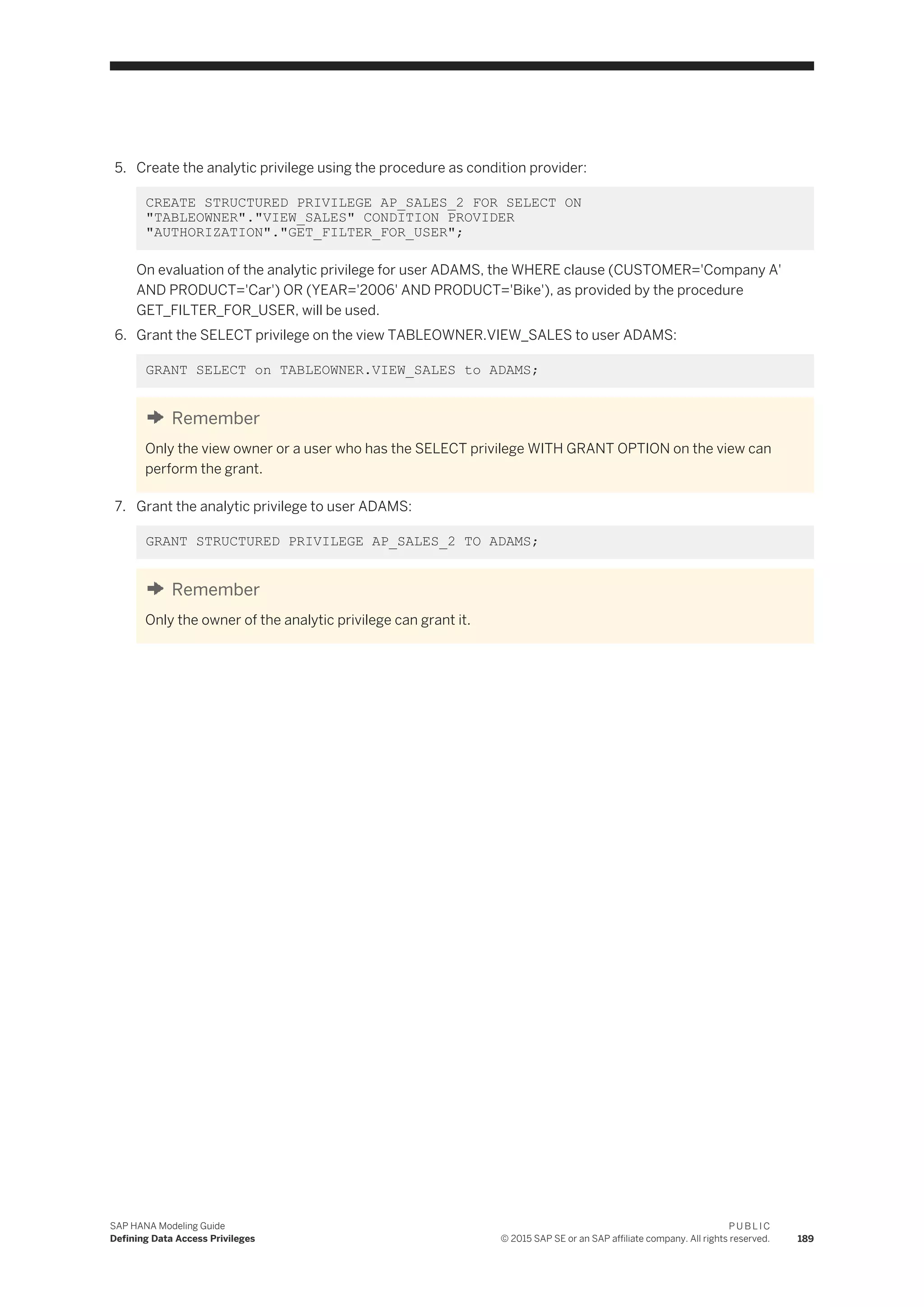
![10 Additional Functionality for Information
Views
After modeling information views or at design time you can perform certain additional functions, which helps
improve the efficieny of modeling information views.
This section describes the different additional functions that SAP HANA modeler offers and how you can use
these functions to efficiently model views.
Related Information
Performance Analysis [page 190]
Maintain Comments for Modeler Objects [page 196]
Replacing Nodes and Data Sources [page 198]
Renaming Information Views and Columns [page 201]
10.1 Performance Analysis
Open information views in performance analysis mode and obtain information on the catalog tables. This
information helps you analyze the possible performance impacts on information views at runtime. For
example, you can obtain information on table partitions, number of rows in tables, and so on.
In performance analysis mode, you obtain following key information and much more depending on data
sources in your information view.
Identify number of rows in a table
Identify those data sources that have number of rows above a certain threshold value. You can configure this
threshold value in the SAP HANA studio preferences.
1. In the menu bar, choose Windows Preferences SAP HANA Modeler Performance Analysis .
2. In the Threshold values for rows in a table textbox, provide a threshold value.
3. Choose Apply.
4. Choose OK.
Identify Table Partitions and Table Types
If you have partitioned tables, identify the partitioned tables along with partition type (Hash, Range, Round
Robin) and columns used for partitioning the tables. In addition, you can also obtain information on the table
type. For example, if you are using virtual tables, then modeler provides information on the virtual table
properties (remote DB, remote source, remote owner, and remote object) and its values.
190
P U B L I C
© 2015 SAP SE or an SAP affiliate company. All rights reserved.
SAP HANA Modeling Guide
Additional Functionality for Information Views](https://image.slidesharecdn.com/51818a91-dee6-4c9b-b633-0deab6e88220-150721193202-lva1-app6892/75/SAP_HANA_Modeling_Guide_for_SAP_HANA_Studio_en-190-2048.jpg)
![Note
If you have enabled performance analysis mode, modeler displays a warning icon across those catalog
tables that have number of rows more than the threshold value that you have defined. Similarly, modeler
also displays certain indicators across the tables, which helps you to identify the partition type of those
particular tables.
Related Information
Open Information Views in Performance Analysis Mode [page 191]
Debug Calculation Views [page 193]
Validate Performance of Calculation Views [page 195]
10.1.1 Open Information Views in Performance Analysis
Mode
The number of rows in a data source and table partitions impact the performance of your queries. When you
open an information view in performance analysis mode, you can obtain information on join tables, table
partitions, table types and other useful information, which helps you analyze your calculation view and its
possible performance impacts at runtime.
Procedure
1. Launch SAP HANA studio.
2. Open the required graphical calculation view in the view editor.
Note
Performance analysis is not supported for script-based calculation views.
3. Select a view node with catalog tables.
Note
You cannot analyze the performance of the Semantics node.
4. In the menu bar, choose the icon to enable performance analysis mode.
The modeler displays the following information in the Performance Analysis tab.
○ Join Details
○ Data Source Details
SAP HANA Modeling Guide
Additional Functionality for Information Views
P U B L I C
© 2015 SAP SE or an SAP affiliate company. All rights reserved. 191](https://image.slidesharecdn.com/51818a91-dee6-4c9b-b633-0deab6e88220-150721193202-lva1-app6892/75/SAP_HANA_Modeling_Guide_for_SAP_HANA_Studio_en-191-2048.jpg)
![Note
You can choose the same icon to hide performance analysis mode for an information view.
Note
If you want to always open an information view in performance analysis mode by default, configure the
SAP HANA studio preferences.
1. In the menu bar, choose Windows Preferences SAP HANA Modeler Performance
Analysis .
2. In the Threshold values for rows in a table textbox, provide a threshold value.
3. Choose Apply.
4. Choose OK.
Related Information
Join Details [page 192]
Data Source Details [page 193]
10.1.1.1 Join Details
If you have enabled the performance analysis mode by default, open an information view and select a join node
with catalog tables to obtain join details.
For a selected join node, the JOIN DETAILS section in Performance Analysis tab provides the following
information:
● Catalog tables participating in the join.
● The cardinality and join type that you have selected for each join.
● The cardinality that modeler recommends after analyzing the participating catalog tables in the join.
● Information on whether you have maintained the referential integrity for the join table.
● The join validation status. The join validation status is in warning if the cardinality that modeler proposes is
different from the cardinality that you select and also if you have not maintained referential integrity.
Note
Only users with SELECT privileges on the catalog tables participating in the join can view join validation
status. If the participating catalog tables are virtual tables, then you can view the join validation status only if
the user has SELECT privileges on the virtual table and also if the user credential to remote source has
SELECT privileges on the remote table.
192
P U B L I C
© 2015 SAP SE or an SAP affiliate company. All rights reserved.
SAP HANA Modeling Guide
Additional Functionality for Information Views](https://image.slidesharecdn.com/51818a91-dee6-4c9b-b633-0deab6e88220-150721193202-lva1-app6892/75/SAP_HANA_Modeling_Guide_for_SAP_HANA_Studio_en-192-2048.jpg)
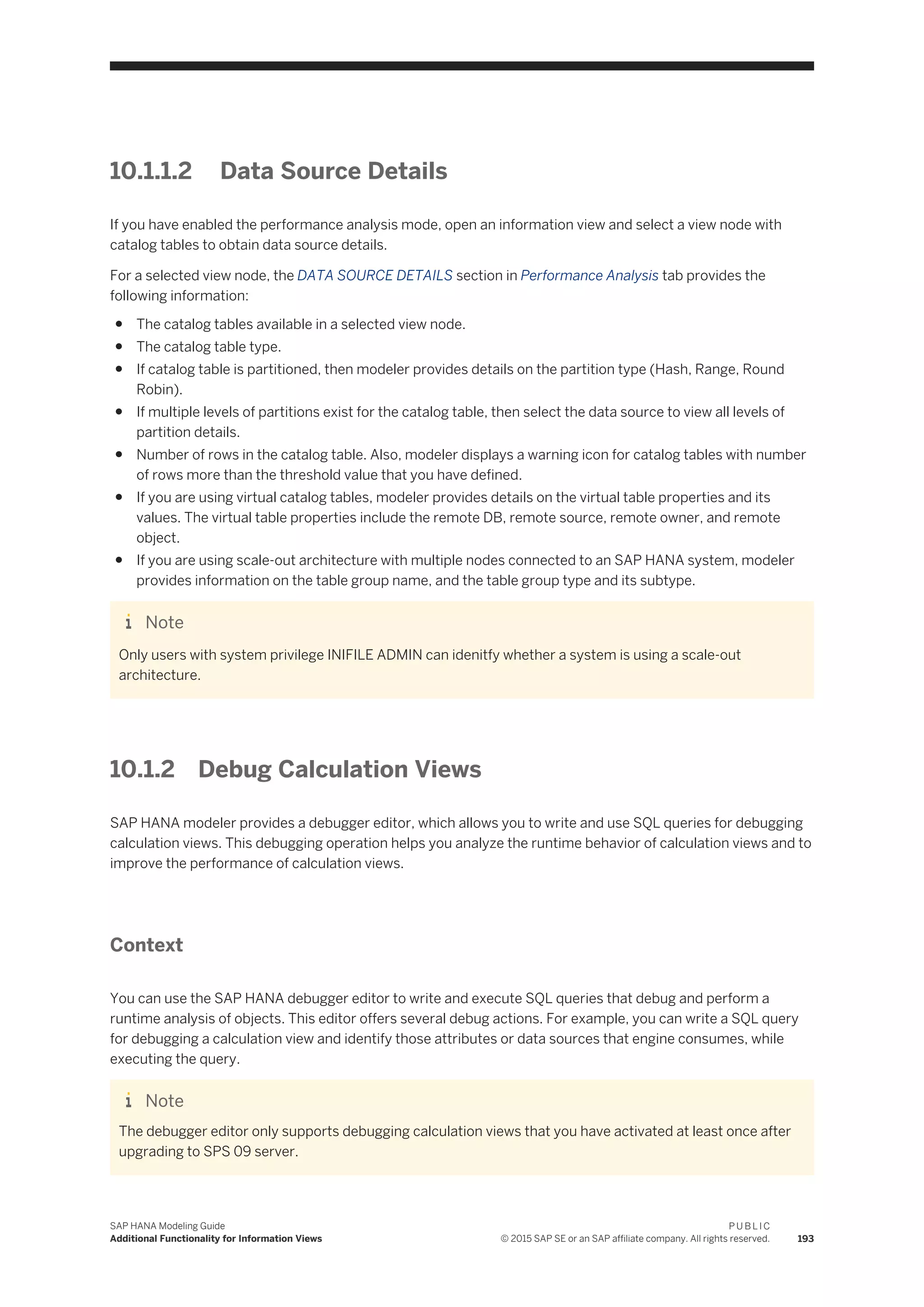
![Procedure
1. Open an information view in the view editor.
2. Choose the icon dropdown.
3. Choose Debug this view.
This operation launches a SQL editor. The SQL editor, by default, proposes a query, which you can execute
and debug the calculation view. The modeler proposes this query after analyzing the existing version of
your calculation view. If you have made changes to the existing version, then ensure to reactivate the
information view before debugging it.
You can modify the SQL query to debug the information view. The system always saves this query for that
editor session. In other words, if you close this debug session, and start a new debug session for the same
information view, you can still see your last saved query.
At any point, you can refer to the query that modeler had proposed and compare it with your query by
selecting the icon from the toolbar of the SQL editor.
Related Information
Start Debugging [page 194]
Debugger Editor [page 195]
10.1.2.1 Start Debugging
Once you have identified the query to debug your object, you can begin the debugging process and analyze the
runtime behavior calculation views. This anlysis can provide you with the information to improve performance
of calculation views.
Procedure
From the tool bar of the SQL editor, select the icon to execute the query and start debugging.
This operation launches a debugger editor in read-only mode. The debugger editor does not allow you to
modify the content of the calculation view. You can only modify it in the view editor outside of this debug
session.
194
P U B L I C
© 2015 SAP SE or an SAP affiliate company. All rights reserved.
SAP HANA Modeling Guide
Additional Functionality for Information Views](https://image.slidesharecdn.com/51818a91-dee6-4c9b-b633-0deab6e88220-150721193202-lva1-app6892/75/SAP_HANA_Modeling_Guide_for_SAP_HANA_Studio_en-194-2048.jpg)
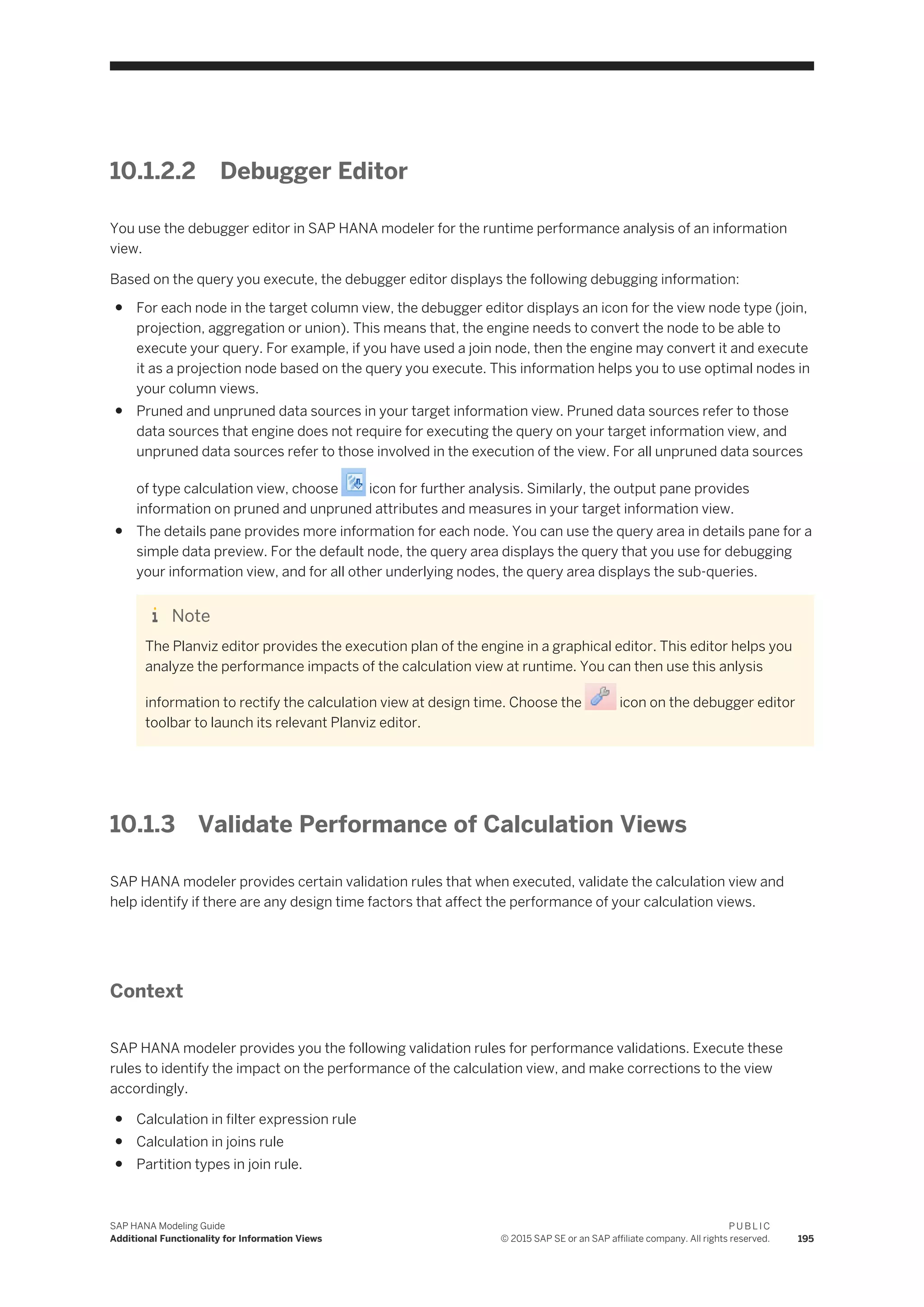
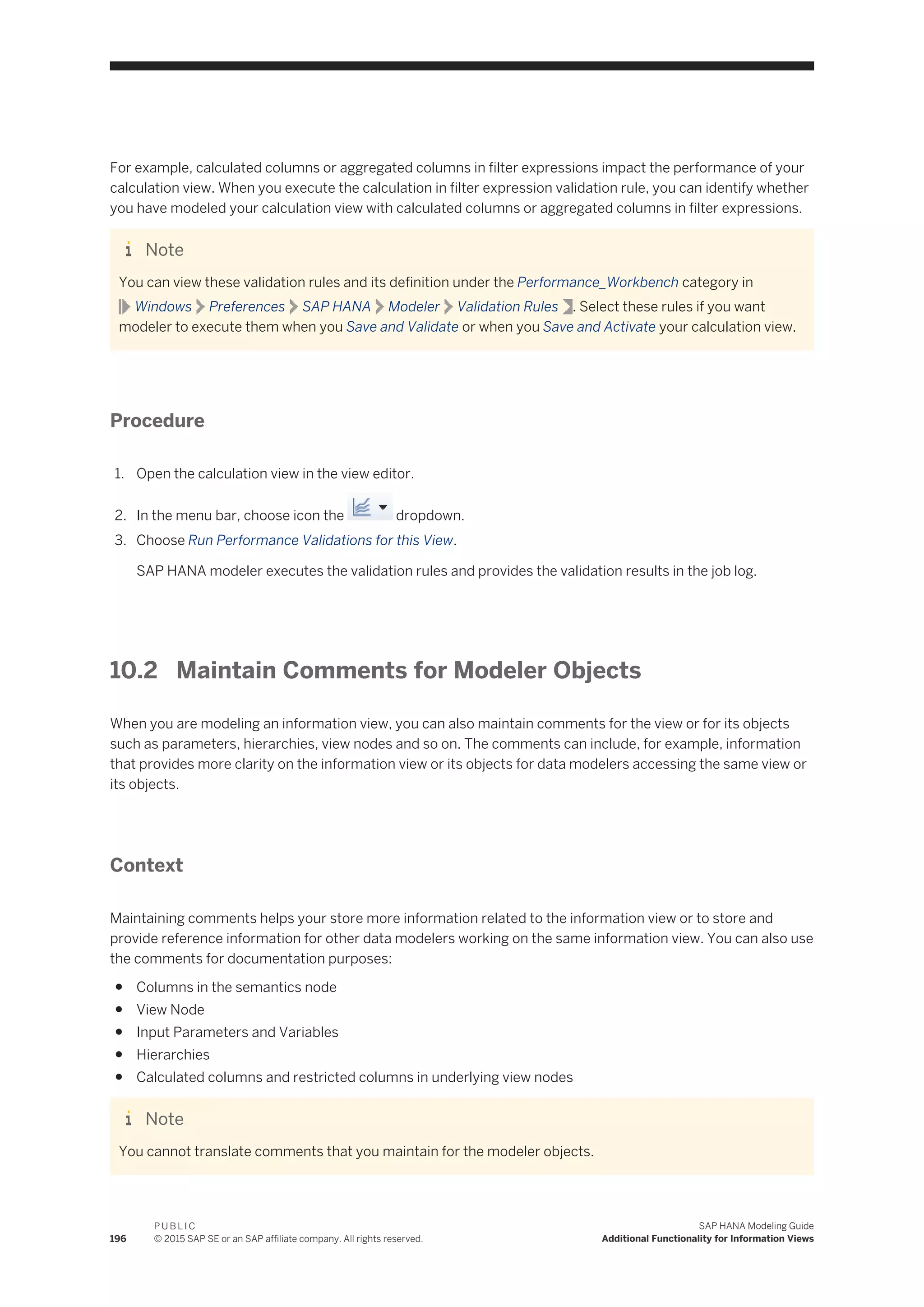
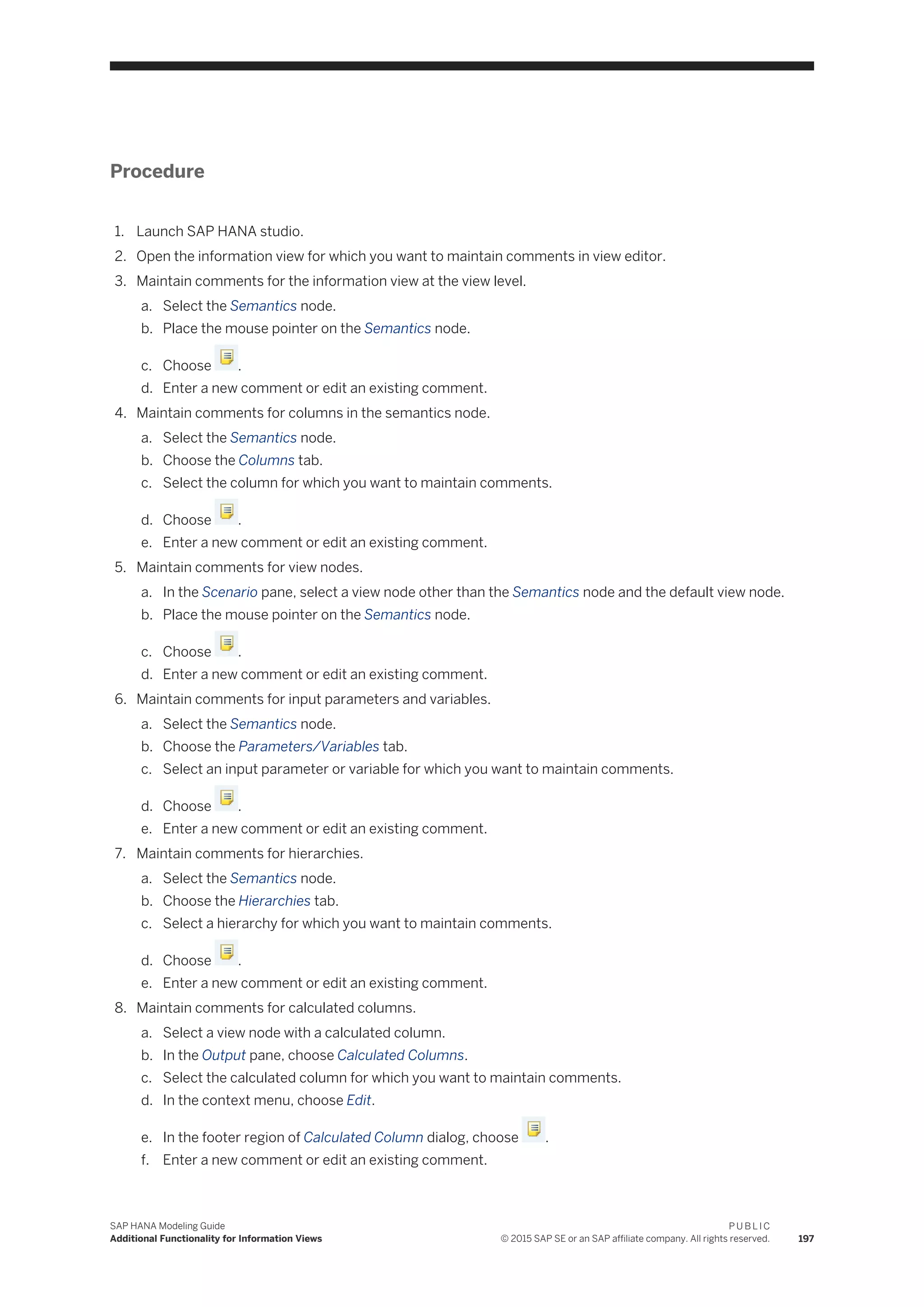
![9. Maintain comments for restricted columns.
a. Select the default aggregation node.
b. In the Output pane, choose Restricted Columns.
c. Select the restricted column for which you want to maintain comments.
d. In the context menu, choose Edit.
e. In the footer region of Edit Restricted Column dialog, choose .
f. Enter a new comment or edit an existing comment.
Note
When you choose to generate an object documentation using the Auto Documentation menu option in
the Quick View, modeler also documents any comments that you have maintained within the document
that it generates.
10.3 Replacing Nodes and Data Sources
Replace a view node with any of the other underlying view nodes or replace a data source in view node with
other available data sources in the catalog object.
The column view for complex calculation views may contain multiple levels of view nodes. If you manually
delete a node in column view (without using the replace view node feature) and add new node, you lose the
semantic information of the deleted node. However, if your requirement is to replace the deleted view node
with its underlying view node, then you can use the replace feature to replace the view node with its underlying
node and retain the semantic information of the changed node. Similarly, you can also replace a data source in
a view node with other available data sources in the catalog object.
Related Information
Replace a View Node in Calculation Views [page 199]
Remove and Replace a View Node in Calculation Views [page 200]
Replace a Data Source in Calculation Views [page 201]
198
P U B L I C
© 2015 SAP SE or an SAP affiliate company. All rights reserved.
SAP HANA Modeling Guide
Additional Functionality for Information Views](https://image.slidesharecdn.com/51818a91-dee6-4c9b-b633-0deab6e88220-150721193202-lva1-app6892/75/SAP_HANA_Modeling_Guide_for_SAP_HANA_Studio_en-198-2048.jpg)


![b. Choose OK.
5. In the Replace With dropdown list, choose a view node that you want use for replacing.
6. Manage the source and target mappings accordingly.
7. Choose OK.
8. Choose the icon in the scenario pane.
10.3.3 Replace a Data Source in Calculation Views
Replace a data source in calculation views with other available data sources in the catalog object, without
losing the semantic information of the replaced data source.
Procedure
1. Open a graphical calculation view in the view editor.
2. In the calculation view, select a data source that you want to replace.
3. In the context menu of the data source, choose Replace with Data Source.
4. In the Find wizard, enter the name of the data source and select it from the list.
5. Choose OK.
10.4 Renaming Information Views and Columns
Rename information views or their columns without losing their existing behavior. If these information views or
columns are referred in other modeler objects, then SAP HANA modeler automatically adjusts the references
of these information views or columns in impacted objects.
Related Information
Rename Information Views [page 202]
Rename Columns in Information Views [page 202]
SAP HANA Modeling Guide
Additional Functionality for Information Views
P U B L I C
© 2015 SAP SE or an SAP affiliate company. All rights reserved. 201](https://image.slidesharecdn.com/51818a91-dee6-4c9b-b633-0deab6e88220-150721193202-lva1-app6892/75/SAP_HANA_Modeling_Guide_for_SAP_HANA_Studio_en-201-2048.jpg)
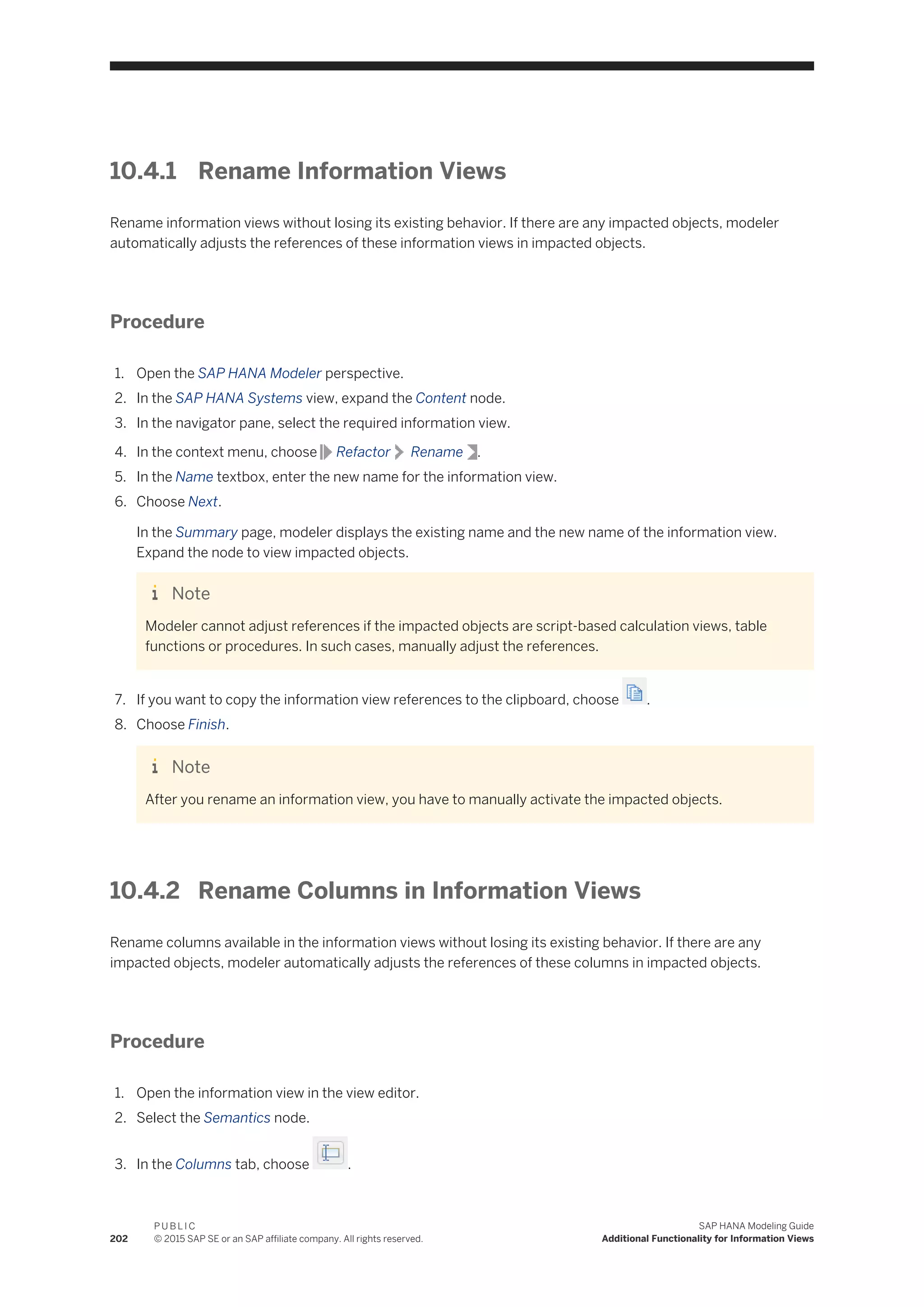
![Note
In the Rename and Adjust References wizard, modeler displays all columns available in the information
view output.
4. In the New Name column, provide a new name to a selected column.
5. Choose Next.
Modeler displays all impacted objects due to the rename process.
Note
Modeler cannot adjust references if the impacted objects are analytic privileges, script-based
calculation views, table functions, expressions (for calculated column, restricted columns, and so on.)
and procedures. In such cases, manually adjust the references.
6. If you want to identify the column references in the impacted objects,
a. Select an impacted object.
b. In the More Information field, choose the value help.
7. If you want to copy column references to the clipboard, choose .
8. If you want to skip the rename operation for a particular impacted object, deselect the impacted object.
Note
If you deselect an impacted object, you have after to manually adjust the column references in the
impacted objects after rename.
9. Choose Finish.
Note
After you rename columns, you have to manually activate the impacted objects.
10.5 Using Functions in Expressions
This section describes the functions, which you can use while creating expressions for calculated attributes
and calculated measures.
Related Information
Conversion Functions [page 204]
String Functions [page 205]
Mathematical Functions [page 208]
SAP HANA Modeling Guide
Additional Functionality for Information Views
P U B L I C
© 2015 SAP SE or an SAP affiliate company. All rights reserved. 203](https://image.slidesharecdn.com/51818a91-dee6-4c9b-b633-0deab6e88220-150721193202-lva1-app6892/75/SAP_HANA_Modeling_Guide_for_SAP_HANA_Studio_en-203-2048.jpg)
![Date Functions [page 208]
Miscellaneous Functions [page 210]
10.5.1 Conversion Functions
Data type conversion functions are used to convert arguments from one data type to another, or to test
whether a conversion is possible.
Function Syntax Purpose Example
int int int(arg) convert arg to int type int(2)
float float float(arg) convert arg to float type float(3.0)
double double double (arg) convert arg to double type double(3)
sdfloat sdfloat sdfloat (arg) convert arg to sdfloat type
decfloat decfloat decfloat (arg) convert arg to decfloat type
fixed fixed fixed (arg, int, int) arg2 and arg3 are the
intDigits and fractdigits
parameters, respectively.
Convert arg to a fixed type of
either 8, 12, or 16 byte
length, depending on
intDigits and fractDigits
fixed(3.2, 8, 2) + fixed(2.3, 8,
3)
string string string (arg) convert arg to string type
raw raw raw (arg) convert arg to raw type
date date date(stringarg)
date date(fixedarg)
date date(int, int)
date date(int, int, int)
date date(int, int, int, int)
date date(int, int, int, int, int)
date date(int, int, int, int, int,
int)
convert arg to date type. The
first version parses a string
in the format "yyyy-mm-dd
hh:mi:ss" where trailing
components except for the
year may be omitted. The
version with one fixed
number arg strips digits
behind the comma and tries
to make a date from the
rest. The other versions
accept the individual
components to be set.
date(2009) -> date('2009')
date(2009, 1, 2) ->
date('2009-01-02')
date(fixed(2000020313502
6.1234567, 10, 4)) ->
date('2000-02-03
13:50:26')
longdate longdate
longdate(stringarg)
longdate longdate(fixedarg)
longdate longdate(int, int,
int)
convert arg to longdate type,
similar to date function
above.
longdate(fixed(2000020313
5026.1234567, 10, 5)) ->
longdate('2000-02-03
13:50:26.1234500')
204
P U B L I C
© 2015 SAP SE or an SAP affiliate company. All rights reserved.
SAP HANA Modeling Guide
Additional Functionality for Information Views](https://image.slidesharecdn.com/51818a91-dee6-4c9b-b633-0deab6e88220-150721193202-lva1-app6892/75/SAP_HANA_Modeling_Guide_for_SAP_HANA_Studio_en-204-2048.jpg)
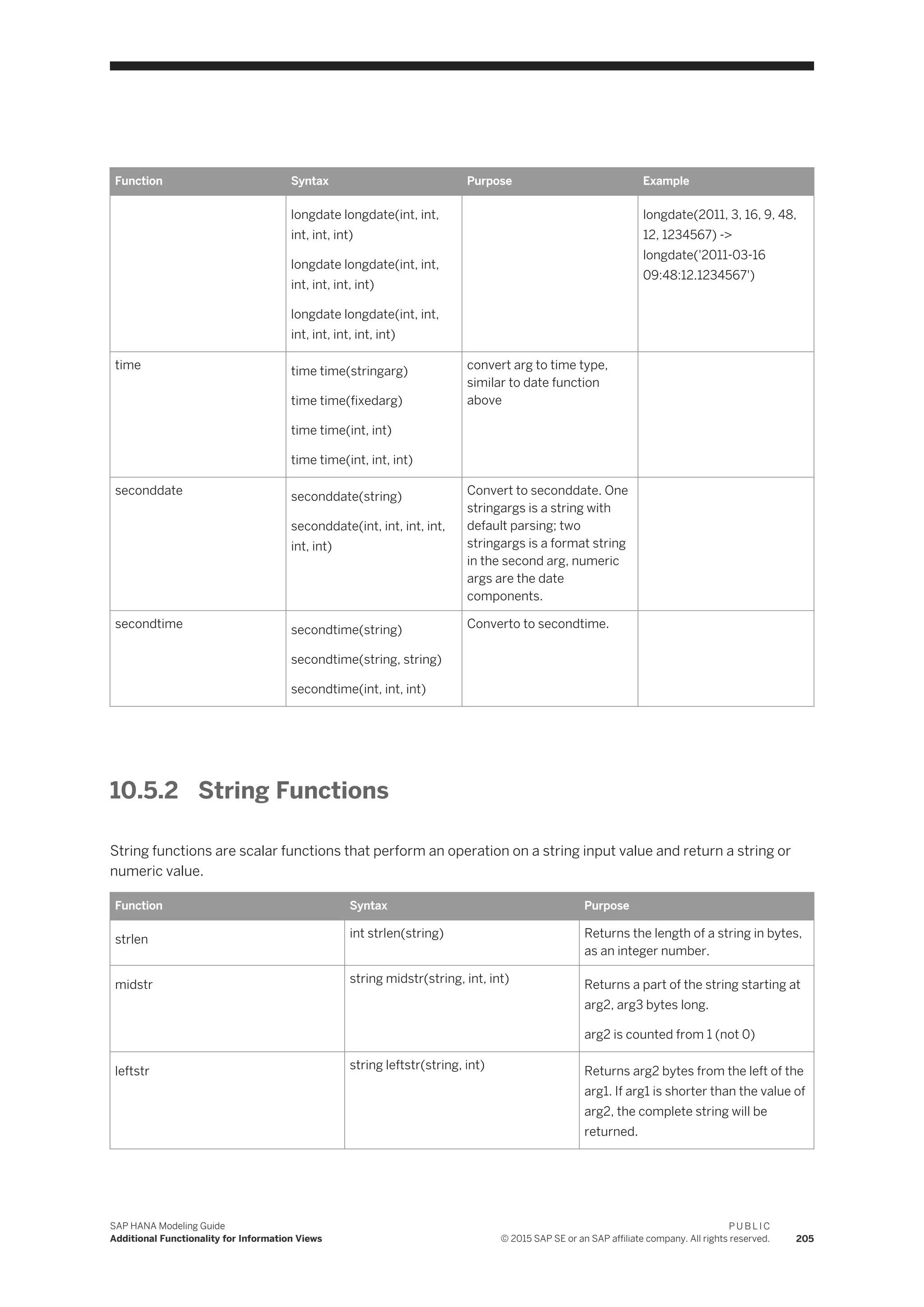
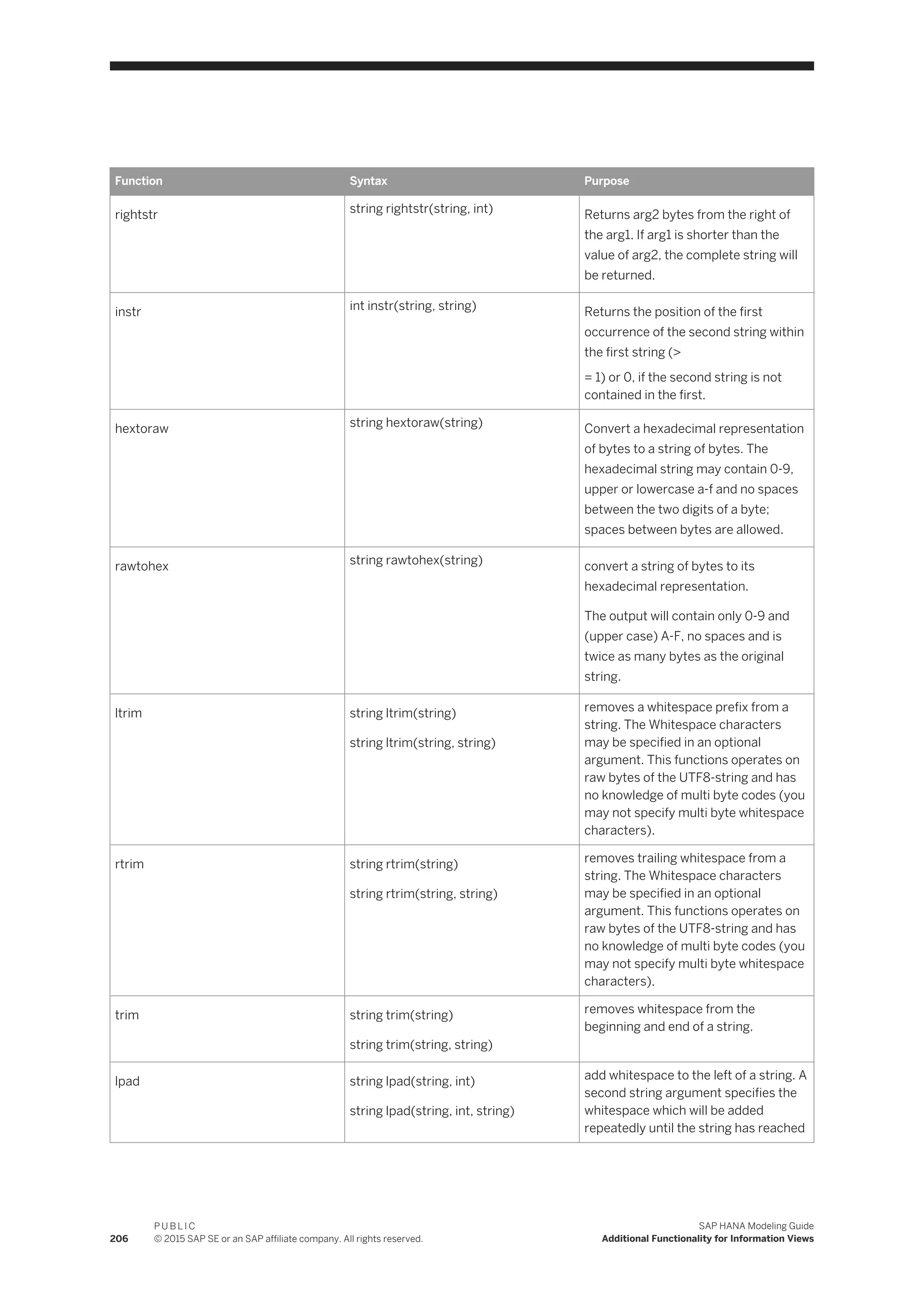
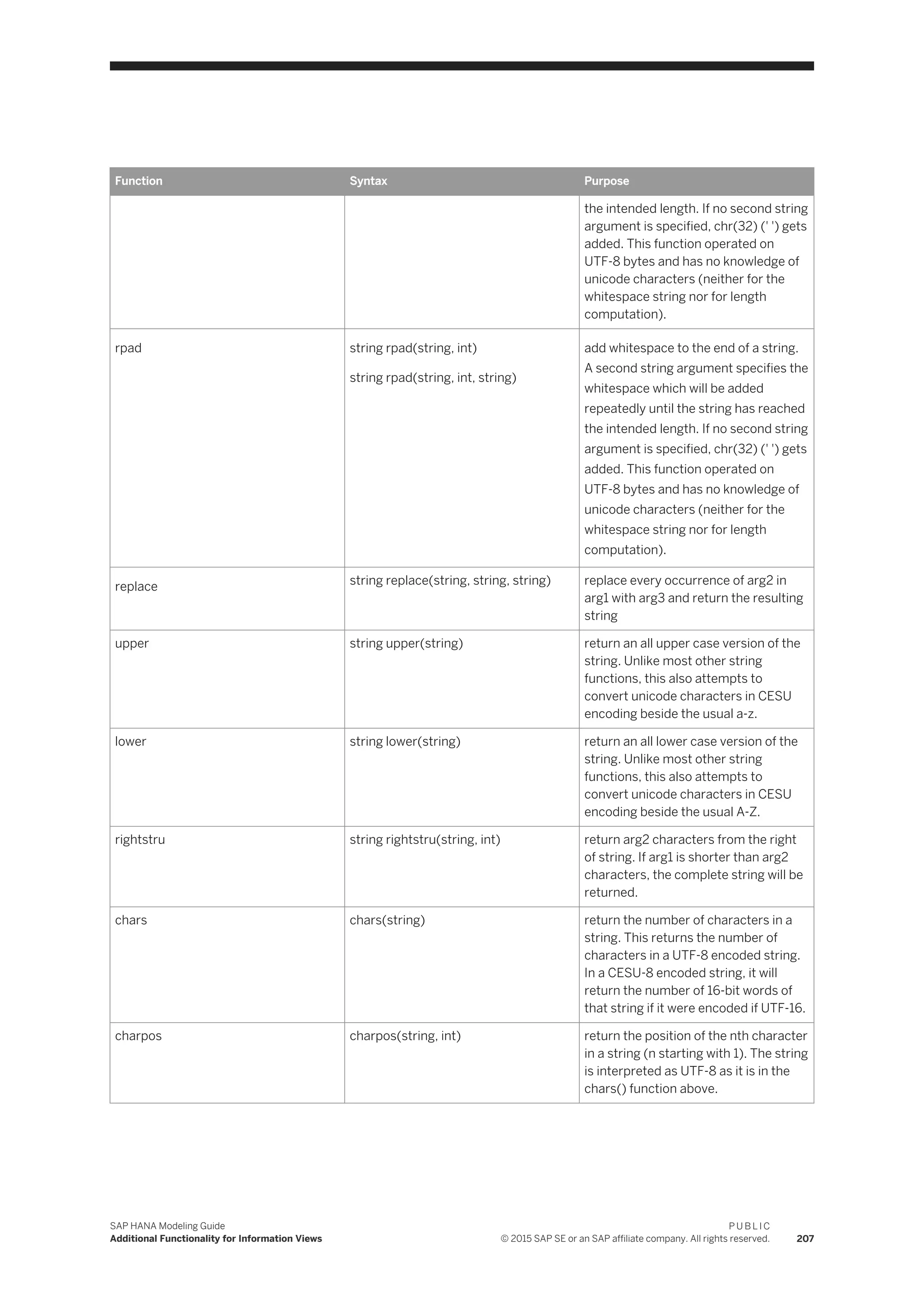
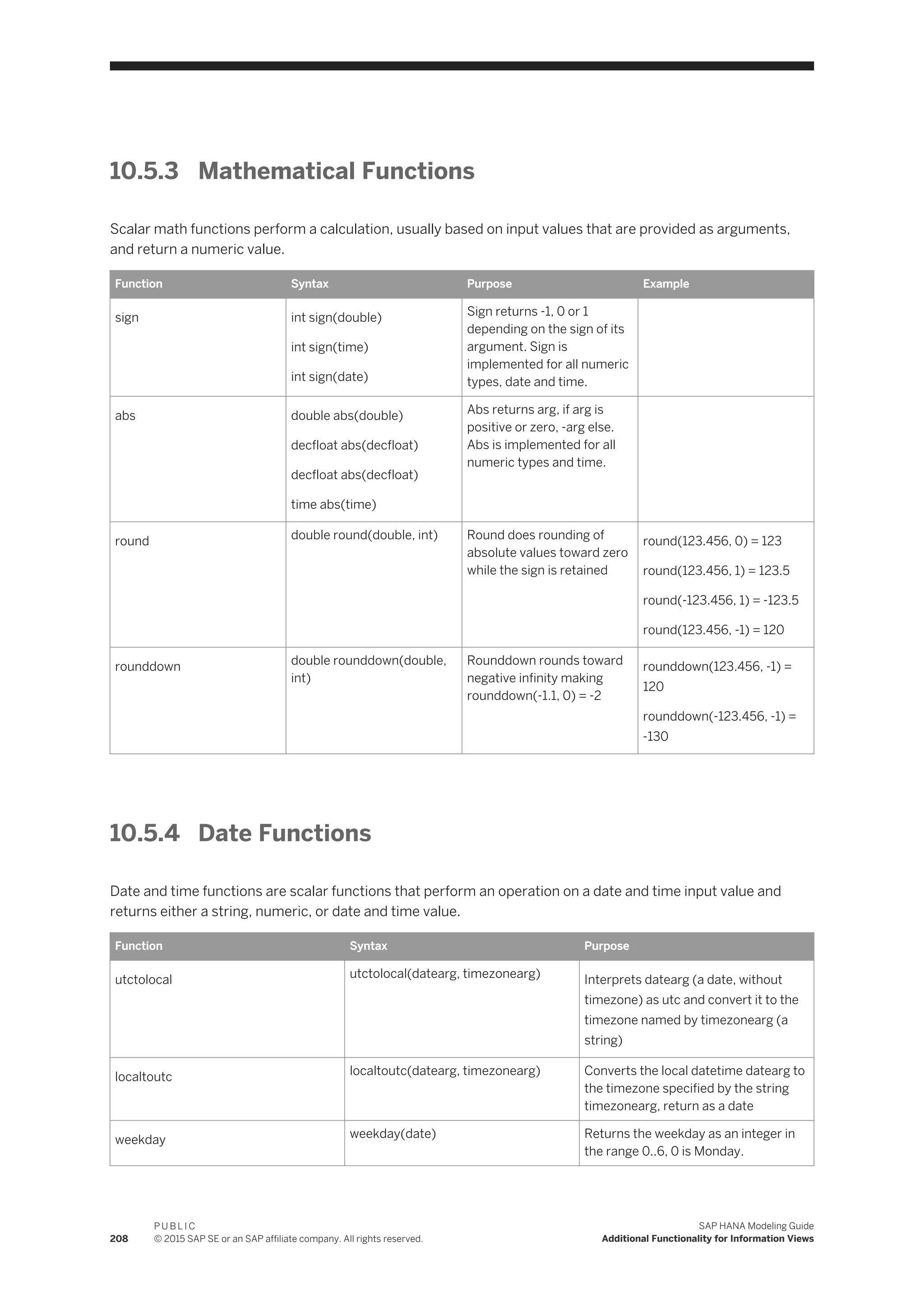
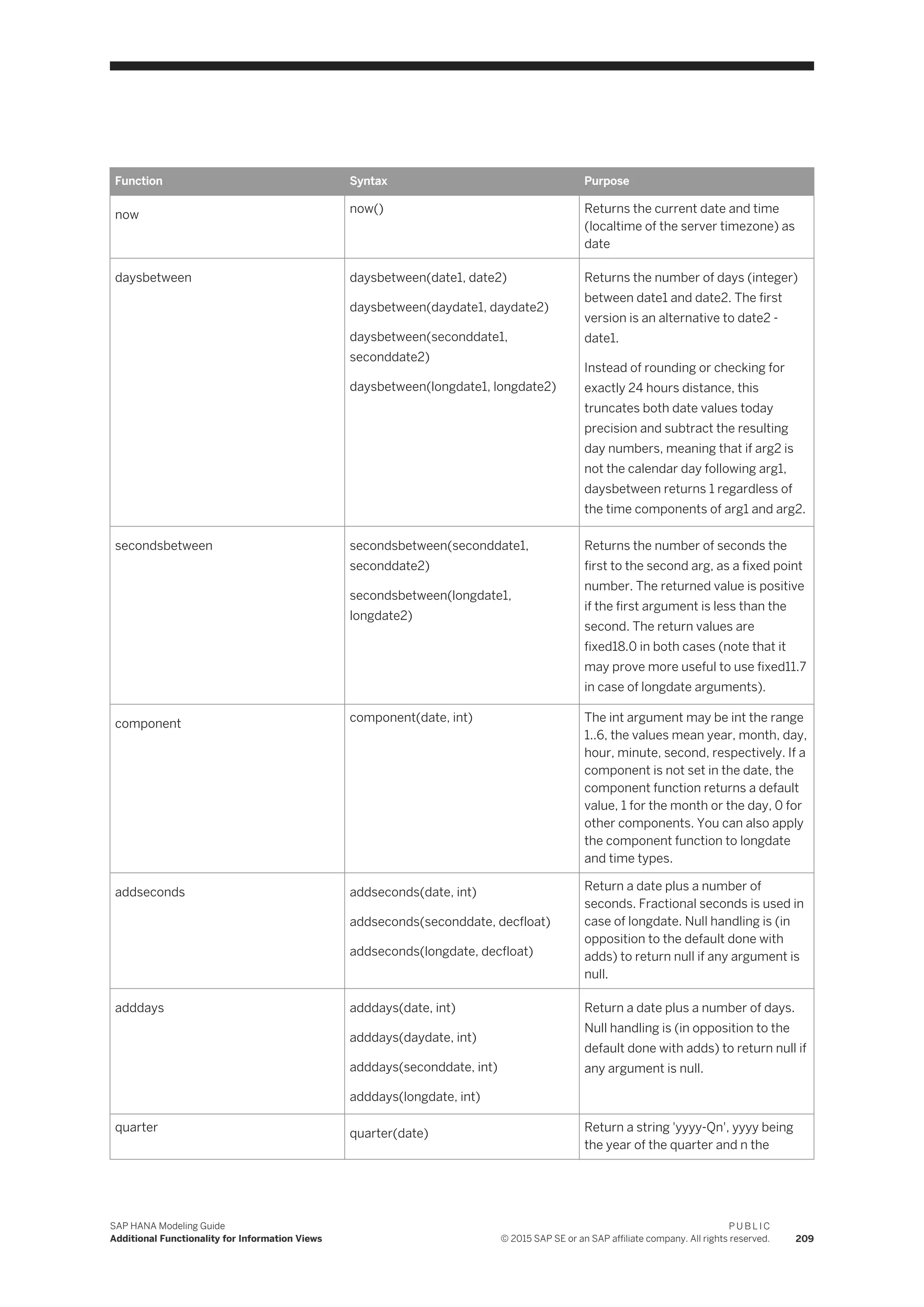
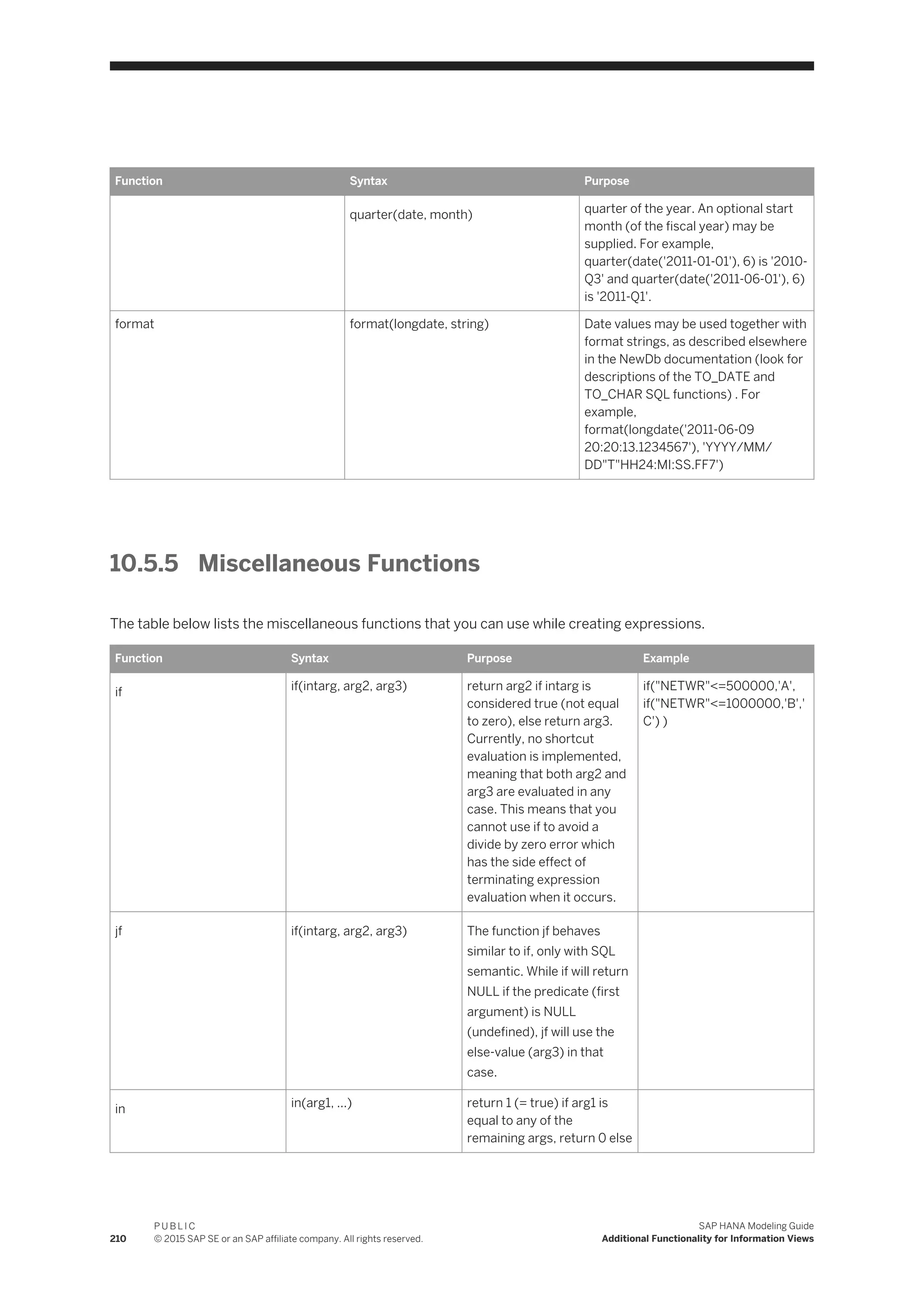


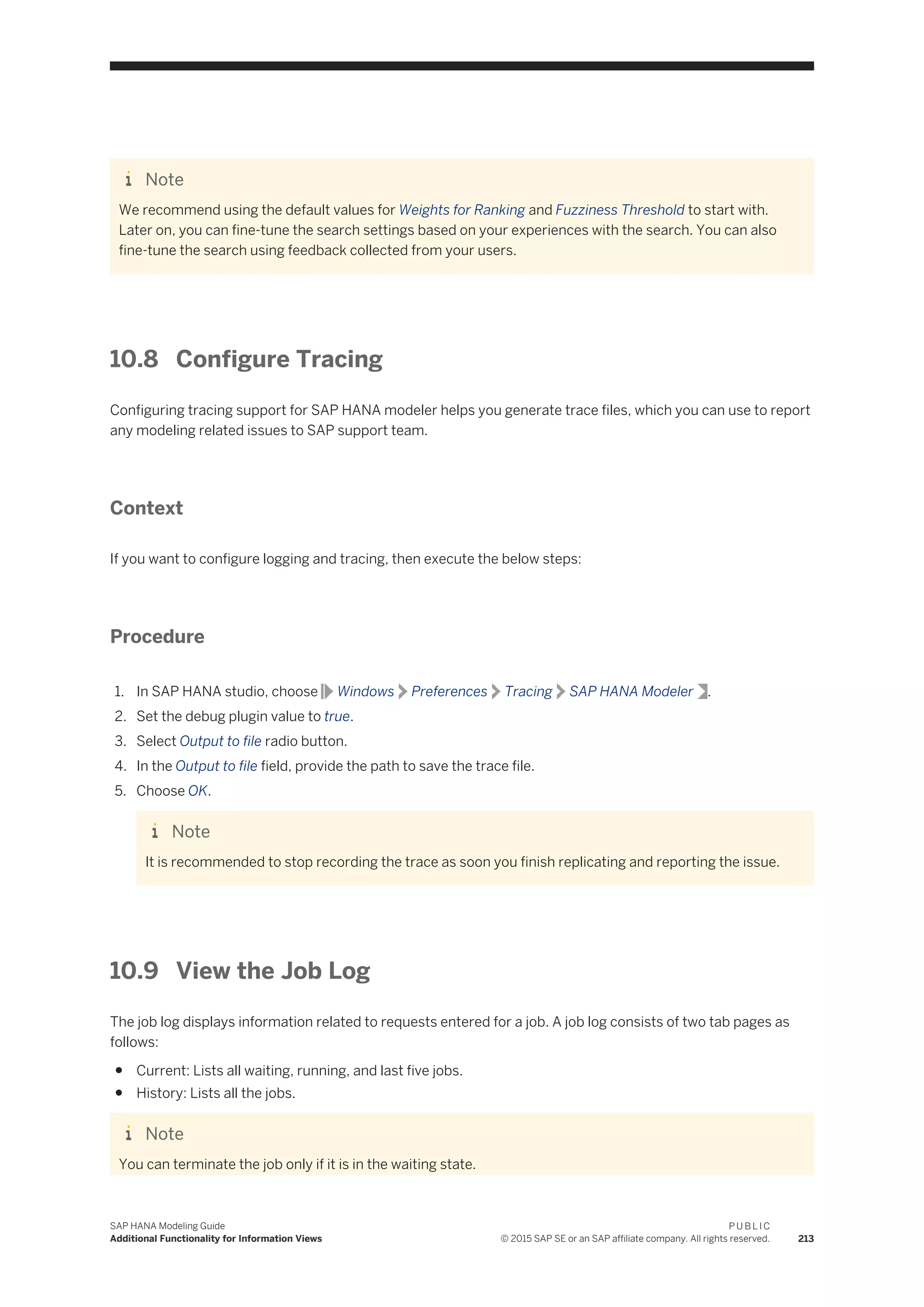
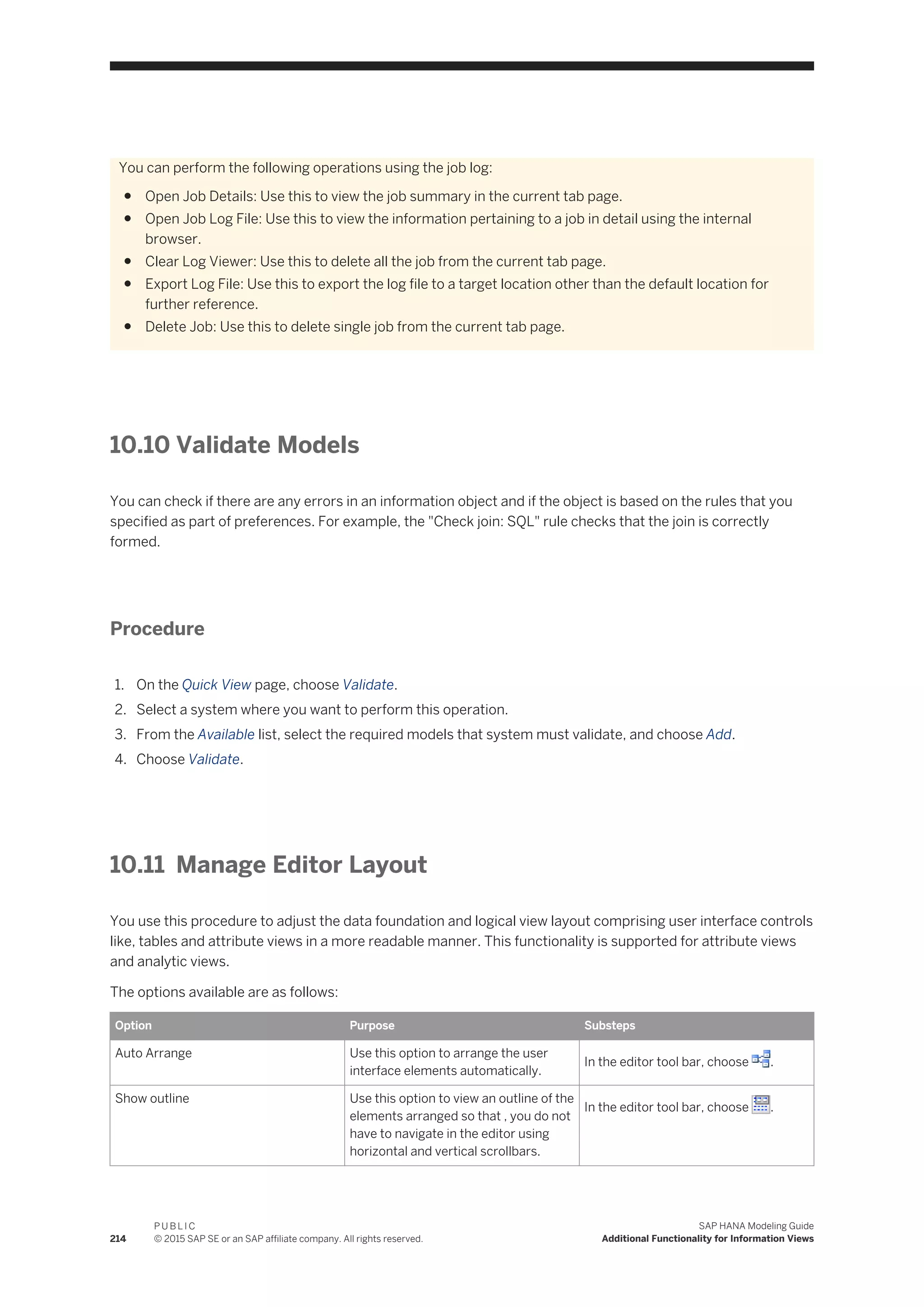

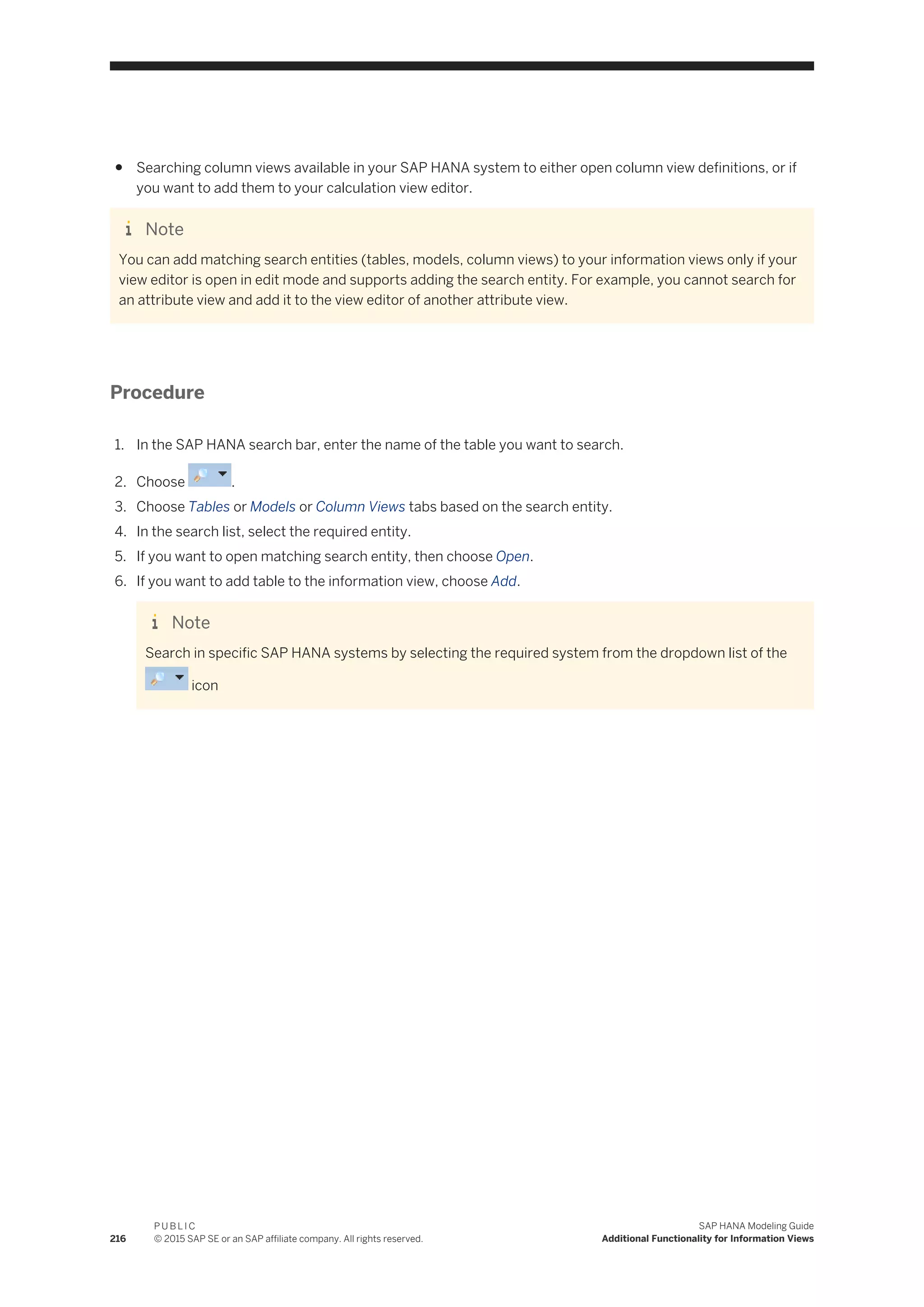
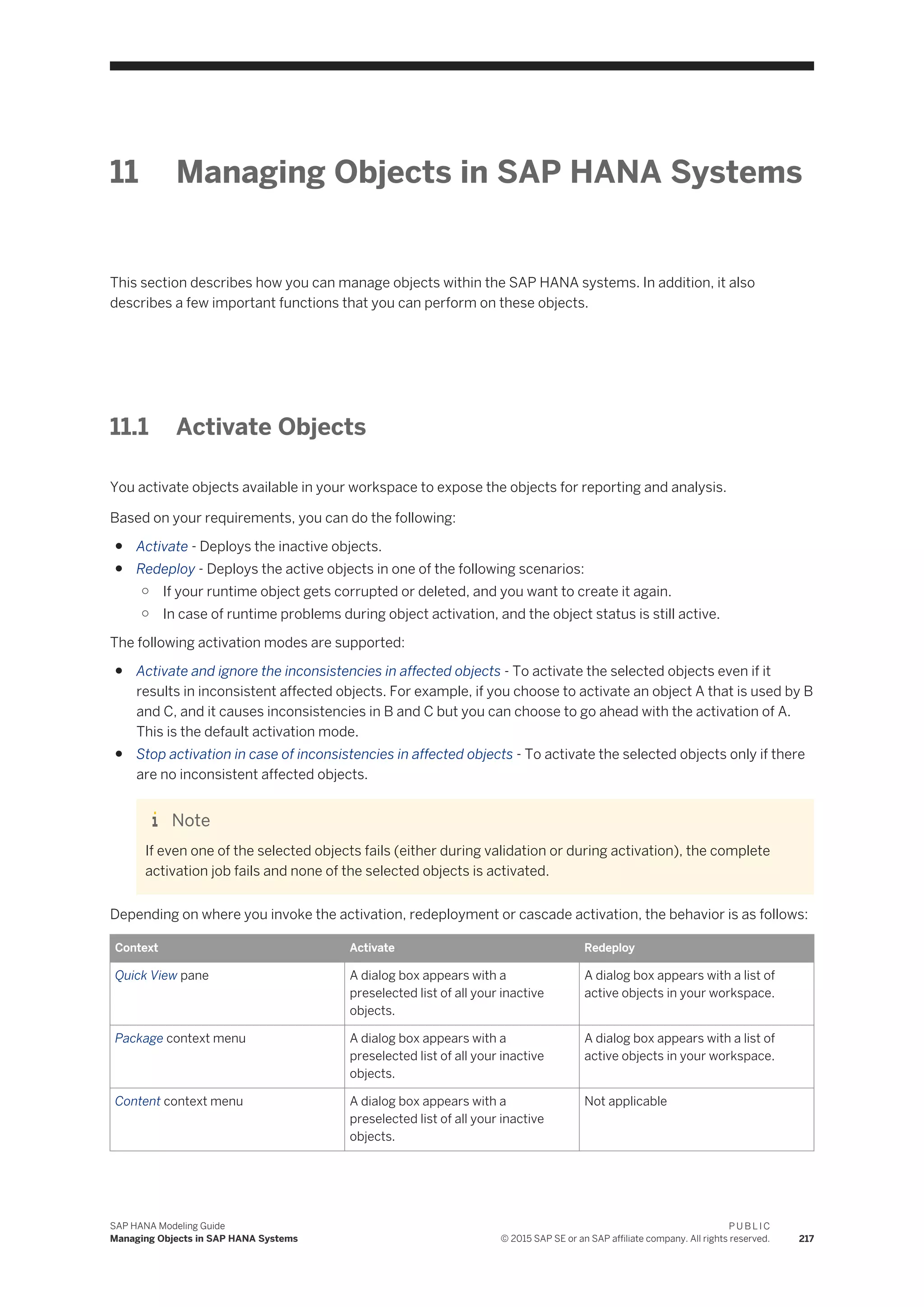
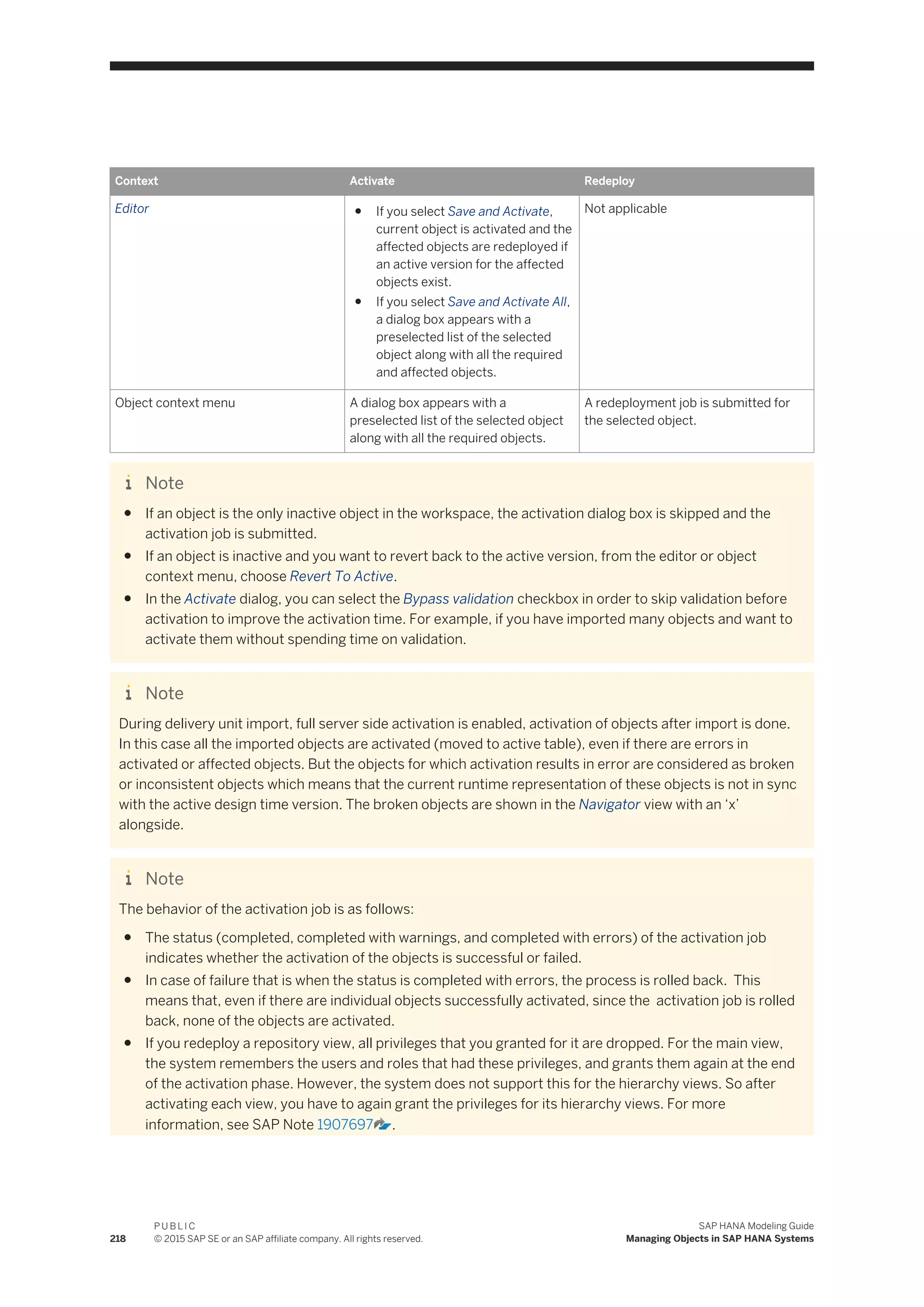



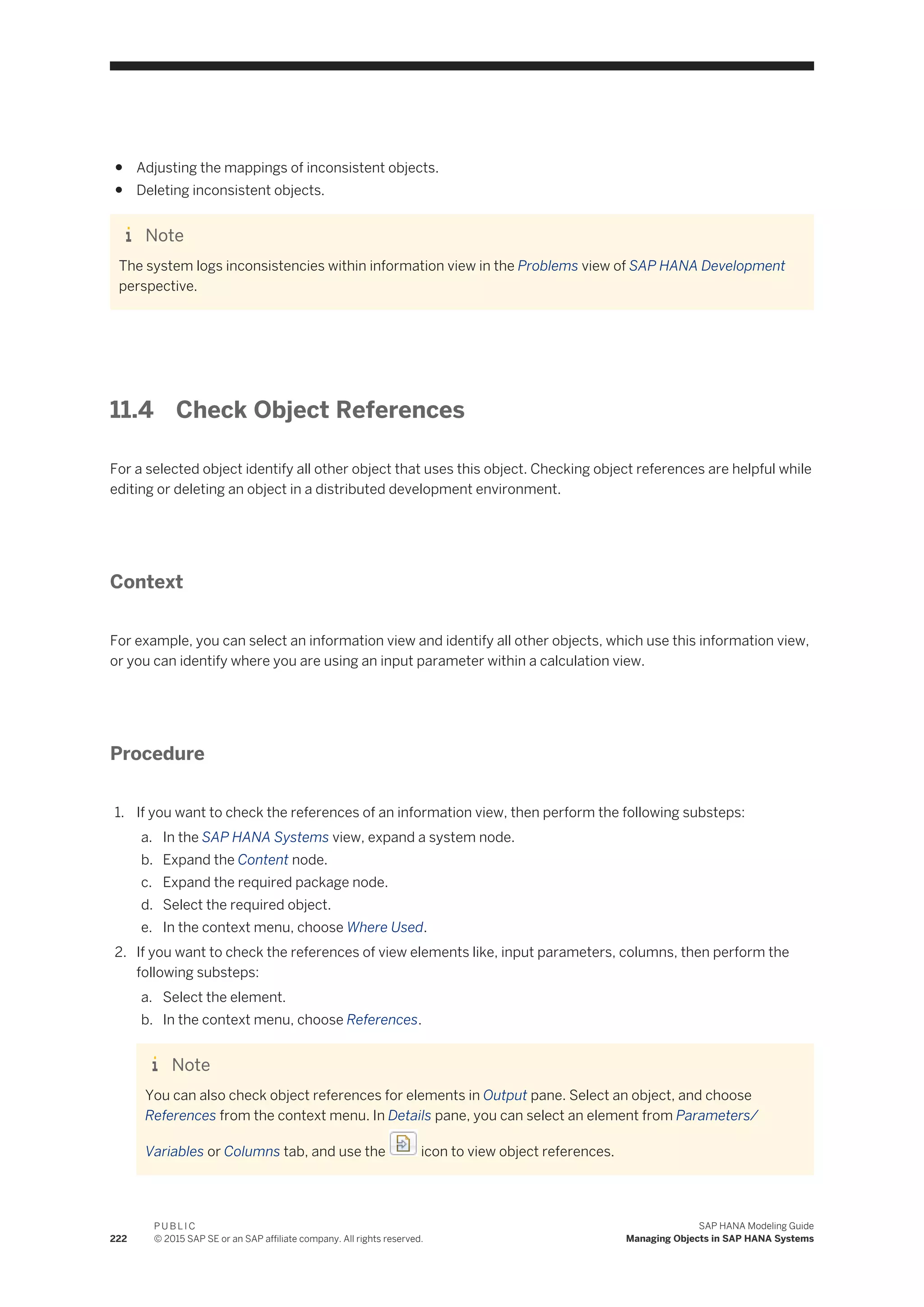
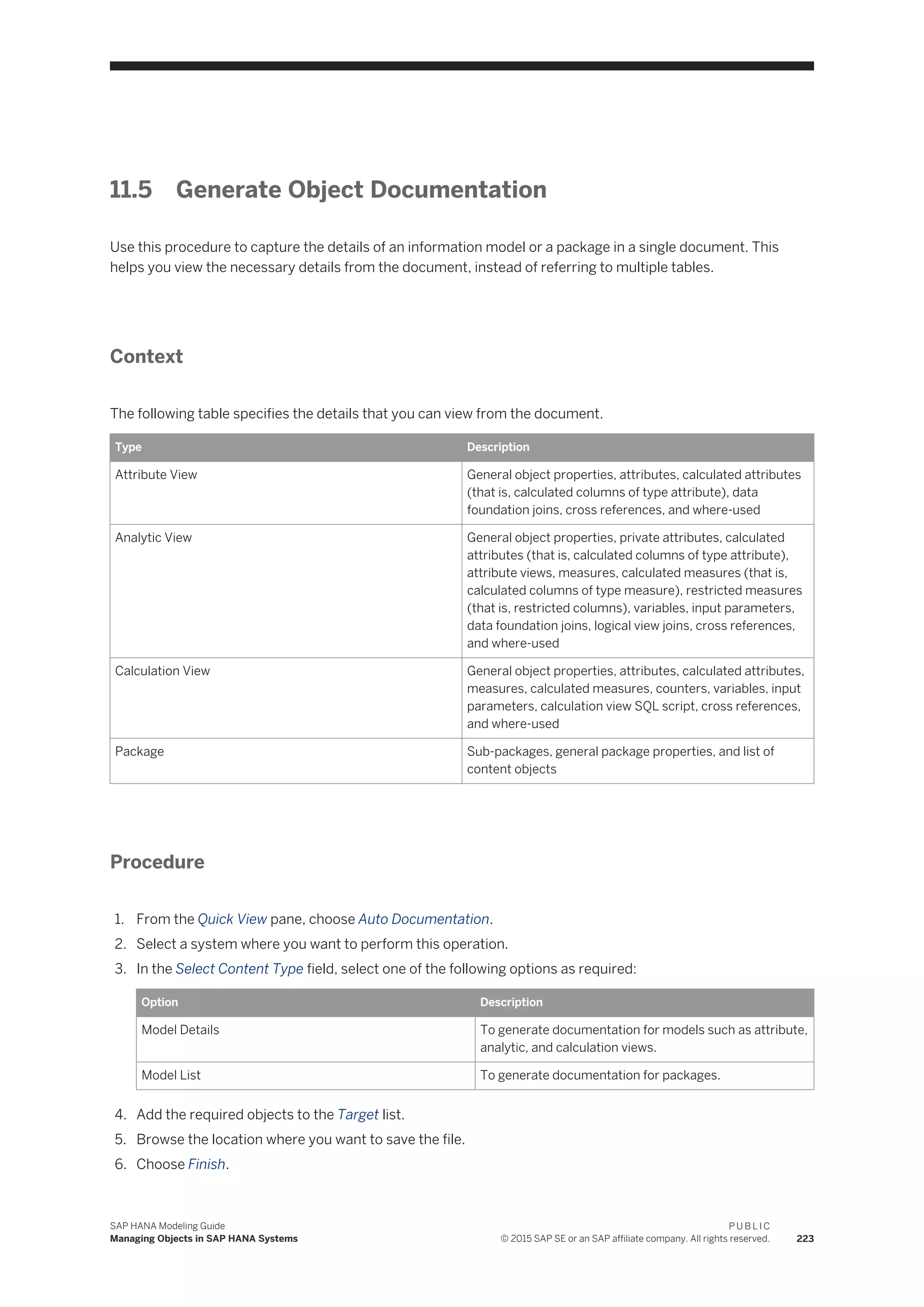
![11.6 Refactoring Objects
Refactoring content objects restructures your content objects in the SAP HANA systems view (SAP HANA
modeler perspective) or the repository workspace (SAP HANA development perspective) without changing
the object behavior.
While refactoring the objects, the system automatically adjusts all objects references. The modeler objects
available for refactoring are, attribute views, analytic views, graphical calculation views, and analytic privileges.
Related Information
Refactor Modeler Objects in SAP HANA Modeler Perspective [page 224]
Refactor Modeler Objects in SAP HANA Development Perspective [page 225]
11.6.1 Refactor Modeler Objects in SAP HANA Modeler
Perspective
Refactoring objects means moving objects from one package to another within the SAP HANA Systems view,
without losing the behavior of these objects.
Context
The refactoring process deletes the object that you move from the source package, and creates an object with
the same name and behavior in the destination package.
The table below provides information on the activation status of objects before and after the refactoring
process:
At Source Location At Target Location
Base Object- active
Impacted Object- active
Base Object- active
Impacted Object- active
Base Object- inactive
Impacted Object- inactive
Base Object- inactive
Impacted Object- inactive
Base Object- active
Impacted Object- inactive
Base Object- active
Impacted Object- active
Base Object- inactive Base Object- inactive
224
P U B L I C
© 2015 SAP SE or an SAP affiliate company. All rights reserved.
SAP HANA Modeling Guide
Managing Objects in SAP HANA Systems](https://image.slidesharecdn.com/51818a91-dee6-4c9b-b633-0deab6e88220-150721193202-lva1-app6892/75/SAP_HANA_Modeling_Guide_for_SAP_HANA_Studio_en-224-2048.jpg)

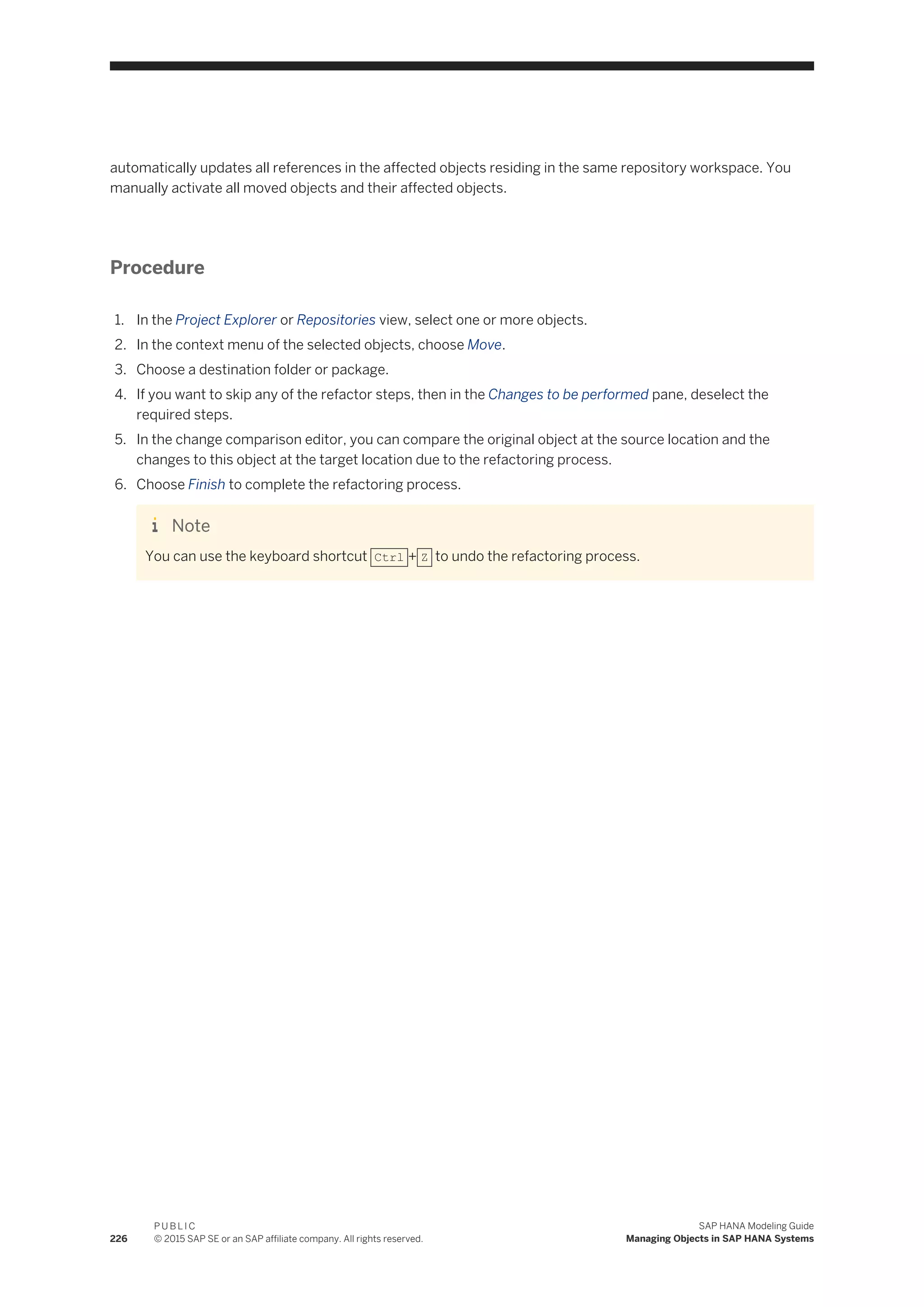
![12 Working with SAP NetWeaver BW Models
This sections describes how you can import and use SAP NetWeaver BW objects, within the modeling
environment, for reporting purposes.
Related Information
Import BW Objects [page 227]
BW InfoProviders as SAP HANA Models [page 229]
BW Analysis Authorizations as Analytic Privileges [page 230]
12.1 Import BW Objects
You can import SAP NetWeaver Business Warehouse (SAP NetWeaver BW) models that are SAP HANA-
optimized InfoCubes, Standard DataStore Objects, Query Snapshot InfoProviders, and InfoObjects of type
Characteristics to the SAP HANA modeling environment.
Prerequisites
● You have implemented SAP Notes 1703061 , 1759172 , 1752384 , 1733519 , 1769374 , 1790333
, 1870119 , 1994754 , and 1994755 .
● You have installed SAP HANA 1.0 SPS 05 Revision 50 or above.
● You have added BW schema in the SQL privileges for the Modeler user to import BW models.
● _SYS_REPO user has SELECT with GRANT privileges on the schema that contains the BW tables.
Context
You need to import SAP NetWeaver BW objects to expose it as SAP HANA models to the reporting tools.
Note
● You can only import those Standard DataStore objects that have SID Generation set to During
Activation.
● For an InfoObject you can import Characteristics having key figures as attributes.
SAP HANA Modeling Guide
Working with SAP NetWeaver BW Models
P U B L I C
© 2015 SAP SE or an SAP affiliate company. All rights reserved. 227](https://image.slidesharecdn.com/51818a91-dee6-4c9b-b633-0deab6e88220-150721193202-lva1-app6892/75/SAP_HANA_Modeling_Guide_for_SAP_HANA_Studio_en-227-2048.jpg)
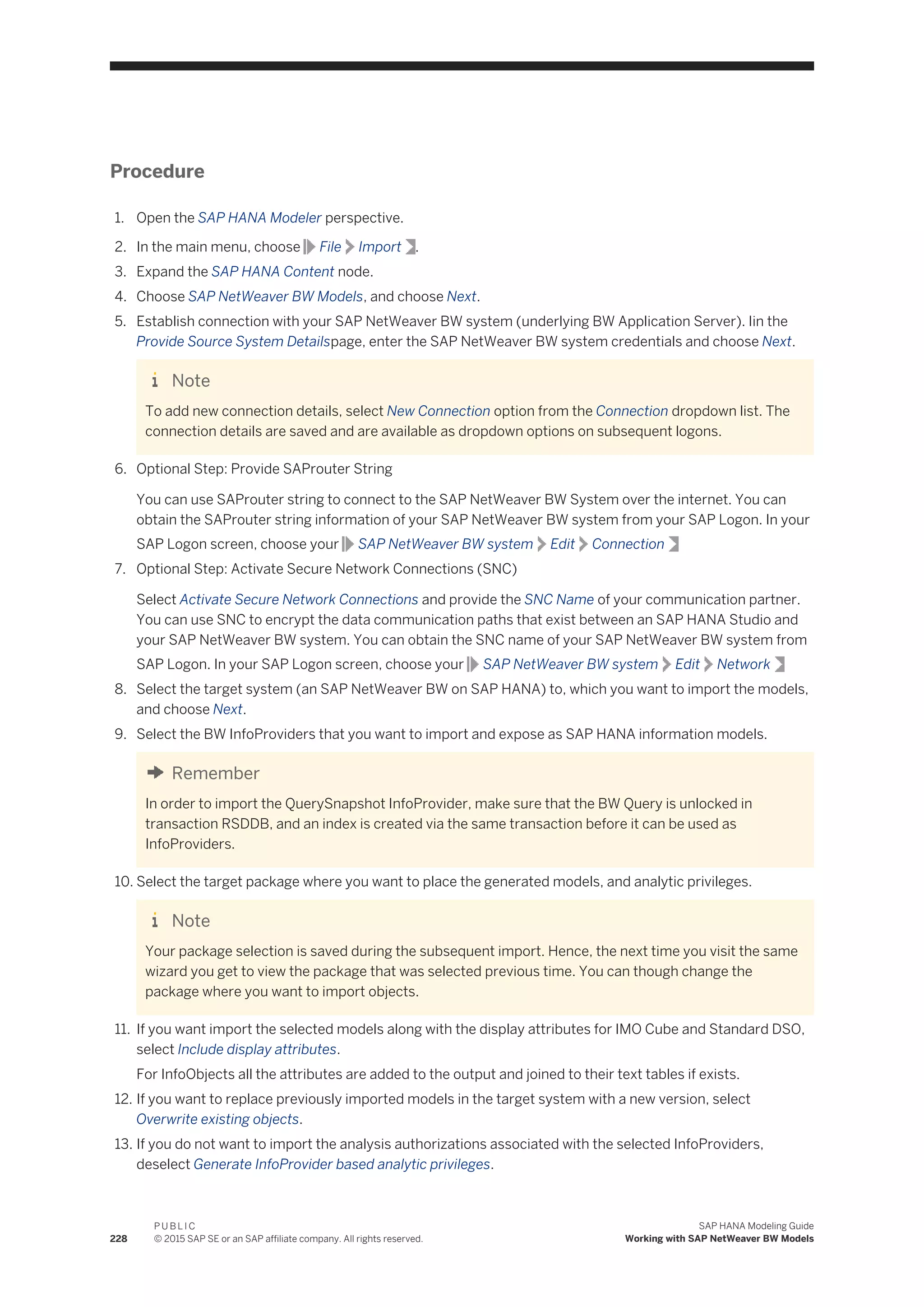




![13 Working with Decision Tables
This section describes how you can create and manage decision tables within the SAP HANA modeling
environment.
Related Information
Create Decision Tables [page 233]
Changing the Layout of a Decision Table [page 242]
Use Parameters in a Decision Table [page 244]
Use Calculated Attributes in Decision Tables [page 245]
13.1 Create Decision Tables
You use this procedure to create a decision table to model related business rules in a tabular format for
decision automation. You can use decision tables to manage business rules, data validation, and data quality
rules.
You use this procedure to create a decision table to model related business rules in a tabular format for
decision automation. You can use decision tables to manage business rules, data validation, and data quality
rules, without needing any knowledge of technical languages such as SQL Script or MDX. A data architect or a
developer creates the decision table and activates it. The active version of the decision table can be used in
applications.
Prerequisites
This task describes how to create a decision table. Before you start this task, note the following prerequisites:
● You must have access to an SAP HANA system.
● To activate and validate the decision table, the _SYS_REPO user requires the SELECT, EXECUTE, and
UPDATE privileges on your schema.
● If you are using the SAP HANA Development perspective, you must ensure the following prerequisites are
also met:
○ You must have already created a development workspace.
○ You must have checked out a package.
○ You must have created and shared a project so that the newly created files can be committed to (and
synchronized with) the repository.
SAP HANA Modeling Guide
Working with Decision Tables
P U B L I C
© 2015 SAP SE or an SAP affiliate company. All rights reserved. 233](https://image.slidesharecdn.com/51818a91-dee6-4c9b-b633-0deab6e88220-150721193202-lva1-app6892/75/SAP_HANA_Modeling_Guide_for_SAP_HANA_Studio_en-233-2048.jpg)
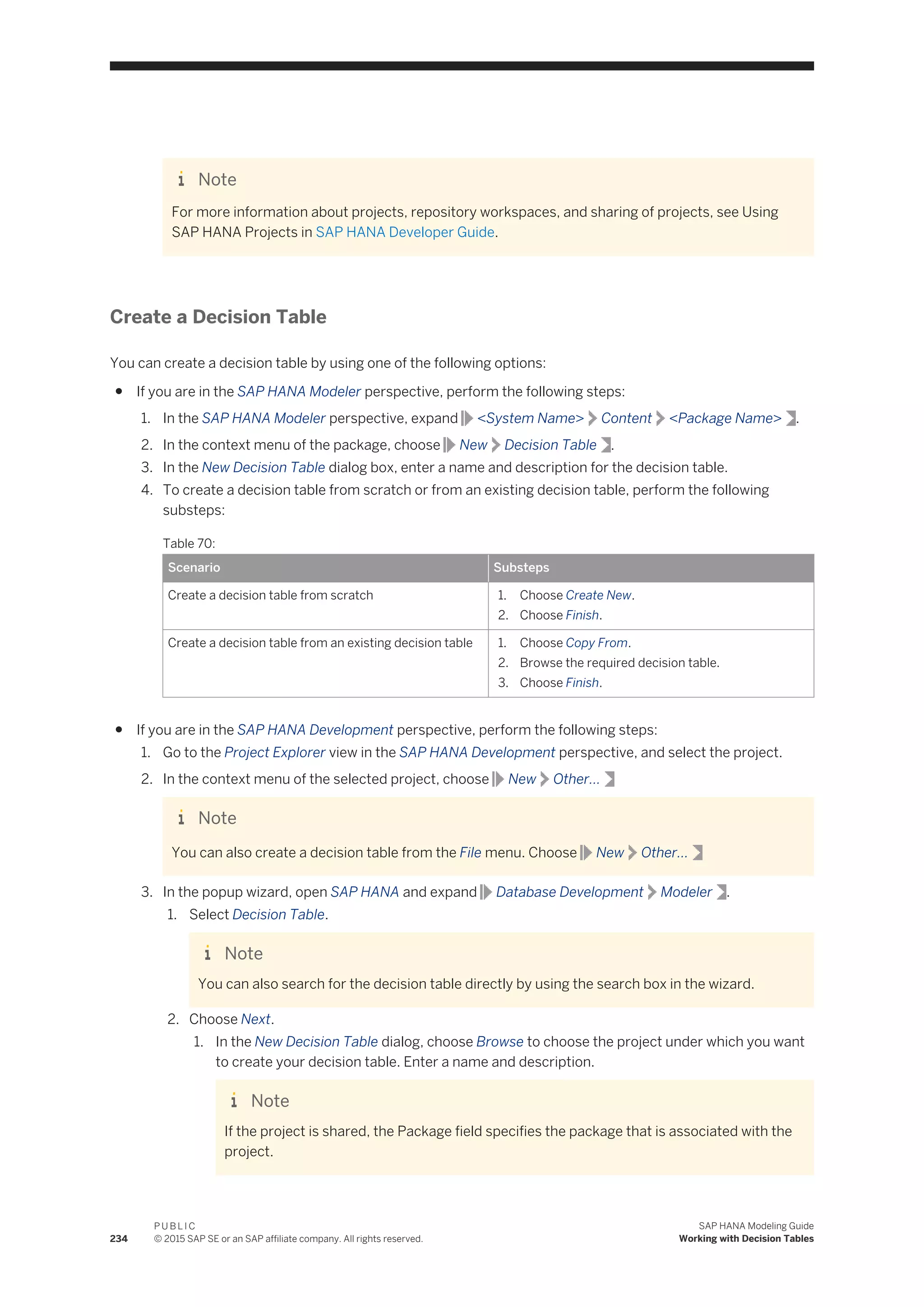
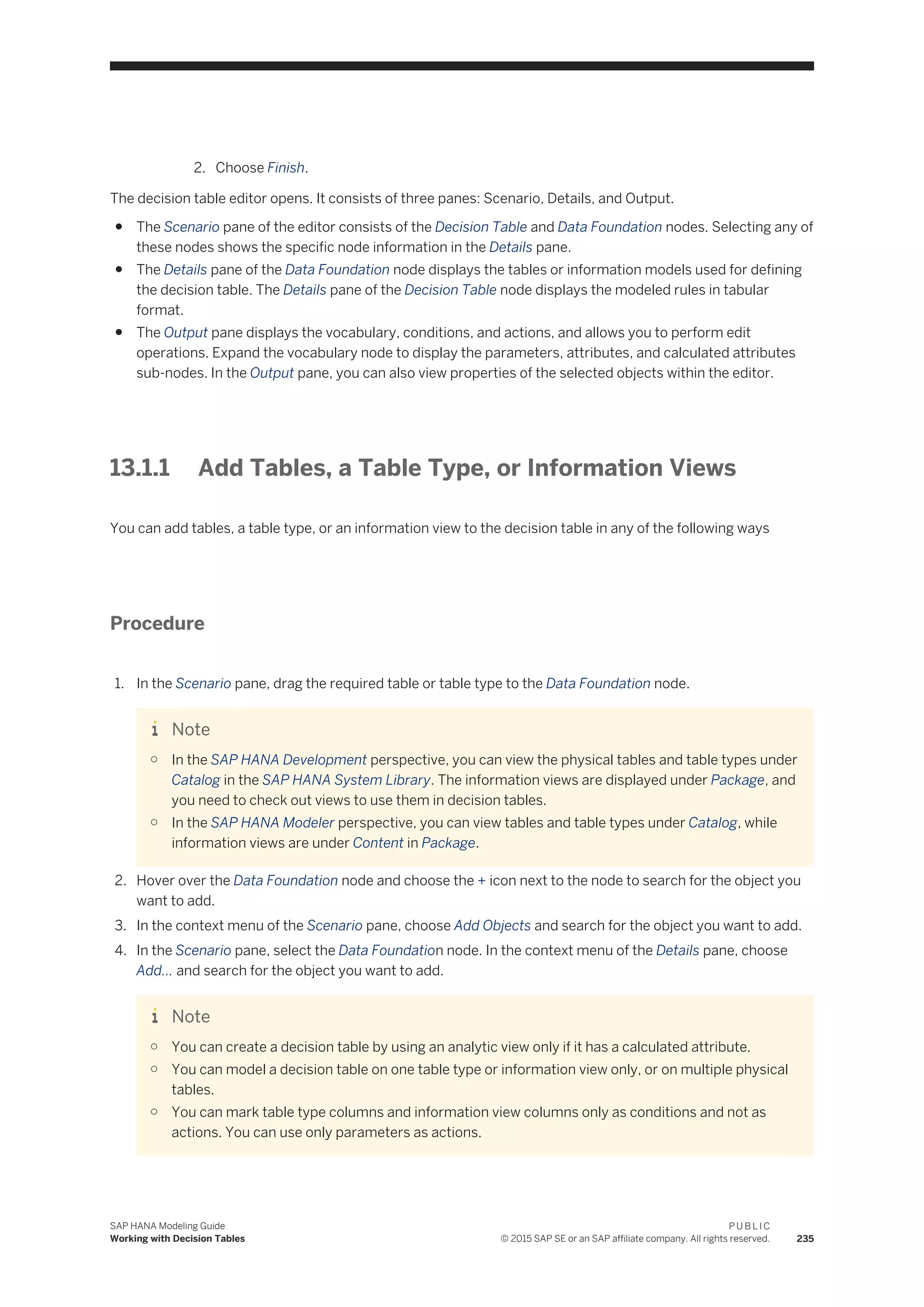
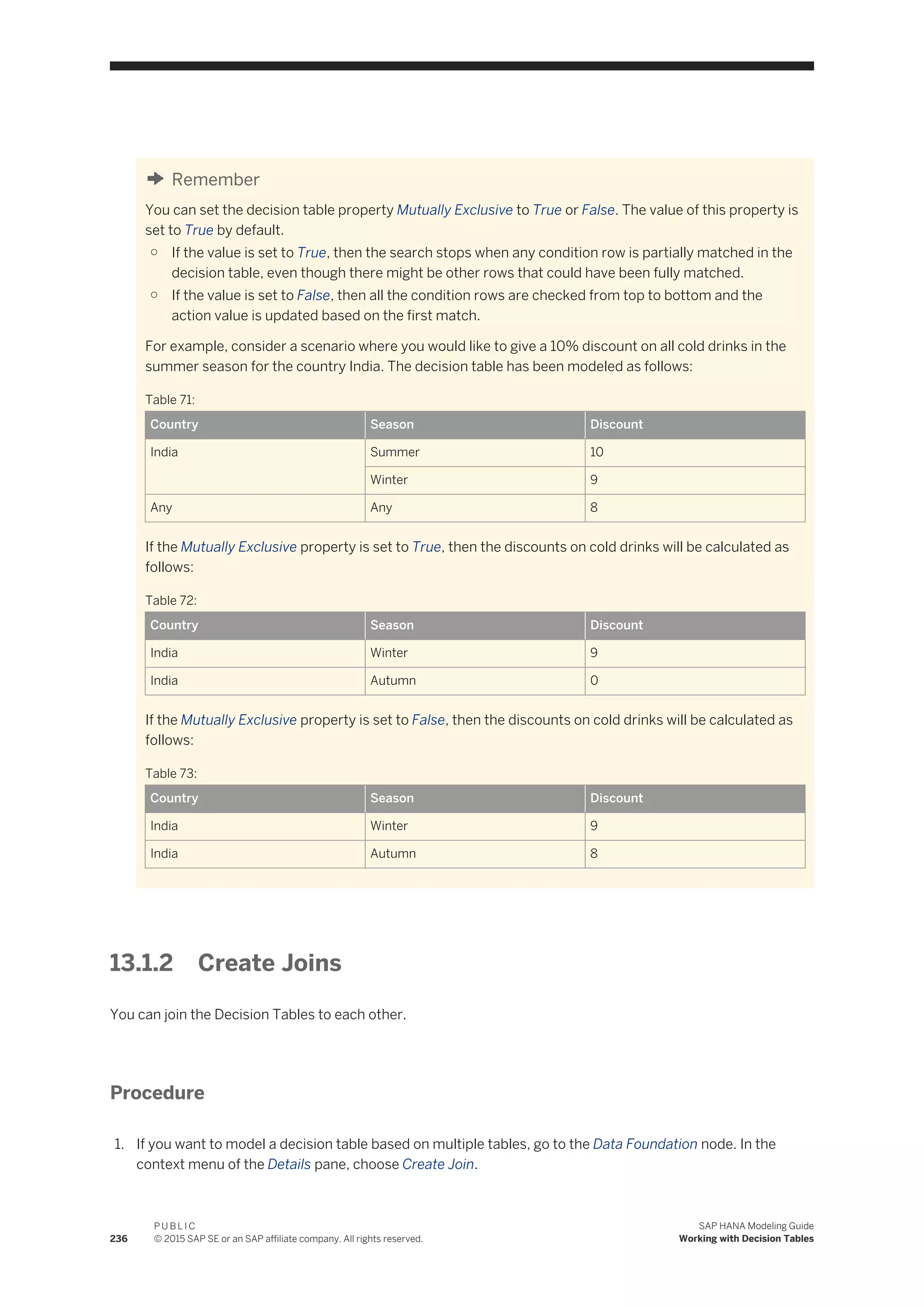

![○ You can choose to create parameters and use them as conditions or actions. If you are using
parameters as conditions, the values you provide for the parameters at runtime determine which rules
are followed when updating the action values. For more information on how to use parameters, see Use
Parameters in a Decision [page 244].
○ You can arrange the condition and action columns of the decision table depending on how you want
them to appear. For more information, see Change Layout of a Decision Table [page 242].
13.1.5 Add Conditions and Action Values
Procedure
1. Add Condition Values
a. In the Details pane of the Decision Table node, double-click to edit the cell and enter a value or in the
context menu of the condition cell, choose Add Conditions Values or Set Dynamic Value .
b. Enter a value and choose OK.
Note
The supported data types for an operator are:
Table 74:
Operator Supported Data Types Syntax
Not Equal To Number & CHAR-based != ABC
In Number & Char-based ○ In 'ABC';'CDA'
○ In 1;2
Note
The syntax of "In" operator con
tains different formats for enu
meration or string and so on.
Not In Number & Char-based Not In A;B;C
Like CHAR-based Like Abc*
Not Like CHAR-based Not Like Abc*
Greater Than
Greater Than or Equals
Number & CHAR-based >20
>=20
Less Than
Less Than or Equals
Number & CHAR-based <10
<=10
238
P U B L I C
© 2015 SAP SE or an SAP affiliate company. All rights reserved.
SAP HANA Modeling Guide
Working with Decision Tables](https://image.slidesharecdn.com/51818a91-dee6-4c9b-b633-0deab6e88220-150721193202-lva1-app6892/75/SAP_HANA_Modeling_Guide_for_SAP_HANA_Studio_en-238-2048.jpg)

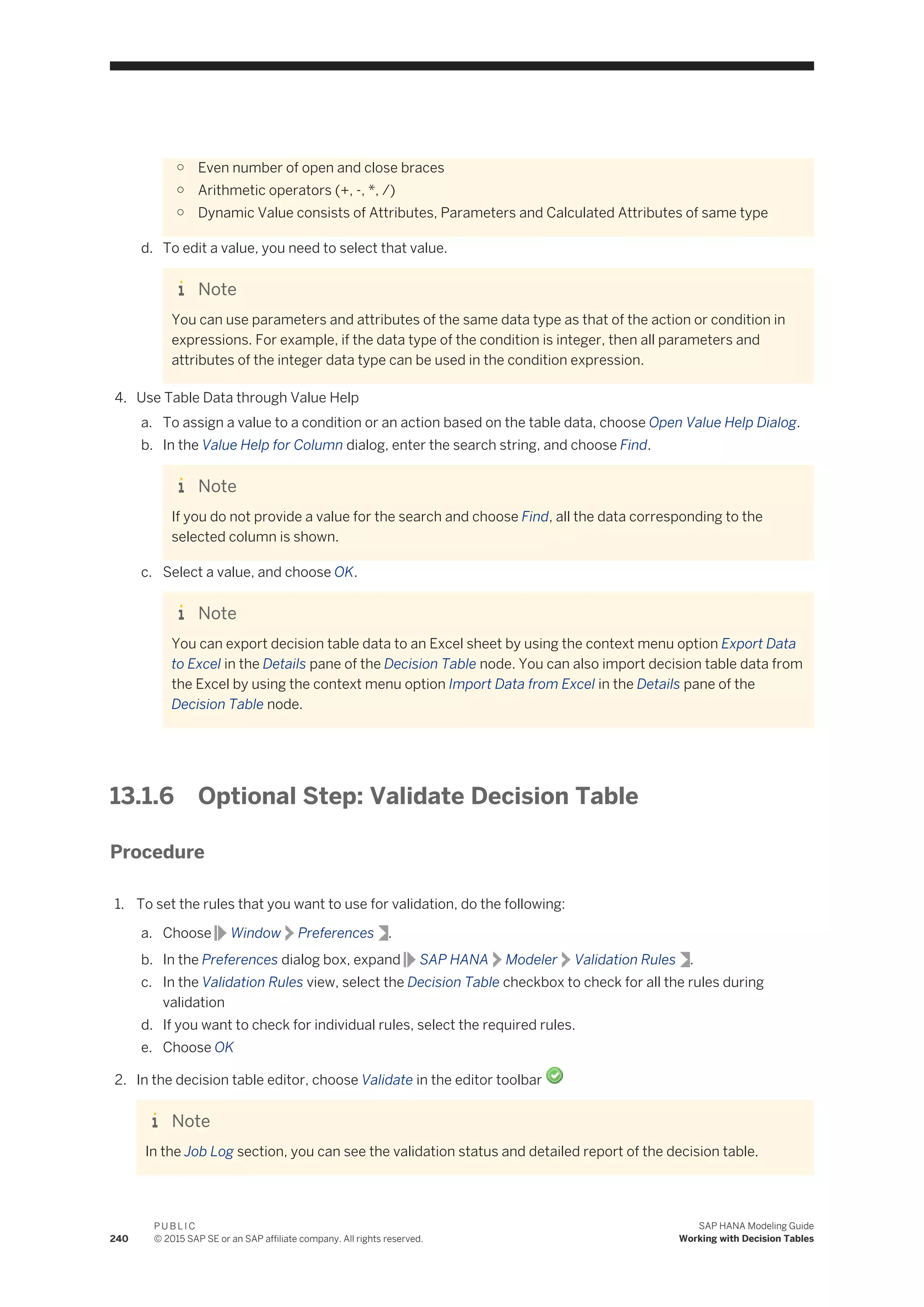
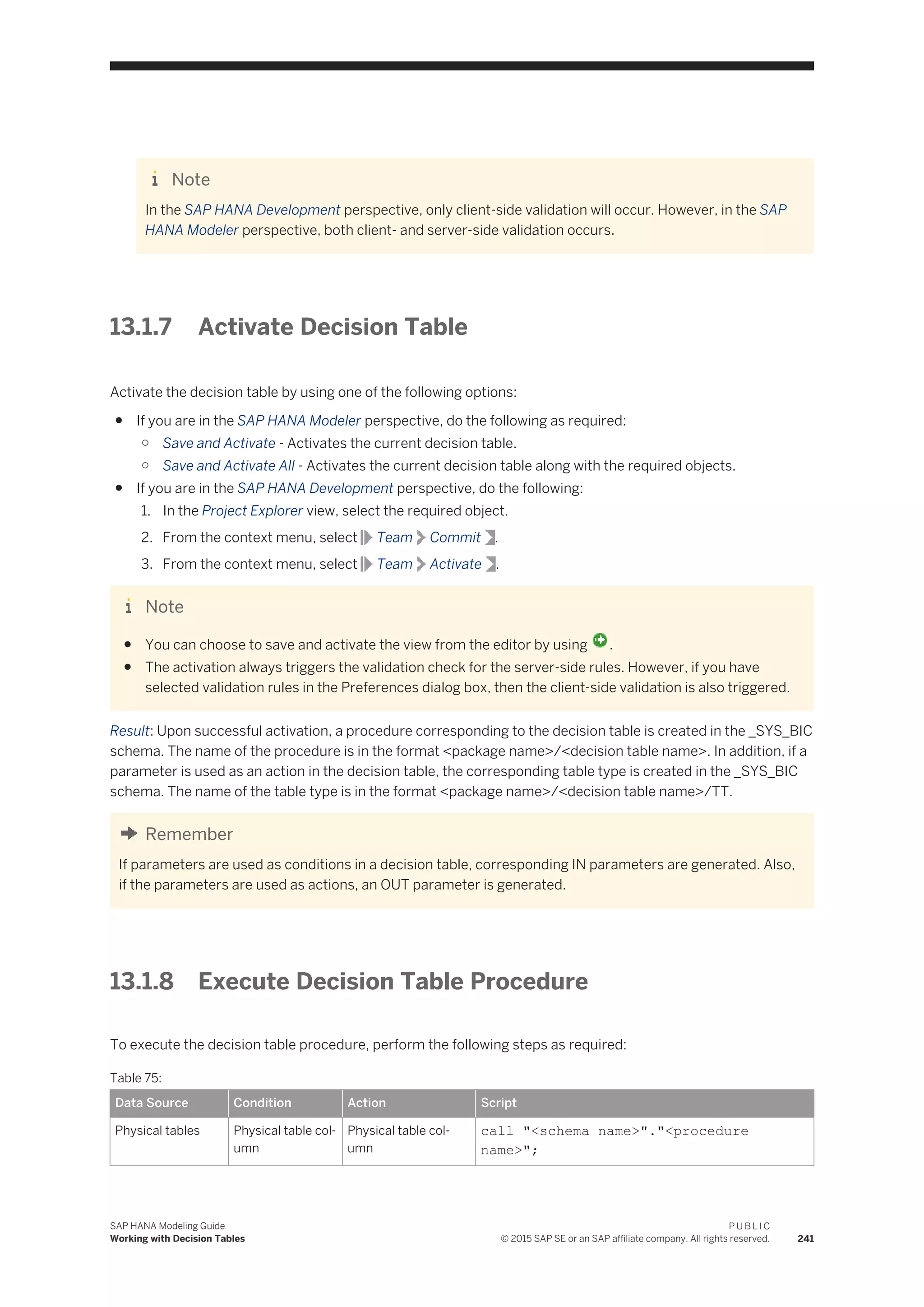
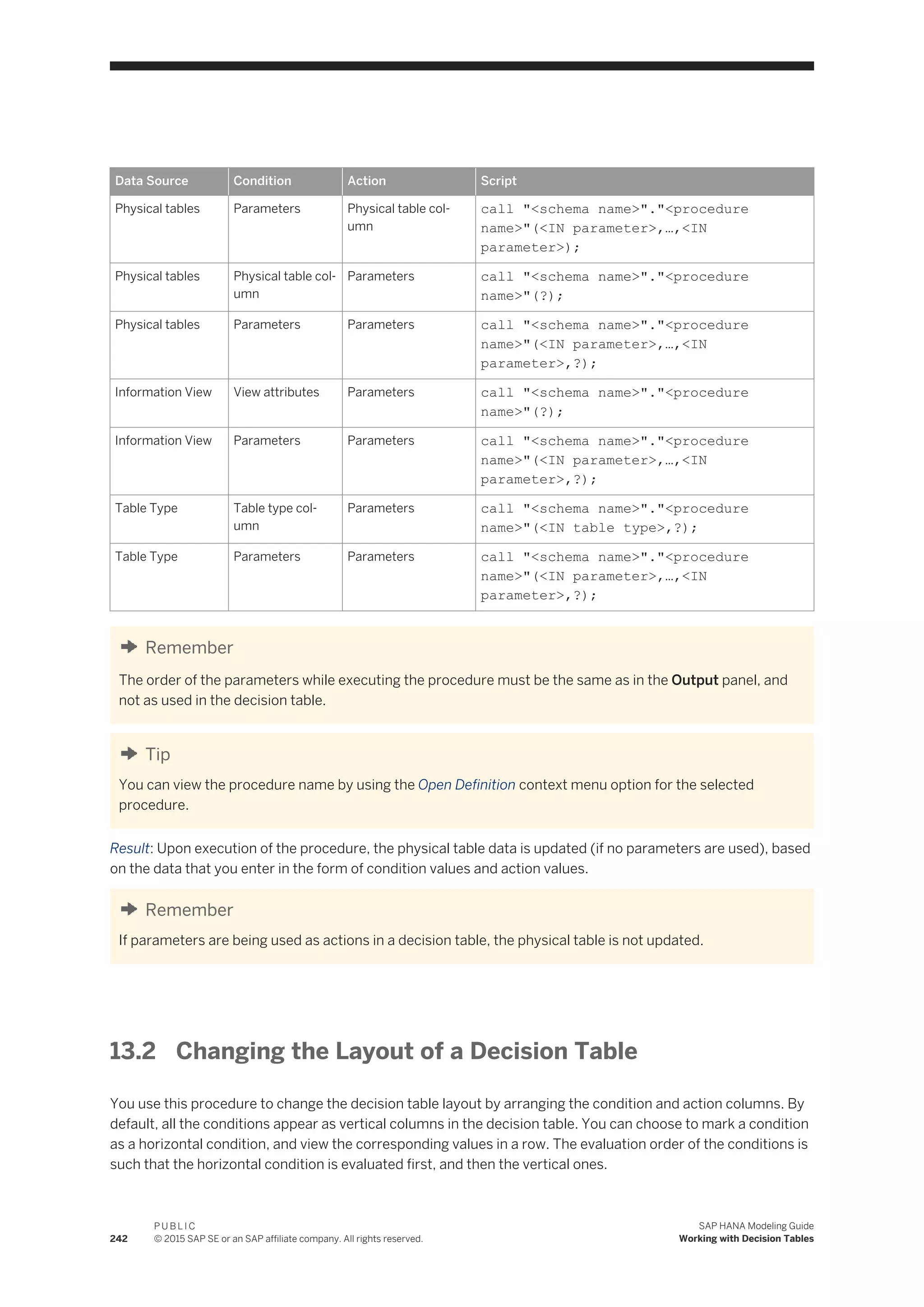
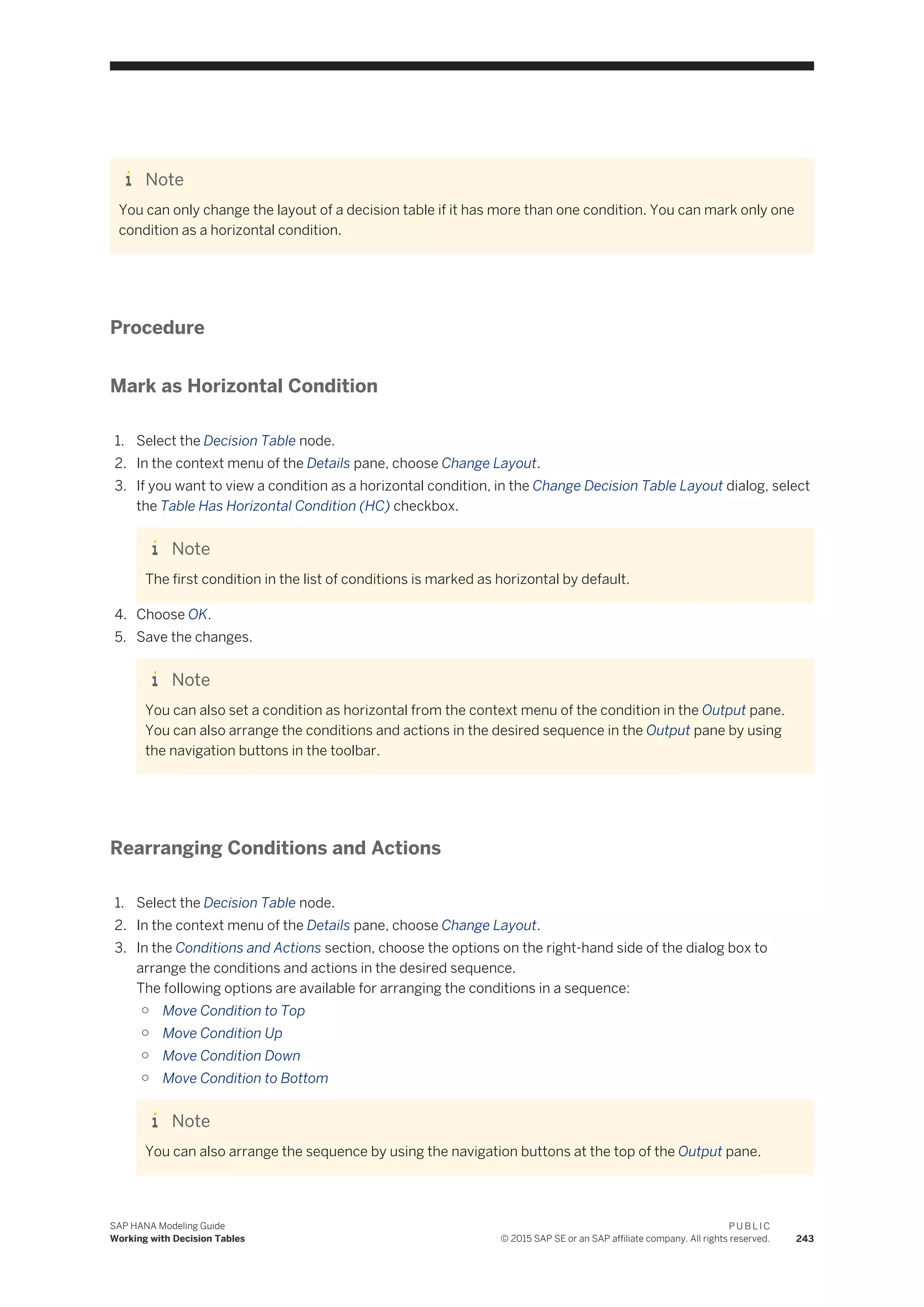
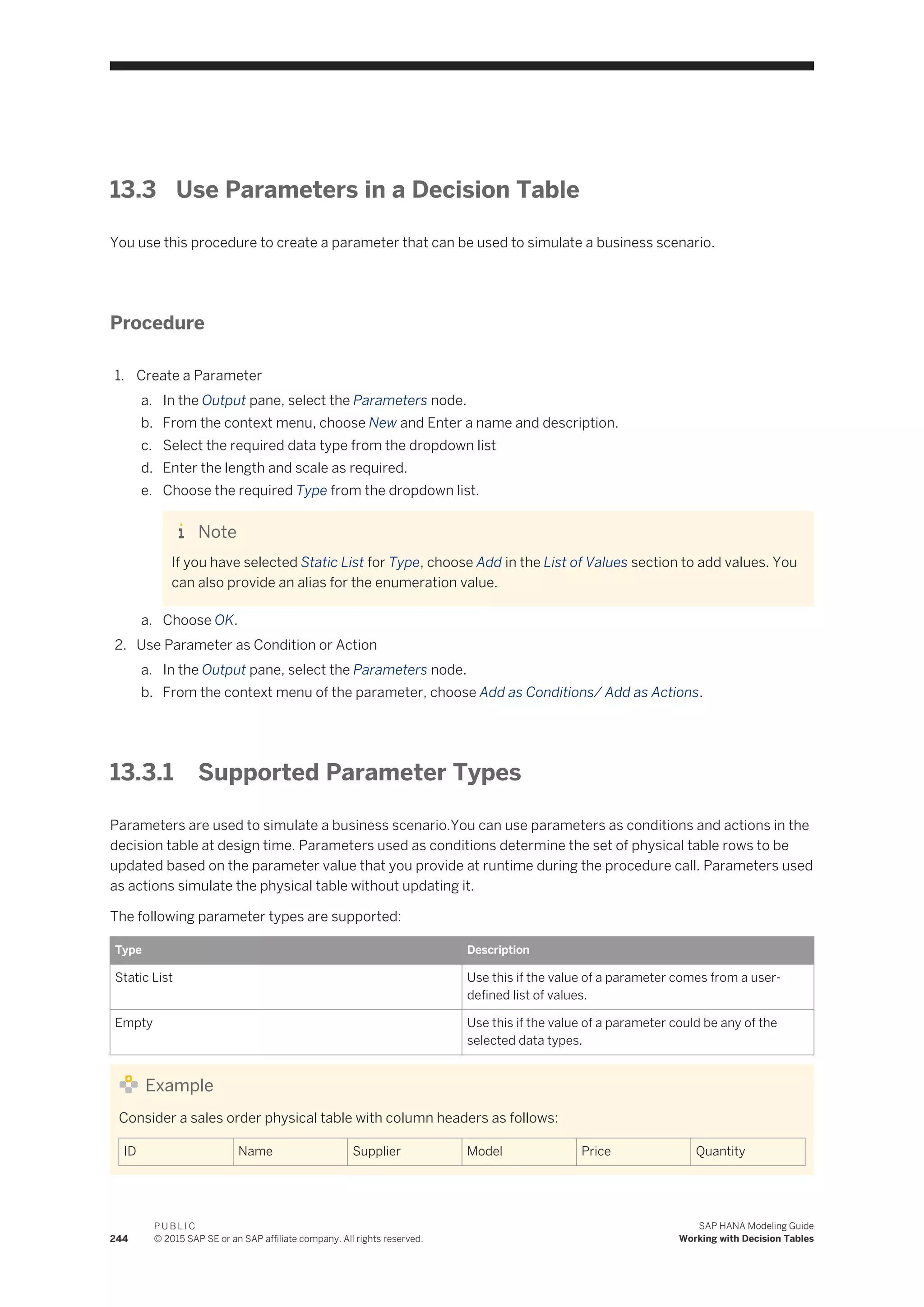

![14 Managing Object Versions
This sections describes on how you can manage active and inactive versions of objects in SAP HANA modeling
environement.
Related Information
Switch Ownership of Inactive Objects [page 246]
Toggle Versions of Content Objects [page 247]
View Version History of Content Objects [page 248]
14.1 Switch Ownership of Inactive Objects
You use this procedure to take over the ownership of the inactive version of an object from other users'
workspace.
Prerequisites
You have obtained the Work in Foreign Workspace authorization.
Context
Objects in edit mode in other workspaces are not available for modification. In order to modify such objects
you need to own the inactive object. The options available for changing the inactive object ownership are as
follows:
Option Purpose
Switch Ownership To take over multiple inactive objects from other users.
Inactive objects that do not have an active version are also
available for take over using this option
Take Over To take a single inactive object from another workspace
that you wish to edit using the editor.
246
P U B L I C
© 2015 SAP SE or an SAP affiliate company. All rights reserved.
SAP HANA Modeling Guide
Managing Object Versions](https://image.slidesharecdn.com/51818a91-dee6-4c9b-b633-0deab6e88220-150721193202-lva1-app6892/75/SAP_HANA_Modeling_Guide_for_SAP_HANA_Studio_en-246-2048.jpg)
